AP Art History Ultimate Guide
Unit 1: Global Prehistory, 30,000–500 BCE
Contextualization of Prehistoric Art
- Prehistoric art refers to the art created by humans before the invention of writing.
- It is important to contextualize prehistoric art in order to understand its meaning and significance.
- Cultural context, historical context, and environmental context are three important factors to consider when contextualizing prehistoric art.
- Cultural context includes the beliefs, values, and practices of the people who created the art.
- Historical context includes the events and circumstances that were happening at the time the art was created.
- Environmental context includes the physical surroundings and natural resources available to the people who created the art.
- By considering these contexts, we can gain a better understanding of the purpose and meaning behind prehistoric art.
Materials, Processes, and Techniques in Prehistoric Art
- Materials
- Stone: Prehistoric artists used stone to create sculptures, tools, and weapons. They used different types of stone, such as flint, obsidian, and jade, depending on availability and suitability for their purpose.
- Bone: Bone was used to create tools, weapons, and decorative objects. It was often carved or engraved with intricate designs.
- Ivory: Ivory was used to create small sculptures and decorative objects. It was often carved with intricate designs.
- Clay: Clay was used to create pottery and figurines. Prehistoric artists would shape the clay by hand or using simple tools, and then fire it to harden it.
- Pigments: Prehistoric artists used natural pigments such as charcoal, ochre, and manganese dioxide to create paintings and drawings. These pigments were often mixed with water or animal fat to create a paint-like substance.
- Processes
- Carving: Prehistoric artists would carve stone, bone, and ivory using simple tools such as chisels and hammers. They would often use sand or water to smooth the surface of the object.
- Engraving: Engraving involves cutting or scratching a design into a surface. Prehistoric artists would often use sharp stones or bones to engrave intricate designs onto bone or ivory objects.
- Modeling: Modeling involves shaping a material such as clay or wax into a three-dimensional form. Prehistoric artists would use their hands or simple tools to shape clay into pottery or figurines.
- Painting: Prehistoric artists would mix pigments with water or animal fat to create a paint-like substance. They would then apply the paint to a surface using brushes made from animal hair or plant fibers.
- Techniques
- Relief: Relief is a sculptural technique where the sculpted elements remain attached to a solid background. Prehistoric artists would often create relief sculptures by carving into stone or bone.
- Incision: Incision involves cutting or carving a design into a surface. Prehistoric artists would often use incision to create intricate designs on bone or ivory objects.
- Hatching: Hatching involves creating a pattern of parallel lines to create shading or texture. Prehistoric artists would often use hatching in their drawings and engravings.
- Stippling: Stippling involves creating a pattern of small dots to create shading or texture. Prehistoric artists would often use stippling in their drawings and engravings.
Theories and Interpretations of Prehistoric Art
Theories of Prehistoric Art
- Shamanism Theory
- According to this theory, prehistoric art was created by shamans or religious leaders to communicate with the spirit world.
- The art was used as a tool for religious and spiritual practices.
- The images depicted in the art were believed to have magical powers that could help the shamans in their rituals.
- Sympathetic Magic Theory
- This theory suggests that prehistoric art was created to control the environment.
- The images depicted in the art were believed to have the power to control the animals and the environment.
- For example, the images of animals were believed to attract the animals for hunting.
- Narrative Theory
- According to this theory, prehistoric art was created to tell stories.
- The images depicted in the art were used to tell stories of hunting, battles, and other important events.
- The art was used as a form of communication to pass on information from one generation to another.
Interpretations of Prehistoric Art
- Art for Art's Sake
- This interpretation suggests that prehistoric art was created for its own sake.
- The art was created for aesthetic purposes and to express the creativity of the artists.
- Social and Political Interpretation
- This interpretation suggests that prehistoric art was created to express social and political ideas.
- The art was used to express the power and status of the individuals and the community.
- Psychological Interpretation
- This interpretation suggests that prehistoric art was created to express the psychological state of the artists.
- The art was used as a form of therapy to express emotions and feelings.
Global Prehistoric Artworks
➼ Camelid Sacrum in the Shape of a Canine
Details
- 14,000–7000 B.C.E.
- From Tequixquiac, Central Mexico
- Located at the National Museum of Anthropology, Mexico City, Mexico
- Preserved in 1870 in the Valley of Mexico.
Materials
- Bone sculpture from a camel-like animal.
- The bone has been worked to create the image of a dog or wolf.
Content
- Carved to represent a mammal’s skull.
- One natural form is used to take the shape of another.
- The sacrum is the triangular bone at the base of a spine.
Context
- Second skull: A Mesoamerican idea
- The sacrum bone symbolizes the soul in some cultures, and for that reason it may have been chosen for this work.
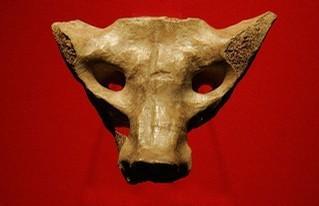
➼ Anthropomorphic Stele
Details
- 4th-millennium B.C.E.
- From Arabian Peninsula
- Mainly made of sandstone
- Preserved in National Museum, Riyadh, Saudi Arabia
Stele: an upright stone slab used to mark a grave or a site
Form and Content
- Anthropomorphic: having characteristics of the human form, although the form itself is not human.
- Belted robe from which hangs a double-bladed knife or sword.
- Double cords stretch diagonally across body with an awl unifying them.
Function: Religious or burial purpose, perhaps as a grave marker.
Context
- One of the earliest known works of art from Arabia.
- Found in an area that had extensive ancient trade routes.
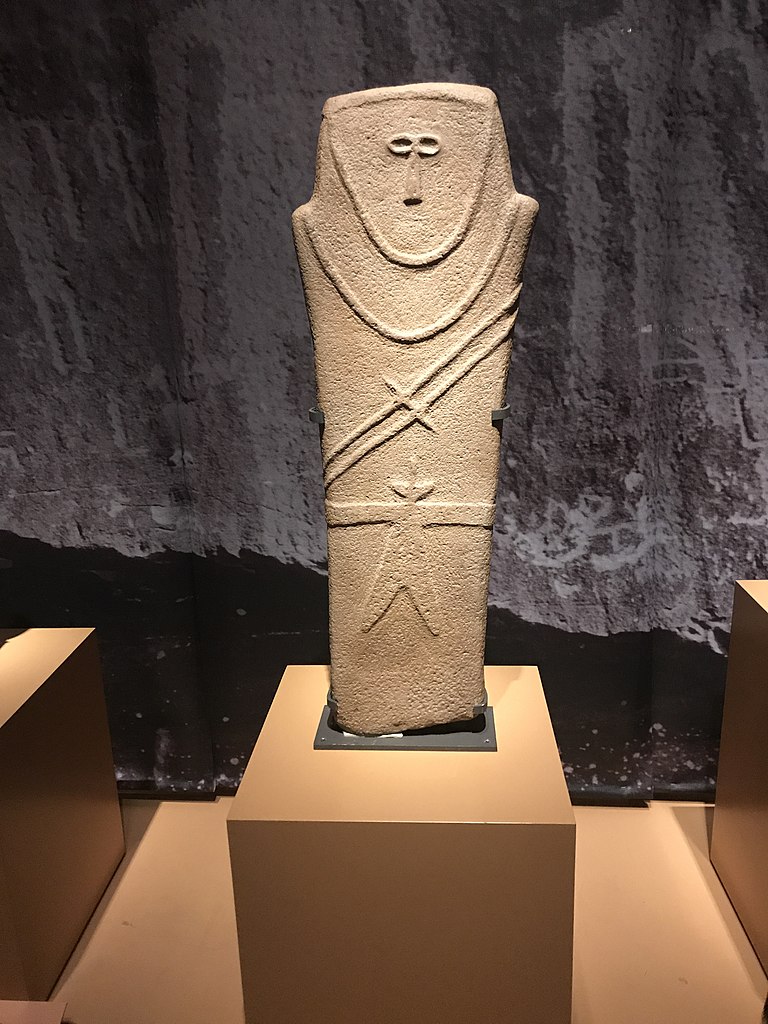
➼ Jade Cong
Details
- c. 3300–2200 B.C.E.
- From Liangzhu, China
- Made from a carved jade
- Preserved in Shanghai Museum, Shanghai, China
- Cong: a tubular object with a circular hole cut into a square-like cross-section
Form
- The circular hole is placed within a square.
- Abstract designs; the main decoration is a face pattern, perhaps of spirits or deities.
- Some have a haunting mask design in each of the four corners—with a bar-shaped mouth, raised oval eyes, sunken round pupils, and two bands that might indicate a headdress—which resembles the motif seen on Liangzhu jewelry.
Materials and Techniques
- Jade is a very hard stone, sometimes carved using drills or saws.
- The designs on congs may have been produced by rubbing sand.
- The jades may have been heated to soften the stone, or ritually burned as part of the burial process.
Context
- Jades appear in burials of people of high rank.
- Jades are placed in burials around bodies; some are broken, and some show signs of intentional burning.
- Jade religious objects are of various sizes and found in tombs, interred with the dead in elaborate rituals.
- The Chinese linked jade with the virtues of durability, subtlety, and beauty.
- Made in the Neolithic era in China.
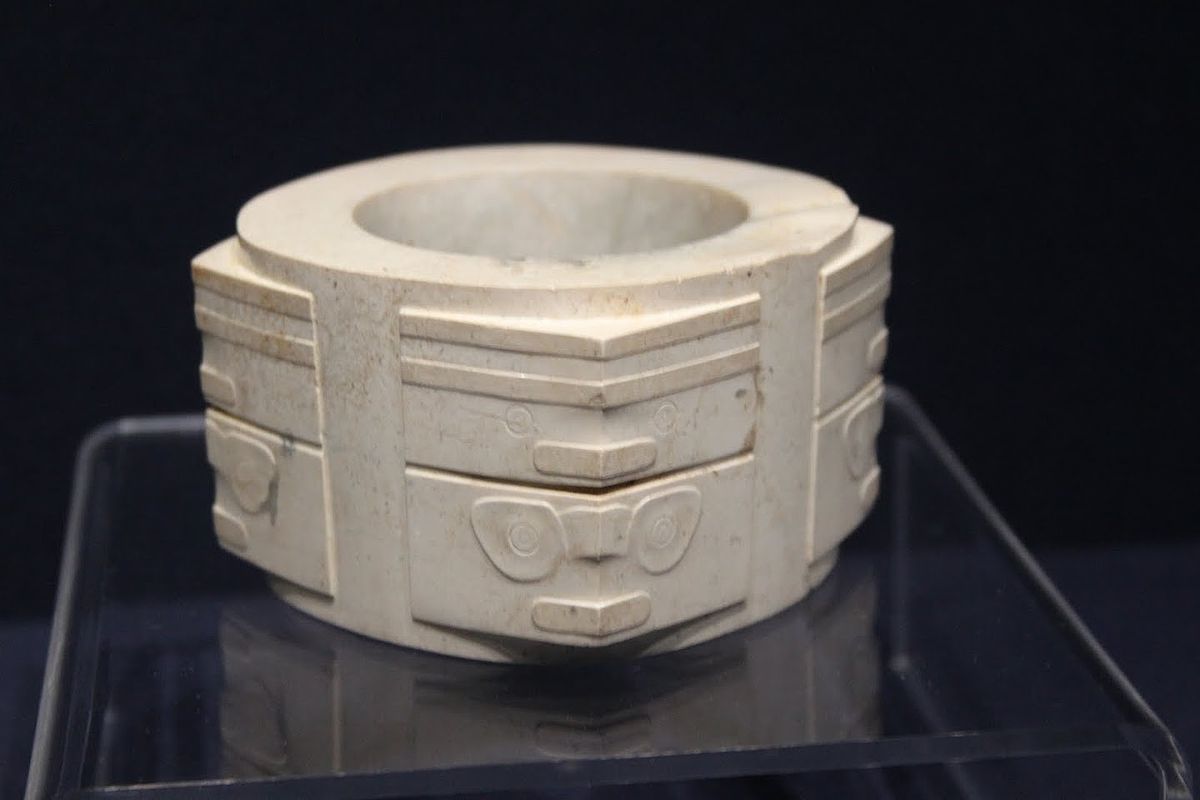
➼ The Ambum Stone
Details
- c. 1500 B.C.E.
- From Ambum Valley, Enga Province, Papua New Guinea
- Made from graywacke
- Preserved in National Gallery of Australia, Canberra
Form
- Composite human/animal figure; perhaps an anteater head and a human body.
- Ridgeline runs from nostrils, over the head, between the eyes, and between the shoulders.
Theories
- Masked human.
- Anteater embryo in a fetal position; anteaters thought of as significant because of their fat deposits.
- May have been a pestle or related to tool making.
- Perhaps had a ritual purpose; considered sacred; maybe a fertility symbol.
- Maybe an embodiment of a spirit from the past, an ancestral spirit, or the Rainbow Serpent.
History
- Stone Age work; artists used stone to carve stone.
- Found in the Ambum Valley in Papua New Guinea.
- When it was “found,” it was being used as a ritual object by the Enga people.
- Sold to the Australian National Gallery.
- Damaged in 2000 when it was on loan in France; it was dropped and smashed into three pieces and many shards; it has since been restored.

➼ Tlatilco Female Figurine
Details
- c. 1200–900 B.C.E.
- From Central Mexico, site of Tlatilco
- Made out of ceramic
- Preserved in Princeton University Art Museum, Princeton, New Jersey
Form
- Flipper-like arms, huge thighs, pronounced hips, narrow waists.
- Unclothed except for jewelry; arms extending from body.
- Diminished role of hands and feet.
- Female figures show elaborate details of hairstyles, clothing, and body ornaments.
Technique: Made by hand; artists did not use molds.
Function: May have had a shamanistic function
Context and Interpretation
- Some show deformities, including a female figure with two noses, two mouths, and three eyes, perhaps signifying a cluster of conjoined or Siamese twins and/or stillborn children.
- Bifacial images and congenital defects may express duality.
- Found in graves, and may have had a funerary context.

➼ Terra cotta fragment
Details
- 1000 B.C.E.
- From Lapita, Reef Islands, Solomon Islands
- Made from incised terra cotta
- Preserved in University of Auckland, New Zealand
Form
- Pacific art is characterized by the use of curved stamped patterns: dots, circles, hatching; may have been inspired by patterns on tattoos.
- One of the oldest human faces in Oceanic art.
Materials
- Lapita culture of the Solomon Islands is known for pottery.
- Outlined forms: they used a comb-like tool to stamp designs onto the clay, known as dentate stamping.
Technique
- Did not use potter’s wheel.
- After pot was incised, a white coral lime was often applied to the surface to make the patterns more pronounced.
Tradition
- Some designs found on the pottery are used in modern Polynesian tattoos and tapas.
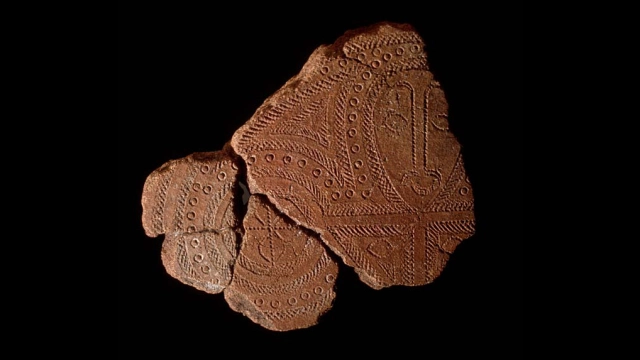
➼ Apollo 11 Stones
Details
- c. 25,500–25,300 B.C.E.
- Painted using charcoal on stone,
- Preserved in State Museum of Namibia, Windhoek, Namibia
Form
- Animal seen in profile, typical of prehistoric painting.
- Perhaps a composite animal rather than a particular specimen.
Materials
- Done with charcoal.
Context
- Some of the world’s oldest works of art, found in Wonderwerk Cave in Namibia.
- Several stone fragments found.
- Originally brought to the site from elsewhere.
- Cave is the site of 100,000 years of human activity.
History
- Named after the Apollo 11 moon landing in 1969, the year the cave was discovered.

➼ Great Hall of the Bulls
Details
- 15,000–13,000 B.C.E.
- From Paleolithic Europe
- A rock painting,
- Found in Lascaux, France
Content
- 650 paintings: most common animals are cows, bulls, horses, and deer.
Form
- Bodies seen in profile; frontal or diagonal view of horns, eyes, and hooves; some animals appear pregnant.
- Twisted perspective: many horns appear more frontal than the bodies.
- Many overlapping figures.
Materials
- Natural products were used to make paint: charcoal, iron ore, plants.
- Walls were scraped to an even surface; paint colors were bound with animal fat; lamps lighted the interior of the caves.
- No brushes have been found.
- May have used mats of moss or hair as brushes.
- Color could have been blown onto the surface by mouth or through a tube, like a hollow bone.
Context
- Animals placed deep inside cave—some hundreds of feet from the entrance.
- Evidence still visible of scaffolding erected to get to higher areas of the caves.
- Negative handprints: are they signatures?
- Caves were not dwellings, as prehistoric people led migratory lives following herds of animals; some evidence exists that people did seek shelter at the mouths of caves.
Theories
- A traditional view is that they were painted to ensure a successful hunt.
- Ancestral animal worship.
- Represents narrative elements in stories or legends.
- Shamanism: a religion based on the idea that the forces of nature can be contacted by intermediaries, called shamans, who go into a trance-like state to reach another state of consciousness.
History
- Discovered in 1940; opened to the public after World War II.
- Closed to the public in 1963 because of damage from human contact.
- Replica of the caves opened adjacent to the original.

➼ Running Horned Woman
Details
- 6000–4000 B.C.E.
- A pigment on rock,
- Found in Tassili n’Ajjer, Algeria
Form
- Composite view of the body.
- Many drawings exist—some are naturalistic, some are abstract, some have Negroid features, and some have Caucasian features.
- The female horned figure suggests attendance at a ritual ceremony.
Content
- Depicts livestock, wildlife, and humans
- Dots may reflect body paint applied for ritual or scarification; white patterns in symmetrical lines may reflect raffia garments.
Context
- More than 15,000 drawings and engravings were found at this site.
- At one time the area was grasslands; climate changes have turned it into a desert.
- The entire site was probably painted by many different groups over large expanses of time.
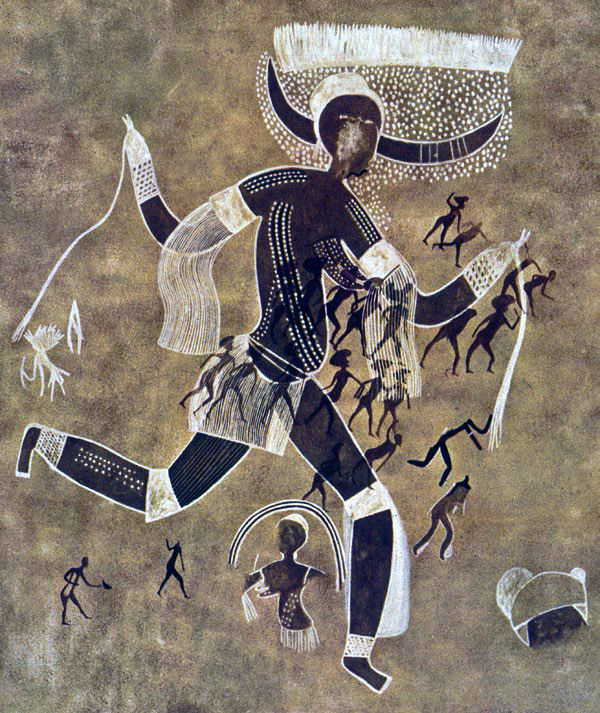
➼ Beaker with Ibex Motifs
Details
- 4200–3500 B.C.E.
- From Susa, Iran
- Painted terra cotta
- Found in Louvre, Paris
Form and Content
- Frieze of stylized aquatic birds on top, suggesting a flock of birds wading in a Mesopotamian river valley.
- Below are stylized running dogs with long narrow bodies, perhaps hunting dogs.
- The main scene shows an ibex with oversized abstract and stylized horns.
- Stylized: a schematic, nonrealistic manner of representing the visible world and its contents, abstracted from the way that they appear in nature
Materials and Techniques
- Probably made on a potter’s wheel, a technological advance; some suggest instead that it was handmade.
- Thin pottery walls.
Context and Interpretation
- In the middle of the horns is a clan symbol of family ownership; perhaps the image identifies the deceased as belonging to a particular group or family.
- Found near a burial site, but not with human remains.
- Found with hundreds of baskets, bowls, and metallic items.
- Made in Susa, in southwestern Iran.
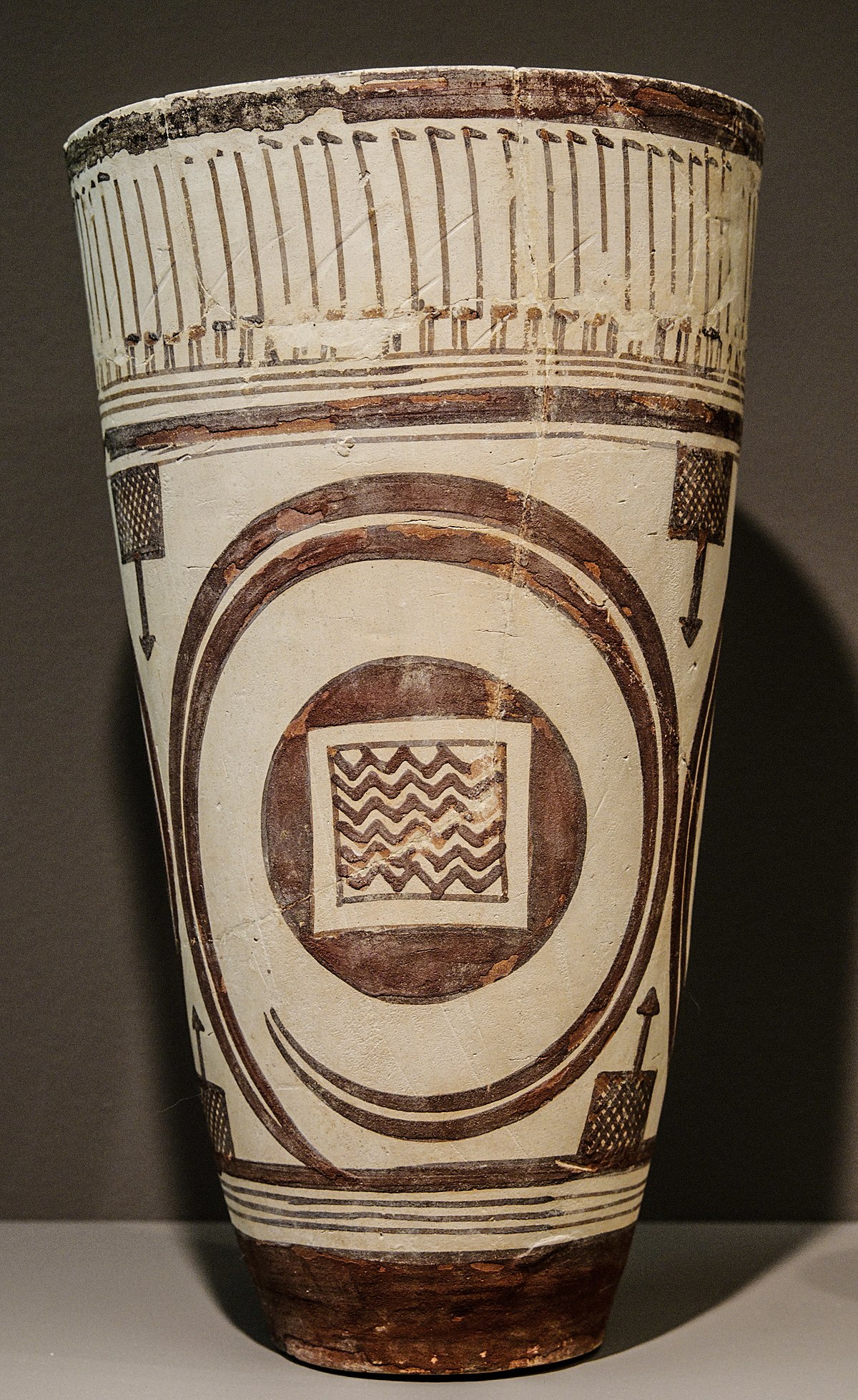
➼ Stonehenge
Details
- c. 2500–1600 B.C.E.
- Made out of sandstone, Neolithic Europe,
- Found in Wiltshire, United Kingdom
Technique
- Post-and-lintel building; lintels grooved in place by the mortise and tenon system of construction.
- Mortise and tenon: a groove cut into stone or wood, called a mortise, that is shaped to receive a tenon, or projection, of the same dimensions
- Large megaliths in the center are over 20 feet tall and form a horseshoe surrounding a central flat stone.
- A central horseshoe is surrounded by lintel-connected megaliths.
- Hundreds of unidentified stones surrounded the monument.
- Builders lacked wheels and pulleys. Stones may have been transported on logs or a greased sleigh.
Context
- Each stone weighs over 50 tons, reflecting the structure's intended permanence.
- Some stones were imported from over 150 miles away, suggesting they were sacred.
History
- Perhaps took 1,000 years to build; gradually redeveloped by succeeding generations.
Probably built in three phases:
- First Phase: circular ditch 36 feet deep and 360 feet in diameter containing 56 pits called Aubrey Holes, named after John Aubrey who found them in the 18th century.
- Today the holes are filled with chalk.
- Second Phase: wooden structure, perhaps roofed.
- The Aubrey Holes may have been used as cremation burials at this time.
- Adult males were buried at these sites, generally, men who did not show a lifetime of hard labor, signifying it was a site for a select group of people.
- Third Phase: stone construction.
Tradition
- British Isles forests may have inspired wood circles.
- Stone circles are still common in Britain, indicating Neolithic popularity.
Theories
- As an observatory, it may predict eclipses and be oriented towards the summer and winter solstices.
- According to a new theory, elite males were buried at Stonehenge.
- An alternative theory suggests it was a healing site.
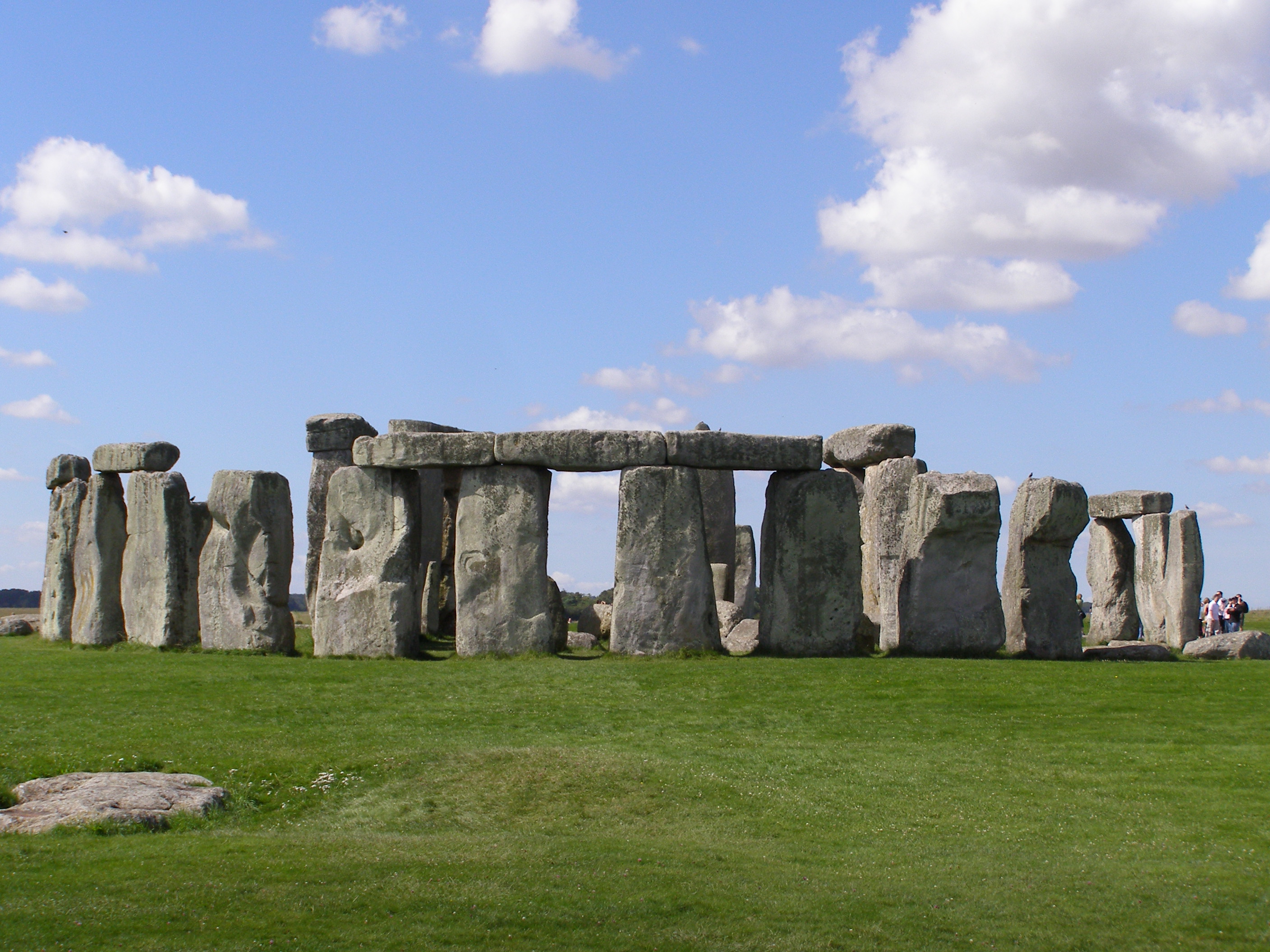
Unit 2: Ancient Mediterranean, 3500 BCE–300 CE
Contextualization of Ancient Mediterranean Art
The Near East (3500 BCE–300 CE)
- The Near East is a region that includes modern-day Turkey, Iran, Iraq, Syria, Lebanon, Israel, Jordan, and parts of Saudi Arabia and Egypt.
- The art of the Near East dates back to the Neolithic period, around 8000 BCE.
- The Sumerians, who lived in Mesopotamia (modern-day Iraq) around 4000 BCE, created some of the earliest known works of art in the region, including cylinder seals and votive statues.
- The Babylonians, who followed the Sumerians, created intricate relief sculptures and decorative tiles.
- The Persians, who ruled the region from the 6th to the 4th century BCE, created elaborate palaces and tombs, such as the famous Persepolis.
- Islamic art, which emerged in the 7th century CE, is characterized by intricate geometric patterns, calligraphy, and the use of bright colors.
- The art of the Near East has been influenced by various religions, including Zoroastrianism, Judaism, Christianity, and Islam.
- Many of the works of art from the Near East are now housed in museums around the world, including the British Museum in London and the Louvre in Paris.
Egypt (3000–30 BCE)
- Egyptian art is one of the oldest and most enduring art forms in the world. It is characterized by its highly stylized and symbolic representations of people, animals, and gods.
- Early Dynastic Period (3000–2686 BCE)
- Art during this period was highly stylized and focused on the representation of the human form.
- Sculptures were typically made from limestone and depicted kings and queens in a rigid, formal pose.
- Paintings were often found in tombs and depicted scenes from daily life, such as hunting and fishing.
- Old Kingdom (2686–2181 BCE)
- The Old Kingdom is known for its monumental architecture, such as the pyramids of Giza.
- Sculptures during this period were highly realistic and depicted the pharaohs as powerful and divine beings.
- Paintings were often used to decorate tombs and depicted scenes from the afterlife.
- Middle Kingdom (2055–1650 BCE)
- Art during the Middle Kingdom was characterized by a more naturalistic style.
- Sculptures were often made from bronze and depicted everyday people, such as farmers and craftsmen.
- Paintings during this period were highly detailed and often depicted scenes from daily life.
- New Kingdom (1550–1070 BCE)
- The New Kingdom is known for its elaborate tombs and temples, such as the temple of Karnak.
- Sculptures during this period were highly detailed and often depicted gods and goddesses.
- Paintings were highly symbolic and often depicted scenes from mythology and religion.
- Late Period (664–332 BCE)
- Art during the Late Period was heavily influenced by Greek and Roman art.
- Sculptures were often made from bronze and depicted gods and goddesses in a more naturalistic style.
- Paintings during this period were highly detailed and often depicted scenes from daily life.
Greece (900–30 BCE)
- Ancient Greece was subdivided into city-states, comparable to Near Eastern civilizations. It is renowned for its democracy, military might, and art in particular.
- Geometric Period (900-700 BCE)
- Characterized by geometric shapes and patterns
- Pottery was the main art form
- Used for storage and funerary purposes
- Figures were stylized and abstract
- Archaic Period (700-480 BCE)
- Transition from geometric to realistic art
- Sculptures were made of marble and bronze
- Kouros and Kore statues were popular
- Depicted idealized human forms
- Pottery became more decorative
- Classical Period (480-323 BCE)
- Considered the height of Greek art
- Emphasis on balance, harmony, and proportion
- Sculptures depicted realistic human forms
- Contrapposto pose was introduced
- Parthenon was built during this period
- Hellenistic Period (323-30 BCE)
- Art became more emotional and dramatic
- Sculptures depicted movement and expression
- Portraiture became popular
- Laocoon and His Sons is a famous sculpture from this period
Etruria (900-270 BCE)
- Etruria was a civilization in ancient Italy that flourished from the 9th to the 3rd century BCE.
- Etruscan art was heavily influenced by Greek art, but it also had its own unique style.
- It was characterized by its use of terracotta, bronze, and gold.
- It was also known for its intricate and detailed designs, which often depicted scenes from mythology and daily life.
- Etruscan tombs were often decorated with frescoes, which depicted scenes from the afterlife and the deceased's life.
- Etruscan sculpture was also highly detailed and often depicted human figures in a naturalistic style.
- Etruscan pottery was also highly prized and was often decorated with intricate designs and scenes from mythology.
- Etruscan art declined after the Roman conquest of Etruria in the 3rd century BCE, but its influence can still be seen in Roman art and architecture.
Rome (750 BCE -350 CE)
- Rome was founded in 753 BCE and became a powerful city-state in the Mediterranean world.
- Roman art was heavily influenced by Greek art, but it also had its own unique characteristics.
- Early Rome (750-500 BCE)
- Art during this period was mostly utilitarian and focused on practical objects such as pottery and weapons.
- The Etruscan civilization, which was located north of Rome, also had a significant influence on early Roman art.
- Republican Rome (500-27 BCE)
- During this period, Rome became a republic and art became more focused on public works and propaganda.
- Roman art during this period was characterized by realism and a focus on the human form.
- Sculpture was the most prominent form of art, with many examples of busts and statues of important figures.
- Imperial Rome (27 BCE- 350 CE)
- The Roman Empire was established in 27 BCE and art became more grandiose and focused on glorifying the emperor and the empire.
- Architecture became a prominent form of art, with examples such as the Colosseum and the Pantheon.
- Mosaics and frescoes also became popular, with many examples found in Pompeii and Herculaneum.
Cultural Contexts of Ancient Mediterranean Art
Mesopotamian
- Mesopotamia, located in the Tigris-Euphrates river basin, was home to some of the earliest civilizations in the world, including the Sumerians, Akkadians, Assyrians, and Babylonians.
- Mesopotamian art portrays the cultural, religious, and political ideas of cultures that thrived between 4000 BCE to 539 BCE.
- It is renowned for its enormous building, such as the ziggurat and the palace, as well as its exquisite reliefs, sculptures, and items fashioned from clay, stone, and metal.
- It also features a rich heritage of cylinder seals, which had a number of purposes, including administrative, religious, and commercial.
- It is noteworthy not just for its aesthetic value, but also for the information it provides into the ancient Mesopotamian social, economic, and political systems.
Egyptian
- Ancient Egyptian art, which goes back to roughly 3100 BCE, is renowned for its highly stylized and symbolic qualities.
- It was intricately intertwined with the religious beliefs and rituals of the civilisation, which lasted over 3,000 years.
- It was religious in nature and depicted the gods and goddesses of the Egyptian pantheon, as well as pharaohs and other prominent figures. tombs and temples, as well as depictions of everyday life, were also decorated with Egyptian art.
- It was profoundly inspired by their belief in the afterlife, which resulted in the development of tombs, sarcophagi, and other elaborate funerary artifacts.
- It was defined by the usage of hieroglyphs, which were a sort of writing used to depict words and concepts.
Greek
- Ancient Greek art comprises the art created in the Graeco world from the ninth century BCE to the fourth century AD.
- This time witnessed the rise and collapse of the major city-states of Athens, Sparta, and Corinth, as well as the birth of the Hellenistic period after Alexander the Great's conquests.
- The art of ancient Greece was defined by its emphasis on the human form as well as balance, harmony, and symmetry.
- Greek art also reflects the society's political and cultural values as well as its religious beliefs and myths.
- Ancient Greek art continues to amaze and inspire audiences today, from the Parthenon's renowned marble statues to the Minoan civilization's vibrant murals.
Etruscan
- Ancient Etruscan art, the art and architecture produced by the Etruscan civilisation in central Italy between the eighth and third centuries BCE, is distinguished by its particular style, which was inspired by the art of the ancient Greeks and the indigenous cultures of Italy.
- Metalworking is prominent in Etruscan art, particularly in the creation of complex sarcophagi and jewelry. The monumental architecture of the Etruscan civilization included the construction of enormous tombs and ornate city fortifications.
- Etruscan art also includes paintings and pottery. These works of art offer insight into the Etruscans' religious beliefs, social organization, and daily life.
- As a major forerunner to Roman art, Etruscan art is also crucial in the history of Western art.
Roman
- Ancient Roman art is a multifaceted topic that depicts the many cultures and societies that lived inside the Roman Empire.
- From the Republic through Late Antiquity, Roman art spans a variety of techniques and styles, including painting, sculpture, and mosaic, as well as architecture and decorative arts.
- Roman art was significantly affected by the art of the Etruscans, the Greeks, the Eastern Mediterranean, Egypt, and the Near East.
- Roman society's values, beliefs, and goals were frequently reflected in this art's utilitarian, religious, and political applications.
- Ancient Roman art is a wonderful and eternally fascinating subject to study due to its rich historical and cultural context. Pantheon:
Ancient Mediterranean Artworks
➼ White Temple and its Ziggurat
Details
- c. 3500–3000 B.C.E
- Made up of mud brick
- Found in Uruk (modern Warka), Iraq
Form
- Buttresses spaced across the surface to create a contrasting light-and-shadow pattern.
- The ziggurat tapers downward so that rainwater washes off.
- Entire form resembles a mountain, creating a contrast between the vast flat terrain and the man-made mountain.
- Bent-axis plan: ascending the stairs requires angular changes of direction to reach the temple
Function
- On top of the ziggurat is a terrace for outdoor rituals and a temple for indoor rituals.
- The temple on the top was small, set back, and removed from the populace; access was reserved for royalty and clergy; only the base of the temple remains.
- The temple interior contained a cella and smaller rooms meant for the deities to assemble before a select group of priests.
- Cella: the main room of a temple where the god is housed
Materials
- Mud-brick building built on a colossal scale and covered with glazed tiles or cones.
- Whitewash: was used to disguise the mud appearance; hence the modern name of White Temple.
Context
- Large settlement at Uruk of 40,000, based on agriculture and specialized labor.
- Uruk: May be the first true city in history; the first with monumental architecture.
- Ziggurat sited within the city.
- Anu: The god of the sky, the most important Sumerian deity.
- Gods descend from the heavens to a high place on Earth; hence the Sumerians built ziggurats as high places.
- Four corners oriented to the compass; cosmic orientation.
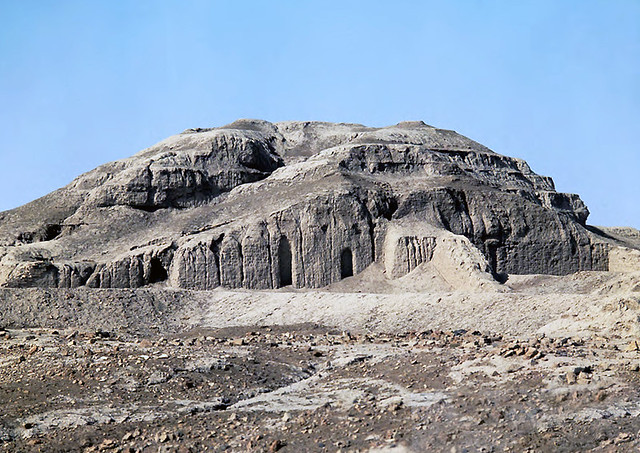
➼ Statues of Votive Figures
Details
- From the Square Temple at Eshnunna (modern Tell Asmar, Iraq)
- c. 2700 B.C.E.
- Gypsum inlaid with shell and black limestone
- Preserved in Iraq Museum ,Baghdad, and the University of Chicago, Chicago, Illinois
- Votive: Offered in fulfillment of a vow or a pledge
Form
- Figures are of different heights, denoting hierarchy of scale.
- Hands are folded in a gesture of prayer.
- Huge eyes in awe, spellbound, perhaps staring at the deity.
- Men are bare-chested; wearing belt and skirt; beard flows in a ripple pattern.
- Women are dressed draped over one shoulder.
- Arms and feet cut away.
- Pinkie in a spiral; chin a wedge shape; ear a double volute.
Function
- Some have inscriptions on the back — “It offers prayers.”
- Other inscriptions tell the names of the donors or gods.
- Figures represent mortals; placed in a temple to pray before a sculpture of a god.
Context
- Gods and humans physically present in their statues.
- None have been found in situ, but buried in groups under the temple floor.
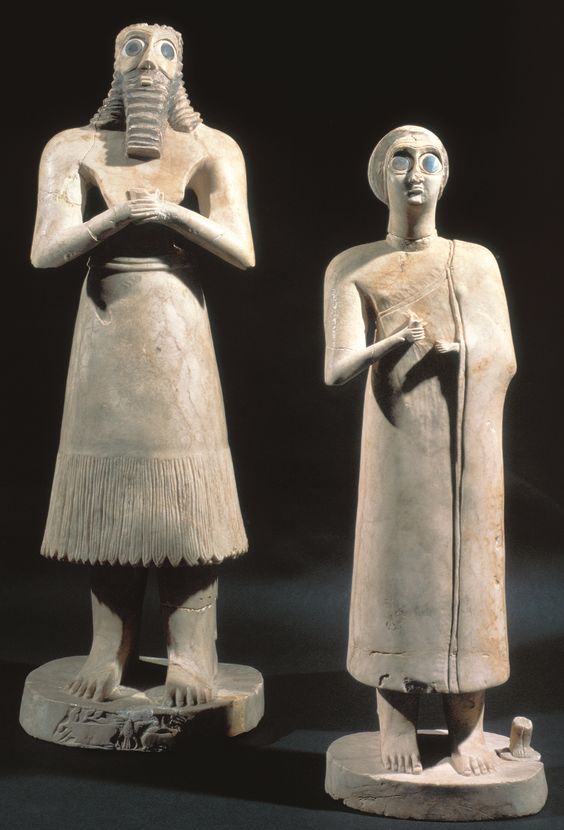
➼ Standard of Ur
Details
- From the Royal Tombs at Ur (modern Tell el-Muqayyar, Iraq)
- c. 2600–2400 B.C.E.
- A wood inlaid with shell, lapis lazuli, and red limestone
- Preserved in British Museum, London
Form
- Figures have broad frontal shoulders; bodies in profile; twisted perspective.
- Emphasis on eyes, eyebrows, ears.
- Organized in registers; figures stand on ground lines.
- Read from bottom to top.
- Ground line: a baseline upon which figures stand
- Ground plan: the map of a floor of a building
- Register: a horizontal band, often on top of another, that tells a narrative story
Content
- Two sides: war side and peace side; may have been two halves of a narrative; early example of a historical narrative.
- War side: Sumerian king, half a head taller than the others, has descended from his chariot to inspect captives brought before him, some of whom are debased by their nakedness; in the lowest register, chariots advance over the dead.
- Peace side: food brought in a procession to the banquet; musician plays the lyre; the ruler is the largest figure—he wears a kilt made of tufts of wool; may have been a victory celebration after a battle.
Context
- Found in a tomb at the royal cemetery at Ur in modern Iraq.
- Reflects extensive trading network: lapis lazuli from Afghanistan, shells from the Persian Gulf, and red limestone from India.
- Lapis lazuli: a deep-blue stone prized for its color
Theories
- It may have been part of a musical instrument's soundbox; the term "standard" comes from the idea that it was carried on a pole.
- The two scenes may show an ideal Sumerian ruler as a victorious general and a father who promotes general welfare.
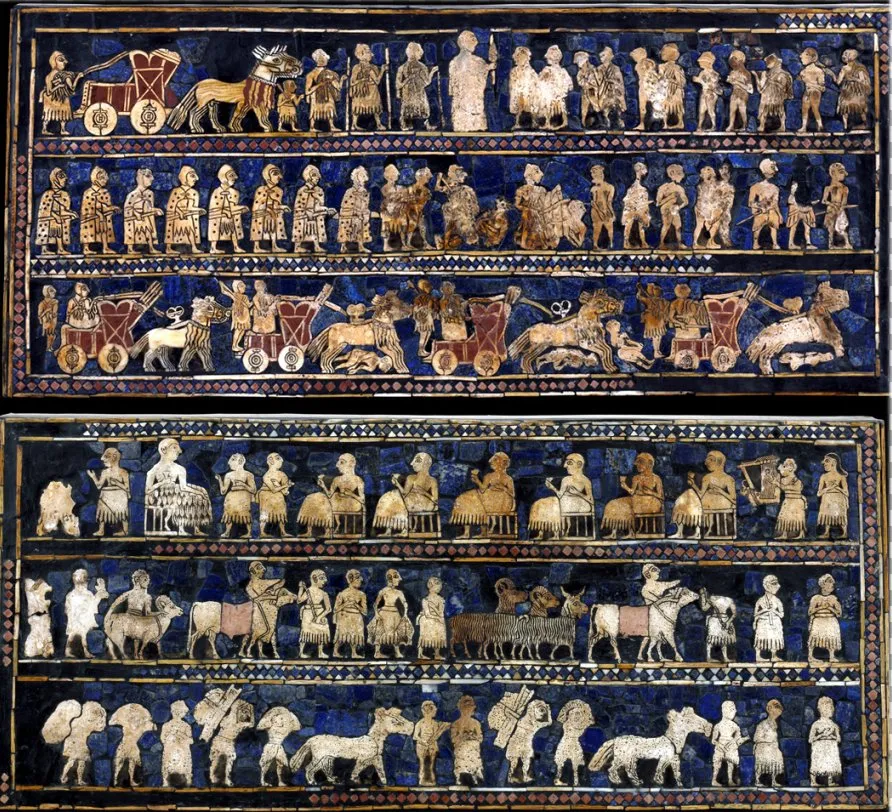
➼ Code of Hammurabi
Details
- From Babylon (modern Iran), Susian
- c. 1792–1750 B.C.E.
- Made up of basalt
- Found in Louvre, Paris
Form: A stele meant to be placed in an important location.
Function
- One of the earliest law codes is below the main scene, symbolizing a ruler's need to establish civic harmony in a civilized world.
- 300 law entries below the images symbolize Shamash giving Hammurabi the laws.
Content
- Shamash: Sun god, enthroned on a ziggurat, hands Hammurabi a rope, a ring, and a rod of kingship.
- Shamash is in a frontal view and a profile at the same time; their headdress is in profile; rays (wings?) appear from behind his shoulders.
- Shamash’s beard is fuller than Hammurabi’s, illustrating Shamash’s greater wisdom.
- Shamash, judge of the sky and the earth, with a tiara of four rows of horns, presents signs of royal power, the scepter and the ring, to Hammurabi.
- They stare at one another directly even though their shoulders are frontal; composite views.
- Hammurabi is depicted with a speaking/greeting gesture.
Context
- Written in cuneiform.
- Text in Akkadian language, read right to left and top to bottom in 51 columns.
- Law articles are written in a formula: “If a person has done this, then that will happen to him.”
History
- Hammurabi (1792–1750 B.C.E.) united Mesopotamia in his lifetime.
- Took Babylon from a small power to a dominant kingdom; after his death, the empire dwindled.
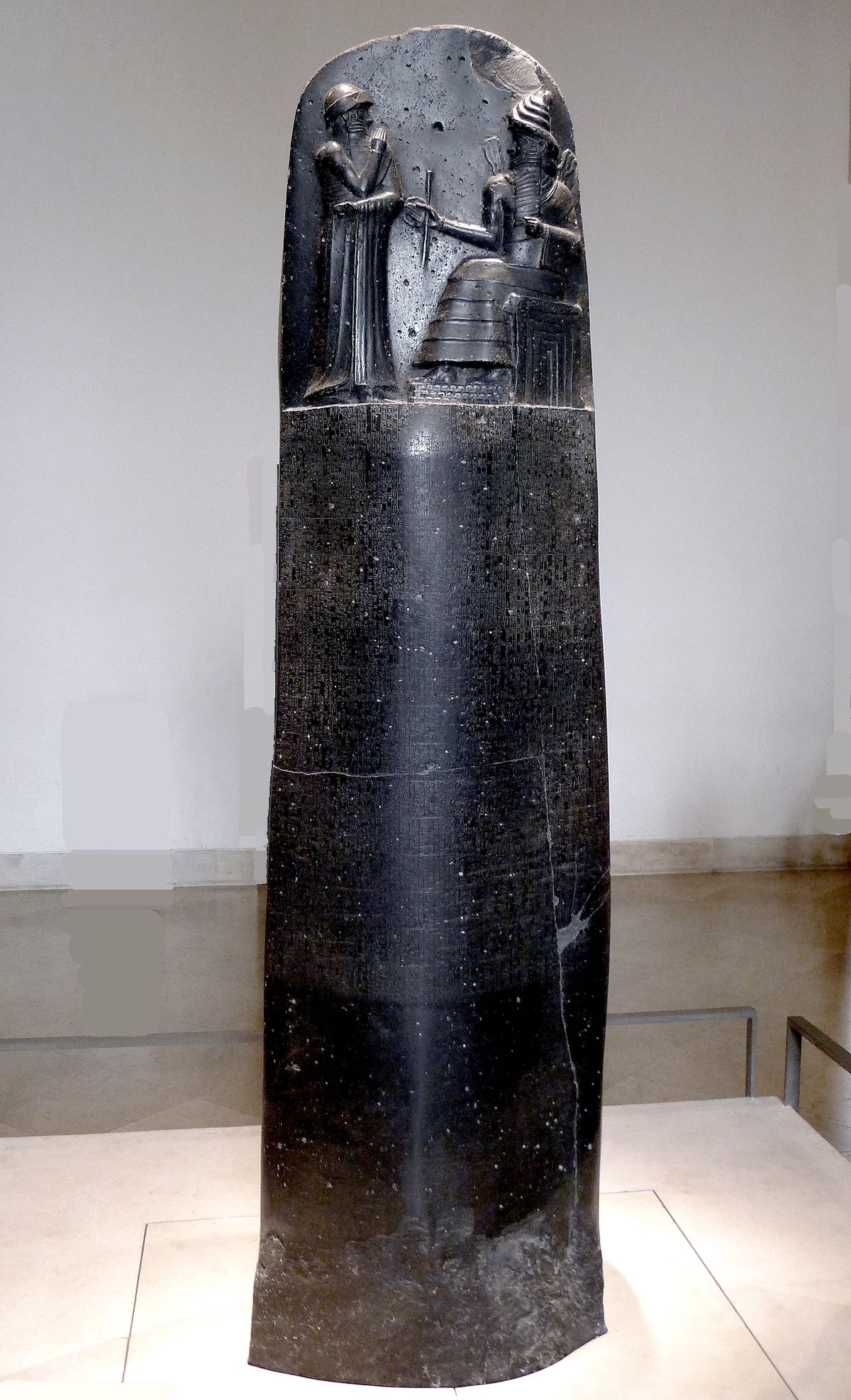
➼ Lamassu
Details
- From the citadel of Sargon II, Dur Sharrukin (modern Khorsabad, Iraq)
- c. 720–705 B.C.E.,
- An alabaster
- Found in Louvre, Paris
Form
- Human-headed animal guardian figures: face of a person, ears and body of a bull.
- Winged.
- Appears to have five legs: when seen from the front, it seems to be standing at attention; when seen from the side, the animal seems to be walking.
- Faces exude calm, serenity, and harmony.
Materials
- Carved from a single piece of stone.
- Meant to hold up the walls and arch of a gate.
- Stone is rare in Mesopotamian art and contrasts greatly with the mud-brick construction of the palace.
Function
- Meant to ward off enemies both visible and invisible.
- Inscriptions in cuneiform at the bottom portion of the lamassu declare the power of the king and curse his enemies.
Context
- Sargon II founded the capital at Khorsabad; the city was surrounded by a wall with seven gates.
- The protective spirits (guardians) were placed at either side of each gate.
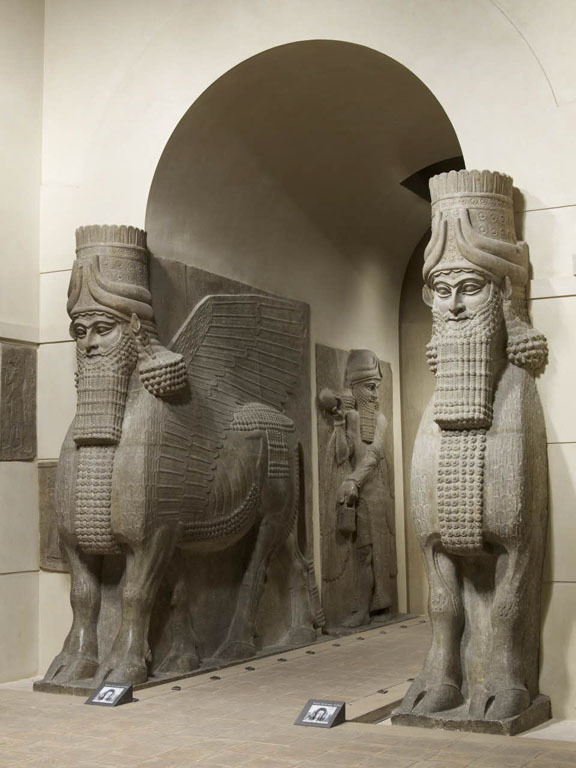
➼ Apadana of Darius and Xerxes
Details
- c. 520–465 B.C.E.
- Mainly made up of limestone
- Found in Persepolis, Iran
- Apadana: an audience hall in a Persian palace
Form
- Built on artificial terraces, as is most Mesopotamian architecture.
- Columns have a bell-shaped base that is an inverted lotus blossom; the capitals are bulls or lions.
- Everything seems to have been built to dwarf the viewer.
Function
- Built for lavish receptions and festivals, not palaces.
- Lamassu gates welcome visitors.
- The Gates of All Nations proudly proclaim this complex as the seat of a great empire.
- Audience hall (apadana): It had 36 columns covered by a wooden roof; held thousands of people; was used for the king’s receptions; had stairways adorned with reliefs of the New Year’s festival and a procession of representatives of 23 subject nations.
- Hypostyle hall: An indication of one of the many cultures that inspired the complex.
Material: Mud brick with stone facing; stone symbolizing durability and strength.
Context and Interpretation
- Darius chose this central location in Persia to protect the treasury, and relief sculptures show delegations from across the empire bringing gifts for storage.
- The immortals, the king's guard, originally painted and adorned with metal accessories, were carved into the stairs.
- The stairs have a central relief of the king enthroned with attendants, the crown prince behind him, and dignitaries bowing.
- Static processions represent a peaceful world.
History
- Built by Darius I and Xerxes I; destroyed by Alexander the Great, perhaps as an act of revenge for the destruction of the Acropolis in Athens.
- Many cultural influences (Greeks, Egyptians, Babylonians) contributed to the building of the site, as a sign of Persian cosmopolitan imperial culture.
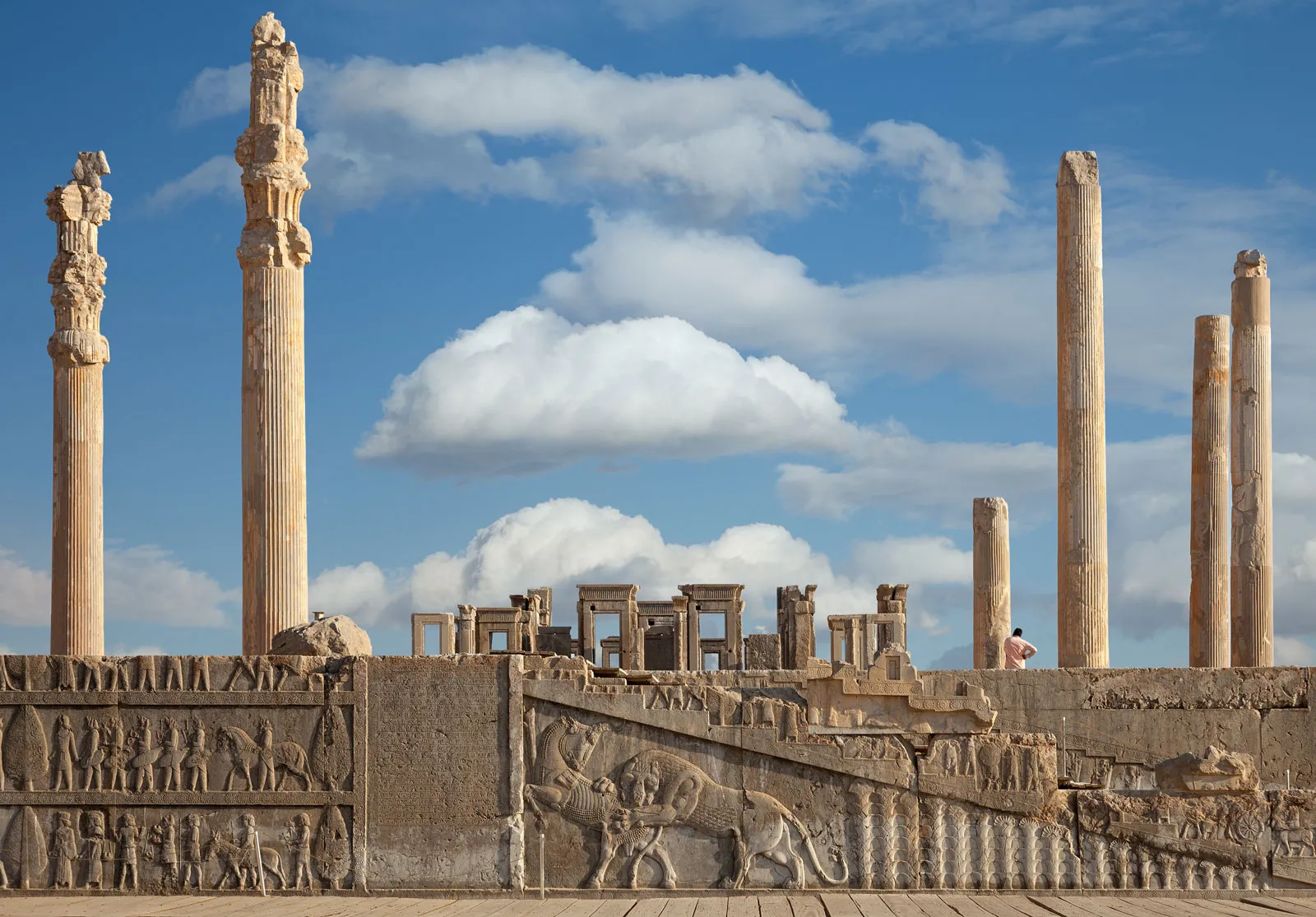
➼ Palette of King Narmer
Details
- From Predynastic Egypt
- 3000–2920 B.C.E.
- A graywacke
- Found in Egyptian Museum, Cairo
Form
- Hierarchy of Scale
- Figures stand on a ground line.
- Narrative.
- Schematic lines delineate Narmer’s muscle structure: forearm veins and thigh muscles are represented by straight lines, the kneecaps by half circles.
- Composite view of the human body: mostly seen in profile, but chest, eye, and ear are frontal.
- Hieroglyphics explain and add to the meaning, and they identify Narmer in the cartouche.
Function
- Palette used to prepare eye makeup for the blinding sun, although this palette was probably commemorative.
- Palettes carved on two sides were for ceremonial purposes.
Content
- Relief sculpture depicting King Narmer uniting Upper and Lower Egypt.
- Depicted four times at the top register is Hathor, a god as a cow with a woman’s face, or Bat, a sky goddess who has the power to see the past and the future, or a bull which symbolizes the power and strength of the king.
- On the front:
- Narmer, the largest figure, wears the Lower Egyptian cobra crown and inspects the enemy's beheaded corpses from above.
- Narmer's sandal bearer follows four standard bearers and a priest.
- In the center, mythical animals with long necks are harnessed, possibly symbolizing unification. At the bottom, a bull destroys a city fortress. — Narmer knocking over his enemies.
- On the back:
- The falcon is Horus, god of Egypt, who triumphs over Narmer’s foes; Horus holds a rope around a man’s head and a papyrus plant, symbols of Lower Egypt.
- Narmer has a symbol of strength, the bull’s tail, at his waist; wears a bowling-pin-shaped crown as king of united Egypt, beating down an enemy.
- A servant behind Narmer holds his sandals as he stands barefoot on the sacred ground as a divine king.
- Defeated Egyptians lie beneath his feet.
Theories
- Represents the unification of Upper and Lower Egypt under one ruler.
- Unification is expressed as a concept or goal to be achieved.
- May represent a balance of order and chaos.
- May reference the journey of the sun god.
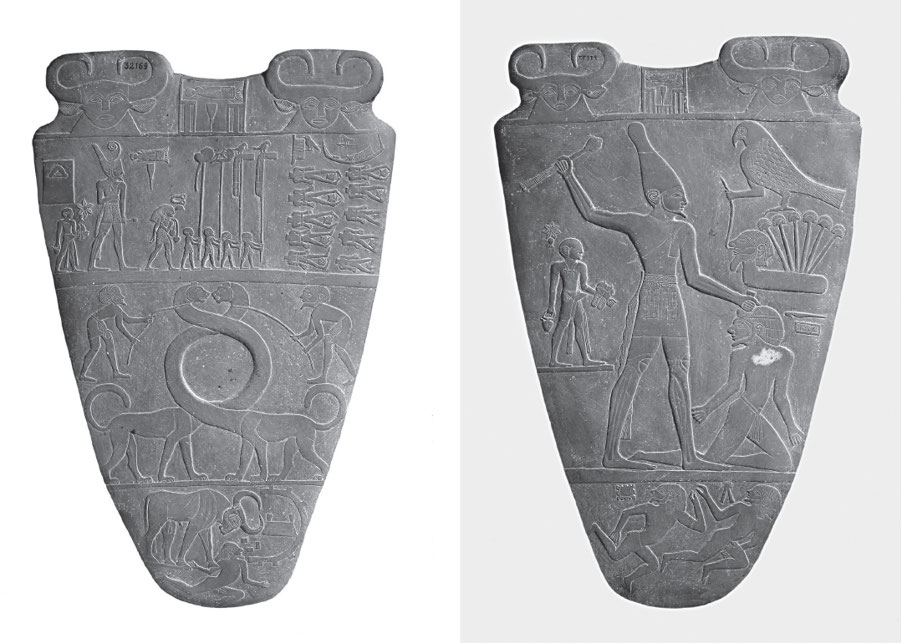
➼ Seated Scribe
Details
- From Saqqara, Egypt, Old Kingdom, 4th Dynasty
- c. 2620–2500 B.C.E.
- A painted limestone
- Found in Louvre, Paris
Form
- Not a pharaoh: sagging chest and realistic body rather than the idealistic features reserved for a pharaoh; the scribe contrasts with the ideally portrayed pharaoh.
- Figure has high cheekbones, hollow cheeks, and a distinctive jawline.
- Meant to be seen from the front.
- Color still remains on the sculpture.
Function: Created for a tomb at Saqqara as a provision for the ka.
Content
- Amazingly lifelike but not a portrait—rather, it’s a conventional image of a scribe.
- Inlaid crystal eyes.
- Holds papyrus in his lap; his writing instrument (now gone) was in his hand ready to write.
Context
- Attentive expression; thin angular face; in readiness for the words the pharaoh might dictate.
- Seated on the ground to indicate his comparative low state.
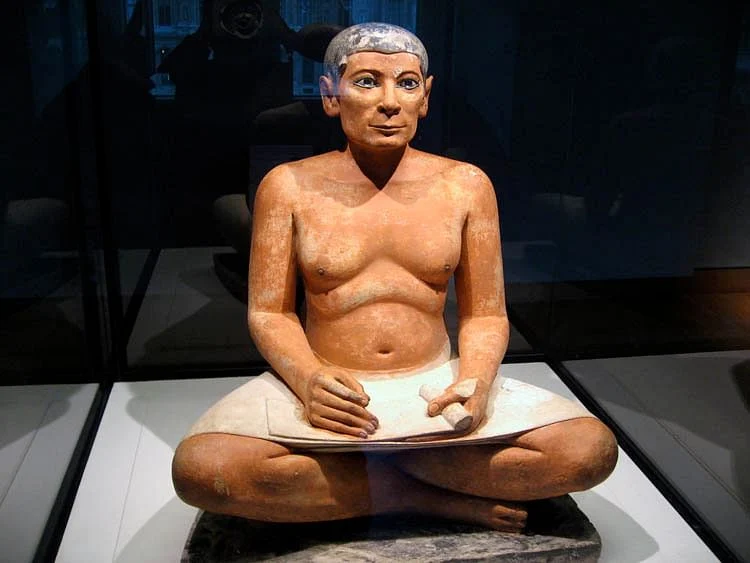
➼ Great Pyramids (Menkaura, Khafre, and Khufu)
Details
- c. 2550–2490 B.C.E.
- From Old Kingdom, 4th Dynasty
- A cut limestone,
- Found in Giza, Egypt
Form
- Each pyramid is a huge pile of limestone with a minimal interior that housed the deceased pharaoh.
- Each pyramid had an enjoining mortuary temple used for worship.
Function
- Giant monuments to dead pharaohs: Menkaura, Khufu, and Khafre.
- Preservation of the body and tomb contents for eternity.
- Some scholars also suggest that the complex served as the king’s palace in the afterlife.
Context
- Each pyramid has a funerary complex adjacent connected by a formal pathway used for carrying the dead pharaoh’s body to the pyramid to be interred.
- Shape may have been influenced by a sacred stone relic called a benben, which is shaped like a sacred stone found at Heliopolis.
- Heliopolis was the center of the sun god cult.
- Each side of the pyramid is oriented toward a point on the compass, a fact pointing to an association with the stars and the sun.
- Giza temples face east, the rising sun, and have been associated with the god Re.
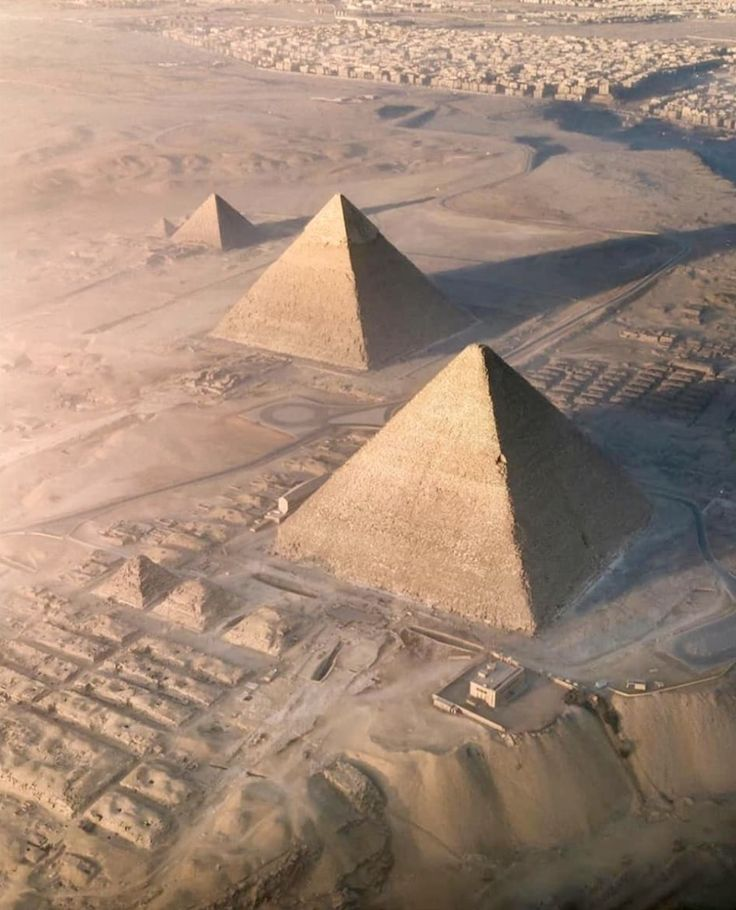
➼ Great Sphinx
Details
- C. 2500 B.C.E.
- A limestone
- Found in Giza, Egypt
Form
- Carved in situ from a huge rock; colossal scale.
- In situ: a Latin expression that means that something is in its original location
- Body of a lion, head of a pharaoh and/or god.
- Originally brightly painted to stand out in the desert behind the figure, which once rose near ramps rising from the Nile.
Function: The Sphinx seems to be protecting the pyramids behind it, although this theory has been debated.
Context and Interpretation
- Very generalized features, although some say it may be a portrait of Khafre.
- Cats are royal animals in ancient Egypt, probably because they saved the grain supply from mice.
History
- Head of the Sphinx badly mauled in the Middle Ages.
- Fragment of the Sphinx’s beard is in the British Museum.
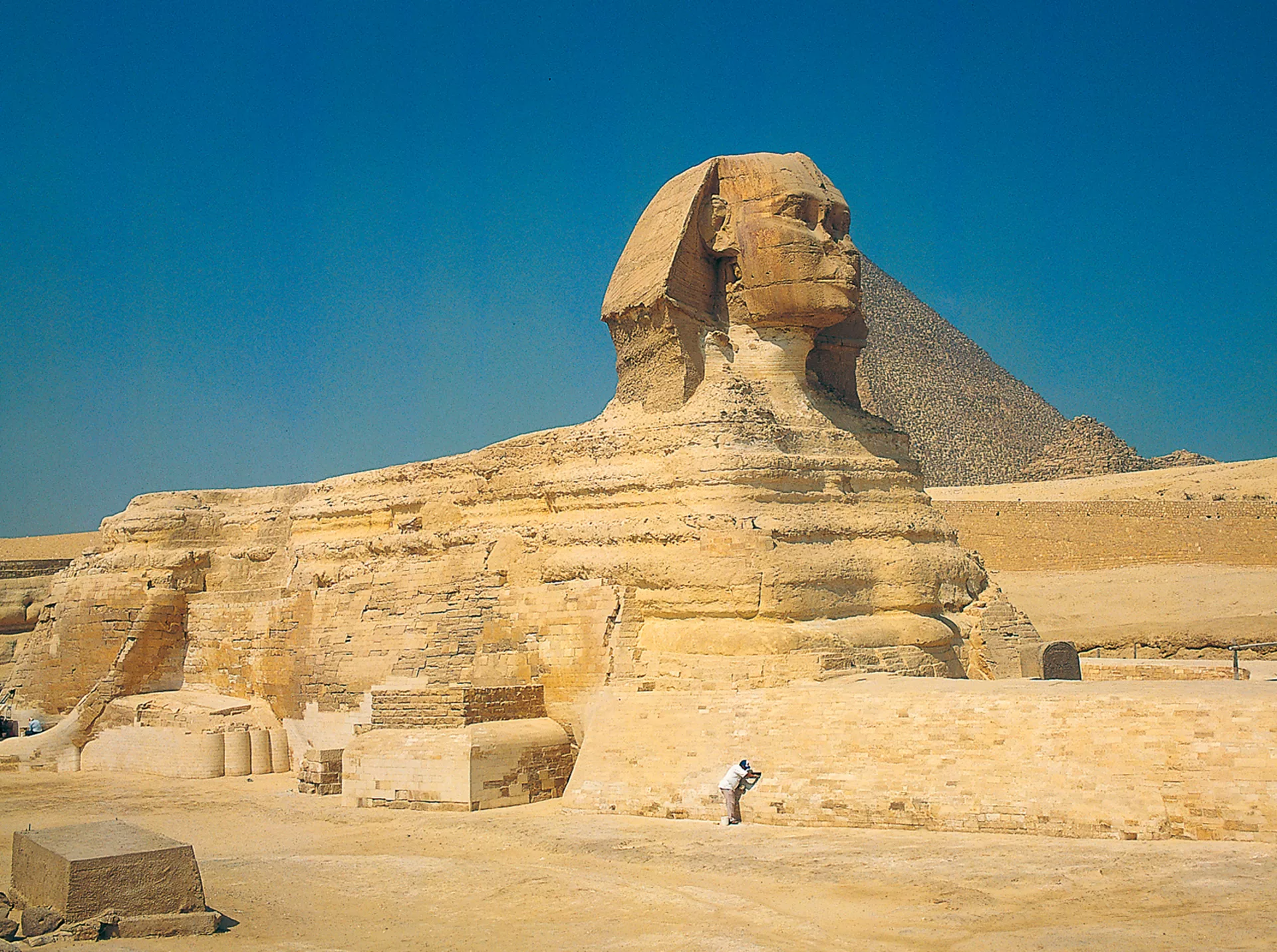
➼ King Menkaura and Queen
Details
- From the Old Kingdom, 4th Dynasty
- 2490– 2472 B.C.E.
- A graywacke
- Found in Museum of Fine Arts, Boston
Form
- Two figures attached to a block of stone; arms and legs not cut free.
- Traces of red paint exist on Menkaura’s face and black paint on the queen’s wig.
- Figures seem to stride forward, but simultaneously are anchored to the stone behind; it is unusual for the female figure to be striding with the male.
- Figures stare out into space (the afterlife?).
Function
- Receptacle for the ka of the pharaoh and his queen.
- Ka: the soul, or spiritual essence, of a human being that either ascends to heaven or can live in an Egyptian statue of itself
- Wife’s simple and affectionate gesture, and/or presenting him to the gods.
Materials: Extremely hard stone used; symbolizes the permanence of the pharaoh’s presence and his strength on earth.
Context
- Menkaura’s powerful physique and stride symbolize his kingship, as does his garb: nemes on the head, an artificial beard, and a kilt with a tab.
- Original location was the temple of Menkaura’s pyramid complex at Giza.
- Society’s view of women is expressed in the ankle-length tightly draped gown covering the queen’s body; men and women of the same height indicated equality.
- Society’s view of the king is expressed in his broad shoulders, muscular arms and legs, and firm stomach.
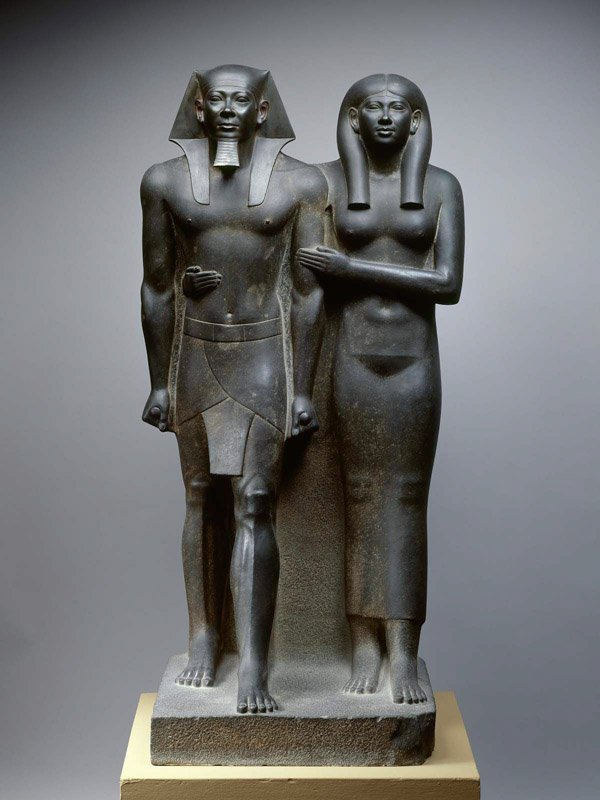
➼ Temple of Amun-Re and Hypostyle Hall
Details
- Temple: 1550 B.C.E.
- Hall: 1250 B.C.E.
- From New Kingdom, 18th and 19th Dynasties
- A cut sandstone and mud brick
- Found in Karnak, near Luxor, Egypt
- Hypostyle: a hall that has a roof supported by a dense thicket of columns
Form
- Axial plan: a building with an elongated ground plan
- Pylon temple.
- Pylon: a monumental gateway to an Egyptian temple marked by two flat, sloping walls between which is a smaller entrance
- Hypostyle halls.
- Massive lintels link the columns together.
- Huge columns, tightly packed together, admit little light into the sanctuary.
- Tallest columns have papyrus capitals; a clerestory allows some light and air into the darkest parts of the temple.
- Clerestory: a roof that rises above lower roofs and thus has window space beneath carved into a surface so that the figures seem to project forward
- Columns elaborately painted.
- Columns carved in sunken relief.
- Sunken relief: a carving in which the outlines of figures are deeply
- Bottom of columns have bud capitals.
- Massive walls enclose complex.
- Enter complex through massive sloped pylon gateway into a peristyle courtyard, then through a hypostyle hall, and then into the sanctuary, where few were allowed.
- Peristyle: a colonnade surrounding a building or enclosing a courtyard
Function
- Egyptian temple for the worship of Amun-Re.
- God housed in the darkest and most secret part of the complex, only accessed by priests and pharaohs.
Context
- Adjacent is an artificial sacred lake—a symbol of the sacred waters of the world that existed before time.
- Located on the east side of the Nile, linked by a road with the Karnak temple for the Opet festival.
- The complex was built near this lake over time; symbolically, it arose from the waters the way civilization did.
- Theory that the temple represents the beginnings of the world:
- Pylons are the horizon.
- Floor rises to the sanctuary of the god.
- Temple roof is the sky.
- Columns represent plants of the Nile: lotus, papyrus, palm, etc.
History
- Built by succeeding generations of pharaohs over a great expanse of time.
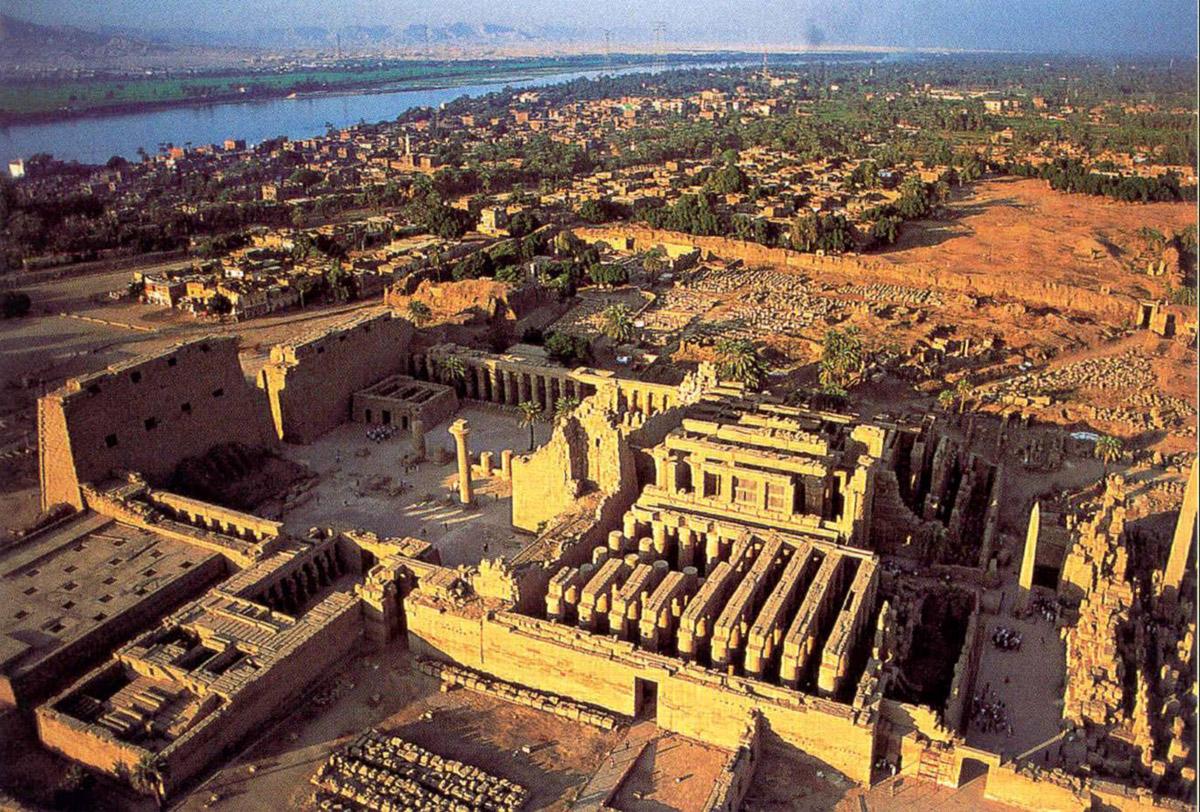
➼ Mortuary Temple of Hatshepsut
Details
- c. 1473–1458 B.C.E.
- New Kingdom, 18th Dynasty,
- A sandstone partly carved into a rock cliff
- Found near Luxor, Egypt
Form
- Three colonnaded terraces and two ramps.
- Visually coordinated with the natural setting; long horizontals and verticals of the terraces and colonnades repeat the patterns of the cliffs behind; patterns of dark and light in the colonnade are reflected in the cliffs.
Function
- Hatshepsut declared that she built the temple as “a garden for my father, Amun”
- Only used for special religious events; lacks subsidiary buildings for offering storage, priest housing, temple administration, workshops, and other functions.
- Cultic purity prevented the royal burial in the temple.
- Valley of the Kings led to the royal tomb in the mountain behind the temple.
Context
- First time the achievements of a woman are celebrated in art history; Hatshepsut’s body is interred elsewhere.
- Temple aligned with the winter solstice, when light enters the farthest section of the interior.
- Located on the west side of the Nile across from Thebes.
- Perhaps designed by Senenmut, a high-ranking official in Hatshepsut’s court.
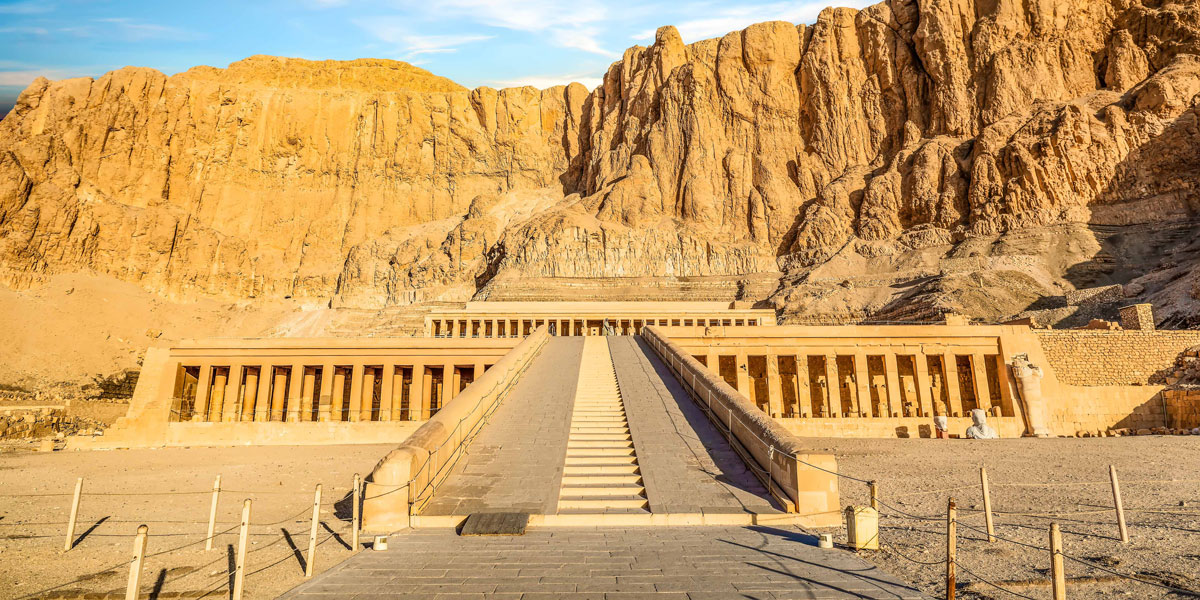
➼ Kneeling Statue of Hatshepsut
Details
- 1473–1458 B.C.E.
- Made of red granite
- Found in the Metropolitan Museum of Art, New York
Form
- Male pharaonic attributes: nemes or headcloth, false beard, kilt.
- Wears the white crown of Upper Egypt.
- Queen is depicted in male costume of a pharaoh, yet slender proportions and slight breasts indicate femininity.
Function
- Statue of the god brought before sculpture in a procession.
- Processions up the mortuary temple passed in front of this statue of Hatshepsut.
- One of 200 statues placed around the complex.
Context
- One of 10 statues of Hatshepsut with offering jars, part of a ritual in honor of the sun god; pharaoh would kneel only before a god.
- Inscription on base says she is offering plants to Amun, the sun god.

➼ Akhenaton, Nefertiti, and Three Daughters
Details
- 1353–1335 B.C.E.
- New Kingdom (Amarna) 18th Dynasty
- Made up of limestone
- Found in Egyptian Museum, Berlin
Content
- Akhenaton holds his eldest daughter (left), ready to be kissed.
- Nefertiti holds her daughter (right) with another daughter on her shoulder.
- Intimate family relationships are extremely rare in Egyptian art.
Form
- State religion shift indicated by an evolving style in Egyptian art:
- Smoother, curved surfaces
- Low-hanging bellies.
- Slack jaws.
- Thin arms.
- Epicene bodies.
- Heavy-lidded eyes.
- At the end of the sun’s rays, ankhs point to the king and queen.
- Ankh: an Egyptian symbol of life
Function: The domestic environment was new in Egyptian art; the panel is for an altar in a home
Technique
- Sunken relief, which is less likely to be damaged than raised relief.
- Sunken relief creates deeper shadows and can be appreciated in the sunlight.
Context
- Akhenaton abandoned Thebes and created a new capital, originally named Akhenaton and later changed to Amarna; the style of art from this period is called the Amarna Style.
- Amarna style: art created during the reign of Akhenaton, which features a more relaxed figure style than in Old and Middle Kingdom art
- The state religion was changed by Akhenaton to the worship of Aton, symbolized by the sun-disk with a cobra; he changed his name from Amenhotep IV to Akhenaton to reflect his devotion to the one god Aton.
- Akhenaton and Nefertiti are having a private relationship with their new god, Aton.
- After Akhenaton’s reign, the Amarna style was slowly replaced by more traditional Egyptian representations.

➼ Innermost Coffin of King Tutankhamun’s tomb
Details
- From New Kingdom, 18th Dynasty
- c. 1323 B.C.E.
- A gold with an inlay of enamel and semi-precious stones
- Found in Egyptian Museum, Cairo
Form
- Gold coffin (6 feet, 7 inches long) containing the body of the pharaoh.
- Smooth, idealized features on the mask of the boy king.
- Holds a crook and a flail, symbols of Osiris.
Function: Mummified body of King Tutankhamun was buried with 143 objects, on his head, neck, abdomen, and limbs; a gold mask was placed over his head.
Context
- When Akhenaton died, two pharaohs ruled briefly, and then his son Tutankhamun reigned for ten years, from age 9 to 19.
- Tutankhamun’s father and mother were brother and sister; his wife was his half-sister; perhaps he was physically handicapped because of genetic inbreeding.
History: Famous tomb was discovered by Howard Carter in 1922.
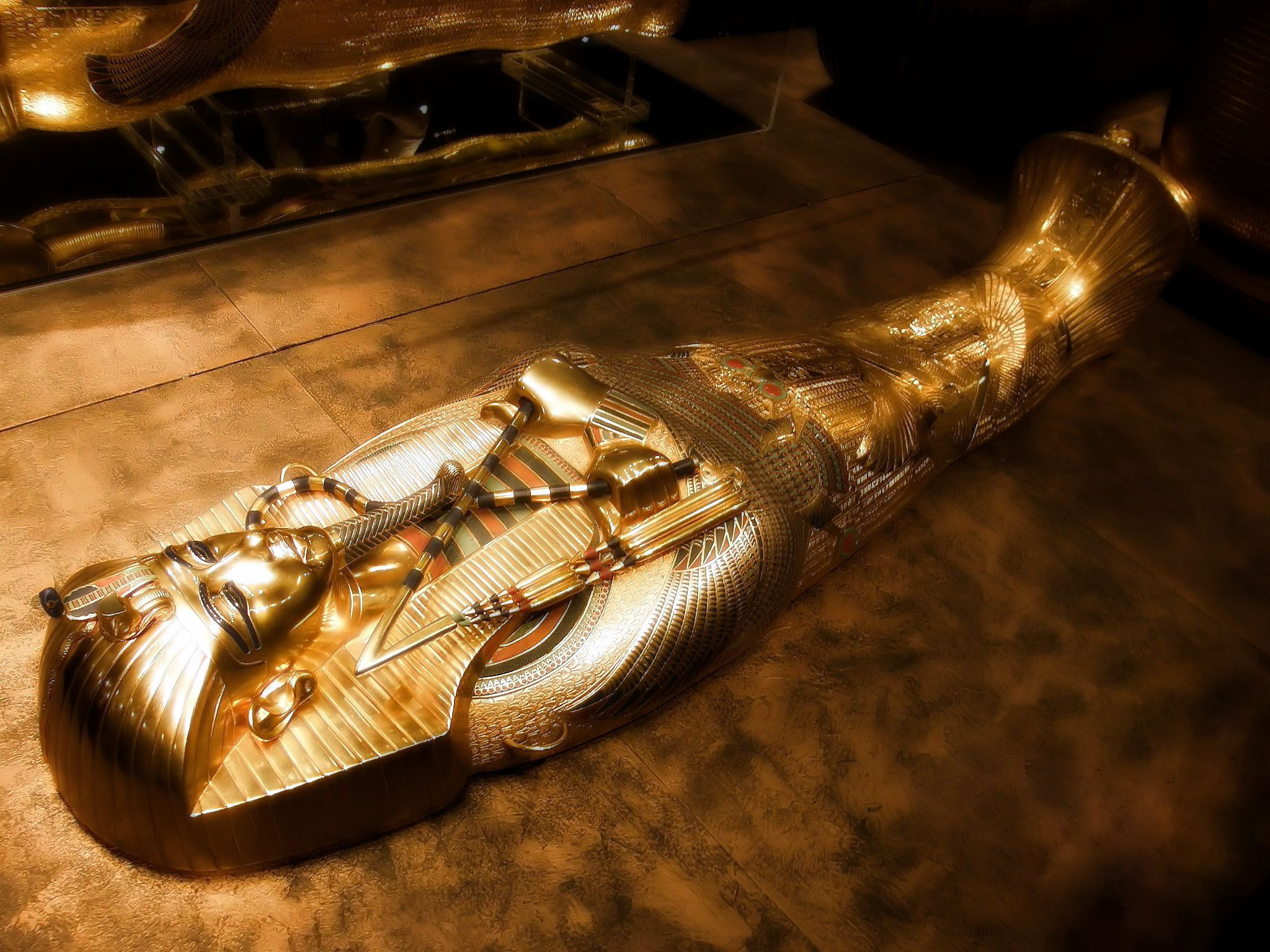
➼ Last Judgment of Hunefer
Details
- Page from the Book of the Dead
- From New Kingdom, 19th Dynasty
- c. 1275 B.C.E.
- A painted papyrus scroll
- Found in British Museum, London
Form: Narrative on a uniform register (read right to left).
Function: Illustration from the Book of the Dead, an Egyptian book of spells and charms that acted as a guide for the deceased to make his or her way to eternal life.
Content
- Top register — Hunefer in white at left before a row of judges.
- Main register — the jackal-headed god of embalming, Anubis, leads the deceased into a hall, where his soul is weighed against a feather. If his sins weigh more than a feather, he will be condemned.
- Ammit: The hippopotamus/lion figure; between the scales, will eat the heart of an evil soul.
- Thoth: A god who has the head of a bird; the stenographer writing down these events in the hieroglyphics that he invented.
- Osiris: god of the underworld, enthroned on the right; will subject the deceased to a day of judgment.
Context
- Hunefer: A scribe who had priestly functions.
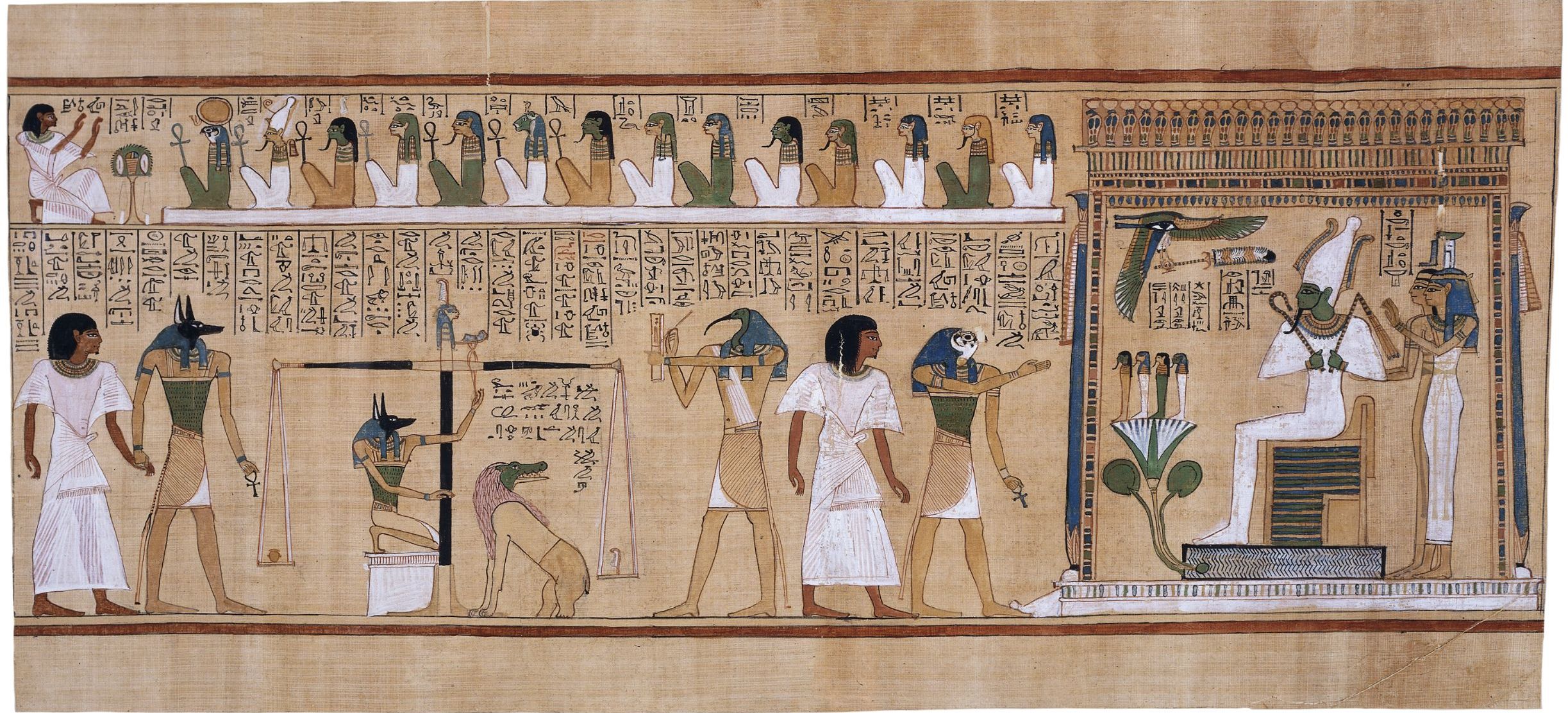
➼ Anavysos Kouros
Details
- From Archaic Greek
- c. 530 B.C.E.
- A marble with remnants of paint
- Found in National Archaeological Museum, Athens
- Kouros (female: kore): An archaic Greek sculpture of a standing youth
Form
- Emulates the stance of Egyptian sculpture but is nude; arms and legs are largely cut free from the stone.
- Rigidly frontal.
- Freestanding and able to move; in contrast, many Egyptian works are reliefs or are attached to the stone.
- Hair is knotted and falls in neatly braided rows down the back.
- Some paint survives, some of it encaustic, which would have given the sculpture greater life.
- Encaustic: a type of painting in which colors are added to hot wax to affix to a surface
- “Archaic smile” meant to enliven the sculpture.
Function
- Grave marker, replacing huge vases of the Geometric period.
- Sponsored by an aristocratic family.
Content
- Not a real portrait but a general representation of the dead.
- Named after a young military hero, Kroisos; the inscription at the base identifies him: “Stand and grieve at the tomb of Kroisos, the dead, in the front line slain by the wild Ares.”
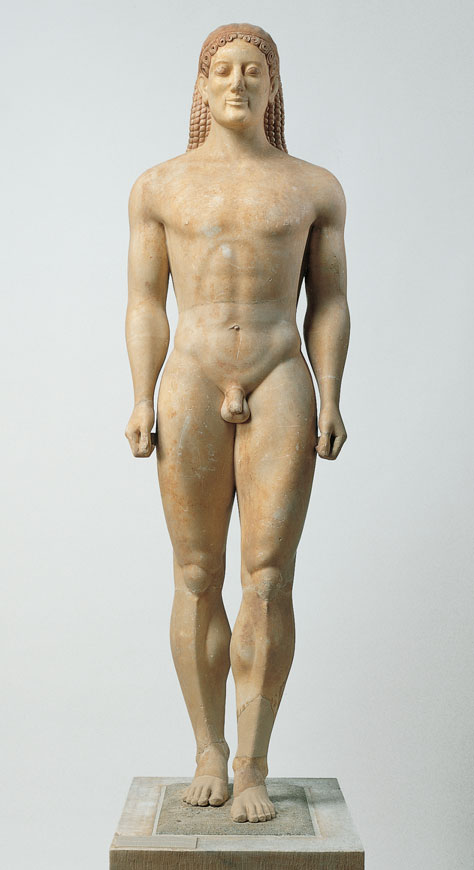
➼ Peplos Kore
Details
- From the Acropolis, Archaic Greek
- c. 530 B.C.E.
- A marble and painted details
- Found in Acropolis Museum, Athens
- Peplos: a garment worn by women in ancient Greece, usually full length and tied at the waist
Form
- Hand emerges into the viewer’s space, breaks out of the mold of static Archaic statues.
- Indented waist.
- Breasts revealed beneath drapery.
- Rounded and naturalistic face.
- Much of the encaustic paint still remains, animating the face and hair.
- Broken hand was fitted into the socket and probably held an attribute; she may have been a goddess.
Context: She is named for the peplos, thought to be one of the four traditional garments she is wearing.
Theory
- Recent theory proposes that she is the goddess, either Athena or Artemis; the figure is now missing arrows and a bow in her hand, and she may have worn a metal diadem on her head.
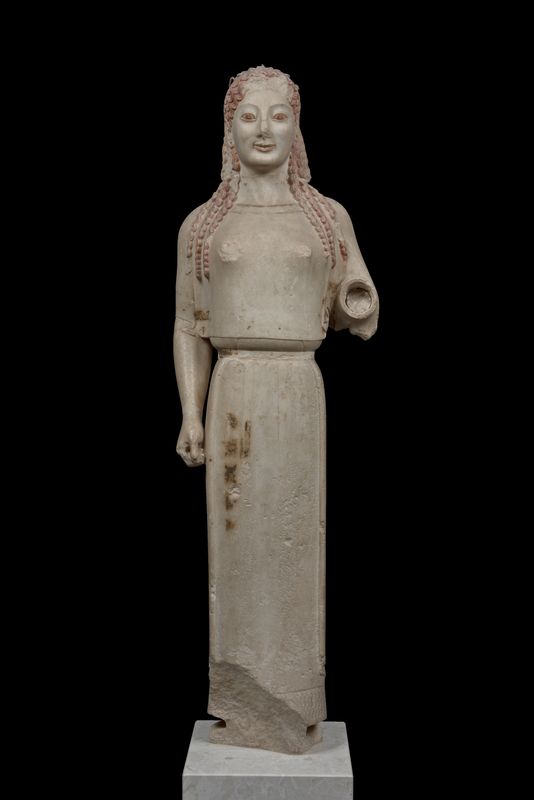
➼ Doryphoros (Spear Bearer)
Details
- A sculpture of Polykleitos
- original: c. 450–440 B.C.E.
- A Roman marble copy of a Greek bronze original,
- Found in National Archaeological Museum, Naples
Form
- Blocky solidity.
- Closed stance.
- Broad shoulders, thick torso, muscular body.
- Idealized body; contrapposto.
- Body is both tense and relaxed: left arm and right leg are relaxed, right arm and left leg are tense.
Content
- Warrior and athlete.
- Hand once held a spear.
- Movement is restrained; ideal Spartan body.
- Averted gaze; he does not recognize the viewer’s admiration.
- Contemplative gaze.
Context: Represents Polykleitos’s ideal masculine figure.
History
- Marble Roman copy of a bronze Greek original.
- Found in Pompeii in a place for athletic training, perhaps for inspiration for athletes.
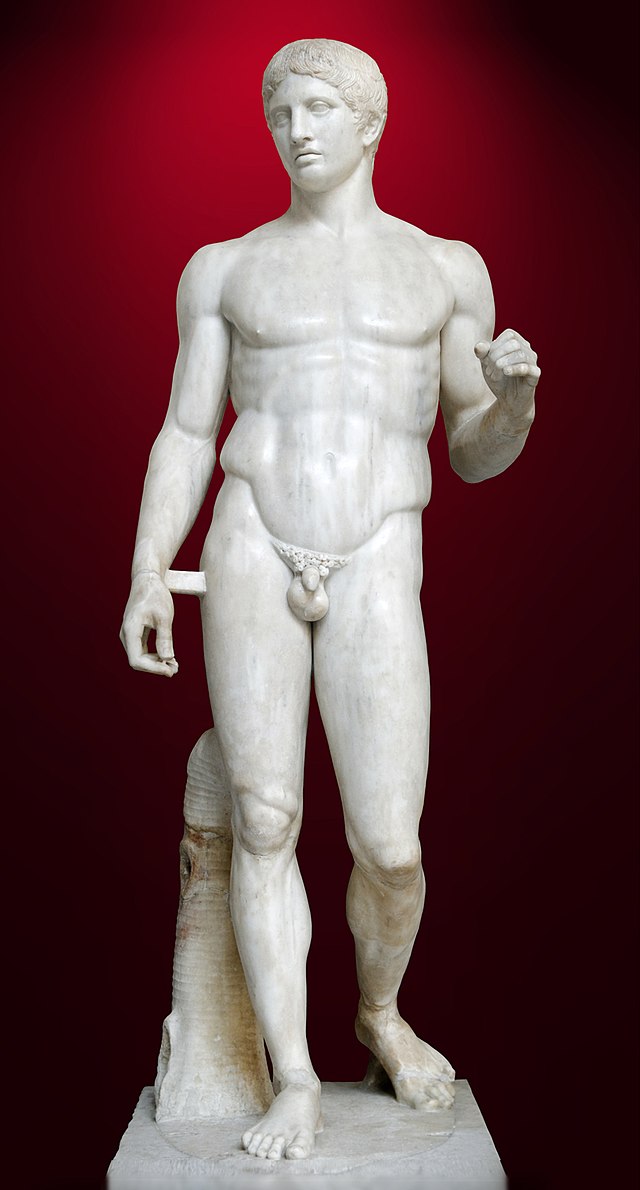
➼ Helios, Horses, and Dionysus (Heracles?)
Details
- c. 438–432 B.C.E.
- Made up of marble
- Found in British Museum, London
Form
- Greek Classical art; contrapposto.
- Figures seated in the left-hand corner of the east pediment of the Parthenon
- Sculptures comfortably sit in the triangular space of the pediment.
Function
- Part of the east pediment of the Parthenon.
- This grouping contains figures who are present at the birth of Athena, which is the main topic at the center of pediment—now lost.
Content
- On the left, the sun god, Helios, bringing up the dawn with his horses; the male nude is Dionysus, god of wine, and he is lounging.
- Two seated figures may be the goddesses Demeter and Persephone, reacting to the birth of Athena.
Context
- Part of the Parthenon sculptures, also called the Elgin Marbles.
- Phidias acted as the chief sculptor of the workshop.

➼ Plaque of the Ergastines
Details
- c. 447–438 B.C.E.
- Made up of marble
- Found in Louvre, Paris
Form
- Isocephalism: the tradition of depicting heads of figures on the same level.
- Figures stand in contrapposto.
- Carved in high relief, which reflects placement; the more three-dimensional the relief, the better it could be seen from below.
Content: Six ergastines, young women in charge of weaving Athena’s peplos, are greeted by two priests.
Context
- Part of a frieze from the Parthenon that depicts some 360 figures.
- Frieze: a horizontal band of sculpture
- Scene from the Panathenaic Frieze depicting the Panathenaic Procession, held every four years to honor Athena.
- Panathenaic Way: a ceremonial road for a procession built to honor Athena during a festival
- This is the first time in Greek art that human events are depicted on a temple.
- The scene contains a religious procession of women dressed in contemporary drapery and acting nobly.
- The procession began at the Dipylon Gate, passed through the agora, and ended at the Parthenon.
- Athenians placed new peplos on an ancient statue of Athena.
Theory: Not the Panathenaic procession but the story of the legendary Athenian king Erechtheus, who sacrificed one of his daughters to save the city of Athens; told to do so by the Oracle of Delphi.
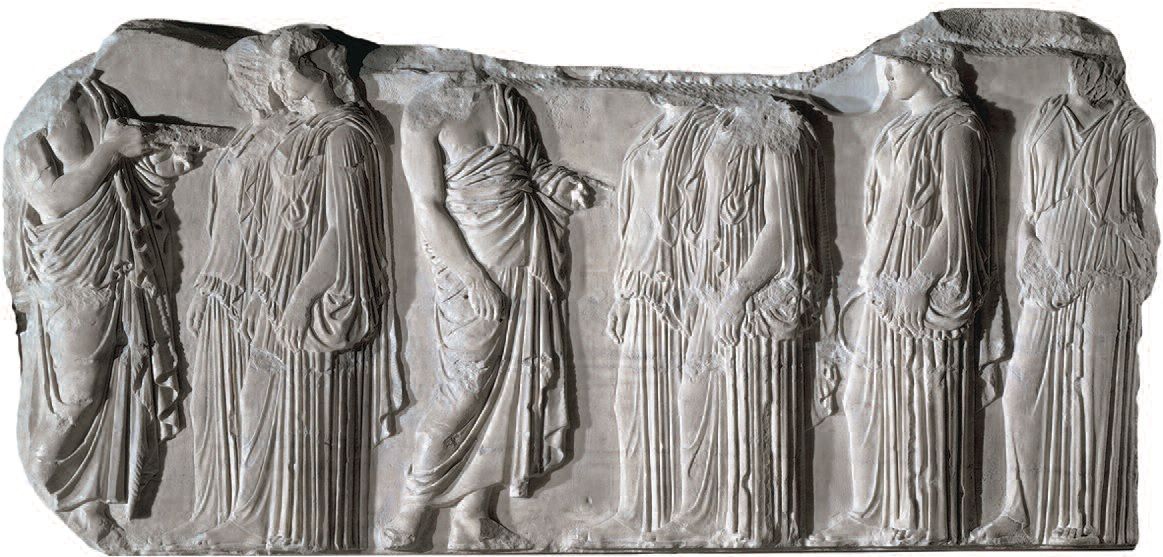
➼ Victory Adjusting Her Sandal
Details
- From the Temple of Athena Nike
- c. 410 B.C.E.
- Made up of marble
- Found in Acropolis Museum, Athens
- Nike: ancient Greek goddess of victory
Form
- Graceful winged figure modeled in high relief.
- Deeply incised drapery lines reveal body; wet drapery.
Context
- Part of the balustrade on the Temple of Athena Nike, a war monument.
- One of many figures on the balustrade; not a continuous narrative but a sequence of independent scenes.
- The importance of military victories was stressed in the images on the Acropolis.
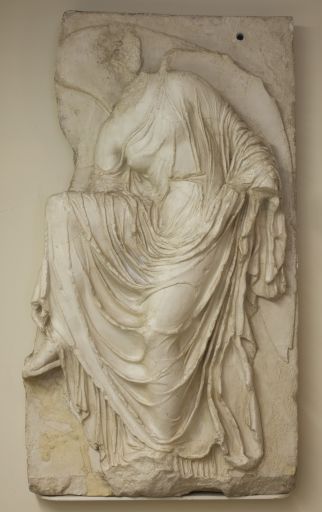
➼ Grave Stele of Hegeso
Details
- Attributed to Kallimachos
- c. 410 B.C.E.
- Made up of marble and paint
- Found in National Archaeological Museum, Athens
- Stele: an upright stone slab used to mark a grave or a site
Form
- Classical period of Greek art.
- Use of contrapposto in the standing figure.
- Jewelry painted in, not visible.
- Architectural framework.
- Text includes name of the deceased.
Function
- Grave marker.
- In Geometric and Archaic periods, Greeks used kraters and kouroi to mark graves; in the Classical period, stelae were used.
Content
- Commemorates the death of Hegeso; an inscription identifies her and her father.
- Genre scene is that Hegeso examines a piece of jewelry from a jewelry box handed to her by a standing servant; may represent her dowry.
- Standing figure has a lower social station, placed before a seated figure.
Context
- Erected in the Dipylon cemetery in Athens.
- Attributed to the sculptor Kallimachos.
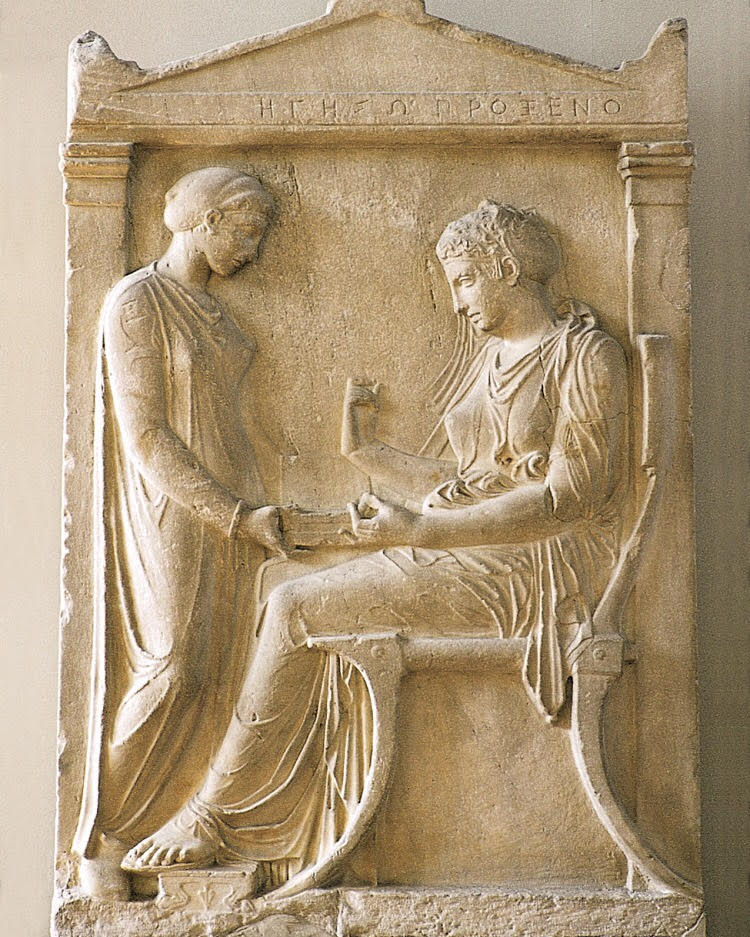
➼ Winged Victory of Samothrace
Details
- Hellenistic Greek
- c. 190 B.C.E.
- Made up of marble
- Found in Louvre, Paris
Form
- Monumental figure.
- Dramatic twist and contrapposto of the torso.
- Wet drapery look imitates water playing on the wet body.
- Illusion of wind on the body.
Function: Meant to sit on a fountain representing a figurehead on a boat; the fountain would splash water around the figure.
Content
- Large heroic figure of Nike placed above the marble prow of a naval vessel.
- Nike is wearing several garments, some of which are folded inside out to show the force of the wind.
- Nike may have held a trumpet, wreath, or fillet in her right hand. However, the hand found in Samothrace in 1950 has an open palm and two outstretched fingers, indicating that she was simply greeting.
Context
- Probably made to commemorate a naval victory in 191 B.C.E.; Nike is the goddess of victory.
- The boat at the base is an ancient battleship with oar boxes and traces of a ram.
History
- Found in 1863 in situ on Samothrace.
- Reassembled in the Louvre Museum in Paris and placed at the top of a grand staircase.
- Only one wing was found; the other is a mirror image.
- Only one breast was found; the other is a reconstruction.
- The right hand has been found, but it cannot be attached because no arms have been found.
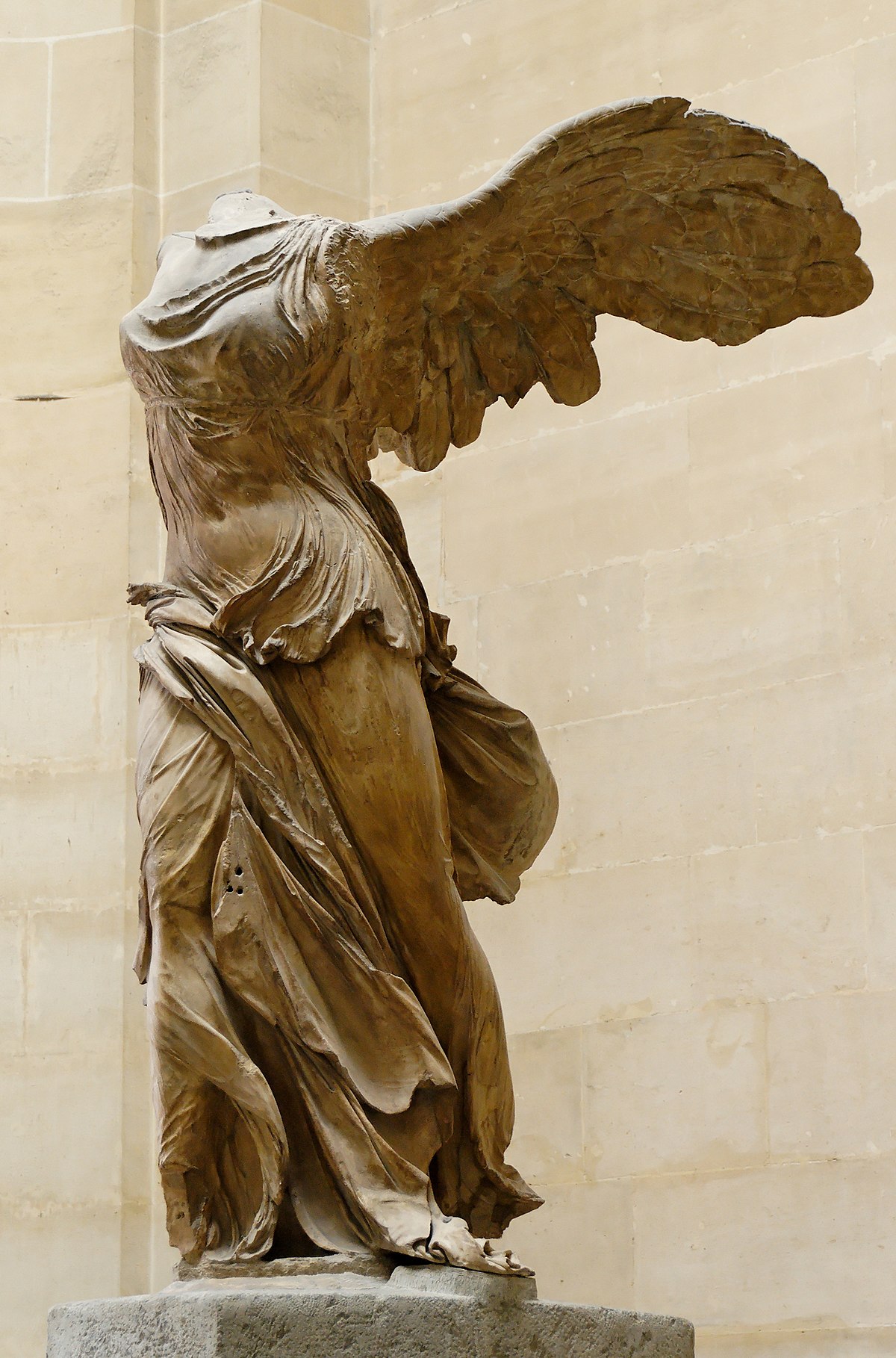
➼ Athena, from the Great Altar of Zeus and Athena at Pergamon
Details
- Hellenistic Greek
- c. 175 B.C.E.
- Made up of marble
- Found in Pergamon Museum, Berlin
- Athena: Greek goddess of war and wisdom; patron of Athens
- Zeus: King of the ancient Greek gods; known as Jupiter to the Romans; god of the sky and weather
Form
- Deeply carved figures overlap one another; masterful handling of spatial illusion; figures break into the viewer’s space from the frieze.
- Dramatic intensity of figures and movement; heroic musculature.
Function
- Gigantomachy on the base of the Pergamon Altar illustrates the victories of the goddess Athena, who is worshipped at the altar.
- Gigantomachy: a mythical ancient Greek war between the giants and the Olympian gods
Content
- Describes the battle between the gods and the giants; the giants, depicted as helpless, are dragged up the stairs to worship the gods.
- Athena grabs Alkyoneos by the hair and drags him up the stair to worship Zeus.
- Nike, on the right, crowns Athena in victory.
- Gaia, the earth goddess, looks on in horror and pleads for the fate of her sons, the giants.
Context
- The gods’ victory over the giants offers a parallel to Alexander the Great’s defeat of the Persians.
- Also acts as an allegory of a Greek military victory by Eumenes II.
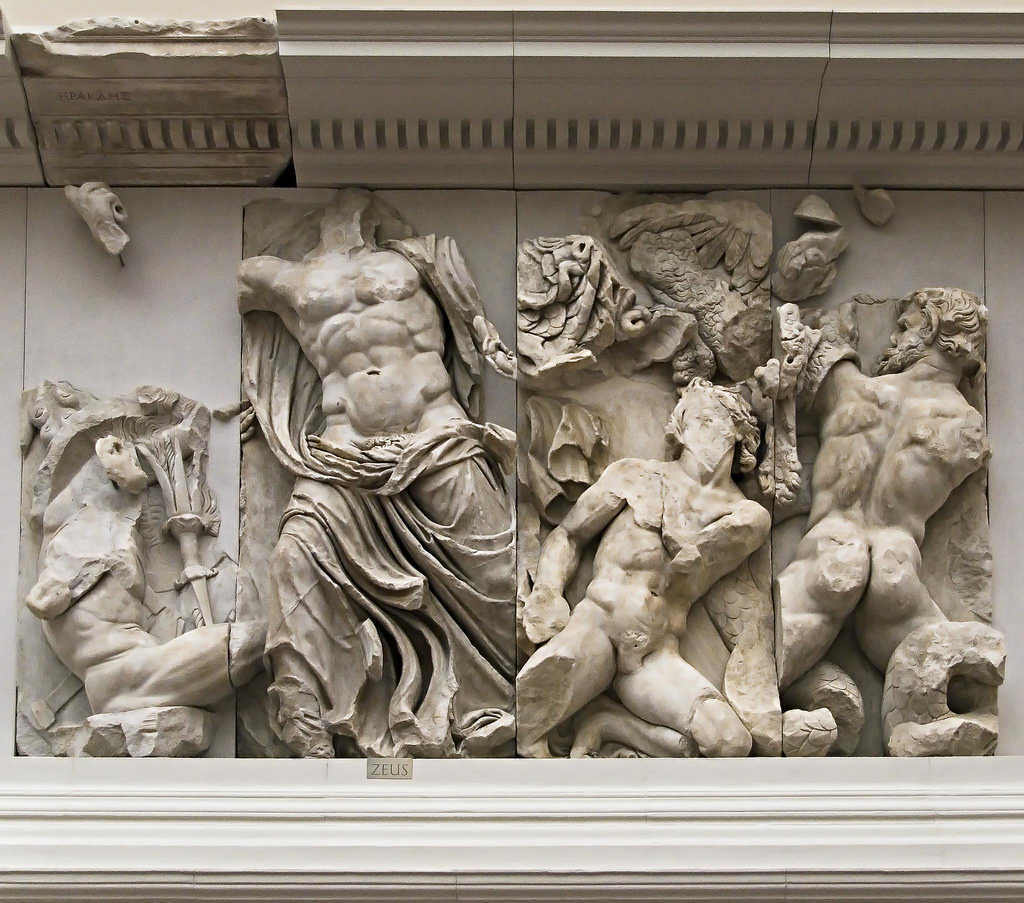
➼ Seated Boxer
Details
- Hellenistic Greek
- c. 100 B.C.E.
- Made up of bronze
- Found in National Roman Museum, Rome
Form
- Older man, past his prime, looks defeated.
- Smashed nose; lips sunken in suggesting broken teeth.
- Cauliflower ears.
- Nude fighter; hands wrapped in leather bands.
- Figure evinces sadness, stoicism and determination.
Function: May have been a good luck charm for athletes; evidence of toes worn away from being touched.
Materials
- Rare surviving Hellenistic bronze.
- Blood, denoted in copper, drips from his face and onto his right arm and thigh.
- Copper used to highlight his lips and nipples, the straps on his leather gloves, and the wounds on his head.
Context
- May have been part of a group or perhaps a single sculpture, the head turned to face an unseen opponent.
- Found in a Roman bath in Rome.
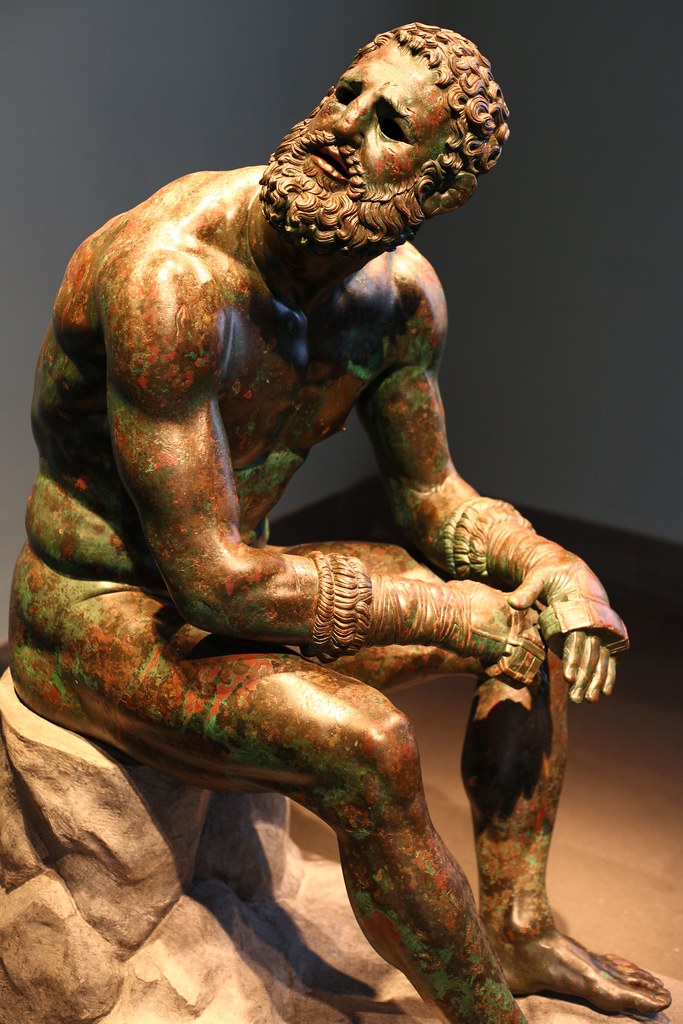
➼ Athenian Agora
Details
- Archaic through Hellenistic Greek
- 600–150 B.C.E.
- Found in Athens, Greece
- Agora: a public plaza in a Greek city where commercial, religious, and societal activities are conducted
Function
- A plaza at the base of the Acropolis in Athens with commercial, civic, religious, and social buildings where ceremonies took place.
- Setting for the Panathenaic Festival, ceremonies, and parades to honor Athena.
- The Panathenaic Way cuts through along a hilly terrain from the northwestern to the southeastern corners.
Content
- Bouleuterion: a chamber used by a council of 500 citizens, called a boule, who was chosen by lot to serve for one year.
- Tholos: a round structure manned by a group of senators 24 hours a day for emergency meetings; served as a dining hall where the prytaneis (executives) of the boule often met.
- Stoas: Covered walkway with columns on one side and a wall on the other.
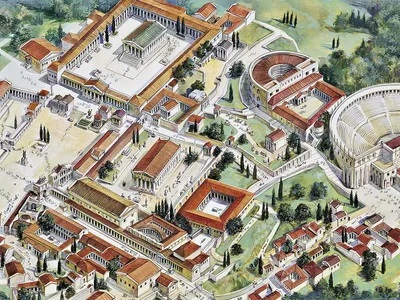
➼ Parthenon
Details
- By Iktinos
- From The Parthenon
- 447–410 B.C.E.
- Found in Athens, Greece
Form
- Greek predilection for algebra and geometry is omnipresent in the design of this building: parts can be expressed as x = 2y + 1; thus, there are 17 columns on the side (x) and 8 columns in the front (y), and the ratio of the length to the width is 9:4. Proportions are the same for the cella.
- Unusually light interior had two windows in the cella.
- The façade floor curves upward in the center to drain rainwater and prevent sagging at the ends.
- Since the end columns are surrounded by light, they are thicker to match the others.
- Ionic elements in a Doric temple: the rear room contains Ionic capitals, and the frieze on interior is Ionic.
Function
- Interior built to house a massive statue of Athena, to whom the building was dedicated; also included the treasure of the Delian League.
- The statue, made of gold and ivory over a wooden core, no longer exists.
Context
- Constructed under the leadership of Pericles after the Persian sack of Athens in 480 B.C.E. destroyed the original acropolis.
- Pericles used the extra funds in the Persian war treasury to build the Acropolis; Greek allies were furious that the funds were not returned to them.
History
- Built as a Greek temple dedicated to Athena, the patroness of Athens.
- According to the story, Athena and Poseidon vied for control over Athens and offered gifts to the populace to entice them.
- Poseidon made saltwater spring from the ground on the Acropolis. –Athena made an olive tree grow on the site.
- The Erechtheum, a temple near the Parthenon, houses Poseidon's trident marks, the salt water well, and the sacred olive tree.
- After the Greek period, the Parthenon became a Greek Orthodox church and then a Roman Catholic Mary church.
- In the Islamic period, it was converted to a mosque.
- Destroyed by the Venetians in an attack against the Turks.
- Lord Elgin took half the sculptures to England in the nineteenth century
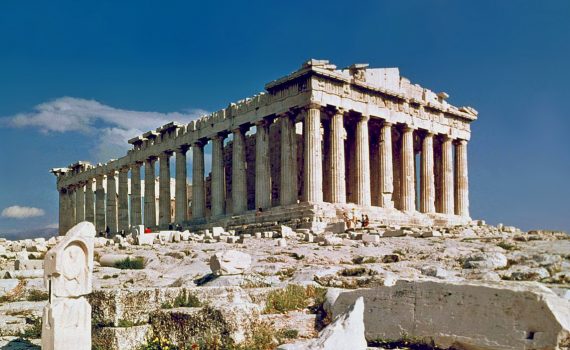
➼ Temple of Athena Nike
Details
- By Kallikrates
- From Temple of Athena Nike
- 427–424 B.C.E.
- Made up of marble
- Found in Athens, Greece
Form
- Amphiprostyle: having four columns in the front and four in the back.
- Ionic temple.
Function
- Built to commemorate the Greek victory over the Persians in the Battle of Marathon; Nike is the goddess of victory.
- Once contained a figure of Nike inside.
Context
- Many images of victory on the temple.
- Cf. Victory adjusting her sandal sculpted on a balustrade or railing that once framed the building.

➼ Great Altar of Zeus and Athena at Pergamon
Details
- From Asia Minor (present-day Turkey) Hellenistic Greece
- c. 175 B.C.E.
- Made of marble
- Found in Pergamon Museum, Berlin
Form
- Altar is on an elevated platform at the top of a dramatic flight of stairs.
- A frieze 7.5 feet high and more than 400 feet long wraps around the monument.
- Ionic columns frame the monument.
Function
- Altar dedicated to Zeus and Athena.
- Cf. Athena on the gigantomachy around the base of the altar.
Context
- Conscious effort to be in dialogue with the Panathenatic frieze on the Parthenon.
- Parallels made between the Pergamon victories over the barbarians in a recent war, Alexander the Great’s defeat of the Persians, and the gods’ defeat of the giants in mythology.

➼ Niobides Krater
Details
- Niobid Painter
- Classical Greek
- 460–450 B.C.E.
- Made of clay, red-figure technique with white highlights
- Found in Louvre, Paris
Form
- First time in vase painting that isocephalism (the tradition of depicting heads of figures on the same level) has been jettisoned.
- May have been the influence of wall paintings, although almost no Greek wall paintings survive.
- Written sources detail how numerous figures were placed at various levels in complex compositions.
Technique: Red figure ware
Function: Ceremonial krater; practical kraters were used for mixing water and wine or storing liquids.
Context
- Called the Niobides Krater because the killing of Niobe’s children is depicted on one side.
- Niobe, who had seven sons and seven daughters, bragged about her fertility to the god Leto, who had only two children.
- Leto’s two children, Apollo and Artemis, sought revenge by killing Niobid’s fourteen.
- Niobid is punished for her hubris.
- Niobe’s children are slaughtered.
- On the other side of the vase, the story is the subject of scholarly debate.
- It may depict Herakles in the center with heroes in arms and Athena on the left.
- Marathon's warriors may be praying to Herakles for protection in an upcoming battle.
History: Found in Orvieto, Italy; many Greek vases found in Etruscan tombs.
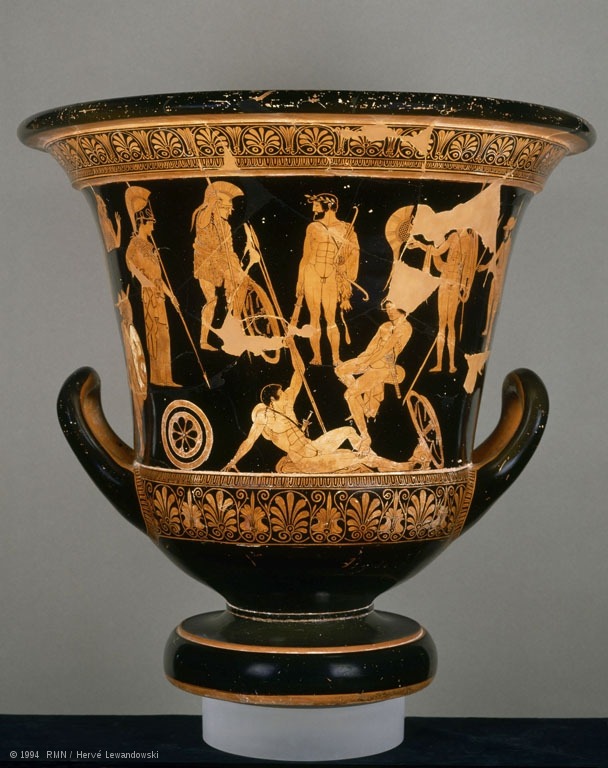
➼ Alexander Mosaic
Details
- From the House of Faun, Republican Roman copy of c. 100 B.C.E.
- A mosaic
- Found in National Archaeological Museum, Naples
- Mosaic: a decoration using pieces of stone, marble, or colored glass, called tesserae, that are cemented to a wall or a floor
Form
- Crowded with nervous excitement.
- Extremely complex interweaving of figures; spatial illusionism through foreshortening, chiaroscuro, reflection in shield.
Technique
- Use of tesserae instead of previously used pebbles.
- Tesserae allow for greater flexibility and more complex compositions and shadings.
Function: Roman floor mosaic, found in a house in Pompeii, based on an original Greek mural (?) painting.
Content
- Alexander, at left: does not wear a helmet, showing his bravery.
- Alexander pierces the body of an enemy with his spear without so much as a glance at his victim.
- Alexander’s widened eye is trained on Darius.
- Darius, in center right on chariot: horrified, weakly cedes the victory; his charioteer commands the horses to make their escape.
- Darius looks stunned as his brother, Oxyanthres, is stabbed, the brother portrayed here as sacrificing himself to save the king.
- The dying man’s right hand is still gripping his weapon, as though he wished to pull it out of his body, but his body is already collapsing onto the bloody corpse of his black horse.
Theories
- Perhaps a copy of a mural made by Piloxenos of Eretria for King Cassander.
- Perhaps made by Helen of Egypt, one of the few female Greek artists whose name has come down to us.
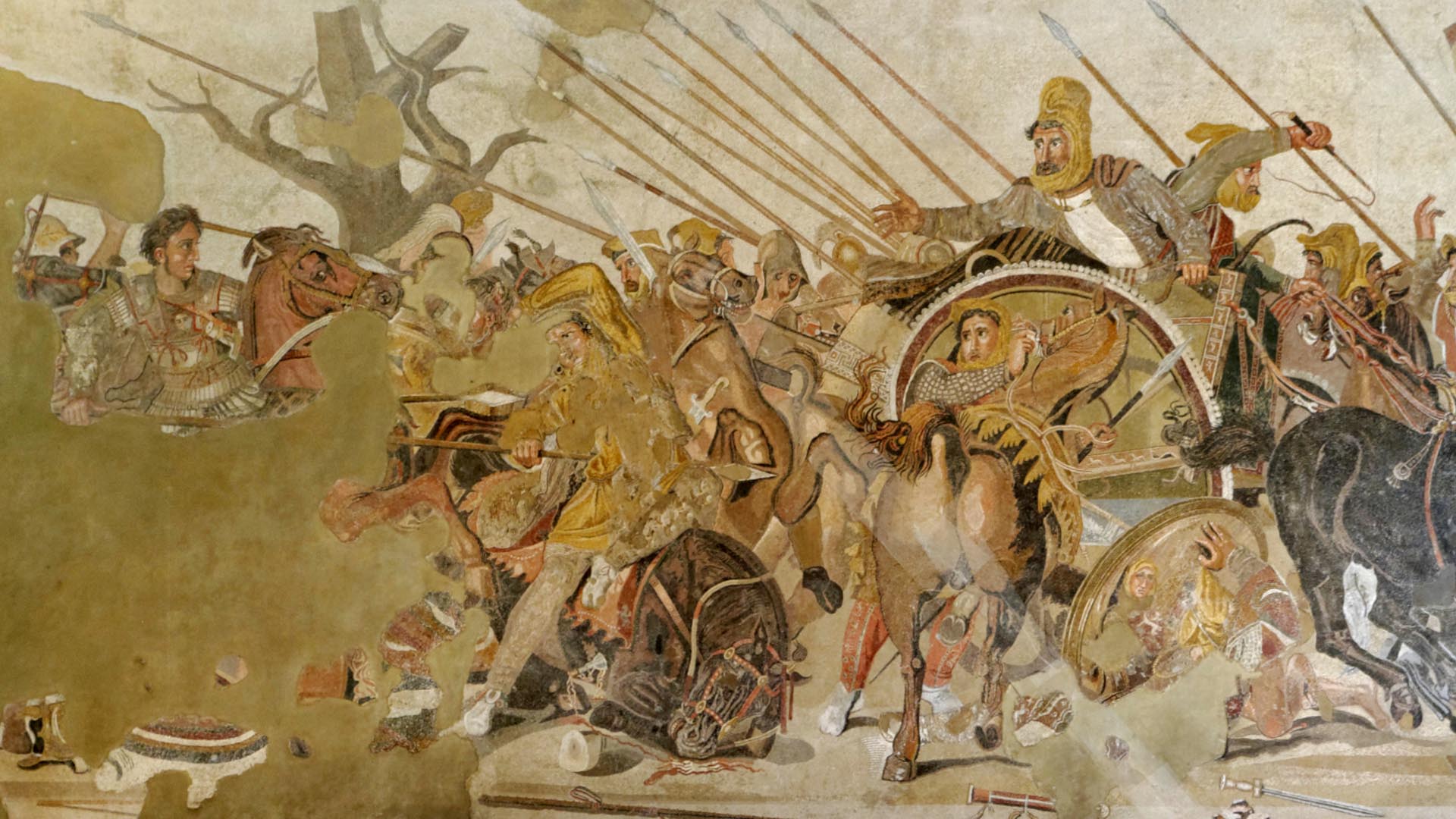
➼ Temple of Minerva
Details
- 510–500 B.C.E.
- Made of mud brick or tufa (volcanic rock) and wood,
- Found in Veii (near Rome), Italy
Form
- Little architecture survives; this model is drawn from descriptions by Vitruvius, a Roman architect of the first century B.C.E.
- Temple raised on a podium; defined visible entrance.
- Deep porch places doorways away from the steps.
Function: Temple dedicated to the goddess Minerva, the Etruscan equivalent to the Greek Athena.
Materials: Temple made of mud brick and wood, perishable materials.
Context
- Steps in front direct attention to the deep porch; entrances emphasized.
- Three doors represent three gods; the interior divided into three spaces.
- Etruscan variation of Greek capitals, called the Tuscan order.
- Tuscan order: an order of ancient architecture featuring slender, smooth columns that sit on simple bases; no carvings on the frieze or in the capitals
- Inspired by Greek architecture, but different:
- Columns are unfluted and made of wood, not marble as in Greece.
- Pediments are made of wood and contain no sculpture, as in Greece.
- Etruscan columns were spaced further apart than Greek columns because they were made of lighter material.
- Etruscans used sculptures made of terra cotta rather than stone on their roofs; columns are unfluted, made of wood, not marble as in Greece.
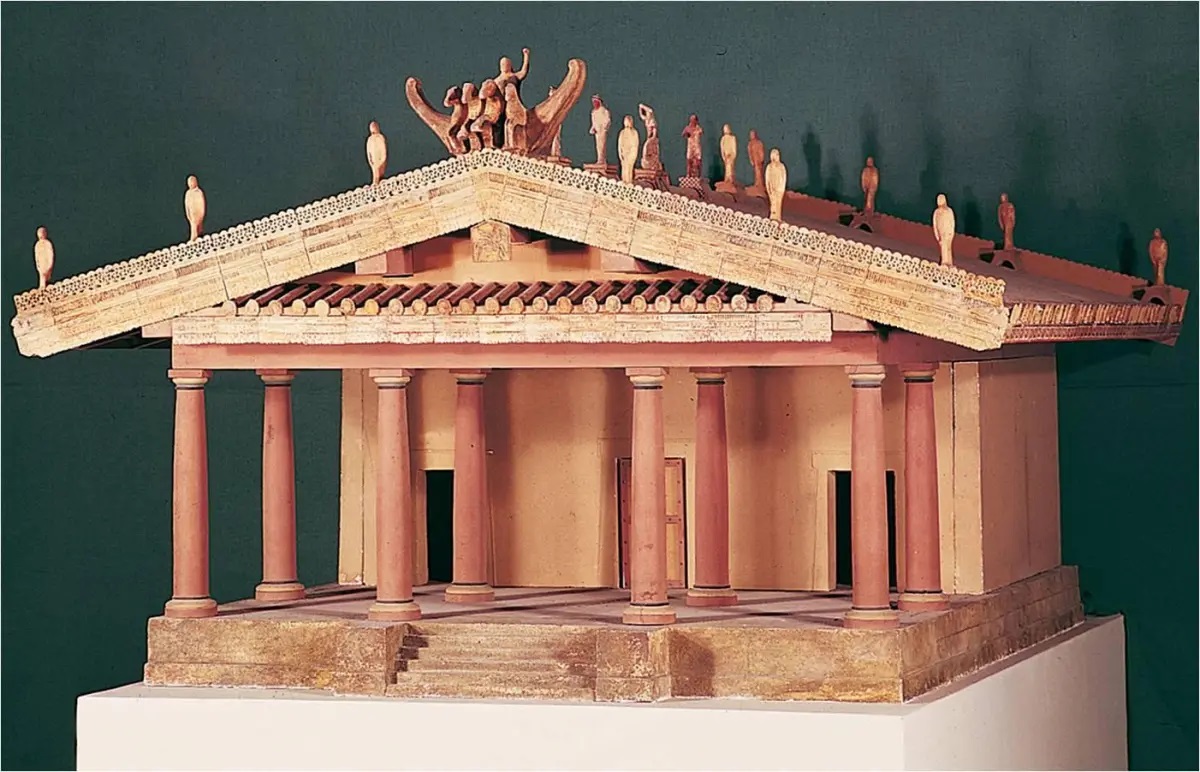
➼ Tomb of the Triclinium
Details
- c. 480–470 B.C.E.
- Made of tufa and fresco
- Found in Tarquinia, Italy
- Triclinium: a dining table in ancient Rome that has a couch on three sides for reclining at meals
Form
- Ancient convention of men painted in darker colors than women.
- Polychrome checkerboard pattern on ceiling; circles may symbolize time; pattern may reflect motifs on fabric tents erected for funeral banquets.
Function: Painted tomb in an Etruscan necropolis.
Content
- Funerals seen as moments in which to celebrate the life of the deceased.
- Dancing figures play musical instruments in a festive celebration of the dead.
- Trees spring up between the main figures, and shrubbery grows beneath the reclining couches—perhaps suggesting a rural setting.
Context
- Banqueting couples recline while eating in the ancient manner.
- Named after a triclinium, an ancient Roman dining table, which appears in the fresco.
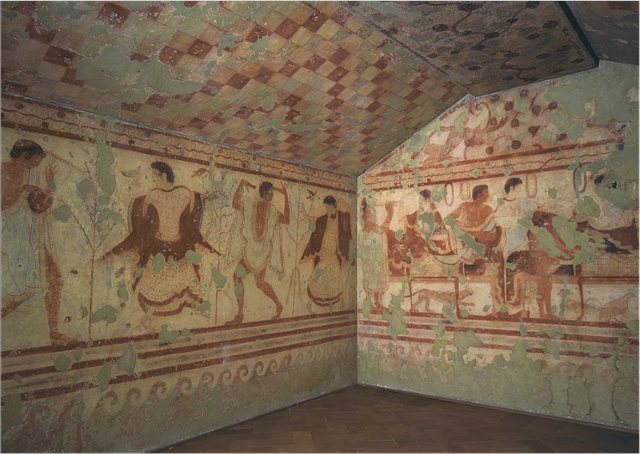
➼ Sarcophagus of the Spouses
Details
- c. 520 B.C.E.
- Made of terra cotta,
- Found in Museo Nazionale di Villa Giulia, Rome
Form
- Full-length portraits.
- Great concentration on the upper bodies, less on the legs.
- Bodies make an unnatural L-shape at the waist.
- Broad shoulders, knotted hair, and simple anatomical details.
Function: Sarcophagus of a married couple, whose ashes were placed inside, or perhaps a large urn used for the ashes of the dead.
Technique: Large terra cotta construction made in four separate pieces and joined together.
- Terra cotta: a hard ceramic clay used for building or for making pottery
Content
- Both once held objects in their hands—perhaps the man held an egg to symbolize life after death; other theories suggest the woman is holding a bottle of perfume or a pomegranate.
- The couple reclines against wineskins that act as cushions; the wineskins allude to the ceremony of sharing wine at funerary rituals.
Context
- Depicts the ancient tradition of reclining while eating; men and women ate together, unlike in ancient Greece.
- Symbiotic relationship, the man has a protective arm around the woman and the woman feeds the man, reflecting the high standing women had in Etruscan society.

➼ Apollo from Veii
Details
- Vulca — the master sculptor.
- c. 510 B.C.E.
- Made of terra cotta
- Found in Museo Nazionale di Villa Giulia, Rome
Form
- Figure has spirit, strides quickly forward.
- Archaic Greek smile.
- Meant to be seen from below.
- Tightly fitting garment.
- Hair in knots, dangles down around shoulders.
- Originally brightly painted.
Materials: Masterpiece of terra cotta casting.
Context
- Unlike Greek sculpture, which appears in pediments and is made of stone, Etruscans prefer terra cotta figures that are mounted on roof lines.
- One of four large figures that once stood on the roof of the temple at Veii.
- Part of a scene from Greek mythology involving the third labor of Hercules; Apollo looks directly at Hercules, an important figure in Etruscan religion.
- May have been carved by Vulcan of Veii, the most famous Etruscan sculptor of the age.
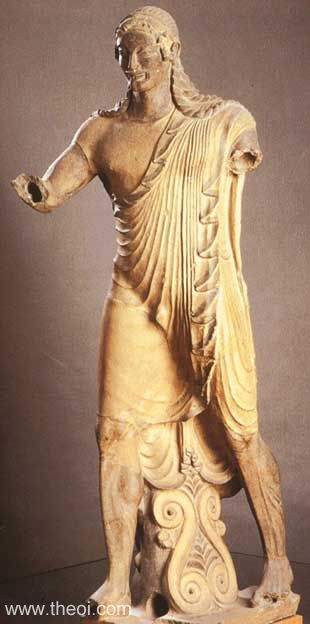
➼ House of Vettii
Details
- From Imperial Roman,
- 2nd century B.C.E.–1st century C.E.
- Rebuilt c. 67–79 C.E.
- Made of cut stone and fresco
- Found in Pompeii, Italy
Form
- Narrow entrance to the home sandwiched between several shops.
- Large reception area called the atrium, which is open to the sky and has a catch basin called an impluvium in the center; rooms called cubicula radiate around the atrium.
- Peristyle garden in rear with fountain, statuary, and more cubicula; this is the private area of the house.
- Axial symmetry of house; someone entering the house can see through to the peristyle garden in the rear.
- Exterior of house lacks windows; interior lighting comes from the atrium and the peristyle.
Function
- Private citizen’s home in Pompeii
- Originally built during the Republic with early imperial additions.
Context
- Two brothers owned the house; both were freedmen who made their money as merchants.
- Extravagant home symbolized the owners’ wealth.
- After the earthquake of 62 A.D., many wealthy Romans left Pompeii, leading to the rise of the “nouveau riche.”
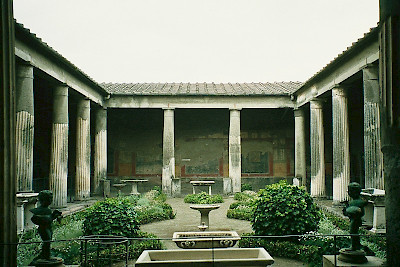
➼ The Colosseum (Flavian Amphitheater)
Details
- Imperial Roman
- 72–80 C.E.
- Made of stone and concrete
- Found in Rome
Function
- Stadium meant for wild and dangerous spectacles—gladiator combat, animal hunts, naval battles—but not, as tradition suggests, religious persecution.
Form
- Accommodated 50,000 spectators.
- Concrete core, brick casing, travertine facing.
- 76 entrances and exits circle the façade.
- Interplay of barrel vaults, groin vaults, arches.
- Façade has engaged columns
- first story is Tuscan,
- second story is Ionic,
- third story is Corinthian, and
- the top story is flattened Corinthian; each thought of as lighter than the order below.
- Flagstaffs: These staffs are the anchors for a retractable canvas roof, called a velarium.
- Velarium: A retractable canvas roof used to protect the crowd on hot days.
- Sand was placed on the floor to absorb the blood; occasionally the sand was dyed red.
- Hypogeum: The subterranean part of an ancient building.
Context
- Real name is the Flavian Amphitheater; the name Colosseum comes from a colossal statue of Nero that used to be adjacent.
- The building illustrates what popular entertainment was like for ancient Romans.
- Entrances and staircases were separated by marble and iron railings to keep the social classes separate; women and the lower classes sat at the top level.
- Much of the marble was pulled off in the Middle Ages and repurposed.
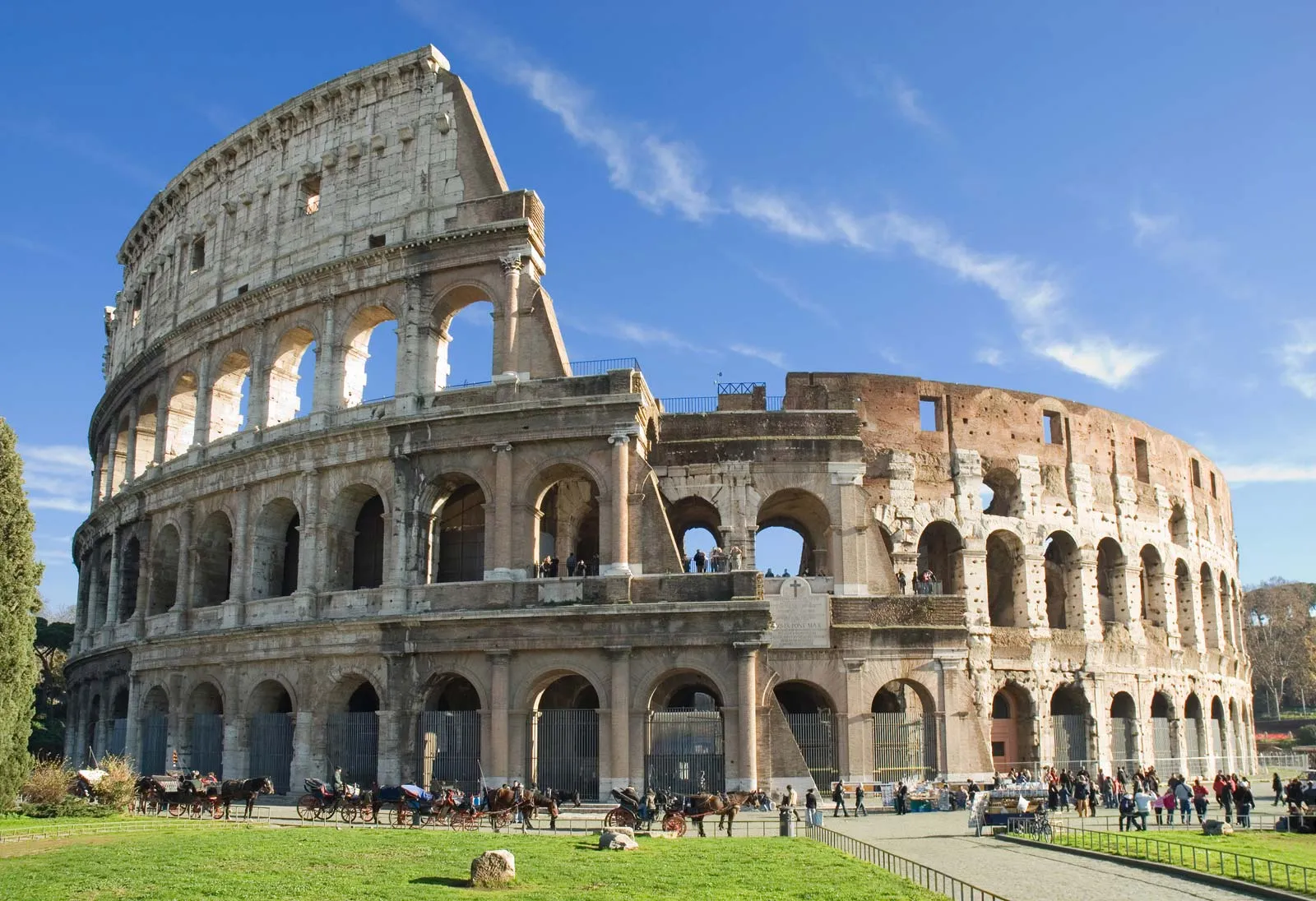
➼ Treasury and Great Temple of Petra, Jordan
Details
- Nabataean Ptolemaic and Roman
- c. 400 B.C.E.–100 C.E.
- Made of cut rock
- Found in Jordan
Context
- Petra was a central city of the Nabataeans, a nomadic people, until Roman occupation in 106 C.E.
- The city was built along a caravan route.
- They buried their dead in the tombs cut out of the sandstone cliffs.
- Five hundred royal tombs in the rock, but no human remains found; burial practices are unknown; tombs are small.
- The city is half built, half carved out of rock. –The city is protected by a narrow canyon entrance.
- The Roman emperor Hadrian visited the site and named it after himself: Hadriane Petra.
Content
- Approached through a monumental gateway, called a propylaeum, and a grand staircase that leads to a colonnade terrace in the lower precincts.
- A second staircase leads to the upper precincts.
- A third staircase leads to the main temple.
Form
- Nabataean concept and Roman features such as Corinthian columns.
- Monuments carved in traditional Nabataean rock-cut cliff walls.
- Lower story influenced by Greek and Roman temples but with unusual features:
- Columns not proportionally spaced.
- Pediment does not cover all columns, only the central four.
- Upper floor: broken pediment with a central tholos.
- Combination of Roman and indigenous traditions.
- Greek, Egyptian, and Assyrian gods on the façade.
- Interior: one central chamber with two flanking smaller rooms.
Function: In reality, it was a tomb, not a “treasury,” as the name implies.
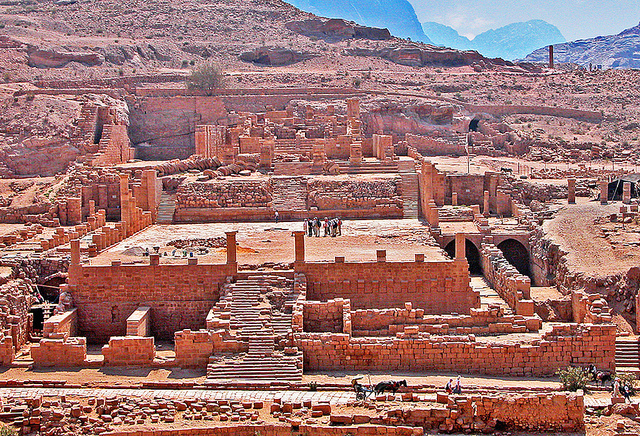
➼ Forum of Trajan
Details
- By Apollodorus of Damascus
- 106–112 C.E.
- Made of brick and concrete
- Found in Rome, Italy
Form
- Large central plaza flanked by stoa-like buildings on each side.
- Originally held an equestrian monument dedicated to Trajan in the center.
Function: Part of a complex that included the Basilica of Ulpia, Trajan’s markets, and the Column of Trajan.
Context: Built with booty collected from Trajan’s victory over the Dacians.
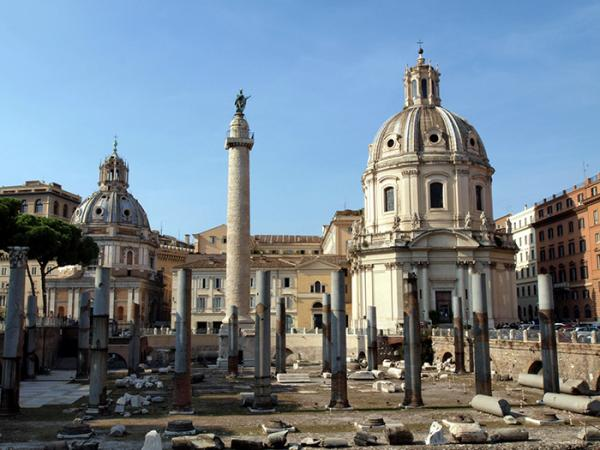
➼ Basilica of Ulpia
Details
- c. 112 C.E.
- Made of brick and concrete
- Found in Rome, Italy
- Basilica: in Roman architecture, a large axially planned building with a nave, side aisles, and apses
Form
- Grand interior space (385 feet by 182 feet) with two apses.
- Nave is spacious and wide.
- Double colonnaded side aisles.
- Second floor had galleries or perhaps clerestory windows.
- Timber roof 80 feet across.
- Basilican structure can be traced back to Greek stoas.
Functional: Law courts held here; apses were a setting for judges.
Context
- Said to have been paid for by Trajan’s spoils taken from the defeat of the Dacians.
- Ulpius was Trajan’s family name.
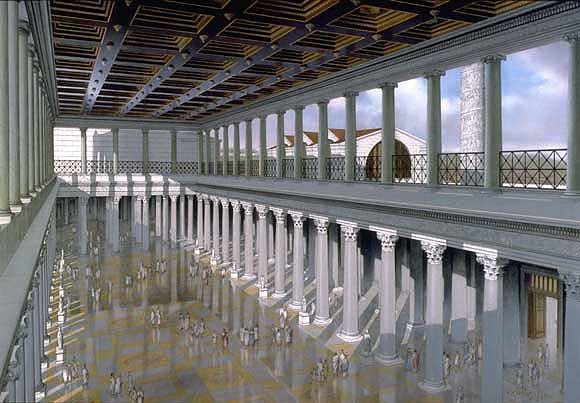
➼ Trajan Markets
Details
- 106–112 C.E.
- Made of brick and concrete
- Found in Rome, Italy
Form
- Semicircular building held several levels of shops.
- Main space is groin vaulted; barrel vaulted area with the shops.
Function
- Multilevel mall.
- Original market had 150 shops.
Materials: Use of exposed brick indicates a more accepted view of this material, which formerly was thought of as being unsuited to grand public buildings.
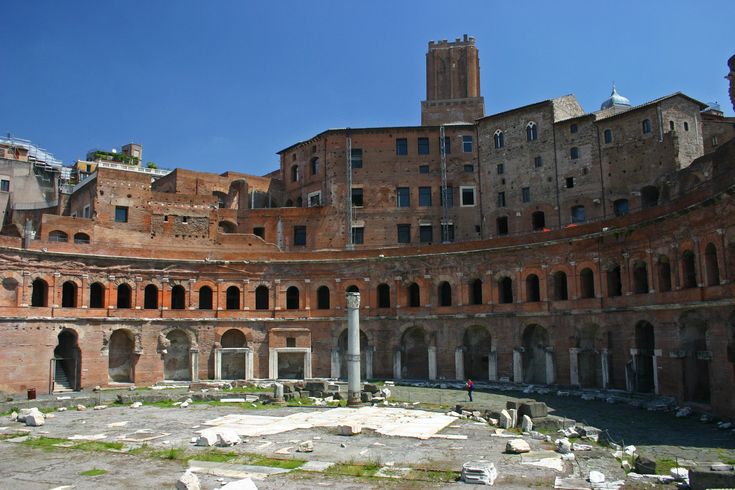
➼ Pantheon
Details
- Imperial Roman
- 118–125 C.E.
- Made of concrete with stone facing
- Found Rome, Italy
Form Exterior
- Corinthian-capital porch in front of this building.
- Façade has two pediments, one deeply recessed behind the other; it is difficult to see the second pediment from the street.
Form Interior
- Interior contains a slightly convex floor for water drainage.
- Square panels on floor and in coffers contrast with roundness of walls; circles and squares are a unifying theme.
- Coffers may have been filled with rosette designs to simulate stars.
- Cupola walls are enormously thick: 20 feet at base.
- Thickness of walls is thinned at the top; coffers take some weight pressure off the walls.
- Oculus, 27 feet across, allows for air and sunlight; sun moves across the interior much like a spotlight
- Height of the building equals its width; the building is based on the circle; a hemisphere.
- Walls have seven niches for statues of the gods.
- Triumph of concrete construction.
- Was originally brilliantly decorated.
Function
- Traditional interpretation: it was built as a Roman temple dedicated to all the gods.
- Recent interpretation: it may have been dedicated to a select group of gods and the divine Julius Caesar and/or used for court rituals.
- It is now a Catholic church called Santa Maria Rotonda.
Context
- Inscription on the façade: “Marcus Agrippa, son of Lucius, having been consul three times, built it.”
- The name Pantheon is from the Greek meaning “all the gods” or “common to all the gods.”
- Originally had a large atrium before it; originally built on a high podium; modern Rome has risen up to that level.
- Interior symbolized the vault of the heavens.
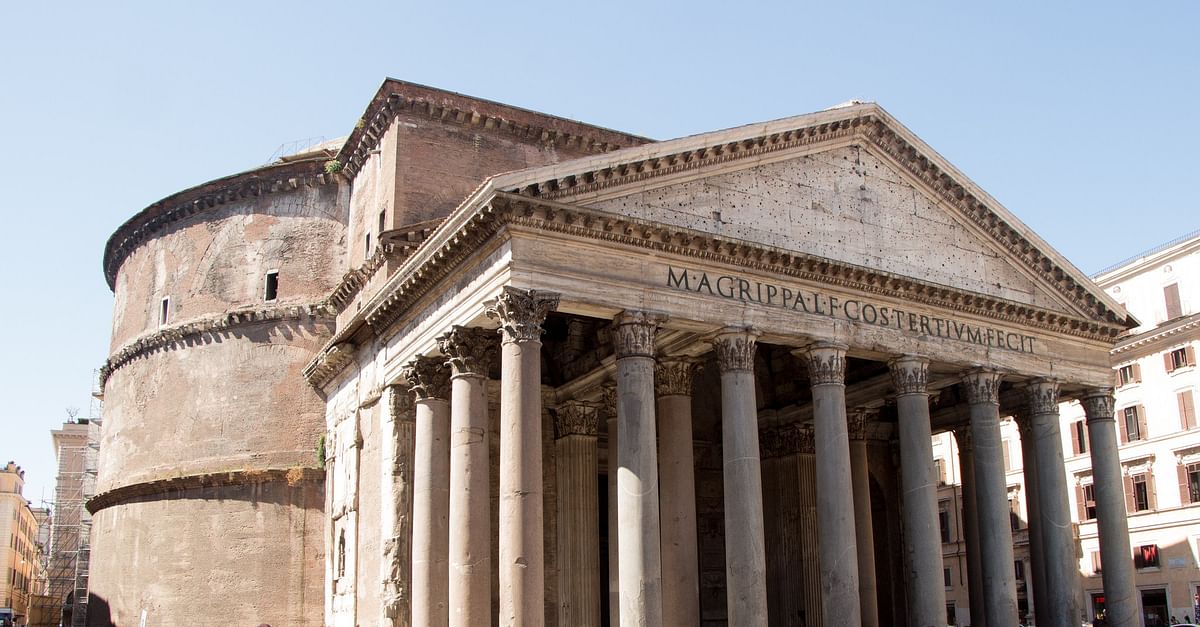
➼ Pentheus Room
Details
- Imperial Roman
- 62–79 C.E.
- fresco
- Foun in Pompeii, Italy
Function
- Triclinium: a dining room in a Roman house.
Context
- Main scene is the death of the Greek hero Pentheus.
- Pentheus opposed the cult of Bacchus and was torn to pieces by women, including his mother, in a Bacchic frenzy; two women are pulling at his hair in this image.
- Punishment of Pentheus is eroticized; central figure with arms outstretched; exposed nakedness of his body.
- Architecture is seen through painted windows; imaginary landscape.
- This painting opens the room with the illusion of windows and a sunny cityscape beyond.
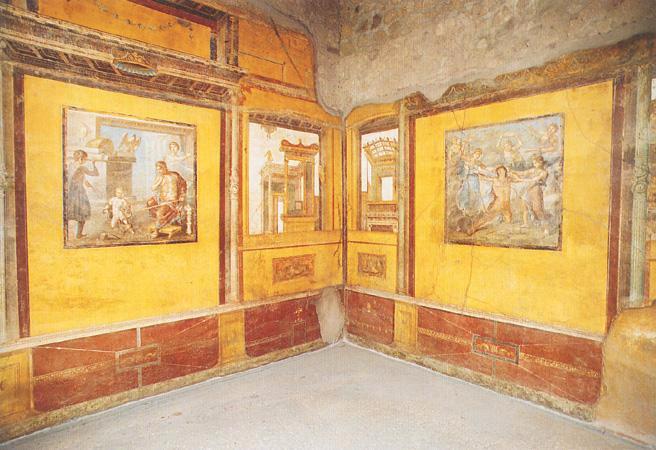
➼ Head of a Roman patrician
Details
- Republican Roman
- c. 75–50 B.C.E.
- Made of marble
- Found in Museo Torlonia, Rome
Function
- Funerary context; funerary altars adorned with portraits, busts, or reliefs and cinerary urns.
- Tradition of wax portrait masks in funeral processions of the upper class to commemorate their history.
- Portraits housed in family shrines honoring deceased relatives.
Context
- Realism of the portrayal shows the influence of Greek Hellenistic art and late Etruscan art.
- Bulldog-like tenacity of features; overhanging flesh; deep crevices in face.
- Full of experience and wisdom—traits Roman patricians would have desired.
- Features may have been exaggerated by the artist to enhance adherence to Roman Republican virtues such as stoicism, determination, and foresight.
- Busts are mostly of men, often depicted as elderly.
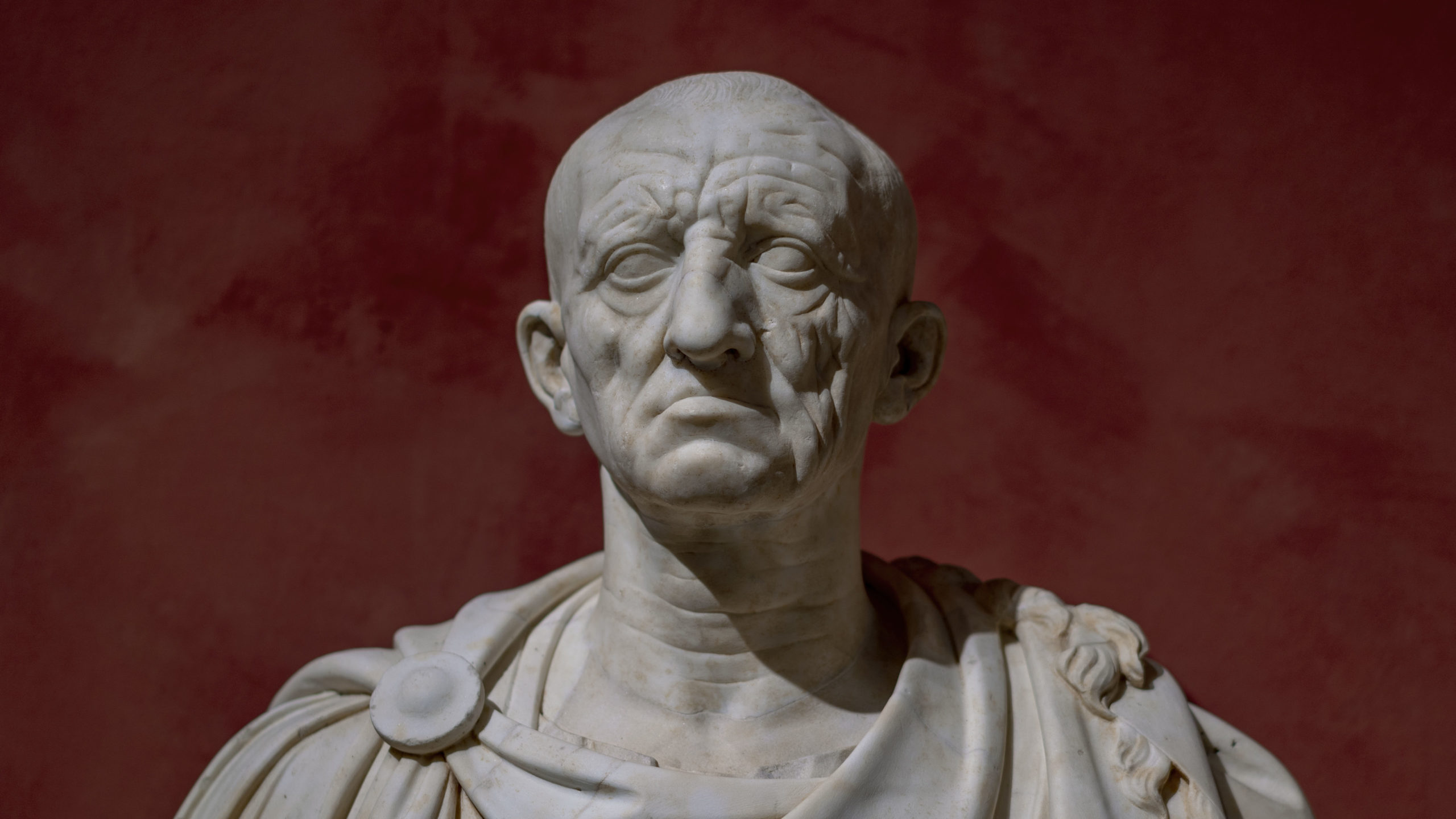
➼ Augustus of Prima Porta
Details
- Imperial Roman
- Early 1st century C.E.
- Made of marble
- Found in Vatican Museums, Rome
Form
- Contrapposto.
- References Polykleitos’s Doryphoros.
- Characteristic of works depicting Augustus is the part in the hair over the left eye and two locks over the right.
- Heroic, grand, authoritative ruler; over life-size scale.
- Back not carved; figure meant to be placed against a wall.
- Oratorical pose.
Function and Original Context
- Found in the villa of Livia, Augustus’s wife; may have been sculpted to honor him in his lifetime or after his death (Augustus is barefoot like a god, not wearing military boots).
- May have been commissioned by Emperor Tiberius, Livia’s son, whose diplomacy helped secure the return of the eagles; thus it would serve as a commemoration of Augustus and the reign of Tiberius.
Content
- Idealized view of the Roman emperor, not an individualized portrait.
- Confusion between God and man is intentional; in contrast with Roman Republican portraits.
- Standing barefoot indicates he is on sacred ground.
- On his breastplate are a number of gods participating in the return of Roman standards from the Parthians; Pax Romana.
- Breastplate indicates he is a warrior; judges’ robes show him as a civic ruler.
- He may have carried a sword, pointing down, in his left hand.
- His right hand is in a Roman orator pose; perhaps it held laurel branches.
- At base: Cupid on the back of a dolphin—a reference to Augustus’s divine descent from Venus; perhaps also a symbol of Augustus’s naval victory over Mark Antony and Cleopatra.
- Maybe a copy of a bronze original, which probably did not have the image of Cupid.
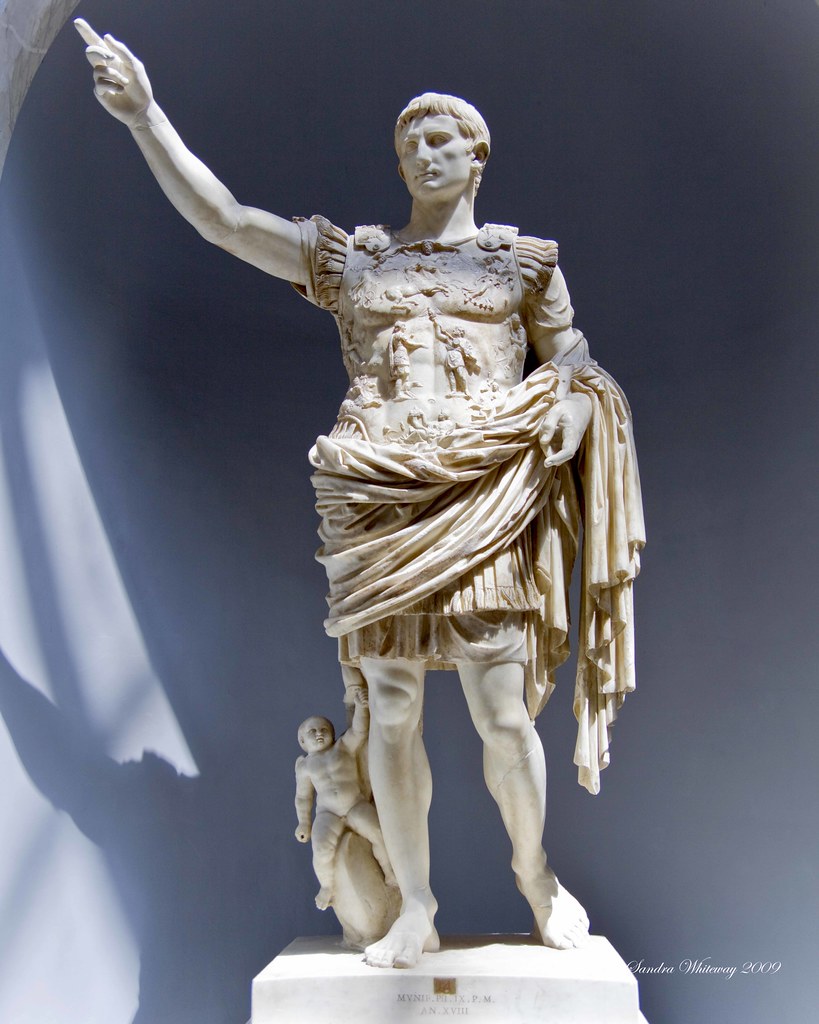
➼ Column of Trajan
Details
- 113 C.E.
- Made of marble
- Found in Rome
Form
- A 625-foot narrative cycle (128 feet high) wrapped around the column tells the story of Trajan’s defeat of the Dacians; this is the earliest example of this kind of structure.
- Crowded composition.
- Base of the column has an oak wreath, the symbol of victory.
- Low relief; few shadows to cloud what must have been a very difficult object to view in its entirety.
Function
- Visitors who entered the column were meant to wander up the interior spiral staircase to the viewing platform at the top where a heroic nude statue of the emperor was placed.
- Base contains the burial chamber of Trajan and his wife, Plotina, whose ashes were placed in golden urns in the pedestal.
Technique: Roman invention of a tall hollowed out column with an interior spiral staircase.
Content
- 150 episodes, 2,662 figures, 23 registers—continuous narrative.
- Continuous narrative: a work of art that contains several scenes of the same story painted or sculpted in continuous succession
- Scenes on the column depict the preparation for battle, key moments in the Dacian campaign, and many scenes of everyday life
- Trajan appears 58 times in various roles: commander, statesman, ruler, etc.
Context
- Stood in Trajan’s Forum at the far end surrounded by buildings.
- Scholarly debate over the way it was meant to be viewed.
- A viewer would be impressed with Trajan’s accomplishments, including his forum and his markets.
- Two Roman libraries containing Greek and Roman manuscripts flanked the column.
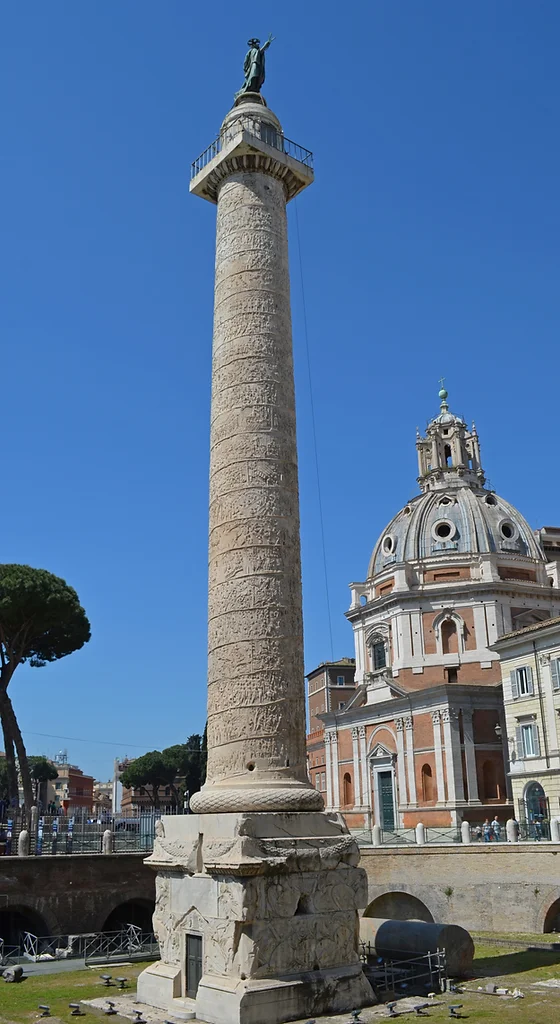
➼ Ludovisi Battle Sarcophagus
Details
- Late Imperial Roman
- c. 250 C.E.
- Made of marble
- Found in National Roman Museum, Rome
Form
- Extremely crowded surface with figures piled atop one another; horror vacui.
- Abandonment of classical tradition in favor of a more animated and crowded space.
- Horror vacui: (Latin for a “fear of empty spaces”) a type of artwork in which the entire surface is filled with objects, people, designs, and ornaments in a crowded, sometimes congested way
- Figures lack individuality.
Function: Interment of the dead; rich carving suggests a wealthy patron with a military background.
Technique
- Very deep relief with layers of figures.
- Complexity of composition with deeply carved undercutting.
Content
- Roman army trounces bearded and defeated barbarians.
- Romans appear noble and heroic while the Goths are ugly.
- Romans battling “barbaric” Goths in the Late Imperial period.
- Youthful Roman general appears center top with no weapons, the only Roman with no helmet, indicating that he is invincible and needs no protection; he controls a wild horse with a simple gesture.
Context
- Confusion of battle is suggested by congested composition.
- Rome at war throughout the third century.
- So called because in the seventeenth century it was in Cardinal Ludovisi’s collection in Rome.
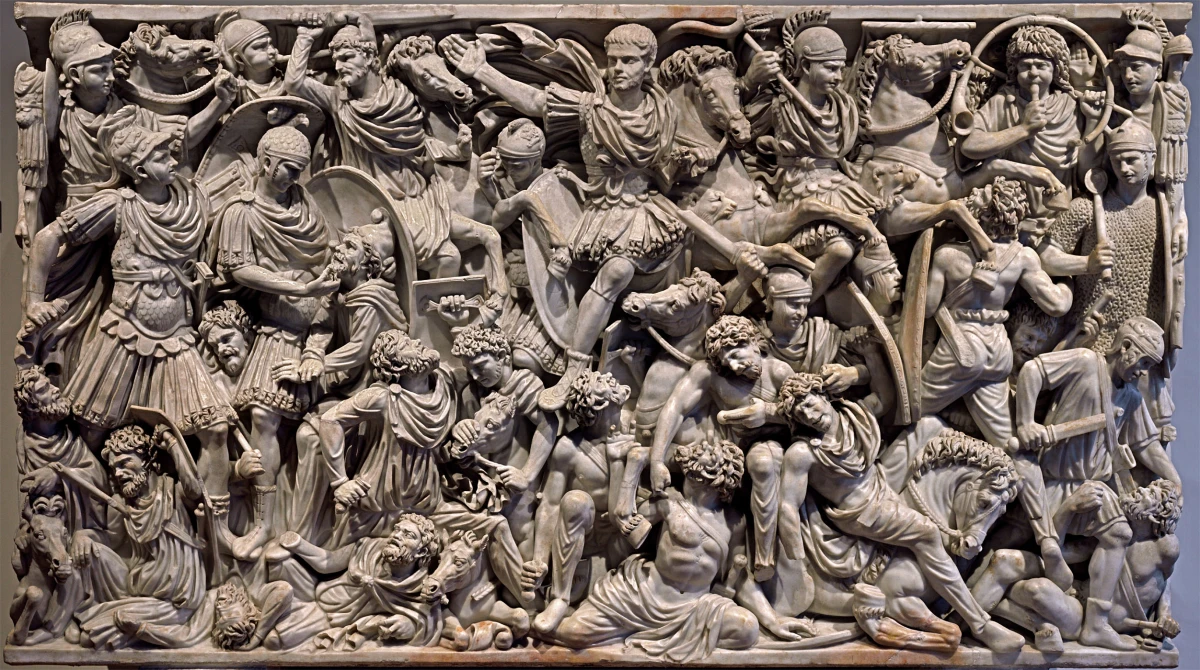
Unit 3: Early Europe and Colonial Americas, 200–1750 CE
Key Events of Early Europe and the Americas Art
Edict of Milan and the "Peace of the Church"
- Edict of Milan:
- Issued in 313 AD by Roman Emperor Constantine
- Granted religious tolerance to Christians in the Roman Empire
- Ended the persecution of Christians and allowed them to practice their faith freely
- "Peace of the Church":
- Established in 380 AD by Roman Emperor Theodosius
- Made Christianity the official religion of the Roman Empire
- Prohibited the practice of pagan religions and heresies
- Strengthened the power of the Christian Church in the Empire
Formation of the Byzantine Empire
- The Byzantine Empire was formed in 324 AD by Emperor Constantine I.
- It was originally known as the Eastern Roman Empire.
- The capital was Constantinople, which was strategically located for trade and defense.
- The Byzantine Empire was a continuation of the Roman Empire, but with Greek as the official language and Christianity as the dominant religion.
- The Byzantine Empire lasted for over 1000 years, until it fell to the Ottoman Turks in 1453.
Iconoclastic Controversy
- A dispute over the use of religious images (icons) in the Byzantine Empire
- Began in 726 AD under Emperor Leo III
- Iconoclasts believed that the use of icons was idolatry and violated the Ten Commandments
- Iconodules believed that icons were necessary for religious worship and veneration
- The controversy led to the destruction of many religious images and the persecution of iconodules
- The controversy was resolved in 843 AD with the restoration of the use of icons in the Byzantine Empire
Spread of Islam into al-Andalus
- Muslims conquered al-Andalus in 711 AD
- Tariq ibn Ziyad led the Muslim army
- Abd al-Rahman I established the Umayyad Emirate of Cordoba in 756 AD
- Cordoba became a center of Islamic learning and culture
- The Alhambra palace was built in Granada in the 14th century
- The Reconquista ended Muslim rule in al-Andalus in 1492 AD
Hundred Years' War
- The Hundred Years' War was a series of conflicts between England and France from 1337 to 1453.
- It was fought over territorial disputes and the English claim to the French throne.
- The war saw major battles such as Crecy, Poitiers, and Agincourt. It ended with the French victory and the expulsion of the English from France, except for the port of Calais.
Black Death of 1348
- The Black Death was a deadly pandemic in the mid-14th century
- It originated in China or Central Asia and spread to Europe through trade routes
- It was caused by the bacterium Yersinia pestis
- It was transmitted to humans through fleas that infested rats
- Symptoms included fever, chills, vomiting, and painful buboes
- The mortality rate was extremely high, with estimates suggesting up to 50% of the European population died
- The Black Death caused economic, social, and political upheaval
- It led to increased wages for workers and a decline in feudal lord power
- It also led to a rise in anti-Semitism
- The pandemic inspired works of art and literature reflecting its trauma and suffering.
Italian and Northern Renaissance
- The Italian Renaissance was a cultural and artistic movement that began in Italy in the 14th century and lasted until the 17th century. It was characterized by a renewed interest in classical antiquity, humanism, and the arts.
- The Northern Renaissance, which took place in Northern Europe, was influenced by the Italian Renaissance but had its own distinct characteristics, such as a focus on religious themes and a greater emphasis on realism in art.
Protestant Reformation
- The Protestant Reformation was a religious movement in the 16th century that aimed to reform the Catholic Church.
- It was led by figures such as Martin Luther, John Calvin, and Huldrych Zwingli, who challenged the authority of the Pope and emphasized the importance of individual faith and the Bible.
- The movement resulted in the establishment of Protestant denominations such as Lutheranism, Calvinism, and Anglicanism, and had a significant impact on European history and culture.
Spanish Conquest of the Americas
- The Spanish Conquest of the Americas refers to the period of European colonization and exploration of the Americas by the Spanish Empire.
- It began in the late 15th century with the arrival of Christopher Columbus in the Caribbean and continued throughout the 16th and 17th centuries.
- The Spanish established colonies in present-day Mexico, Central America, South America, and the Caribbean, and brought about significant changes to the indigenous cultures and societies of the region.
- The conquest had a profound impact on the history and development of the Americas.
Artistic Movements of Early Europe and the Americas Art
Late Antique Art
- Materials/Techniques/Processes
- Mosaic: small pieces of colored glass, stone, or ceramic set in mortar
- Ivory: carved from elephant tusks
- Metalwork: gold, silver, bronze, and copper
- Manuscripts: parchment or vellum, ink, and pigments
- Purpose
- Religious devotion: many works were created for use in churches and other religious settings
- Imperial propaganda: some works were commissioned by rulers to promote their power and authority
- Personal piety: some works were created by individuals for their own spiritual benefit
- Audiences
- Churchgoers: many works were intended for use in religious services and would have been seen by congregations
- Rulers and elites: some works were commissioned by rulers and other wealthy patrons
- Private individuals: some works were created by individuals for their own use or enjoyment.
Byzantine Art
- Materials/Techniques/Processes:
- Mosaic: tesserae arranged to create an image
- Fresco: pigments applied to wet plaster, which dries to create a durable surface
- Encaustic: pigments mixed with hot wax, which is then applied to a surface and fused with heat
- Icon: painted with egg tempera, a mixture of egg yolk and pigments
- Audiences:
- Religious communities: Byzantine art was primarily created for use in churches and other religious spaces
- Wealthy patrons: some wealthy individuals commissioned Byzantine art for their private chapels or homes
- Purpose:
- Religious devotion: Was intended to inspire religious devotion and aid in worship
- Political propaganda: Some Byzantine art was created to promote the power and authority of the emperor or other rulers
- Education: some Byzantine art was used to teach religious stories and concepts to illiterate audiences.
Islamic Art
- Materials:
- Calligraphy: Writing in Arabic script using ink and paper
- Ceramics: Pottery decorated with intricate designs and patterns
- Textiles: Woven fabrics with geometric or floral motifs
- Metalwork: Decorative objects made of gold, silver, or bronze
- Carpets: Hand-woven rugs with intricate designs
- Techniques/Processes:
- Geometric patterns: Using mathematical principles to create intricate designs
- Arabesque: Interlacing floral and plant motifs to create a continuous pattern
- Illumination: Decorating manuscripts with gold leaf and bright colors
- Mosaic: Creating images by arranging small pieces of colored glass or stone
- Miniature painting: Creating detailed paintings on small surfaces
- Audiences:
- Religious leaders: Islamic art was often commissioned by religious leaders to decorate mosques and other religious buildings
- Wealthy patrons: Wealthy individuals would commission artists to create decorative objects for their homes
- Common people: Islamic art was also created for everyday use, such as textiles and ceramics
- Purpose:
- Religious devotion: Islamic art often served a religious purpose, such as decorating mosques and illustrating religious texts
- Cultural expression: Islamic art was a way for artists to express their cultural identity and showcase their skills
- Status symbol: Wealthy patrons would commission elaborate works of art to display their wealth and status.
Early Medieval Art
- Materials:
- Parchment or vellum for manuscripts
- Stone and metal for sculpture
- Wood for architectural elements and small-scale sculpture
- Pigments and gold leaf for illuminated manuscripts
- Techniques/Processes:
- Manuscript illumination
- Cloisonné and champlevé enamelwork
- Stone carving and metalworking
- Animal style and interlace decoration
- Fresco and tempera painting
- Purpose:
- Religious devotion and instruction
- Commemoration of rulers and important figures
- Decoration of churches and other religious buildings
- Display of wealth and power
- Audiences:
- Members of the clergy and religious orders
- Wealthy patrons and rulers
- Illiterate or semi-literate laypeople who could understand visual images better than written texts
Romanesque Art
- Materials:
- Stone: Used for sculptural works such as portals, capitals, and reliefs.
- Wood: Used for sculptures, altarpieces, and choir stalls.
- Bronze: Used for casting sculptures and decorative elements.
- Ivory: Used for carving small sculptures and decorative objects.
- Manuscripts: Used for illuminated manuscripts, which were highly valued for their intricate illustrations and calligraphy.
- Stained glass: Used for windows, which were often used to tell religious stories and convey moral messages.
- Frescoes: Used for painting murals on walls and ceilings.
- Tapestries: Used for weaving large-scale decorative textiles.
- Techniques/Processes:
- Sculpture: Carving, casting, and modeling in stone, wood, bronze, and ivory.
- Painting: Using pigments to create images on various surfaces such as wood, canvas, and walls.
- Metalworking: Casting and forging metal objects such as chandeliers, candlesticks, and reliquaries.
- Manuscript illumination: Decorating manuscripts with intricate illustrations and calligraphy.
- Mosaic: Creating images by arranging small pieces of colored glass or stone.
- Stained glass: Creating images by arranging colored glass pieces in lead frames.
- Fresco painting: Painting on wet plaster to create a durable and long-lasting image.
- Tapestry weaving: Weaving large-scale decorative textiles with intricate designs.
- Audiences:
- Churchgoers: Romanesque art was primarily created for use in churches and cathedrals, and was intended to inspire devotion and awe in those who attended religious services.
- Pilgrims: Many Romanesque churches were pilgrimage sites, and the art within them was intended to inspire and guide pilgrims on their spiritual journeys.
- Monks and nuns: Many monasteries and convents commissioned Romanesque art for use in their chapels and other religious spaces.
- Royalty and nobility: Wealthy patrons, including kings and queens, commissioned Romanesque art for their private chapels and as gifts to churches and monasteries.
- Wealthy merchants: Some wealthy merchants also commissioned Romanesque art for their private chapels and homes.
- Purpose:
- To glorify God and the Church: Romanesque art was created to honor and celebrate the Christian faith and the power of the Church.
- To educate the illiterate masses about religious stories and beliefs: Many people in the Middle Ages were illiterate, so art was used as a way to convey
Gothic Art
- Techniques/Processes
- Ribbed vaults: A vault with a framework of ribs or arches under the intersections of the vaulted sections.
- Flying buttresses: An arched stone support that extends from the upper portion of a wall to a pier of great mass.
- Pointed arches: An arch with a pointed crown, characteristic of Gothic architecture.
- S-curve (ogee) shape: A double curve, shaped like an S, used in architecture and decoration.
- Elaborate tracery: Decorative stone openwork, typically in the upper part of a Gothic window.
- Gargoyles and grotesques: A carved or sculpted figure, typically with a spout designed to convey water from a roof and away from the side of a building.
- Illuminated manuscripts: A manuscript in which the text is supplemented with such decoration as initials, borders, and miniature illustrations.
- Polychrome sculpture: A sculpture decorated in several colors.
- Audiences
- The Church
- Wealthy patrons
- The general public
- Purpose
- To glorify God and the Church
- To inspire awe and devotion in the viewer
- To showcase the wealth and power of the Church and its patrons
- To educate the illiterate masses about religious stories and figures.
Renaissance Art
- Materials:
- Oil paint: A type of paint made by mixing pigments with oil, usually linseed oil. It is known for its slow drying time and ability to create rich, layered colors.
- Canvas: A type of fabric used as a surface for painting. It is typically made from cotton or linen and stretched over a wooden frame.
- Wood panels: A flat surface made of wood that was commonly used for painting before the introduction of canvas. It was often prepared with a layer of gesso before painting.
- Fresco: A painting technique in which pigments are applied to wet plaster. This allows the colors to become embedded in the wall and creates a durable, long-lasting artwork.
- Techniques/Processes:
- Linear perspective: A technique used in art to create the illusion of depth and space on a flat surface by using converging lines that meet at a vanishing point.
- Chiaroscuro: An Italian term that refers to the use of strong contrasts between light and dark in art to create a sense of volume and three-dimensionality.
- Sfumato: An Italian term that refers to a painting technique used to create a soft, hazy effect by blending colors or tones together to create a gradual transition from light to dark.
- Foreshortening: A technique used in art to create the illusion of depth and perspective by shortening the length of an object as it recedes into the distance.
- Glazing: A painting technique that involves applying thin, transparent layers of paint over a previously painted surface to create depth, luminosity, and color harmony.
- Audiences:
- Wealthy patrons
- The Church
- The general public
- Purpose:
- To glorify God and the Church
- To celebrate humanism and individualism
- To showcase technical skill and artistic innovation
- To commemorate historical events and figures
Baroque Art
- Materials:
- Oil paint
- Canvas
- Marble
- Gilt bronze
- Ivory
- Tortoiseshell
- Mother-of-pearl
- Precious stones
- Techniques/Processes:
- Chiaroscuro (use of light and shadow)
- Tenebrism (dramatic use of light and dark)
- Illusionistic ceiling painting (fresco)
- Trompe l'oeil (trick of the eye)
- Contrapposto (pose of figures)
- Ornate decoration and embellishment
- Audience:
- Wealthy patrons
- The Catholic Church
- Royalty and nobility
- Aristocracy
- Purpose:
- To glorify the Catholic Church and its teachings
- To demonstrate the power and wealth of patrons
- To evoke emotion and awe in viewers
Early Europe and Colonial America Artworks
➼ Catacomb of Priscilla
Details
- Late Antique Europe
- 200–400
- Excavated tufa and fresco
- Found in Rome, Italy
Form and Function
- Catacombs are passageways beneath Rome that extend for about 100 miles and contain the tombs of 4 million dead.
- They contain the tombs of seven popes and many early Christian martyrs.
- The Priscilla catacomb has some 40,000 burials.
Context
- Called Priscilla because she was the donor of the land for her family’s burial. It was then opened up to Christians.
- Greek Chapel
- Named for two Greek inscriptions painted on the right niche.
- Three niches for sarcophagi.
- Lower portions done in the first Pompeian style of painting with imitation marble paneling enriching the surface.
- Upper portions decorated with paintings in later Pompeian styles: sketchy painterly brushstrokes.
- Contains scenes of Old and New Testament stories.
- Old Testament scenes show martyrs sacrificing for their faith.
- New Testament scenes show miracles of Jesus.
- Orant fresco
- Fresco over a tomb niche set over an arched wall; cemetery of a family vault.
- Central figure stands with arms outstretched in prayer; perhaps the same woman seen three times.
- Figure is compact, dark, and set off from a light background with terse angular contours and emphatic gestures.
- Figure prays for salvation in heaven.
- Deeply set eyes—windows to the soul—staring upward implore God’s deliverance.
- Left: painting of a teacher with children, or the image of a couple being married with a bishop.
- At the right, mother and child, perhaps Mary with Christ or the Church.
- Good Shepherd fresco
- Early Christian art often shows parallels between Old and New Testament stories, which Christians see as a fulfillment of the Hebrew scriptures and shows their interest in adapting them to their own context.
- Restrained portrait of Christ as a Good Shepherd, a pastoral motif in ancient art going back to the Greeks.
- Symbolism of the Good Shepherd: rescues individual sinners in his flock who stray.
- Stories of the life of the Old Testament Prophet Jonah often appear in the lunettes; Jonah’s regurgitation from the mouth of a big fish is seen as prefiguring Christ’s resurrection.
- Peacocks in lunettes symbolize eternal life; quails symbolize earthly life; Christ is seen as a bridge between these worlds.

➼ Santa Sabina
Detail
- Late Antique Europe
- 422–432
- Made of brick, stone, and wooden roof
- Found in Rome, Italy
Form
- Three-aisled basilica culminating in an apse; no transept.
- Long, tall, broad nave; axial plan.
- Axial Plan: a church with a long nave whose focus is the apse; so-called because it is designed along an axis
- Windows not made of glass, but selenite, a type of transparent and colorless gypsum.
- Flat wooden roof; coffered ceiling; thin walls support a light roof.
Function
- Early Christian parish church.
- As in the Jewish tradition, men and women stood separately; the men stood in the main aisle, the women in the side aisles with a partial view.
Context
- Spolia: tall slender columns taken from the Temple of Juno in Rome, erected on this site; a statement about the triumph of Christianity over paganism.
- Bare exterior, sensitively decorated interior—represents the Christian whose exterior may be gross, but whose interior soul is beautiful.
- Built by Peter of Illyria.
Patronage: According to an inscription in the narthex, the basilica was founded by Pope Celestine I (422–432).
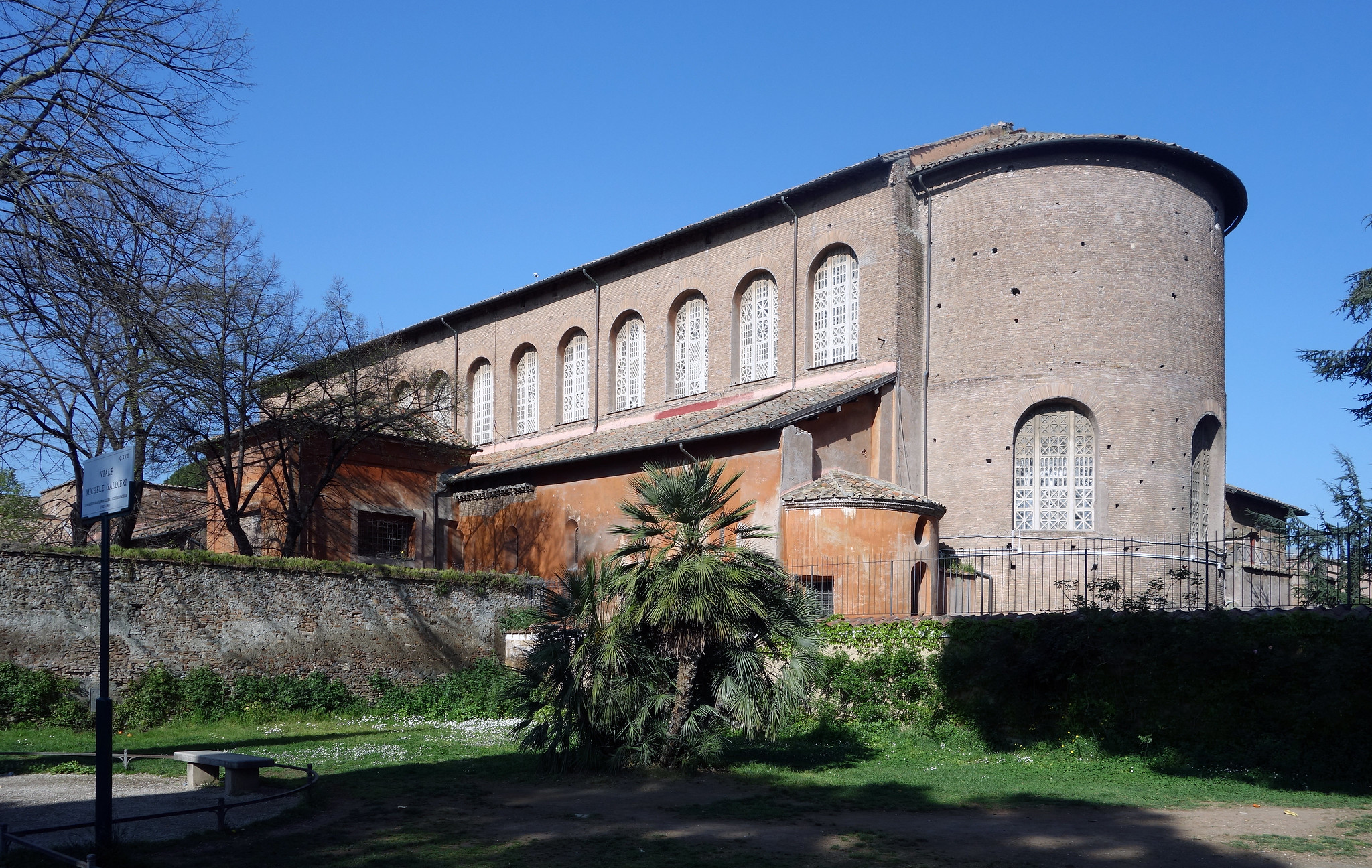
➼ Hagia Sophia
Details
- By Anthemius of Tralles and Isidorus of Miletus,
- 532–537
- Made of brick and ceramic elements, with stone and mosaic veneer,
- Found in Constantinople (Istanbul)
Form Exterior: plain and massive with little decoration.
Form Interior:
- Combination of centrally and axially planned church.
- Arcade decoration: walls and capitals are flat and thin and richly ornamented.
- Capitals diminish classical allusions; surfaces contain deeply cut acanthus leaves.
- Cornice unifies space.
- Large fields for mosaic decoration; at one time there were four acres of gold mosaics on the walls. –Many windows punctuate wall spaces.
- Dome: the first building to have a dome supported by pendentives.
- Altar at end of nave, but the emphasis placed over the area covered by the dome.
- Large central dome, with 40 windows at base symbolically acting as a halo over the congregation when filled with light.
Function
- Originally a Christian church; Hagia Sophia means “holy wisdom.”
- Built on the site of another church that was destroyed during the Nike Revolt in 532.
- Converted to a mosque in the fifteenth century; minarets added in the Islamic period.
- Converted into a museum in 1935; reconverted into a mosque in 2020.
Context
- Marble columns appropriated from Rome, Ephesus, and other Greek sites.
- Patrons were Emperor Justinian and Empress Theodora, who commissioned the work after the burning of the original building in the Nike Revolt.
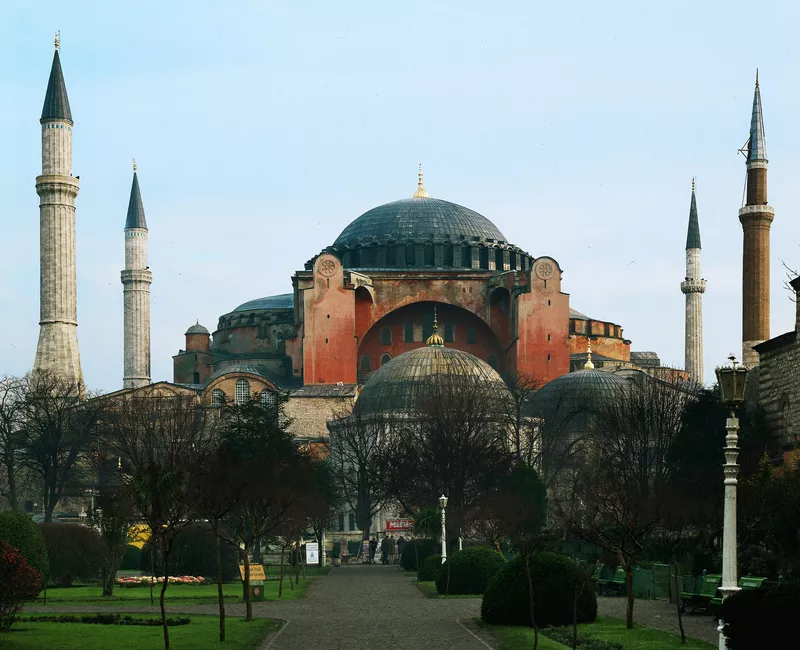
➼ San Vitale
Details
- Early Byzantine Europe
- 526–547
- Made of brick, marble, and stone veneer
- Found in Ravenna, Italy
Form
- Eight-sided church.
- Plain exterior; porch added later, in the Renaissance.
- Large windows for illuminating interior designs.
- Interior has thin columns and open arched spaces.
- Dematerialization of the mass of the structure.
- Combination of axial and central plans.
- Spolia: bricks taken from ruined Roman buildings reused here.
- Martyrium design: circular plan in an octagonal format.
Function: Christian church.
Context
- Mysterious space symbolically connects with the mystic elements of religion.
- Banker Julianus Argentarius financed the building of San Vitale.
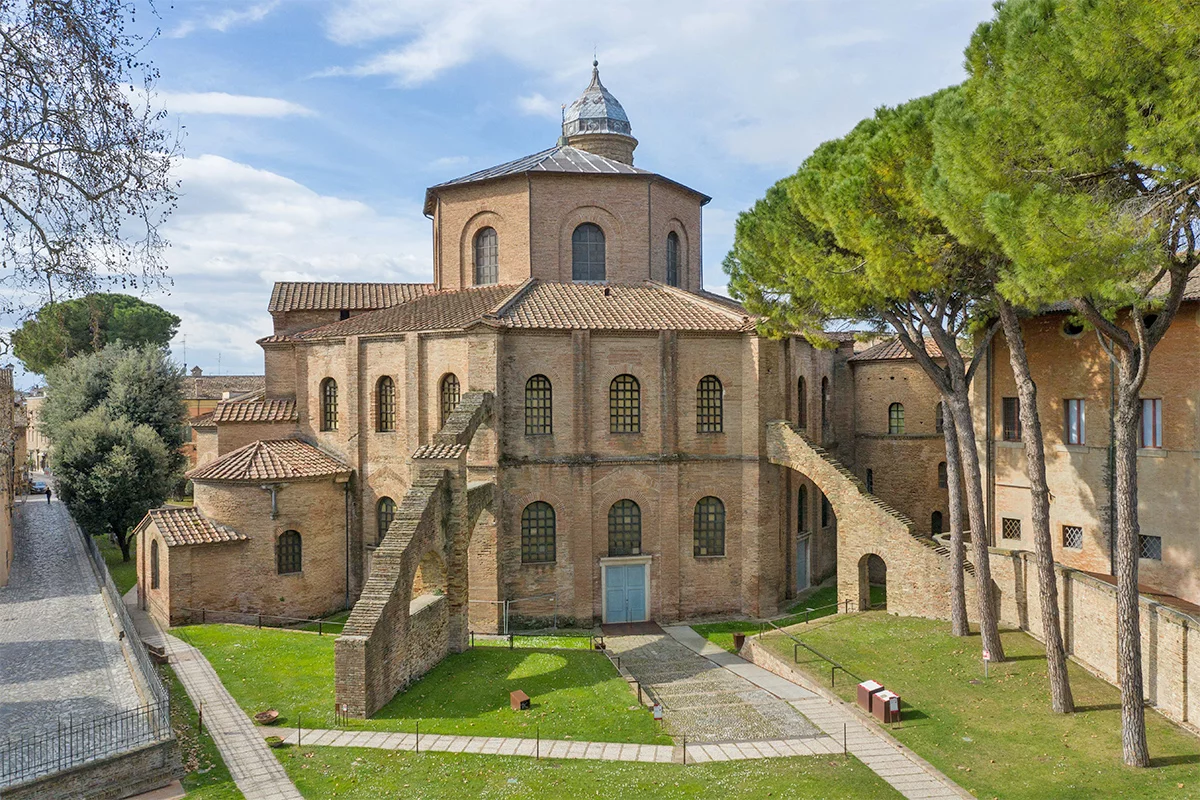
➼ Justinian Panel
Details
- c. 547
- A mosaic
- From San Vitale, Ravenna
Content
- Emperor Justinian, as the central image, dominates all; emperor’s rank indicated by his centrality, halo, fibula, and crown.
- To his left the clergy, to his right the military.
- Dressed in royal purple and gold.
- Divine authority symbolized by the halo; Justinian is establishing religious and political control over Ravenna.
Form
- Symmetry, frontality.
- Slight impression of procession forward.
- Figures have no volume; they seem to float and yet step on each other’s feet.
- Minimal background: green base at feet; golden background indicates timelessness.
Function
- Justinian holds a paten, or plate, for the Eucharist; participating in the service of the Mass almost as if he were a celebrant—his position over the altar enhances this reference.
- Justinian appears as head of church and state; regent of Christ on earth.
Context
- Archbishop Maximianus is identified; he is the patron of San Vitale.
- XP or Chi Rho, the monogram of Christ, on soldier’s shield shows them as defenders of the faith, or Christ’s soldiers on earth.
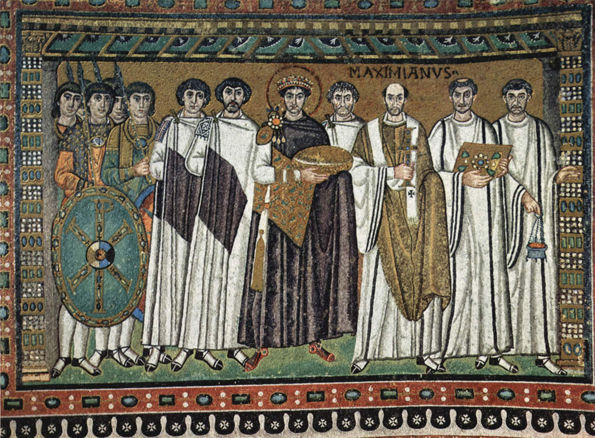
➼ Theodora Panel
Details
- c. 547
- A mosaic
- From San Vitale, Ravenna
Content
- Empress Theodora stands in an architectural framework holding a chalice for the Mass and is about to go behind the curtain.
Form
- Slight displacement of absolute symmetry with Empress Theodora; she plays a secondary role to her husband.
- She is simultaneously frontal and moving to our left.
- Figures are flattened and weightless; barely a hint of a body can be detected beneath the drapery.
Function
- She holds a chalice for the wine; participating in the service of the Mass almost as if she were a celebrant.
- She is juxtaposed with Emperor Justinian on the flanking wall; both figures hold the sacred items for the Mass.
Context
- Richly robed empress and ladies at court.
- The three Magi, who bring gifts to the baby Jesus, are depicted on the hem of her dress.
- This reference draws parallels between Theodora and the Magi.

➼ Vienna Genesis
Details
- Early Byzantine Europe
- Early 6th century
- An illuminated manuscript, tempera, gold, and silver on purple vellum, Austrian National Library, Vienna
Form
- Lively, softly modeled figures.
- Classical training of the artists: contrapposto, foreshortening, shadowing, perspective, classical allusions.
- Shallow settings.
- Fluid movement of decorative figures.
- Richly colored and shaded.
- Two rows linked by a bridge or a pathway.
- Text placed above illustrations, which are on the lower half of the page.
- Continuous narrative.
Context
- First surviving illustrations of the stories from Genesis.
- Genesis stories are done in continuous narrative with genre details.
- Written in Greek.
- Partial manuscript: 48 of 192 (?) illustrations survive.
Materials and Origin
- Manuscript painted on vellum.
- Written in silver script, now oxidized and turned black.
- Origin uncertain: a scriptorium in Constantinople? Antioch?
- Perhaps done in a royal workshop; purple parchment is a hallmark of a royal institution.
Rebecca and Eliezer at the Well
- Genesis 24: 15–61.
- Rebecca, shown twice, emerges from the city of Nahor with a jar on her shoulder to go down to the spring.
- She quenches the thirst of a camel driver, Eliezer, and his camels.
- Colonnaded road leads to the spring.
- Roman water goddess personifies the spring.
Jacob Wrestling the Angel
- Genesis 32: 22–31.
- Jacob takes his two wives, two maids, and eleven children and crosses a river; the number of children is abbreviated.
- At night Jacob wrestles an angel.
- The angel strikes Jacob on the hip socket.
- Classical influence in the Roman-designed bridge, but medieval influence in the bridge’s perspective: i.e., the shorter columns are placed in the nearer side of the bridge and the taller columns behind the figures.
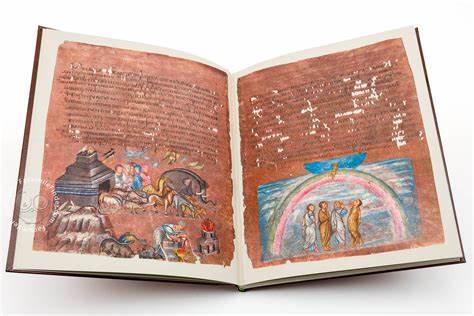
➼ Virgin (Theotokos) and Child between Saints Theodore and George
Details
- Early Byzantine Europe
- 6th or early 7th centuries
- Encaustic on wood
- Found in Monastery of Saint Catherine, Mount Sinai, Egypt
Function
- Icon placed in a medieval monastery for devotional purposes.
Content and Form
- Virgin and Child centrally placed; firmly modeled.
- Mary as Theotokos, mother of God.
- Mary looks beyond the viewer as if seeing into the future.
- Christ child looks away, perhaps anticipating his crucifixion.
- Saints Theodore and George flank Virgin and Child.
- Warrior saints.
- Stiff and hieratic.
- Directly stare at the viewer; engage the viewer directly.
- Angels in background look toward heaven.
- Painted in a classical style with brisk brushwork in encaustic, a Roman tradition.
- Turned toward the descending hand of God, which comes down to bless the scene.
- Because the three groups are in very different styles, it has been assumed that they were painted by three different artists.
Context
- Pre–Iconoclastic Controversy icon, located in the Sinai and encaustic places it near Roman-Egyptian encaustic painted portraits.
- \
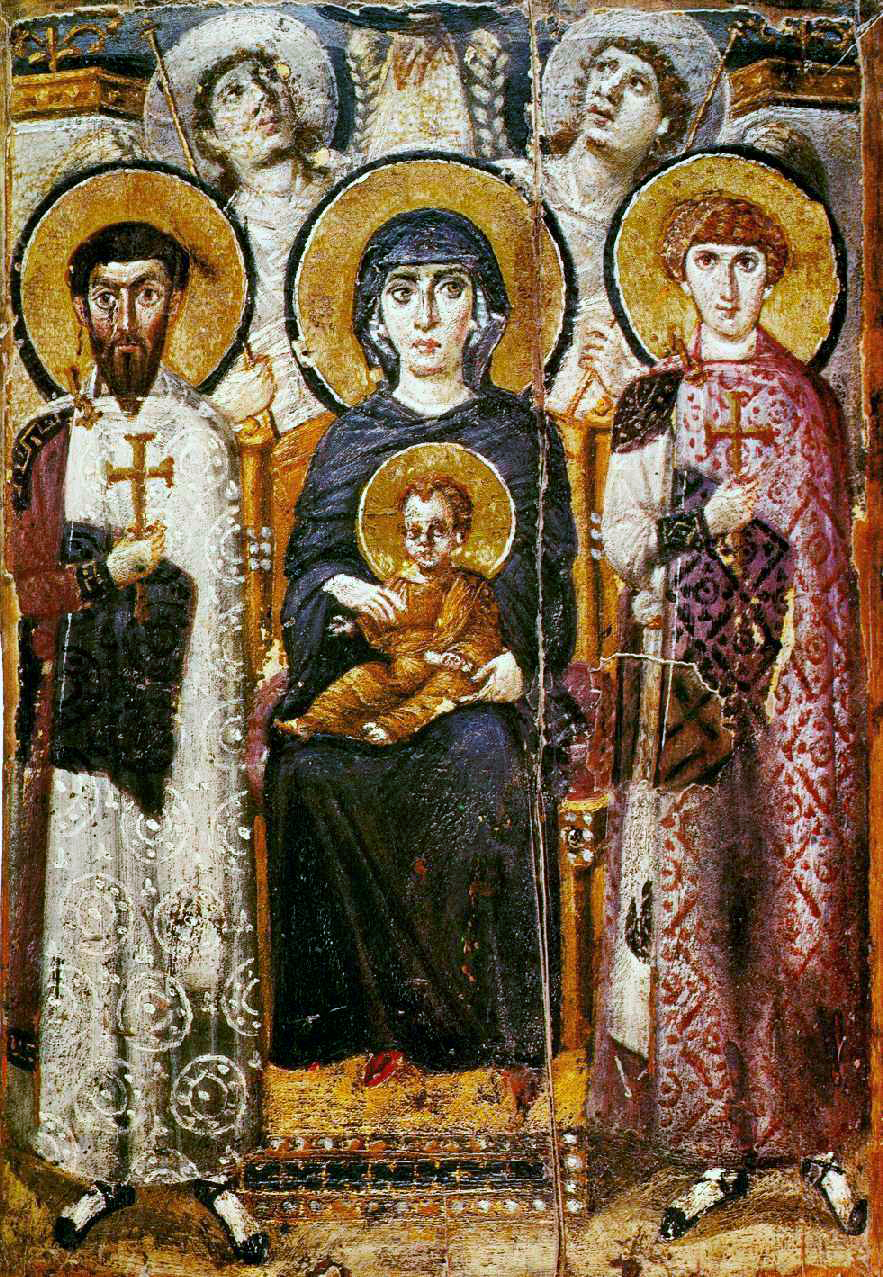
➼ Merovingian looped fibulae
Details
- Early medieval Europe
- Mid-6th century
- Made of silver gilt worked in filigree with semiprecious stones, inlays of garnets and other stones
- Found in Musee d’Archeologie Nationale, Saint-Germain-en-Laye, France
Form
- Zoomorphic elements—fish and bird, possibly Christian or pagan symbols.
- Highly abstracted forms derived from the classical tradition.
Function
- Fibula: a pin or brooch used to fasten garments; showed the prestige of the wearer.
- Small portable objects.
Context
- Found in a grave.
- Probably made for a woman.
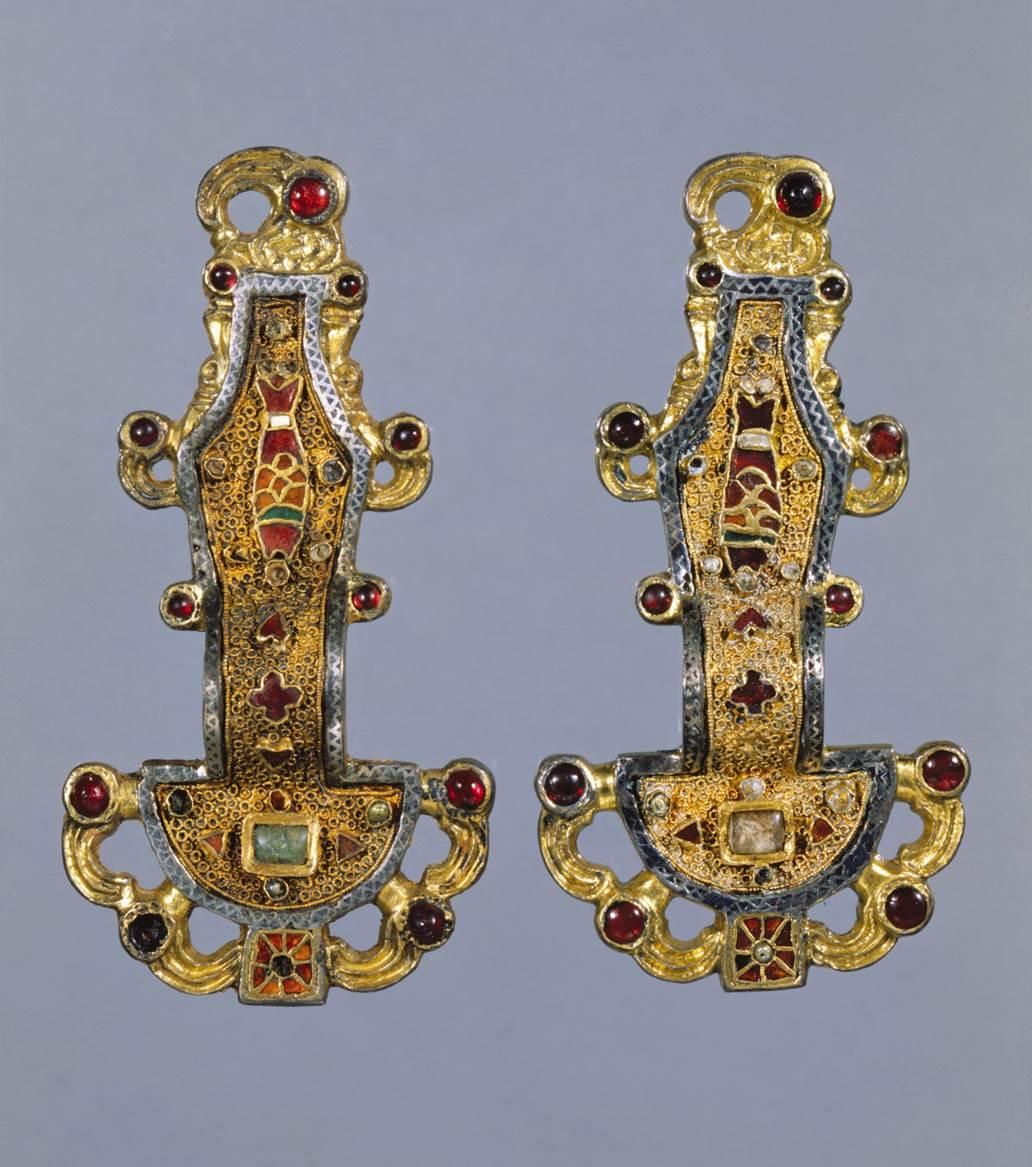
➼ Lindisfarne Gospels
Details
- Early medieval Europe
- c. 700
- Made of illuminated manuscript, ink, pigments, and gold on vellum
- Found in British Library, London
- Gospels: the first four books of the New Testament that chronicle the life of Jesus Christ
Function
- The first four books of the New Testament
- Used for services and private devotion.
Materials: Manuscript made from 130 calfskins.
Content
- Evangelist portraits come first, followed by a carpet page.
- These pages are followed by the opening of the gospel with a large series of capital letters.
Context
- Written by Eadrith, bishop of Lindisfarne.
- Unusual in that it is the work of an individual artist and not a team of scribes.
- Written in Latin with annotations in English between the lines; some Greek letters
- Latin script is called half-uncial.
- English added around 970; it is the oldest surviving manuscript of the Bible in English.
- English script called Anglo-Saxon minuscule.
- Uses Saint Jerome’s translation of the Bible, called the Vulgate.
- Colophon at end of the book discusses the making of the manuscript.
- Colophon: a commentary on the end panel of a Chinese scroll; an inscription at the end of a manuscript containing relevant information on its publication
- Made and used at the Lindisfarne Priory on Holy Island, a major religious center that housed the remains of Saint Cuthbert.
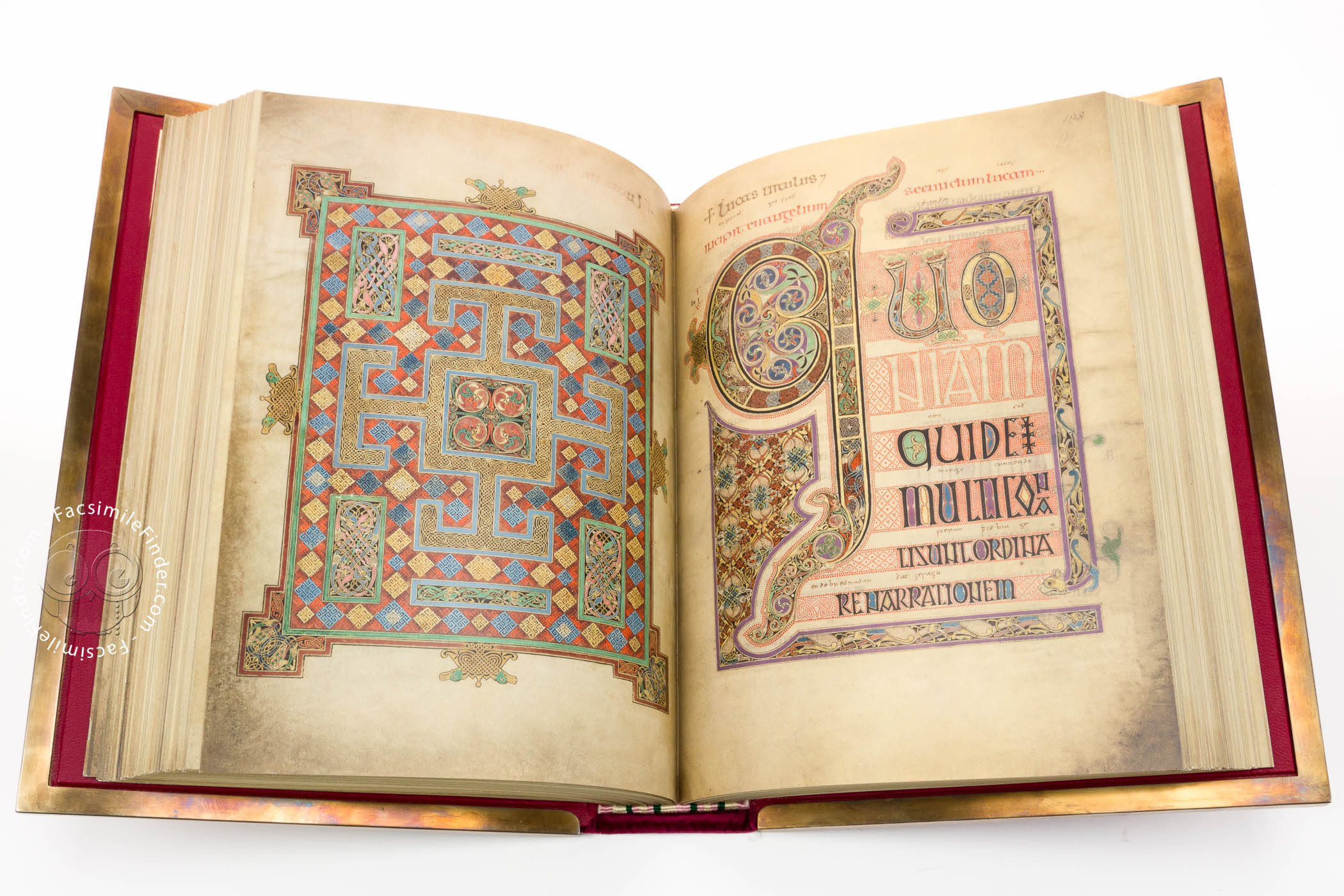
➼ Church of Sainte-Foy
Details
- Romanesque Europe
- c. 1050–1130, stone
- Conques, France
Form
- Church built to handle the large number of pilgrims: wide transepts, large ambulatory with radiating chapels.
- Radiating chapel: a chapel that extends out in a radial pattern from an apse or an ambulatory
- Transept: an aisle in a church perpendicular to the nave
- Massive heavy interior walls, unadorned.
- No clerestory; light provided by windows over the side aisles and galleries.
- Barrel vaults in nave, reinforced by transverse arches.
- Transverse arch: an arch that spans an interior space connecting opposite walls by crossing from side to side
- Cross-like ground plan, called a Latin cross.
Function
- Christian church built along the pilgrimage road to Santiago de Compostela, a popular pilgrimage center for the worship of the relics of Saint James.
- Radiating chapels housed relics of the saints.
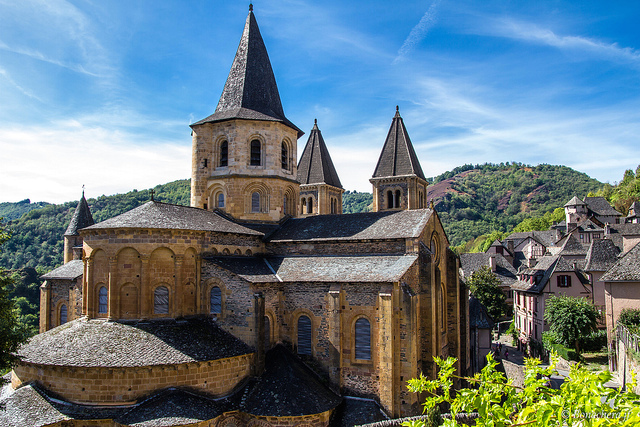
➼ Last Judgment
Details
- 1050–1130
- Made of stone and paint
- Found in Sainte-Foy, Conques
Form
- Largest Romanesque tympanum.
- 124 figures densely packed together; originally richly painted.
Function
- Last Judgment cautions pilgrims that life is transitory and one should prepare for the next life.
- Subject of the tympanum reminds pilgrims of the point of their pilgrimage.
Content
- Christ, as a strict judge, divides the world into those going to heaven and those going to hell.
- Christ is depicted with a welcoming right hand, a cast down left hand.
- Christ sits in a mandorla.
- A dividing line runs vertically through the cross in the middle of the composition.
- The Archangel Michael and the devil are at Christ’s feet, weighing souls.
- Hell, with the damned, is on the right.
- People enter the church on the right as sinners and exit on the left as saved; the right door has sculptures of the damned and the left door has images of the saved.
- The figures of the saved move toward Christ, Mary, and Saint Peter; local abbots and monks follow Charlemagne, the legendary benefactor of the monastery, who is led by the hand.
- Paradise, at the lower level, is portrayed as the heavenly Jerusalem.
- Sainte Foy interceded for those enslaved by the Muslims in Spain—she herself appears kneeling before a giant hand of God.
- On the right lower level, the devil presides over a chaotic tangle of tortured condemned sinners.
- Inscription on lintel: “O Sinners, change your morals before you might face a cruel judgment.”
- Hieratic scale may parallel one’s status in a feudal society.
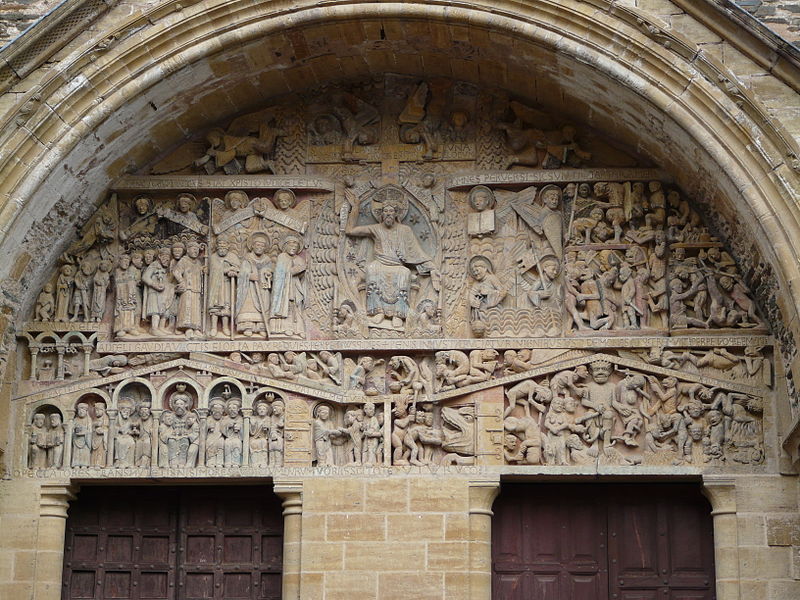
➼ Reliquary of Sainte-Foy
Details
- Made of gold, silver, gemstones, and enamel over wood.
- 9th century, with later additions
- Found in Sainte-Foy, Conques
Form
- Child saint’s skull is housed in the rather mannish-looking enlarged head.
- Jewels, gems, and crown added over the years by the faithful, as acts of devotion.
- Facial expression is haughty and severe.
Function: Reliquary of a young girl martyred in the early fourth century.
Context
- Sainte Foy (or Faith) probably died as a martyr to the Christian faith during the persecutions in 303 under Emperor Diocletian; she was tortured over a brazier; she refused to sacrifice to the Roman gods in a pagan ritual.
- Saint Foy, triumphant over death, looking up and over the viewer’s head.
- Relics of her body were stolen from a nearby town and enthroned in Conques in 866.
- One of the earliest large-scale sculptures in the Middle Ages.
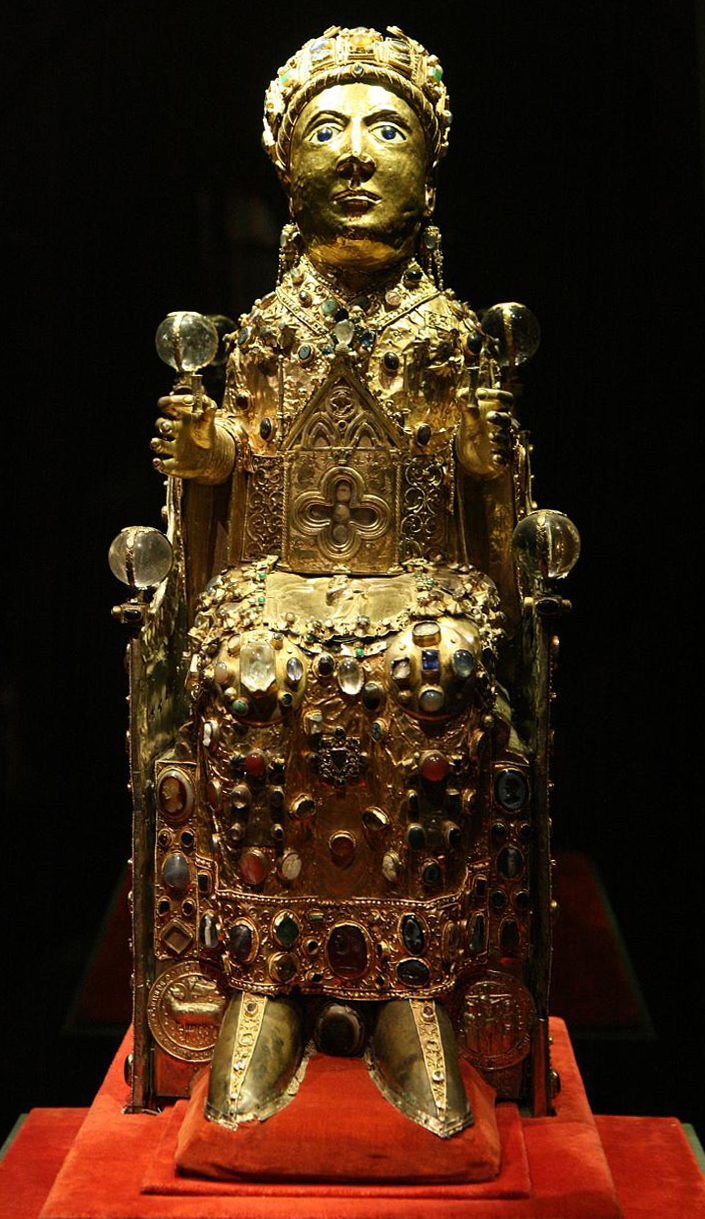
➼ The Bayeux Tapestry
Details
- Romanesque Europe (English or Norman)
- 1066–1080
- Made of embroidery on linen
- Found in Bayeux Tapestry Museum, Bayeux, France
Form
- Color used in a decorative, although unnatural, manner—different parts of a horse are colored variously.
- Neutral background of unpainted fabric.
- Flat figures; no shadows.
Content
- Tells the story (in Latin) of William the Conqueror’s conquest of England at the Battle of Hastings in 1066.
- The story, told from the Norman point-of-view, emphasizes the treachery of Harold of England, who breaks his vow of loyalty and betrays William by having himself crowned.
- More than 600 people, 75 scenes.
- Fanciful beasts in upper and lower registers.
- Borders sometimes comment on the main scenes or show scenes of everyday life.
Function
- Uncertainty over how this work was meant to be displayed, perhaps in a cathedral hung from the pillars in the nave or hung in a hall along a wall.
Technique
- Tapestry is a misnomer; actually, it’s an embroidery.
- Probably designed by a man and executed by women.
Patronage: Commissioned by Bishop Odo, half-brother to William the Conqueror.
Context
- Continues the narrative tradition of medieval art; 230 feet long.
- Narrative tradition goes back to the Column of Trajan
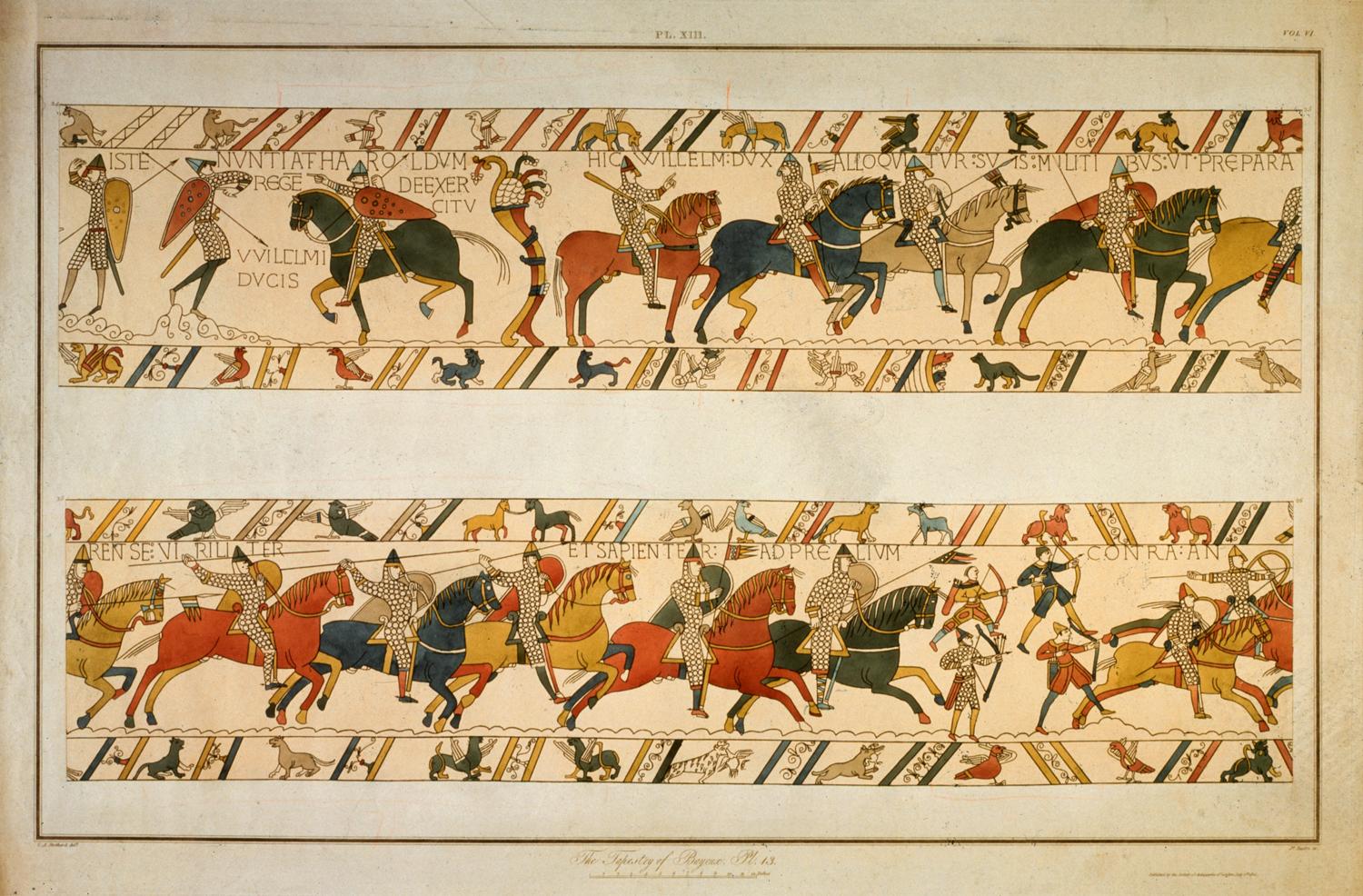
➼ Chartres Cathedral
Details
- Gothic Europe
- c. 1145–1155, reconstructed 1194–1220
- Made of limestone and stained glass
- Found in Chartres, France
Form
- The first church to have flying buttresses as part of the original design; earlier churches retrofitted flying buttresses after the building was constructed.
- The tall vertical nature of the interior pulls the viewer’s eyes up to the ceiling and symbolically to heaven; rib vaulting increases the ceiling’s vertical thrust.
- Lancets and spires add to the verticality of the building.
- Spire or Steeple: a tall pointed tower on a church
- The dark, mysterious interior increases a spiritual feeling.
- Stained glass enlivens the interior surfaces of the church.
- The façade contains a gallery of Old Testament figures above a rose window.
- Enlarged chevet accommodates elaborate church ceremonies.
Function: Christian church dedicated to the Virgin Mary; a Marian shrine.
Context
- Started in 1145; fire in 1194 forced reconstruction of everything except the façade.
- Mary’s tunic, worn at Jesus’s birth, is its most sacred relic; its escape from a fire in 1194 was seen as a signal to rebuild the cathedral.
- Right spire is from 1160; left spire is Late Gothic (1507–1513), a style more elaborate and decorative called Flamboyant Gothic.
- Importance of the church reflected in the speed of construction: 27 years.
- Each wing of the cathedral faces a cardinal direction of the compass:
- The west wing is the entrance, facing sunset and symbolizing the end of the world.
- The north wing has stained-glass windows that symbolize the past.
- The south wing has stained-glass windows that symbolize the presentworld depicted in the New Testament.
- The east wing has the apse and altar, located where the sun rises.
- Part of a complex that included a school, a bishop’s palace, and a hospital.
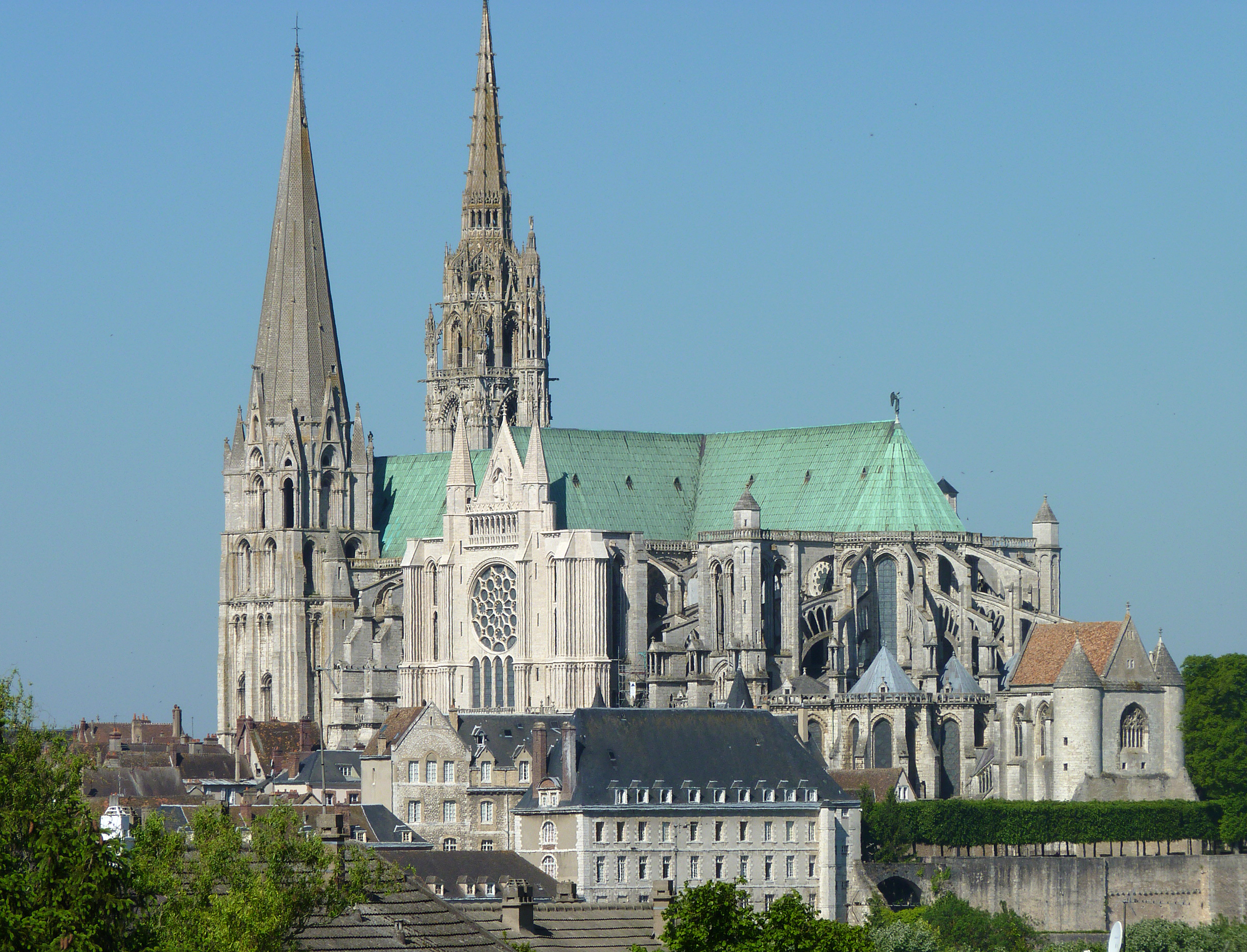
➼ Notre Dame de la Belle Verriere
Details
- “Our Lady of the Beautiful Window”
- c. 1170
- A stained glass
- Found in Chartres Cathedral
Function:
- Part of a lancet stained-glass window in Chartres Cathedral.
- Lancet: a tall narrow window with a pointed arch usually filled with stained glass
Context
- Mary, the throne of wisdom, is crowned Queen of Heaven with the Christ Child on her lap.
- Color patterns on the cathedral's gray stone represent the divine.
- Bands across the surface are typical of Early Gothic stained glass.
- Undamaged by the fire of 1194, it was reset with blue framing and framing angels on either side of the main scene, contrasting the two stained glass styles in the same window.

➼ Scenes from the Apocalypse
Details
- From a Bible moralisée (Moralized Bible), Gothic Europe
- c. 1225–1245
- Made of illuminated manuscript, ink, tempera, and gold leaf on vellum
- Found in Cathedral, Toledo
- Apocalypse: the last book of the Christian Bible, sometimes called Revelations, which details God’s destruction of evil and consequent raising to heaven of the righteous
- Moralized Bible: a Bible in which the Old and New Testament stories are paralleled with one another in illustrations, text, and commentary
Form
- Eight medallions; format derives from the stained-glass windows.
- Luminosity of text a reflection of stained-glass windows; strong black outlining of forms.
- Two vertical columns of four painted scenes.
- Modeling is minimal.
Function: Moralized Bible.
Content
- Each scene has a text with a summary of the event depicted in the roundel.
- Old and New Testament scenes are paired as complementing one another.
Context: Done for the royal court at Paris.
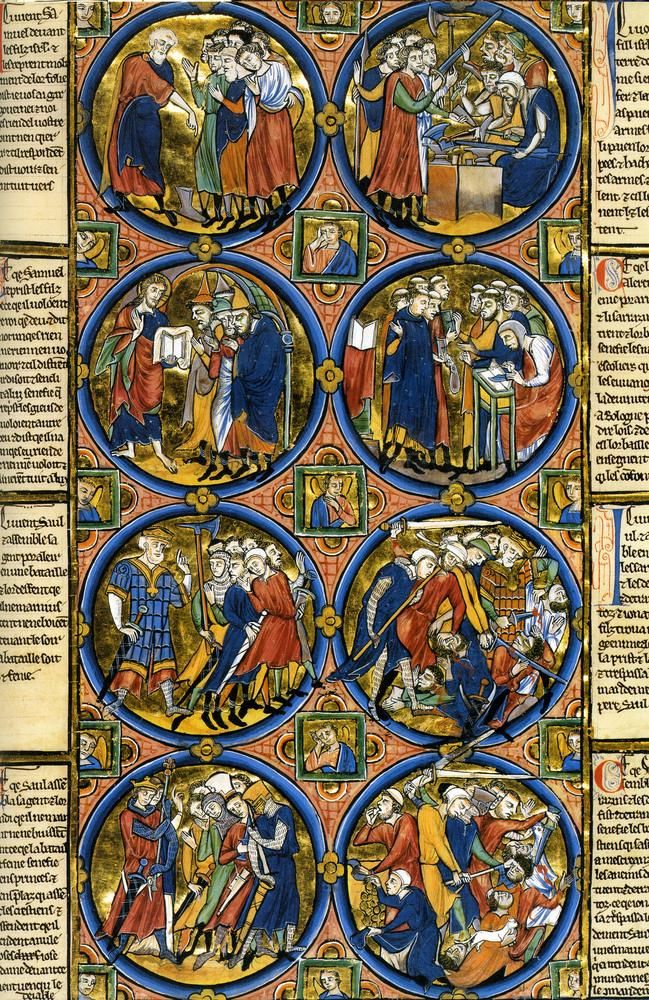
➼ Golden Haggadah
Details
- (The Plagues of Egypt, Scenes of Liberation, and Preparation for Passover),
- From late medieval Spain
- c. 1320
- Made of illuminated manuscript, pigments and gold leaf on vellum
- Found in British Library, London
- Passover: an eight day Jewish festival that commemorates the exodus of Jews from Egypt under the leadership of Moses.
Form
- Style similarities to French Gothic manuscripts in the handling of space, architecture, figure style, facial/gestural expression, and the manuscript medium itself.
- 56 miniatures; gold leaf background.
Function and Content
- A Haggadah is a book that illustrates the story of the Jewish exodus from Egypt under Moses and its subsequent celebration.
- It contains a narrative cycle of events from the books of Genesis and Exodus.
- It is to be read at a Passover Seder.
- This Haggadah was used primarily at home, therefore avoiding the more stringent restriction against holy images in a synagogue.
Context
- Haggadah means “narration”; fulfills the Jewish requirement to tell the story of the Jewish escape from Egypt as a reminder of God’s mercy.
- Haggadot (plural) are generally the most lavishly painted of Jewish manuscripts.
- The book is read right to left according to the manner of Hebrew texts.
- Two unknown artists, probably Christian, illustrated the Golden Haggadah; a Jewish scribe wrote the Hebrew script.
- Painted around the Barcelona area of Spain.
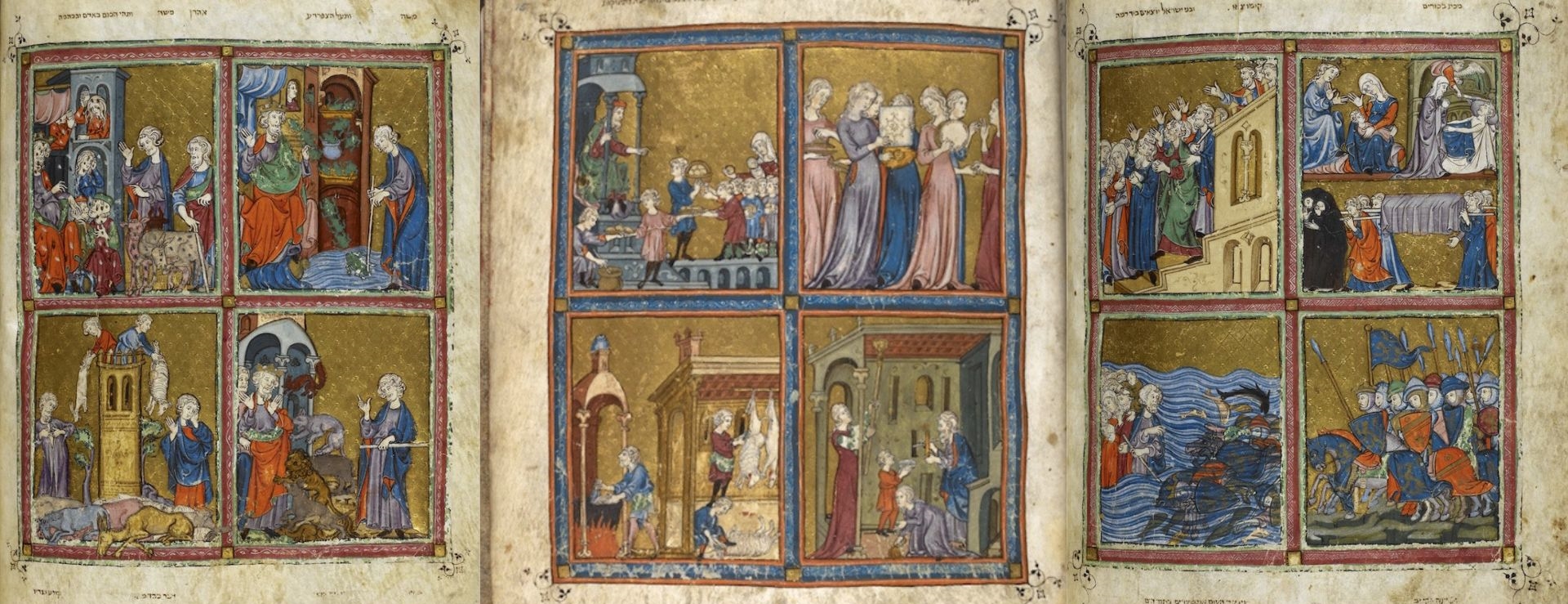
➼ Arena (Scrovegni) Chapel
Details
- Unknown architext
- c. 1303, brick
- Found in Padua, Italy
Context
- The Arena Chapel was built by an unknown architect over an ancient Roman arena.
- It is also called the Scrovegni Chapel after the name of the patron, Enrico Scrovegni.
- It was built to expiate the sin of usury through which Scrovegni’s father amassed a fortune; shows the rise of patronage from the European business class.
- Some narrative scenes illustrate biblical episodes of ill-gotten gains.
- The life of Christ appears on one side of the chapel, the life of Mary on the other.
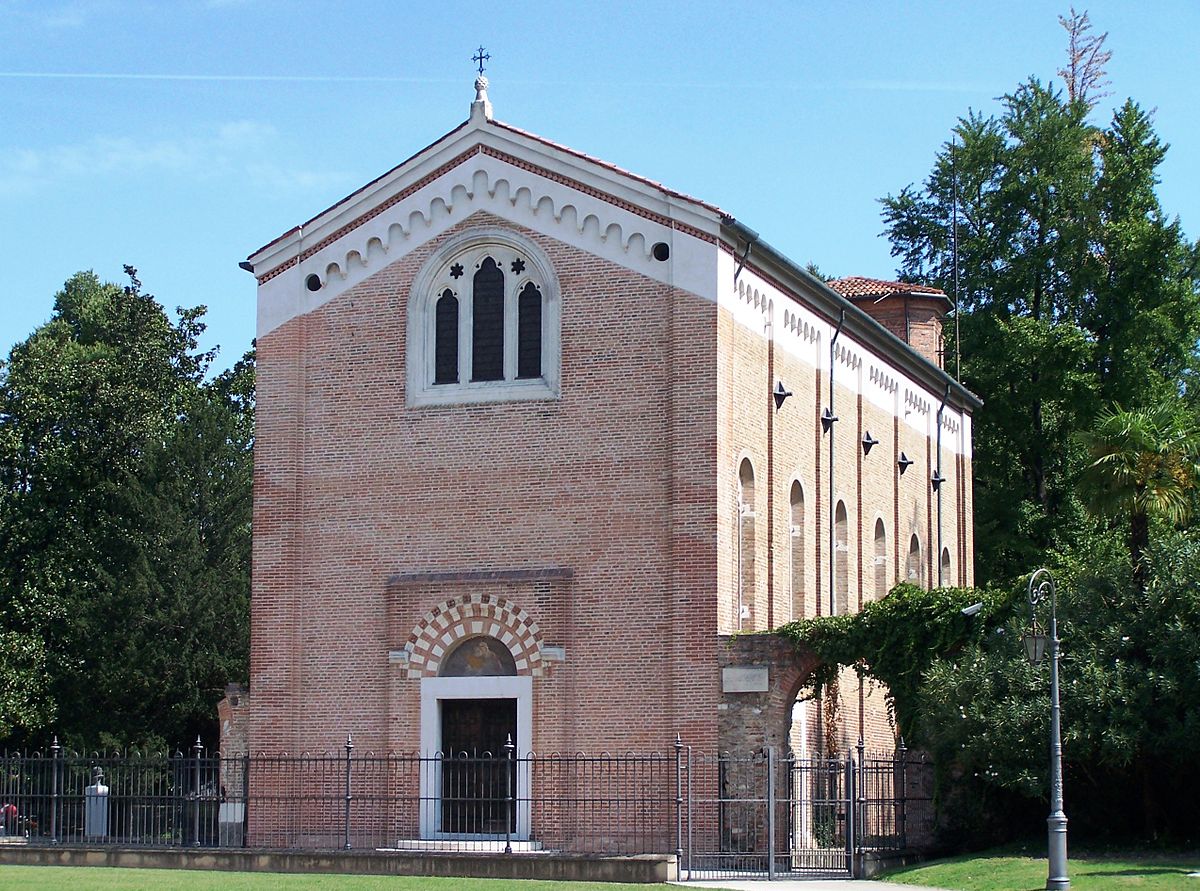
➼ Last Judgment from the Arena Chapel
Details
- Painted by Giotto
- 1305
- A fresco painting.
- Found in Padua, Italy
- Last Judgment: in Christianity, the judgment before God at the end of the world
Content
- Christ as judge, coming at the end of the world.
- Heavenly powers are arranged in an organized chorus; heads aligned in a row.
- Twelve apostles are arranged symmetrically around Christ.
- Cross at bottom center divides the saved from the damned.
- On the side of the saved is Enrico Scrovegni in his role as donor presenting a model of the church to angels.
- At right is the devil, who eats and excretes sinners.
- Those guilty of usury or money-related sins like prostitution are particularly noted.

➼ Lamentation from the Arena Chapel
Details
- Painted by Giotto
- 1305
- A fresco painting.
- Found in Padua, Italy
- Lamentation: scenes that show Jesus’s followers mourning his death. Usually the scene contains Mary, Saint John, and Mary Magdalene
Form
- Shallow stage; figures occupy a palpable space pushed forward toward the picture plane.
- Diagonal cliff formation points to main action daringly placed in lower left-hand corner.
- Modeling indicates direction of light; light falls from above right.
- Figures seen from the back isolate the main action.
Content
- Lamentation shows scenes of Jesus’s followers mourning his death. Usually the scene contains Mary, Saint John, and Mary Magdalene.
- Saint John throws his hands back—recalling his iconographic symbol as an eagle; Mary Magdalene cradles Jesus’s feet; Mary holds Jesus’s head.
- At left is the Old Testament scene of Jonah being swallowed by the whale and returning to life, a parallel with the New Testament scene of Christ dying and rising from the dead.
- Range of emotions: heavy sadness, quiet resignation, flaming outbursts, despair.
- Sadness of scene emphasized by grieving angels.
- Leafless tree echoes the theme of death in the painting; also represents the tree of the knowledge of good and evil in the Garden of Eden, which dies after Adam and Eve are expelled; a dead tree also symbolizes the wood of the cross Jesus was crucified on.
- Christians believe Jesus sacrificed himself, in part, to expiate the expulsion from the Garden of Eden.
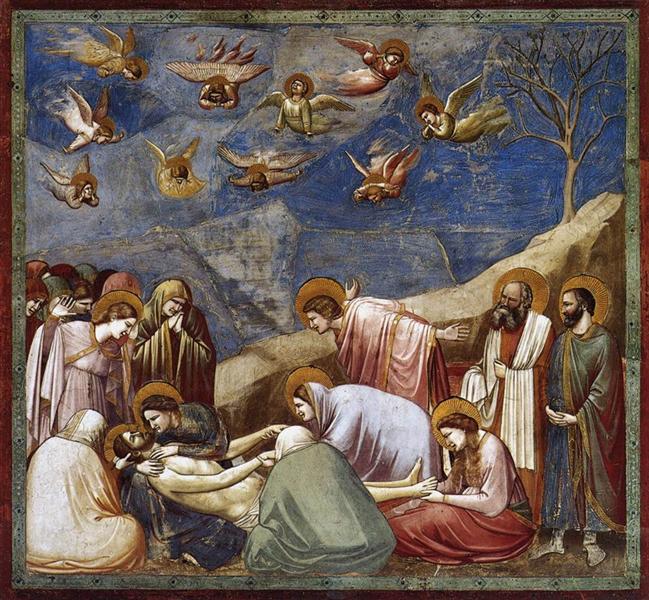
➼ Annunciation Triptych
Details
- Robert Campin workshop
- also called Merode Altarpiece
- 1427–1432
- An oil on wood
- Found in Metropolitan Museum of Art, New York
Form
- Annunciation: in Christianity, an episode in the Book of Luke 1:26–38 in which Angel Gabriel announces to Mary that she would be the Virgin Mother of Jesus
- Triptych: a three-paneled painting or sculpture
- Triptych, or three-paneled altarpiece.
- Meticulous handling of paint; intricate details are rendered through the use of oil paint.
- Steep rising of the ground line; figures too large for the architectural space they occupy.
Function: Meant to be in a private home for personal devotion.
Technique
- Oil paint gives the surface a luminosity and shine.
- Oil allows for layers of glazes that render soft shadows.
- Oil can also be erased with turpentine, allowing for changes and corrections.
Content
- Left panel: donors, middle-class people kneeling before the holy scene.
- Messenger appears at the gate to an enclosed garden.
- Center panel: Annunciation taking place in an everyday Flemish interior.
- Symbolism
- Towels and water represent Mary’s purity; water is a baptism symbol.
- Flowers have three buds, symbolizing the Trinity; the unopened bud represents the unborn Jesus.
- Mary is seated on a kneeler near the floor, symbolizing her humility.
- Mary blocks the fireplace, the entrance to hell.
- The candlestick symbolizes Mary holding Christ in the womb.
- The Holy Spirit with a cross comes in through the window, symbolizing the divine birth.
- Humanization of traditional themes: no halos, domestic interiors, view into a Flemish cityscape.
- Right panel: Joseph is working in his carpentry workshop; the mousetraps on the windowsill and the workbench symbolize the capturing of the devil.
- The mousetraps on the bench and in the shop window opening onto the street are thought to allude to references in the writings of Saint Augustine identifying the cross as the devil’s mousetrap.
Context
- Unusually, the main panel was not commissioned.
- Wings were commissioned when the main panel was purchased; the donor portrait was added at this time.
- Donor: a patron of a work of art, who is often seen in that work
- After the donor’s marriage in the 1430s, the wife and messenger were added, which accounts for the rather squeezed-in look of the donor’s wife.
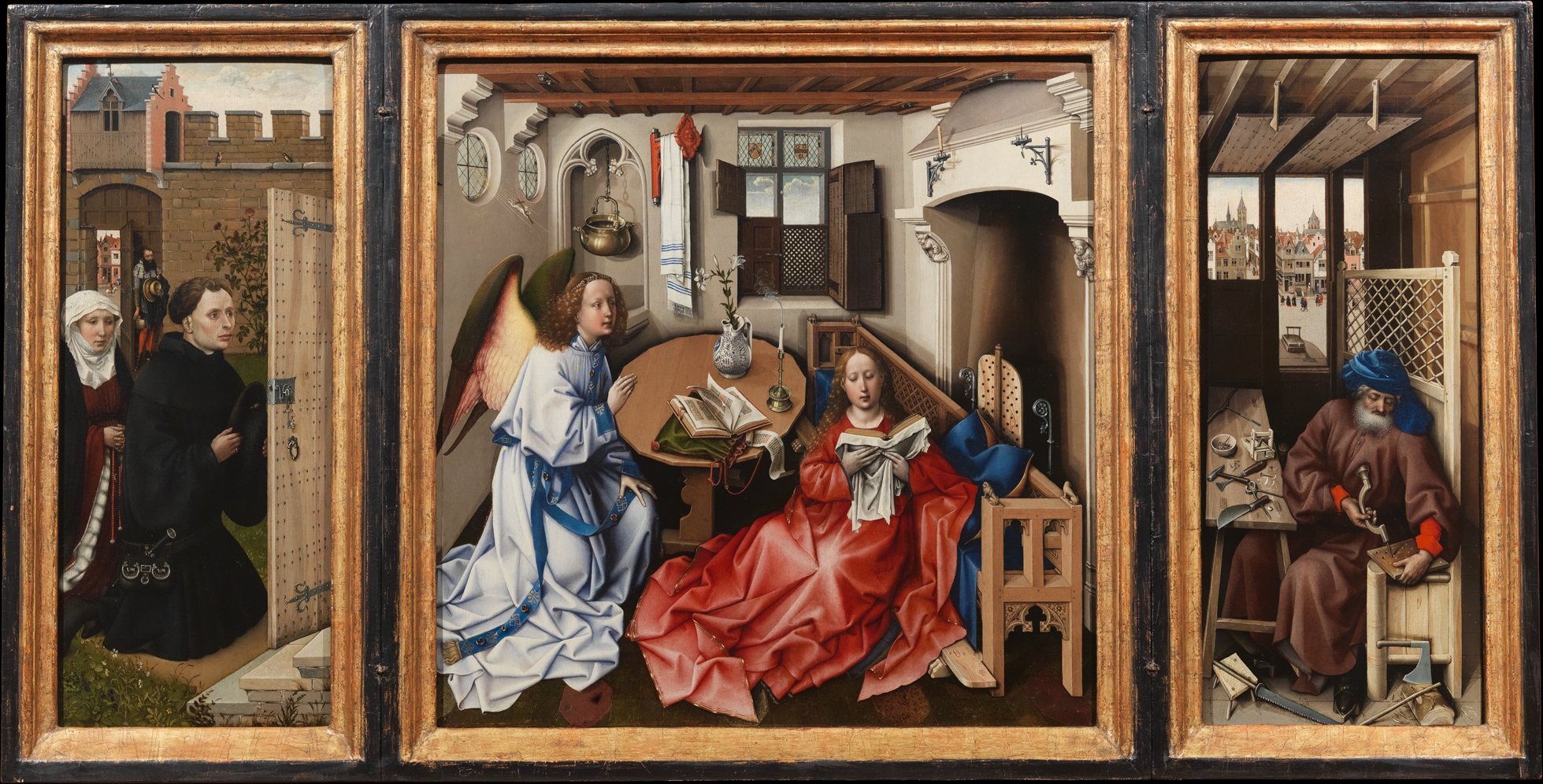
➼ Arnolfini Portrait
Details
- Painted by Jan van Eyck.
- 1434
- An oil on wood
- Found in National Gallery, London
Form
- Meticulous handling of oil paint; great concentration of minute details.
- Linear perspective, but upturned ground plane and two horizon lines unlike contemporary Italian Renaissance art.
- Great care is taken in rendering elements of a contemporary Flemish bedroom.
Theories
- Traditionally assumed to be the wedding portrait of Giovanni Arnolfini and his wife.
- It may be a memorial to a dead wife, who could have died in childbirth.
- It may represent a betrothal.
- Arnolfini may be conferring legal and business privileges on his wife during an absence.
- The painting may have been meant as a gift for the Arnolfini family in Italy.
- It had the purpose of showing the prosperity and wealth of the couple depicted.
Context
- Symbolism of weddings:
- The custom of burning a candle on the first night of a wedding.
- Shoes are cast off, indicating that the couple is standing on holy ground.
- The groom is in a promising pose.
- The dog symbolizes fidelity.
- Two witnesses in the convex mirror; perhaps the artist himself, since the inscription reads “Jan van Eyck was here 1434.”
- The woman pulls up her dress to symbolize childbirth, although most likely she is not pregnant; the gesture may simply be a fashion of the time.
- Statue of Saint Margaret, patron saint of childbirth, appears on the bedpost.
- The man is standing near the window, symbolizing his role as someone who makes his way in the outside world; the woman appears further in the room to emphasize her role as a homemaker.
- Wealth is displayed in the opulent furnishings, the elaborate clothing, and the importing of fresh oranges from southern Europe.
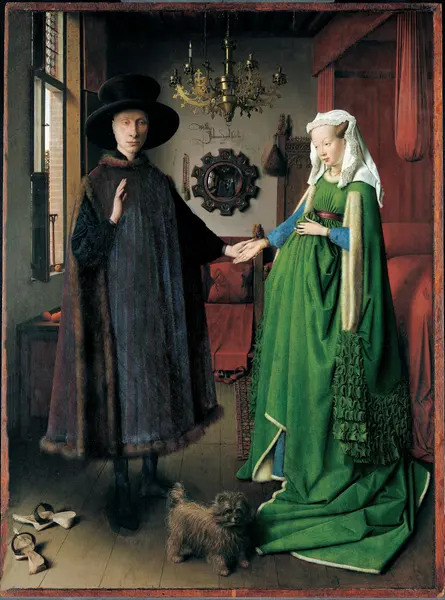
➼ Adam and Eve
Details
- Engraved by Albrecht Dürer
- An engraving
- Found in Metropolitan Museum of Art, New York
Form
- Influenced by classical sculpture; Adam looks like the Apollo Belvedere, and Eve looks like Medici Venus.
- Italian massing of forms, which he learned from his Italian trips.
- Ideal image of humans before the Fall of Man (Genesis 3).
- Contrapposto of figures from the Italian Renaissance, in turn also based on classical Greek art.
- Northern European devotion to detail.
Content
- Four humors are represented in the animals:
- cat (choleric, or angry),
- rabbit (sanguine, or energetic),
- elk (melancholic, or sad),
- ox (phlegmatic, or lethargic);
- The four humors were kept in balance before the Fall of Man;
- The humors fell out of balance after the successful temptation of the serpent.
- The mouse represents Satan.
- The parrot is a symbol of cleverness.
- Adam tries to dissuade Eve; he grasps the mountain ash, a tree from which snakes recoil.
Context: Prominent placement of the artist’s signature indicates the rising status of his occupation.
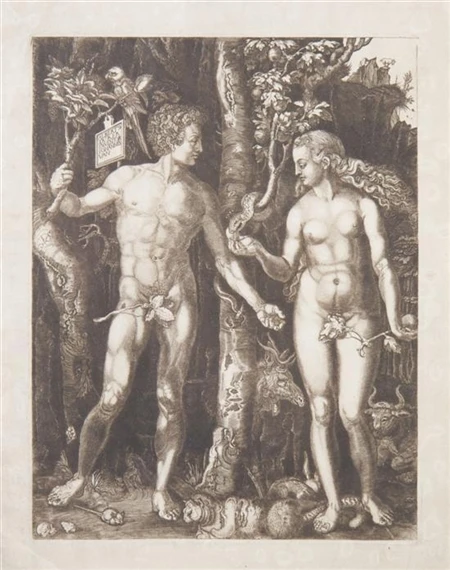
➼ Allegory of Law and Grace
Details
- Made by Lucas Cranach the Elder
- c. 1530,
- A woodcut and letterpress
Function
- Designed using the woodcut technique to make the image available to the masses.
- Its purpose was to contrast the benefits of Protestantism versus the perceived disadvantages of Catholicism.
- Influential image of the Protestant Reformation; text appears in the people’s language: German, and not the church language: Latin.
Context
- Protestantism: the faithful achieve salvation by God’s grace; guidance can be achieved using the Bible.
- Meant to reflect the Lutheran ideas about salvation.
- Done in consultation with Martin Luther, a leader in the Protestant movement.
- Left: Last Judgment
- Moses holds the Ten Commandments.
- The Ten Commandments represent the Old Law, Catholicism.
- The Law of Moses is not enough; it is not enough to live a good life.
- A skeleton chases a man into hell.
- Right: Figure bathed in Christ’s blood
- Faith in Christ alone is needed for salvation.
- Symbolically, the barren branches of the tree on the left side contrast with the full bloom on the right.
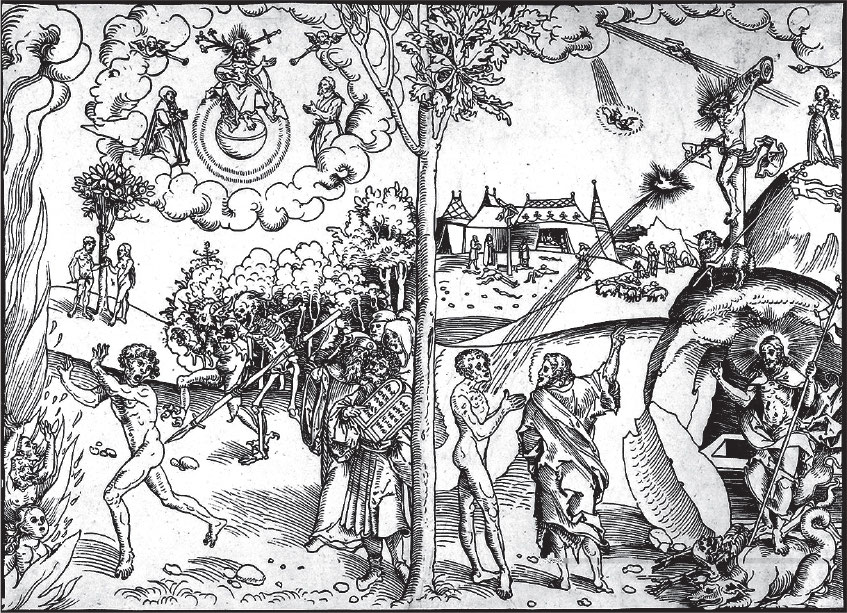
➼ Hunters in the Snow
Details
- Painted by Pieter Bruegel the Elder
- 1565
- An oil on wood
- Found in Art History Museum, Vienna
Form
- Alpine landscape; typical winter scene inspired by the artist’s trips across the Alps to Italy.
- Strong diagonals lead the eye deeper into the painting.
- Figures are peasant types, not individuals.
- Landscape has high horizon line with panoramic views, a Northern European tradition.
- Extremely detailed.
Function
- ne of a series of six paintings representing the labors of the months—this winter scene is November/December.
- Placed in a wealthy Antwerp merchant’s home.
- Patrons were wealthy individuals of high status; Bruegel’s paintings offered them a view of the world of the peasants.
Context
- Hunters have had little success in the winter hunt; dogs are skinny and hang their heads.
- Peasants in the sixteenth century were regarded as buffoons or figures of fun;
- Bruegel does not give them individuality but does treat them with respect
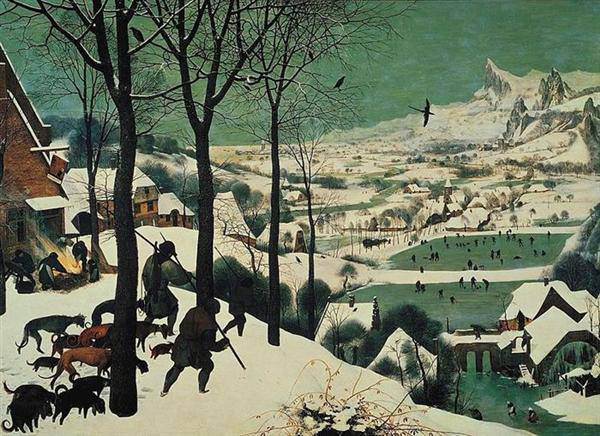
➼ Pazzi Chapel
Details
- Designed by Filippo Brunelleschi
- Basilica di Santa Croce
- Designed 1423; Built 1429–1461,
- A masonry,
- Found in Florence, Italy
Form
- Two barrel vaults on the interior; small dome over crossing; pendentives support dome; oculus in the center.
- Interior has a quiet sense of color with muted tones that is punctuated by glazed terra cotta tiles.
- Use of pietra serena (a grayish stone) in contrast to whitewashed walls accentuates basic design structure.
- Pietra serena: a dark-gray stone used for columns, arches, and trim details in Renaissance buildings
- Inspired by Roman triumphal arches.
- Ideal geometry in the plan of the building.
Function
- Chapter house: a meeting place for Franciscan monks; bench that wraps around the interior provides seating for meetings.
- Rectangular chapel with an apse and an altar attached to the church of Santa Croce, Florence.
Attribution
- Attribution of portico by Brunelleschi has been recently questioned;
- The building may have been designed by Bernardo Rossellino or his workshop.
Patronage
- Patrons were the wealthy Pazzi family, who were rivals of the Medici.
- The family coat-of-arms, two outward facing dolphins, is placed at the base of each pendentive on the interior.

➼ Birth of Venus
Details
- Painted by Sandro Botticelli
- c. 1484–1486
- Tempera on canvas
- Found in Uffizi, Florence
Form
- Crisply drawn figures.
- Landscape flat and unrealistic; simple V-shaped waves.
- Figures float, not anchored to the ground.
Content
- Venus emerges fully grown from the foam of the sea with a faraway look in her eyes.
- Roses scattered before her; roses created at the same time as Venus, symbolizing that love can be painful.
- On the left: Zephyr (west wind) and Chloris (nymph).
- On the right: handmaiden rushes to clothe Venus.
Context
- Medici commission; may have been commissioned for a wedding celebration.
- Painting based on a popular court poem by the writer Poliziano, which itself is based on Homeric hymns and Hesiod’s Theogony.
- A revival of interest in Greek and Roman themes can be seen in this work.
- Earliest full-scale nude of Venus in the Renaissance.
- Reflects emerging Neoplatonic thought.
- Neoplatonism: a school of ancient Greek philosophy that was revived by Italian humanists of the Renaissance
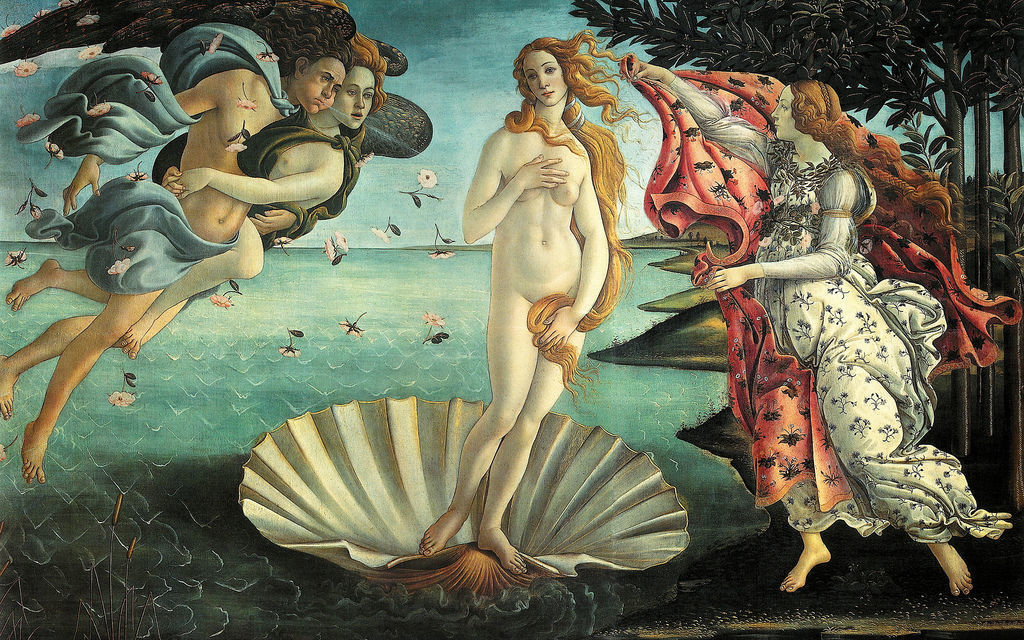
➼ The Last Supper
Details
- Painted by Leonardo da Vinci
- 1494–1498
- Made of tempera and oil,
- Found in Santa Maria delle Grazie, Milan
- Last Supper: a meal shared by Jesus Christ with his apostles the night before his death by crucifixion
Form
- Linear perspective; orthogonals of ceiling and floor point to Jesus.
- Apostles are grouped in sets of three
- Jesus is alone before a group of three windows, a symbol of the Trinity.
- A rounded pediment over Jesus’s head acts as a symbolic halo; Leonardo subtlety suggests Jesus’s divinity.
Function
- Painted for the refectory, or dining hall, of an abbey of friars.
- A relationship is drawn between the friars eating and a biblical meal.
Patronage: Commissioned by the Sforza family of Milan for the refectory of a Dominican abbey.
Materials
- Leonardo experimented with a combination of paints to yield a greater chiaroscuro.
- The paints began to peel off the wall in Leonardo’s lifetime.
- As a result, the painting has been restored many times and is a shadow of itself.
Content
- Great drama of the moment: Jesus says, “One of you will betray me” (Matthew 26:21); Jesus also blesses the bread and wine, creating a sacred Eucharist (Matthew 26:26–27).
- Various reactions on the faces of the apostles: surprise, fear, anger, denial, suspicion; anguish on the face of Jesus.
- Judas, the betrayer, falls back clutching his bag of coins; his face is symbolically in darkness.
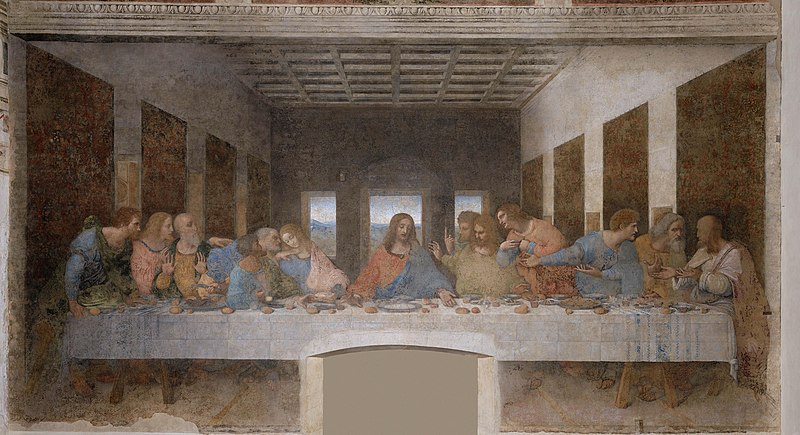
➼ Sistine Chapel ceiling
Details
- By Michelangelo
- 1508–1512
- Made of fresco
- Found in Vatican City, Italy
Form
- Masculine modeling of forms.
- Bold, direct, powerful narrative expression.
Function
- Function of the chapel: the place where new popes are elected and where papal services take place.
- Name derives from Pope Sixtus IV, who was the patron of the building’s redesign between 1473 and 1481.
Content
- Michelangelo chose a complicated arrangement of figures for the ceiling, which broadly illustrates the first few chapters of Genesis in nine scenes, with accompanying Old Testament figures and antique sibyls
- The grand and massive figures are meant to be seen from a distance, but also echo the grandeur of the Biblical narrative.
- 300 figures on the ceiling, with no two in the same pose; a tribute to Michelangelo’s lifelong preoccupation with the male nude in motion.
- Enormous variety of expression.
- Painted cornices frame groupings of figures in a highly organized way.
- Many figures are done for artistic expression rather than to enhance the narrative; the ignudi, for example.
- Ignudi: nude corner figures on the Sistine Chapel ceiling
Context
- Sistine Chapel was erected in 1472 and painted by quattrocento masters, including Botticelli, Perugino, and Michelangelo’s teacher, Ghirlandaio.
- Quattrocento paintings are of the life of Christ and the life of Moses; Michelangelo needed a different topic for the ceiling; he chose the cosmic theme of creation.
- Michelangelo’s paintings are painted over the window level of the chapel as well as the ceiling.
- The chapel is dedicated to the Virgin Mary, as such the central panel on the ceiling depicts Eve, the archetype of Mary, who, according to tradition, began the redemption necessitated by the sin of Eve and Adam.
- Acorns, a motif on the ceiling, were inspired by the crest of the chapel’s patron, Pope Julius II.
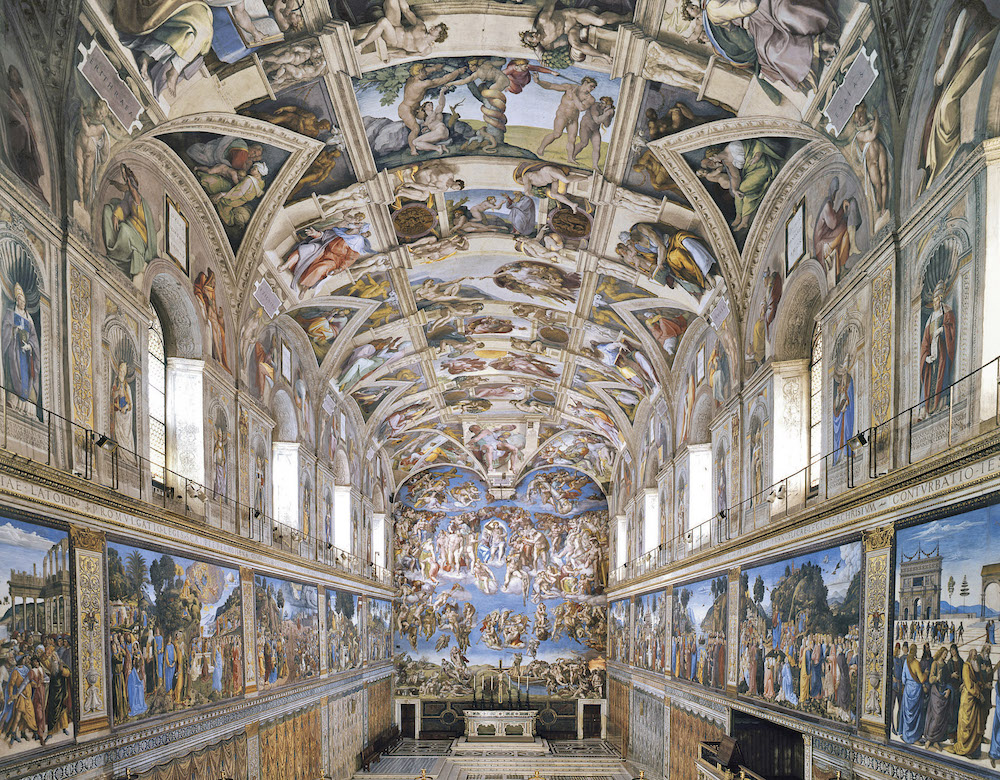
➼ The Flood
Details
- By Micheangelo
- 1508–1512
- Made of fresco
- Found in Vatican City, Italy
- Flood story: as told in Genesis 7 of the Bible, Noah and his family escape rising waters by building an ark and placing two of every animal aboard
Form
- Sculptural intensity of the figure style.
- More than 60 figures are crowded into the composition.
Function: One of the scenes on the Sistine Chapel ceiling.
Content
- Story details Noah and his family’s escape from rising floodwaters, as told in Genesis 7.
- The few remaining survivors cling to mountain tops; their fate will be sealed.
- A man carrying his drowned son to safety will meet his son’s fate as well.
- The ark in the background is the only safe haven.
- The salvation of the good (as opposed to God’s destruction of the wicked) is stressed.
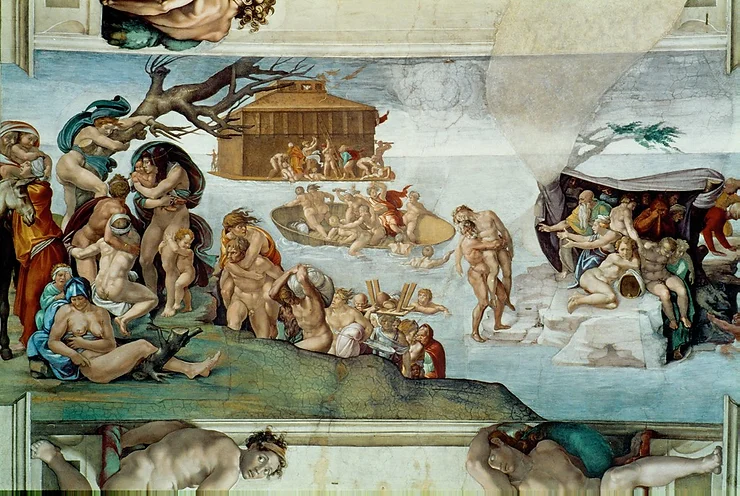
➼ Last Judgment
Details
- By Michelangelo
- 1536–1541
- Made of fresco
- Found in Vatican City, Italy
Form
- In contrast to the ceiling, there are no cornice divisions; it is one large space with figures greatly integrated.
- The Mannerist style is shown in the distortions of the body: elongations and crowded groups.
Function
- Last Judgment scenes are traditional on altar walls of chapels
- This was not the original choice of subject matter for the wall.
Patronage: Pope Paul III was the patron.
Context
- The subject was chosen because of the turbulence in Rome after the sack of the city in 1521.
- Counter-Reformation message: the true path to salvation is through the Catholic Church.
- Spiraling composition is a reaction against the High Renaissance harmony of the Sistine Ceiling and reflects the disunity in Christendom caused by the Reformation.
- In the spirit of the Counter-Reformation, the genitalia were painted over after Michelangelo’s death.
Content
- Four broad horizontal bands act as the unifying element:
- Bottom: dead rising on the left and the mouth of hell on the right.
- Second level: ascending elect, descending sinners, trumpeting angels.
- Third level: those risen to heaven are gathered around Jesus.
- Top lunettes: angels carrying the cross and the column, instruments used at Christ’s death.
- Christ, in center, gestures defiantly with right hand; complex pose.
- Justice is delivered: the good rise, the evil fall.
- Lower right-hand corner has figures from Dante’s Inferno: Minos and Charon.
- Saint Bartholomew’s face is modeled on a contemporary critic.
- Saint Bartholomew holds his skin, a symbol of his martyrdom, but the skin’s face is Michelangelo’s, an oblique reference to critics who skinned him alive with their criticism.
- It may also represent Michelangelo’s concern over the fate of his soul as expressed in his poetry.
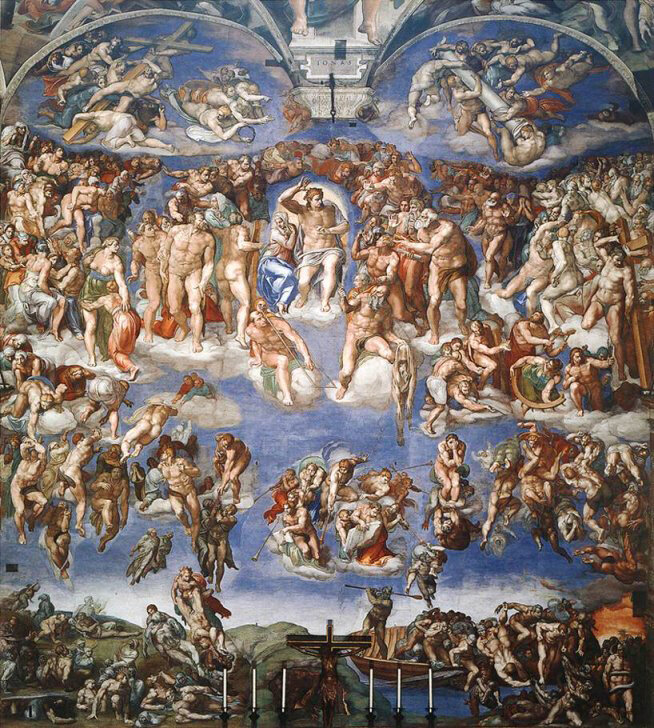
➼ School of Athens
Details
- By Raphael
- 1509–1511
- Made of fresco
- Found in Apostolic Palace, Vatican City, Italy
Form
- Open, clear light uniformly spread throughout the composition.
- Nobility and monumentality of forms parallel the greatness of the figures represented; figures gesture to indicate their philosophical thought.
- Raphael’s overall composition was influenced by Leonardo’s Last Supper
Patronage and Function
- Commissioned by Pope Julius II to decorate his library.
- This is one painting in a complex program of works that illustrate the vastness and variety of the papal library.
- Painting originally called Philosophy because the pope’s philosophy books were meant to be housed on shelving below.
Content and Context
- Opposite this work is a Raphael painting called La Disputà,
- based on religion;
- religious books were placed below;
- parallels drawn between the two themes expressed in the paintings.
- To the left of Philosophy is Apollo and the Muses on Parnassus, referencing literature.
- The building depicted in the background might reflect Bramante’s plan for Saint Peter’s; Bramante appears as the bald Euclid in the lower right.
- In the center are the two greatest figures in ancient Greek thought:
- Plato (with the features of Leonardo da Vinci) on the left pointing up, and
- Aristotle (perhaps with the features of the architect Giuliano da Sangallo) pointing out.
- Their gestures reflect their philosophies.
- On the left are those interested in the ideal (followers of Plato); on the right, those interested in the practical (followers of Aristotle).
- Raphael is on the extreme right with a black hat.
- Michelangelo, resting on the stone block writing a poem, represents the philosopher Heraclitus; the figure was added later and was not part of the original composition.
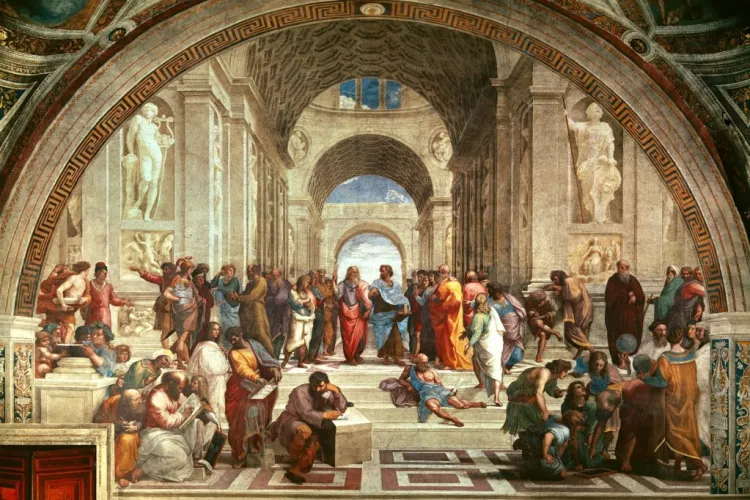
➼ Versailles
Details
- By Louis Le Vau and Jules Hardouin-Mansart
- Begun 1669
- Made of masonry, stone, wood, iron, and gold leaf; gardens
- Found in Versailles, France
Function
- This is the palace of King Louis XIV and subsequent kings and their courts.
- The palace expresses the idea of the absolute monarch; the massive scale of the project is indicative of the massive power of the king.
Form and History
- Louis XIV reorganized and remodeled an existing hunting lodge into an elaborate palace.
- The center of the building is Louis XIV’s bedroom, or audience chamber, from which all aspects of the design radiate like rays from the sun (hence Louis’ sobriquet the Sun King).
- The building is centered in a vast garden and town complex that radiated from it.
- There is a subdued exterior decoration on the façade; the undulation of projecting members is understated.
Hall of Mirrors
- 240 feet long, facing the garden façade.
- Barrel-vaulted painted ceiling (paintings stress the military victories of Louis XIV; rooms that flank the Hall of Mirrors are thematically related, one of Peace and the other War).
- Light comes in from one side and ricochets off large panes of glass, the largest that could be made at the time.
- This is an example of a use of flickering light in an architectural setting.
- Mirrors were among the most expensive items manufactured in the seventeenth century—the Hall of Mirrors is an extravagant display of wealth.
- Mirrors were made exclusively in Venice at the time; workers had to be imported from Venice to make the mirrors, which conformed to the dictates that the decorations at Versailles had to be made in France.
- Hall of Mirrors used for court and state functions: embassies, births, and marriages were celebrated in this room.
- Subsequent history:
- Used by Bismarck to declare William I as German emperor after the defeat of the French in the Franco-Prussian War in 1871.
- Used reciprocally by the French after the defeat of the Germans in World War I to sign the Treaty of Versailles in 1919.
Gardens
- Classically and harmoniously arranged.
- Formal gardens near the palace; more wooded and less elaborate plantings farther from the palace.
- Baroque characteristics:
- Large size.
- Long vistas.
- Terminal views in fountains and statuary.
- Geometric plantings show control of nature.
- A mile-long canal crossed by another canal forms the main axis of the gardens; linked to the rising sun over the palace.
- Only the fountains near the palace were turned on all the time; others were turned on only when the king progressed through the gardens.
- Illustrates the belief that humans can organize and control nature to make a more refined experience.
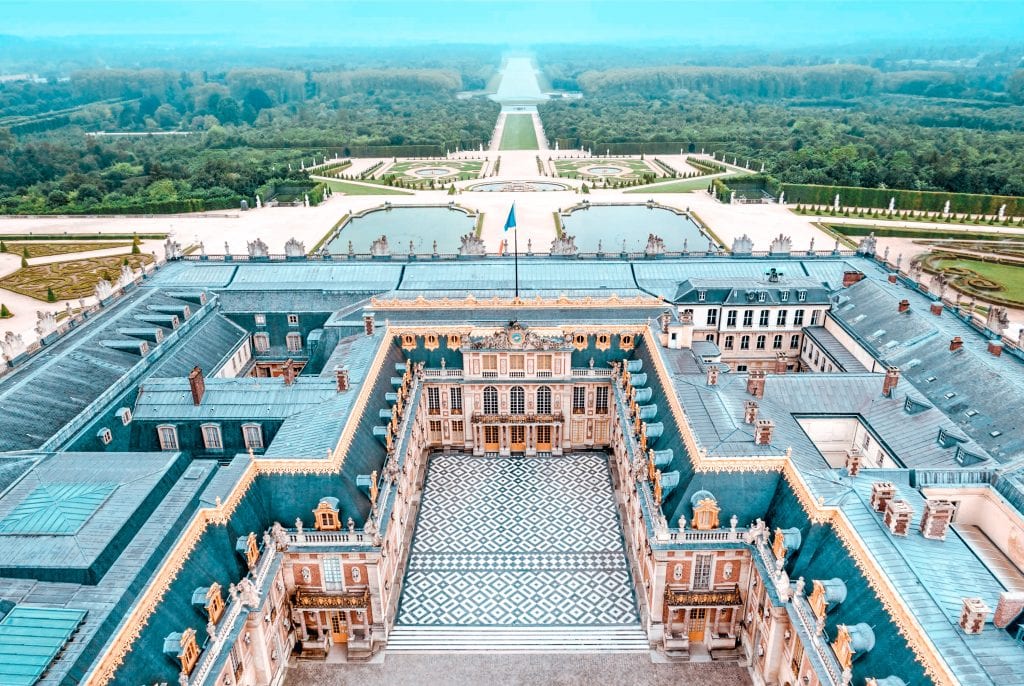
➼ Triumph of the Name of Jesus
Details
- By Giovanni Battista Gaulli
- 1676–1679
- Italian Baroque Art
- Made of fresco and stucco
- Found in Il Gesù, Rome
Form and Content
- On the ceiling in the main nave of Il Gesù, Rome
- In the center is the monogram of Jesus, IHS, in a brilliant sea of golden color.
- Figures tumble below the name; some are carved in stucco and enhance the three-dimensional effect.
- Some cast long shadows across the barrel vault.
- Some painted figures are not stucco, but maintain a vibrant three-dimensional illusion.
- It is as if the ceiling were opened to the sky and the figures are spiraling around Jesus’s name.
- Depicted in the center are holy men and women.
- Around the rim are priests, soldiers, noblemen, and the Magi.
- Allegories of avarice, simony, heresy, and vanity occupy the lowest registers.
- Di sotto in sù: a type of ceiling painting in which the figures seem to be hovering above the viewers, often looking down at us
Function
- A Last Judgment scene, placed over the barrel vault of the nave; cf. Last Judgment scenes placed on the walls of chapels.
- Message to the faithful: the damned are cast into hell; the saved rise heavenward.
Context
- Inspired by Saint Paul’s epistle to the Philippians 2:10: “That at the name of Jesus every knee should bow, of things in heaven, and things in earth, and things under the earth.”
- There is the influence of Bernini’s dramatic emotionalism in the style; Gaulli was Bernini’s pupil.
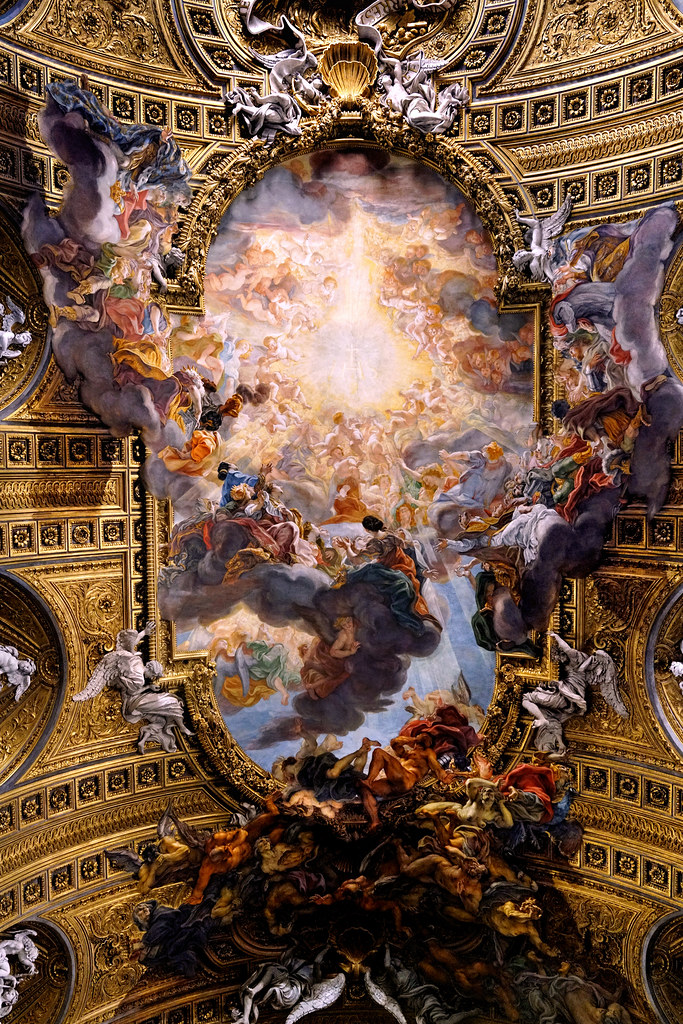
➼ Las Meninas
Details
- By Diego Velázquez
- 1656
- Spanish Baroque Art
- Made of oil in canvas
- Found in Prado, Madrid
Content
- Portrait of the artist in his studio at work; he steps back from his very large canvas and looks at the viewer.
- Central is the Infanta Margharita of Spain with her meninas (attendants), a dog, a dwarf, and a midget. Behind are two chaperones in half-shadow. In the doorway is perhaps José Nieto, who was head of the queen’s tapestry works (hence his hand on a curtain).
- The king and queen appear in a mirror. But what is the mirror reflecting?
- Velázquez’s canvas?
- The king and queen perhaps standing in the viewer’s space—is this why people have turned around?
- Or is it reflecting a painting of the king and queen on the far wall of the room?
- What is the painter painting?
- The royal family?
- The Infanta?
- A painting of this painting?
- Us?
- Ultimately, there is no answer, which expresses the Baroque fascination with exploring reality.
Form
- Alternating darks and lights draw the viewer deeper into the canvas; the mirror simultaneously reflects out into the viewer’s space.
- Dappled effect of light on shimmering surfaces.
- Painterly brushstrokes seen in the sleeves of the Infanta and the hands of the artist.
Function: Painting originally hung in King Philip IV’s study.
Context
- Velázquez wears the cross of the Royal Order of Santiago, which elevated him to knighthood; this work seeks to establish painting as a noble occupation.
- Paintings on the back wall depict Minerva, goddess of wisdom and patroness of the arts.
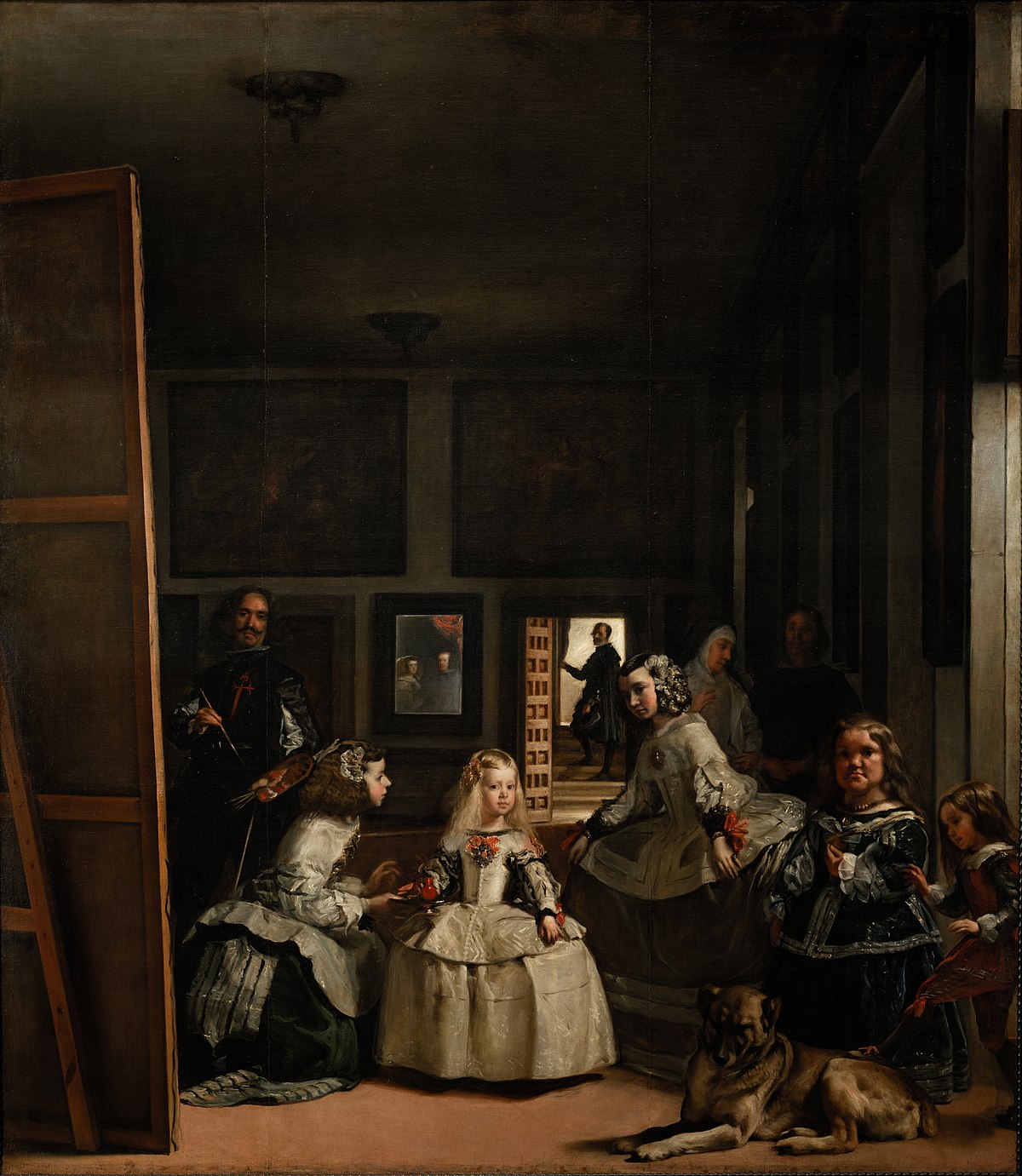
➼ Marie de’ Medici Cycle
Details
- By Peter Paul Rubens
- 1621-1625
- Flemish Baroque Art
- Made of oil in canvas
- Found in Louvre, Paris
Form
- Heroic gestures, demonstrative spiraling figures.
- Mellow intensity of color, inspired by Titian and Caravaggio.
- Sumptuous full-fleshed women.
- Splendid costumes suggest an opulent theatrical production.
- Allegories assist in telling the story and mix freely with historical people.
Function and Context
- 24 huge historical paintings allegorically retelling the life of Marie de’ Medici, queen of France, wife of King Henry IV; the series also contains three portraits.
- Commissioned by Marie de’ Medici, at the time the widow of Henry IV.
- The series was placed in Marie de’ Medici’s home in Paris, the Luxembourg Palace.
Henri IV Receives the Portrait of Marie de’ Medici
- Henry IV is smitten by the portrait of his intended; the portrait is the center of a swirling composition.
- The portrait is held by Cupid (the god of love) and Hymen (the god of marriage).
- Mythological gods Jupiter (symbolized by an eagle) and Juno (symbolized by a peacock) look down from below; they are symbolic of marital harmony. They express their support.
- Royalty was considered demigods; the approval of mythological gods is in concert with their beliefs about themselves.
- This represents the tradition of portraits being exchanged before the marriage.
- They were actually married by proxy in 1600.
- Behind Henry is the personification of France: –France is a female figure with a masculine helmet and manly legs. –She whispers to Henry to choose love over war.
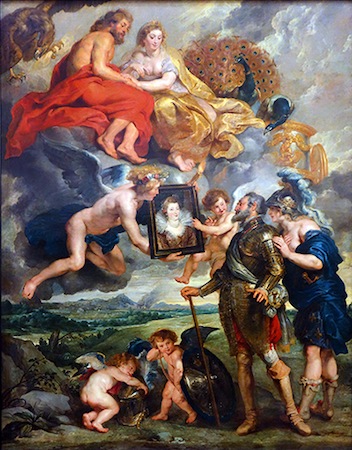
➼ Self-Portrait with Saskia
Details
- By Rembrandt
- 1636
- Dutch Baroque Art
- Made of oil in canvas
- Found in Art Institute of Chicago, Chicago, Illinois
Content
- Rembrandt is seen drawing or perhaps making an etching.
- Saskia is seated deeper into the work, but is very noticeable because she is portrayed with a lighter touch.
Function: Not for general sale but for private purposes.
Context
- The scene depicts the 30-year-old Rembrandt with his new bride.
- This is the only image of Rembrandt with his wife together in an etching.
- Images of Saskia are abundant in Rembrandt’s output; she was a source of inspiration for him.
- Marital harmony; Saskia as a muse who inspires him.
- Characteristic of Rembrandt: they are wearing fanciful, not contemporary, dress.
- Saskia was the mother of four.
- Rembrandt’s self-portraits included 50 paintings, 32 etchings, and 7 drawings.
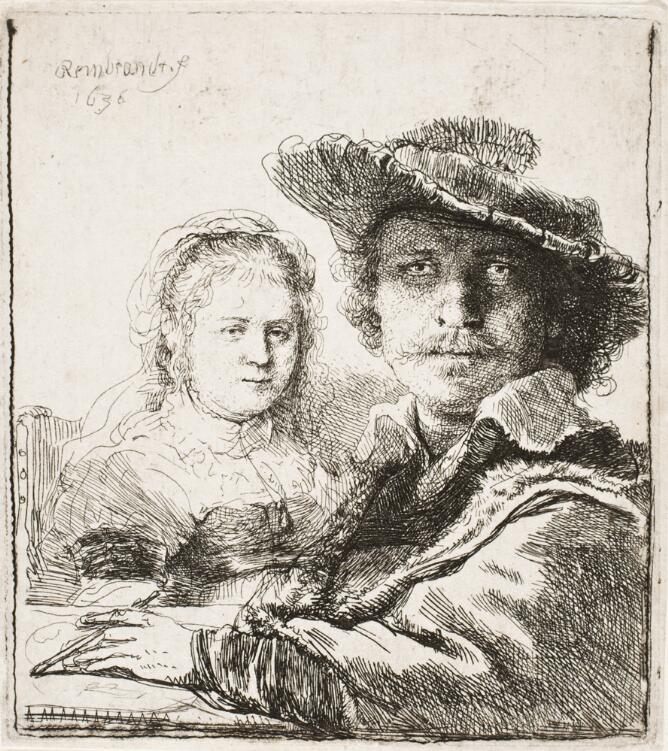
➼ Woman Holding a Balance
Details
- By Johannes Vermeer
- c. 1664
- Dutch Baroque Art
- Made of oil in canvas
- Found in National Gallery of Art, Washington
Form and Content
- Light enters from the left, illuminating the figures and warmly highlighting textures and surfaces: the woman’s garments, wooden table, marble checkerboard floor, jewelry, the painting, etc.
- A moment in time: stillness and timelessness.
- The woman is dressed in fine, fur-trimmed clothing.
- Geometric lines focus on a central point at the pivot of the balance.
- The figure seems unaware of the viewer’s presence.
- Her pensive stillness suggests she may be weighing something more profound than jewelry.
Context
- A small number of Vermeer works are in existence.
- Except for two landscapes, Vermeer’s works portray intimate scenes in the interior of Dutch homes.
- The viewer looks into a private world in which seemingly small gestures take on a significance greater than what first appears.
- A family member may have posed for the painting, perhaps Vermeer’s wife, Caterina.
Theories
- Is it a genre scene or an allegory? Or both?
- A moment of weighing and judging.
- In the background is a painting of the Last Judgment, a time of weighing souls:
- The woman is at a midpoint between earthly jewels and spiritual goals such as meditation and temperance.
- The balance (scale) has nothing in it; pearls and coins on the table waiting to be measured; may be symbolic of a balanced state of mind.
- The balancing reference perhaps relates to the unborn child.
- This is Catholic subject matter in a Protestant country; Vermeer and his family were Catholic.
- Vanitas painting: gold should not be a false allure.
- Vermeer may have used a camera obscura.
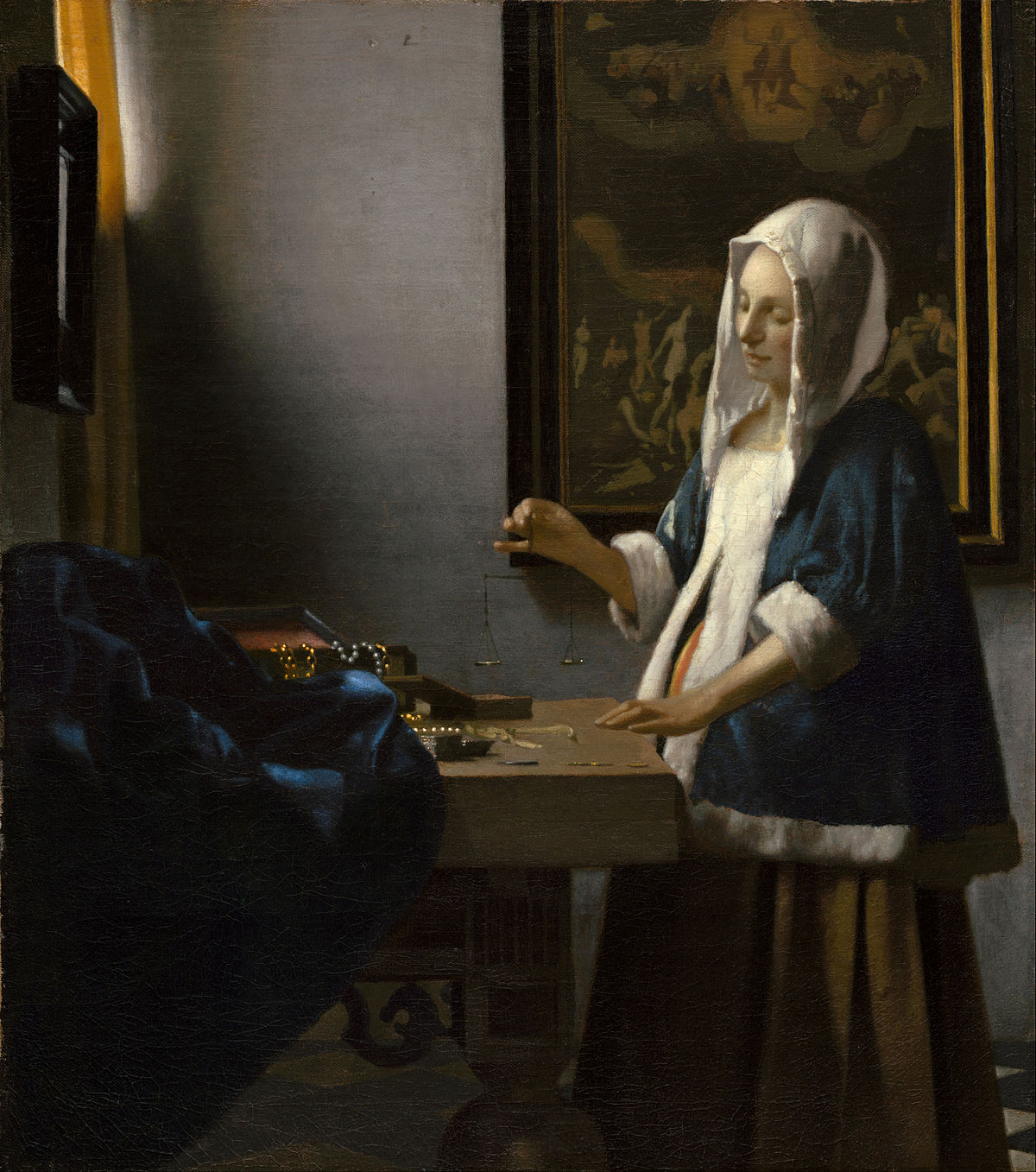
➼ Fruit and Insects
Details
- By Rachel Ruysch
- c. 1664
- Dutch Baroque Art
- Made of oil in wood
- Found in Uffizi, Florence
Form
- Asymmetrical, artful arrangement.
- A finely detailed illustration of natural objects in a rural setting.
Content
- Not a depiction of actual flowers, but a construct of perfect specimens all in bloom at the same time.
- The artist probably used illustrations in botany textbooks as a basis for the painting.
- Wheat and grapes juxtaposed: may have been a reference to the Eucharist.
Context
- The artist’s father was a professor of anatomy and botany as well as an amateur painter.
- The artist produced a number of such still lifes in woodland settings.
- Parallels Dutch interest in botany, and the growing of flowers for decorative and medicinal purposes.
- Flowers were symbols of wealth and status.
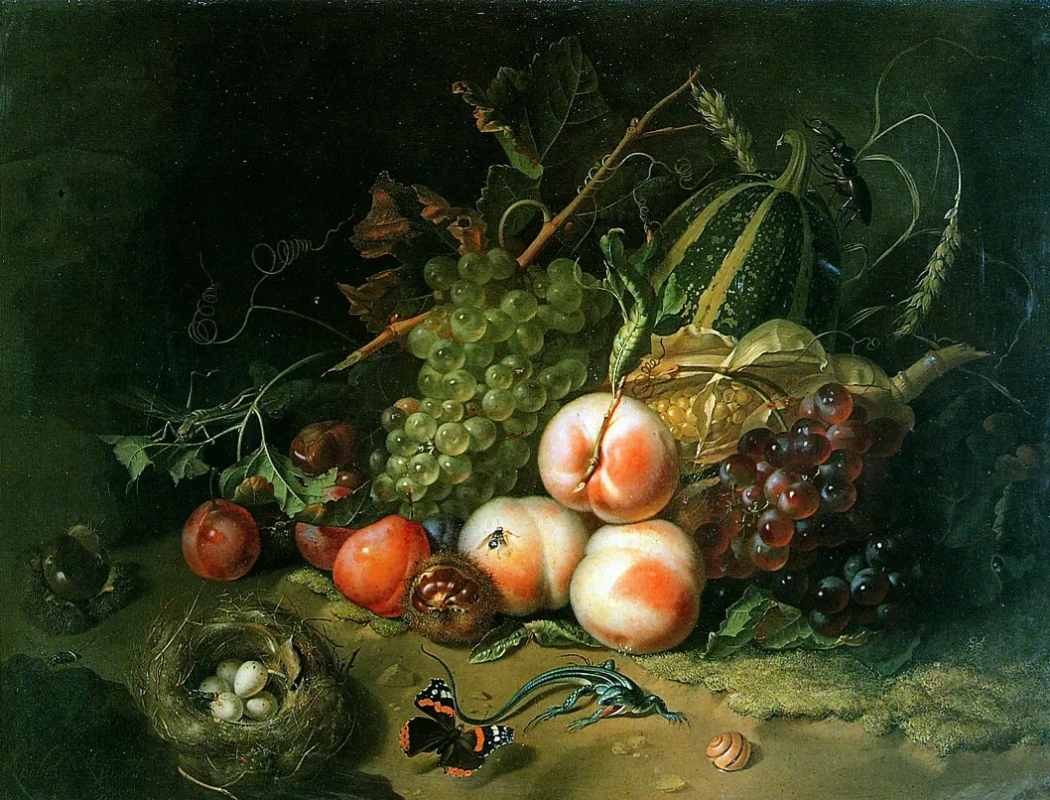
Unit 4: Later Europe and Americas, 1750–1980 CE
Key Movements of Later Europe and Americas Art
The Enlightenment (1715 – 1789)
- During the Enlightenment, intellectuals and other thinkers began to see ancient concepts from a fresh viewpoint and advocated skepticism, the study of science, and reasoning over superstition.
- A greater emphasis was placed on individualism and religion (separate from religion). When painters were no longer limited to religious forms, the subject matter of artwork began to change.
- This age witnessed a growing appreciation for the natural world.
- This paved the way for the creation of numerous new artistic trends and genres.
French Revolution (1789-1799)
- People revolted at the unequal treatment of the Third Estate (commoners) by the government, persistent food shortages, and financial distress after fighting in the American Revolution.
- Symbolism in a number of paintings expressed political opinions and conveyed political messages about the current events.
- Romanticism, which concentrated on emotion and expressed the sublime, was one of the aesthetic trends that followed the French Revolution.
Publishing of the Communist Manifesto (1848)
- The Communist Manifesto was written by Karl Marx and Friedrich Engels in 1848.
- It was first published in German in London.
- This was commissioned by the Communist League, a political organization that sought to unite various socialist groups.
- The text outlines the principles of communism and critiques capitalism.
- The Manifesto argues that the history of society is a history of class struggle, and that the proletariat (working class) will eventually overthrow the bourgeoisie (capitalist class).
- The Manifesto had a significant impact on political and social movements around the world, and is considered one of the most influential political texts in history.
Revolutions of 1848
- The Revolutions of 1848 were a series of political uprisings across Europe.
- They were sparked by economic hardship, political repression, and demands for greater democracy and national unity.
- The revolutions began in France in February 1848 and quickly spread to other countries including Germany, Italy, and Austria-Hungary.
- Many of the revolutions were ultimately unsuccessful, with conservative forces reasserting control in most countries by the end of the year.
- The revolutions did lead to some important reforms, such as the abolition of serfdom in Austria-Hungary and the establishment of a constitutional monarchy in France.
Perry Expedition and the Forced Opening of Japan (1853-1868)
- Perry Expedition occurred between 1853-1854
- Led by Commodore Matthew Perry of the United States Navy
- Goal was to establish diplomatic relations with Japan and open trade
- Japan had been isolated from the rest of the world for over 200 years
- Negotiations were difficult due to language and cultural barriers
- Treaty of Kanagawa was signed in 1854, allowing American ships to refuel and resupply in two Japanese ports
- This forced Japan to open up to the world and establish trade relations with other countries
World Wars I and II (1914-1945)
- Both World Wars I and II had a profound impact on global economy, populations, and the environment.
- Like to earlier wars in history, art from World War I and World War II contains messages about the political and social climate.
- In particular, World War I gave rise to artistic styles such as Surrealism (abstract form intended to perplex the observer) and Expressionism (work that conveyed the creators' inner sentiments).
The Harlem Renaissance (1920s-1930s)
- The Harlem Renaissance was a cultural movement that took place in the 1920s and 1930s in Harlem, New York City.
- It was also known as the "New Negro Movement" and was characterized by a celebration of African American culture, art, music, and literature.
- The movement was fueled by the Great Migration, which brought thousands of African Americans from the South to the North in search of better opportunities.
- Prominent figures of the Harlem Renaissance include Langston Hughes, Zora Neale Hurston, Duke Ellington, and Louis Armstrong.
- The movement had a significant impact on American culture and helped to break down racial barriers and stereotypes.
Interactions Within and Across Cultures in Later European and American Art
- Influences of Non-Western Cultures
- Non-Western cultures, such as African, Asian, and Native American, influenced later European and American art.
- Artists were fascinated by the exoticism and spirituality of these cultures.
- They incorporated non-Western motifs, patterns, and techniques into their works.
- Influences of Eastern Cultures
- Eastern cultures, such as Japanese and Chinese, also influenced later European and American art.
- Artists were attracted to the simplicity, elegance, and harmony of these cultures.
- They adopted Eastern techniques, such as woodblock printing and calligraphy, and incorporated them into their works.
- Influences of Other Western Cultures
- Western cultures also influenced later European and American art.
- Artists were inspired by the art of their contemporaries and predecessors from other Western countries.
- They borrowed styles, techniques, and themes from these artists.
Artistic Movements of Later Europe and Americas Art
- Rococo (1700-1750 CE)
- Rococo art, which emerged in Europe between 1700 and 1750 CE, was characterized by its ornate and decorative style.
- Techniques and processes used in Rococo art included delicate brushwork, pastel colors, and asymmetrical compositions.
- Audience was primarily the aristocracy and wealthy bourgeoisie, who commissioned works for their homes and palaces.
- Interpretations vary, but it is often seen as a reflection of the hedonistic and pleasure-seeking culture of the time.
- Purpose was to create a sense of luxury and opulence, and to showcase the wealth and status of the patrons who commissioned the works.
- Neoclassicism (1750-1830)
- A revival of classical art and architecture, characterized by a focus on simplicity, order, and rationality.
- Techniques included drawing, painting, and sculpture.
- The audience was mainly the aristocracy and the bourgeoisie.
- The purpose was to promote the values of reason, order, and patriotism.
- Romanticism (1780-1850)
- An artistic and literary movement that emphasized emotion, imagination, and individualism.
- Techniques included painting, literature, and music.
- The audience was mainly the middle class.
- The purpose was to express personal feelings and emotions, and to critique society.
- Realism (1848-1900)
- An artistic movement that aimed to represent reality as it is, without idealization or exaggeration.
- Techniques included painting, sculpture, and photography.
- The audience was mainly the working class.
- The purpose was to expose social and political issues, and to promote social change.
- Impressionism (1860-1890)
- An artistic movement that aimed to capture the fleeting effects of light and color.
- Techniques included painting and drawing.
- The audience was mainly the middle class.
- The purpose was to capture the beauty of everyday life, and to challenge traditional art forms.
- Post-Impressionism (1880s-1890s)
- Emphasized the use of color and form to express emotions and ideas.
- Artists used techniques such as pointillism and bold brushstrokes to create a sense of movement and energy in their works.
- The purpose of Post-Impressionism was to move beyond the limitations of Impressionism and create a more personal and expressive form of art.
- Symbolism (1890s)
- Focused on the use of symbols and metaphors to convey deeper meanings and emotions.
- Artists used techniques such as exaggeration and distortion to create a dreamlike or mystical atmosphere in their works.
- The purpose of Symbolism was to explore the inner world of the human psyche and express the mysteries of the universe.
- Art Nouveau (1890s-1914)
- Emphasized the use of organic forms and decorative motifs inspired by nature.
- Artists used techniques such as curvilinear lines and asymmetrical shapes to create a sense of fluidity and movement in their works.
- The purpose of Art Nouveau was to create a new style that was both beautiful and functional, and to break away from the rigid forms of traditional art.
- The Prairie Style (1900-1930s)
- Emphasized the use of simple, geometric forms and natural materials such as wood and stone.
- Architects used techniques such as horizontal lines and open floor plans to create a sense of harmony and integration with the surrounding landscape.
- The purpose of the Prairie Style was to create a new form of architecture that was both functional and aesthetically pleasing, and to reflect the values of the American Midwest.
- Fauvism (1905-1908)
- Emphasized the use of bold, bright colors and simplified forms to create a sense of energy and emotion in their works.
- Artists used techniques such as thick brushstrokes and simplified shapes to create a sense of spontaneity and immediacy in their works.
- The purpose of Fauvism was to break away from the traditional forms of art and create a new form of expression that was both vibrant and emotional.
- Expressionism (1905-1925)
- An artistic movement that aimed to express subjective emotions and experiences. Techniques included painting, literature, and theater.
- The audience was mainly intellectuals and artists.
- The purpose was to challenge traditional art forms, and to express the anxieties and fears of modern life.
- Cubism (1907-1930s)
- Emphasized geometric shapes and multiple perspectives.
- Its purpose was to break away from traditional art and create a new visual language.
- The audience was primarily other artists and intellectuals.
- Constructivism (1914-1920s)
- Focused on the use of industrial materials and emphasized the importance of function over form.
- Its purpose was to create art that served a social purpose and could be used in everyday life.
- The audience was the working class and the goal was to inspire social change.
- Dada (1915-1922)
- Rejected traditional art and embraced absurdity and nonsense.
- Its purpose was to challenge societal norms and values.
- The audience was primarily other artists and intellectuals.
- DeStijl (1917-1930s)
- Emphasized simplicity and abstraction, using only primary colors and straight lines.
- Its purpose was to create a universal language of art that could be understood by all.
- The audience was artists and designers.
- The International Style (1920s-1930s)
- An architectural movement that emphasized functionality and minimalism.
- Its purpose was to create buildings that were efficient and could be mass-produced.
- The audience was architects and designers.
- The Harlem Renaissance (1920s-1930s)
- A cultural movement that celebrated African American art, literature, and music.
- Its purpose was to challenge racial stereotypes and promote African American culture.
- The audience was primarily African Americans.
- Mexican Muralists (1920s-1930s)
- Used large-scale murals to promote social and political messages.
- Its purpose was to educate the public and inspire social change.
- The audience was the general public.
- Surrealism (1920-1960)
- An artistic movement that aimed to explore the subconscious mind and the irrational.
- Techniques included painting, sculpture, and literature.
- The audience was mainly intellectuals and artists.
- The purpose was to challenge rationality and conventional morality, and to explore the mysteries of the human psyche.
- Abstract Expressionism/The New York School (1940s-1950s)
- Used large canvases, gestural brushstrokes, and unconventional tools. The process of creating the artwork was as important as the final product.
- Audience was primarily other artists, critics, and collectors. Interpretations varied, with some seeing it as a reaction against formalism and others as a reflection of post-World War II anxiety.
- Purpose was to create a new form of art free from traditional constraints and express innermost emotions and ideas.
- Pop Art (1950-1980)
- An artistic movement that celebrated popular culture and consumerism.
- Techniques included painting, sculpture, and graphic design.
- The audience was mainly the middle class.
- The purpose was to critique mass media and consumer culture, and to blur the boundaries between high and low art.
- Color Field Painting (1960s)
- Abstract painting style using large areas of flat color to create depth. Paint applied in multiple layers.
- Primarily for art collectors and museums.
- Reaction against gestural brushwork of Abstract Expressionism.
- Goal was to create an immersive experience for the viewer.
- Happenings (1960s)
- Performance art that was spontaneous and unscripted. Included music, dance, and multimedia elements.
- Aimed at young, countercultural crowds.
- Meant to break down boundaries between art and life.
- Goal was to create a sense of community and shared experience.
- Site Art (1970s-1990s)
- Art movement that created site-specific works.
- Techniques included sculpture, installation, and environmental art.
- Audience was often the general public in public spaces.
- Goal was to engage with the environment and challenge traditional notions of art.
- Aimed to create a sense of place and dialogue between art and the natural world.
Later Europe and Americas Artworks
➼ Portrait of Sor Juana Inés de la Cruz
Details
- By Miguel Cabrera
- 1750
- Made oil on canvas
- Found in Museo Nacional de Historia, Castillo de Chapultepec, Mexico
Function
- Many portraits survive, but all images derive from a now-lost self-portrait.
- Painting was done for her admirers 55 years after Sor Juana Inés’s death.
Content
- Portrayed seated in her library surrounded by symbols of her faith and her learning.
- She wears the habit of the religious order of the Hermits of Saint Jerome nuns of Mexico City; the habit includes the escudo—a framed vellum painting.
- Painting may have been inspired by the image of Saint Jerome seated at a desk.
- Escudo: a framed painting worn below the neck in a colonial Spanish painting
Context
- Sor Juana Inés (Sister Juana Agnes), a child prodigy (1651–1695).
- She was a criollo woman who became a nun in 1669.
- A feminist culture survived in Mexican convents, where privileged nuns could live in comfort with servants and households.
- Sor Juana was a literary figure who wrote books that were widely read; she also wrote poetry and theatrical pieces, and maintained a great library.
- Sor Juana was instrumental in giving girls an education in a male-dominated world.
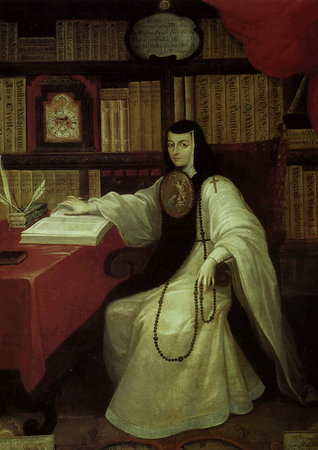
➼ The Swing
Details
- By Jean-Honoré Fragonard
- 1767
- Made of oil on canva
- Found in Wallace Collection, London
Form
- Pastel palette; light brushwork.
- Figures are small in a dominant garden-like setting.
- Use of atmospheric perspective.
- Puffy clouds; rich vegetation; abundant flowers; sinuous curves.
- Symbolically a dreamlike setting.
Patronage and Content
- Commissioned by an unnamed “gentleman of the Court:” a painting of his young mistress on a swing; in an early version, a bishop is pushing the swing with the gentleman admiring his mistress’s legs from below.
- In the finished painting, the older man is no longer a priest, a barking dog has been added, and Falconet’s sculpture of Menacing Love comments on the story.
- The patron in the lower left looks up the skirt of a young lady who swings flirtatiously, boldly kicking off her shoe at a sculpture.
- The dog in the lower right corner, generally seen as a symbol of fidelity, barks in disapproval at the scene before him.
Context
- Fragonard answers the libertine intentions of his patron by painting in the Rococo style.
- Fragonard often used different styles at the same time, and he seems to have seen the Rococo as particularly appropriate for an erotic scene.
- An intrigue painting; the patron hides in a bower; the garden sculpture of Menacing Love asks the lady to be discreet and may be a symbol for the secret hiding of the patron.
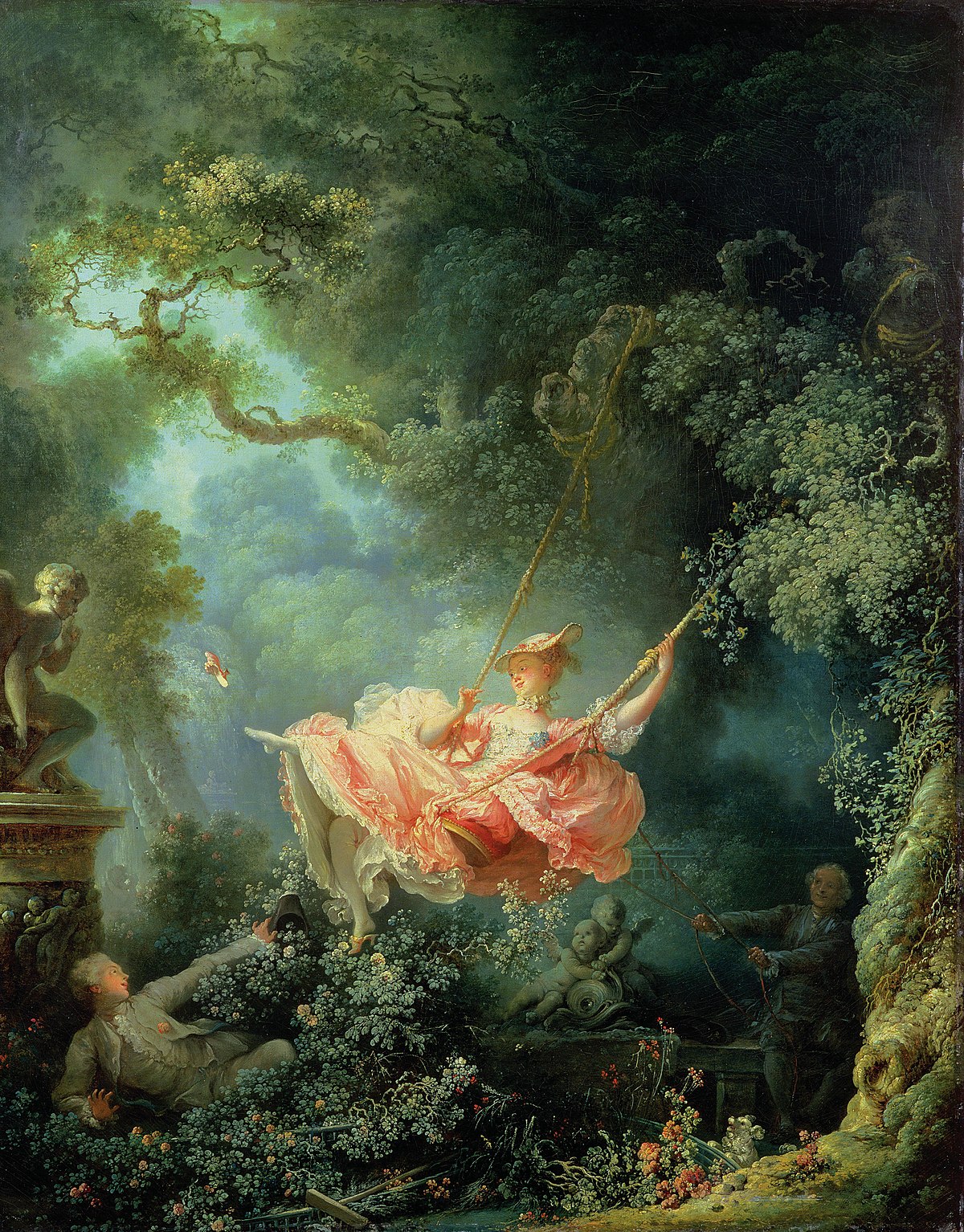
➼ Still Life in Studio
Details
- By Louis-Jacques-Mande Daguerre
- 1837
- Daguerreotype
- French Photographic Society, Paris
Form
- Photograph reproduces a variety of textures: fabric, wicker, plaster, framed print, etc.
- Inspired by painted still lifes, such as vanitas paintings.
Context
- New art form proclaimed while referencing older art forms.
- Daguerreotypes have a shiny surface and a sharp eye for detail.
- No negative; therefore, copies could not be made.
- Long exposure times required.
- Produced on a metallic surface; photos have a glossy finish.
➼ Starry Night
Details
- By Vincent van Gogh
- 1889
- Oil on canvas
- Found in Museum of Modern Art, New York
Form
- Thick, short brushstrokes.
- Heavy application of paint called impasto.
- Parts of the canvas can be seen through the brushwork; artist need not fill in every part of the surface.
- Strong left-to-right wave-like impulse in the work broken only by the tree and the church steeple.
- The tree looks like green flames reaching into a sky that is exploding with stars over a placid village.
Context
- The mountains in the distance are the ones that Van Gogh could see from his hospital room in Saint-Rémy; steepness exaggerated.
- Combination of images: Dutch church, crescent moon, Mediterranean cypress tree.
- Cypresses were often associated with cemeteries.
- Landscape painting was popular in the late nineteenth century as a reaction to the industrialization of cities.

➼ The Scream
Details
- By Edvard Munch
- 1893
- Tempera and pastels on cardboard
- Found in National Gallery, Oslo
Form and Content
- The figure walks along a wharf; boats are at sea in the distance.
- Long, thick brushstrokes swirl around the composition.
- The figure cries out in a horrifying scream; the landscape echoes his emotions.
- Discordant colors symbolize anguish.
- Emaciated, twisting stick figure with skull-like head.
Function: Painted as part of a series called The Frieze of Life; a semi autobiographical succession of paintings.
Context
- Said to have been inspired by an exhibit of a Peruvian mummy in Paris.
- The work prefigures Expressionist art.
- The work is influenced by Art Nouveau swirling patterns.
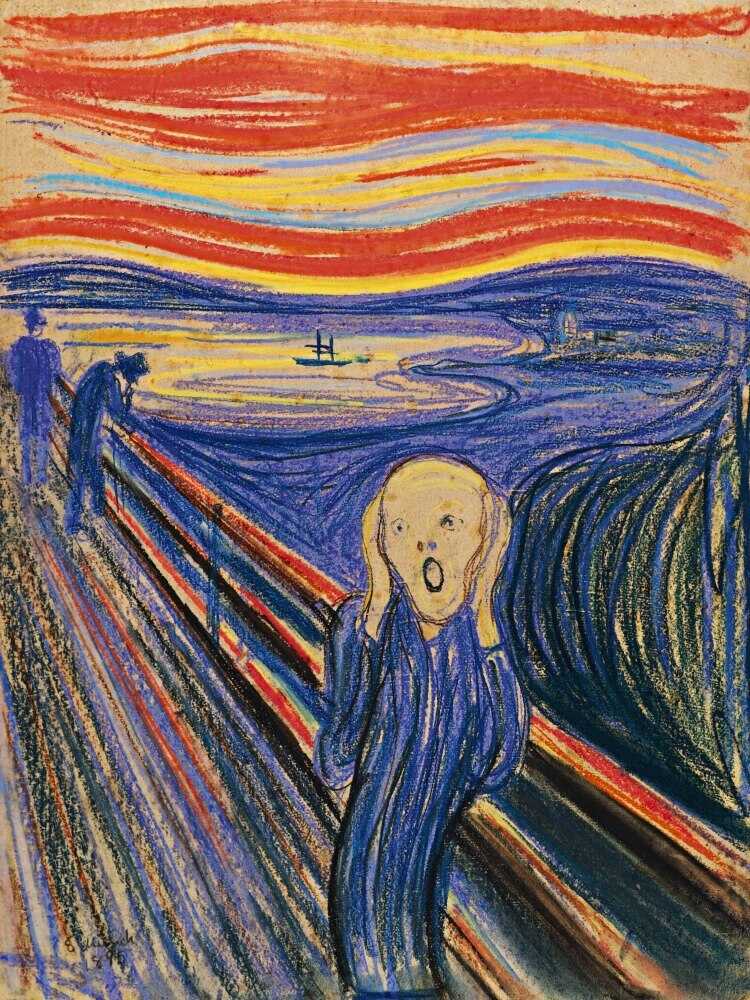
➼ The Kiss
Details
- By Gustav Klimt
- 1907–1908
- Oil and gold leaf on canvas
- Found in Austrian Gallery, Vienna
Form
- Little of the human form is actually seen: two heads four hands, two feet.
- The bodies are suggested under a sea of richly designed patterning.
- The work is spaced in an indeterminate location against a flattened background.
Context
- The male figure is composed of large rectangular boxes; the female figure is composed of circular forms.
- The work suggests all-consuming love; passion; eroticism.
- The use of gold leaf is reminiscent of Byzantine mosaics
- The work is influenced by gold applied to medieval illuminated manuscripts.
- Part of a movement called the Vienna Succession, which broke away from academic training in schools at that time.
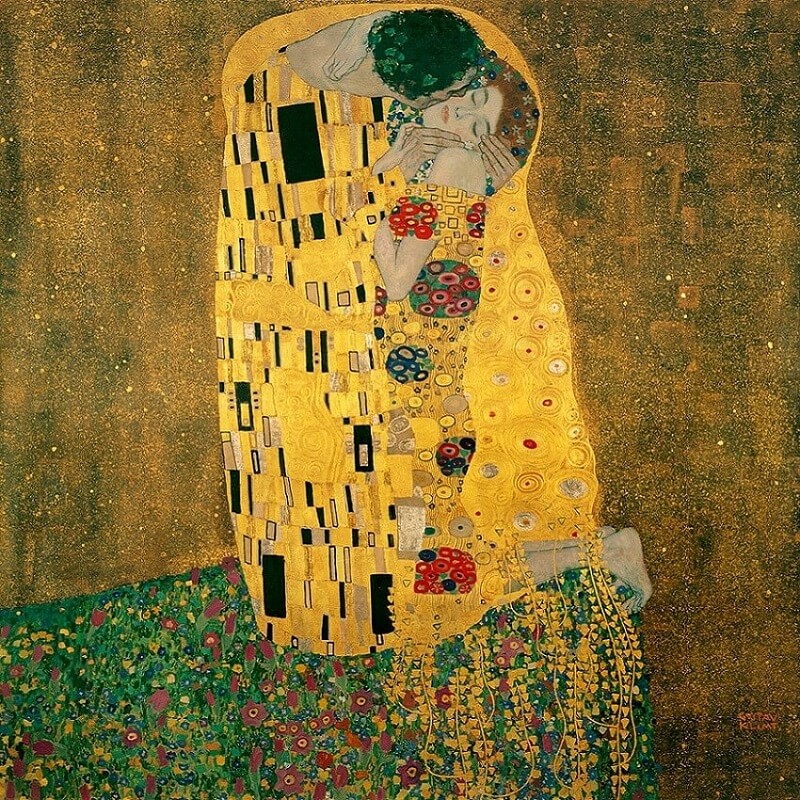
➼ Louis Sullivan, Carson, Pirie, Scott and Company Building
Details
- 1899–1903
- Iron, steel, glass, and terra cotta
- Found in Chicago
Form
- Horizontal emphasis on the exterior mirrors the continuous flow of floor space on the interior.
- The exterior is covered in decorative terra cotta tiles; original interior ornamentation elaborately arranged around lobby areas, hallways, elevator; interior ornamentation now lost.
- The architect designed maximum window areas to admit light, but also to make displays visible from the street.
- Nonsupportive role of exterior walls; held up by an interior framework.
- Open ground plan allows for free movement of customers and goods.
Function: A department store on a fashionable street in Chicago.
Context
- Some historical touches exist in the round entrance arches and the heavy cornice at the top of the building.
- Cast iron decorative elements transformed the store into a beautiful place to buy beautiful things.
- Shows the influence of Art Nouveau in decorative ironwork on the entrance.
- Sullivan motto: “Form follows function.”

➼ Goldfish
Details
- By Henri Matisse
- 1912
- Oil on canvas
- Formerly in Pushkin Museum of Art, Moscow, Russia
Form
- Strong contrasts of color.
- Thinly applied colors; the white of the canvas shows through.
- Energetic, painterly brushwork.
- Broad patches of color anticipate color-field painting later in the century.
Content
- Still-life painting.
- Compare to Ruysch, Fruits and Insects, and Daguerre, Still Life in Studio.
Context
- May have been in response to a trip in Morocco, where Matisse noted how the local population would daydream for hours, gazing into goldfish bowls. Form, color, and subject matter were inspired by this trip.
- Admired the relaxed and contemplative lifestyle of the Moroccans, which symbolized a meditative state of mind and a sense of paradise lost to Europeans.
- May have been influenced by the decorative quality of Asian art and diverse cultures from North Africa.
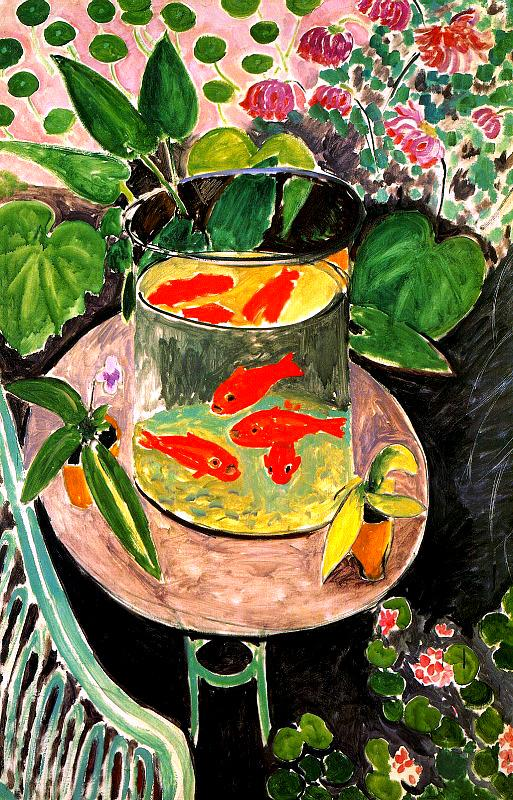
➼ Improvisation 28 (2nd Version)
Details
- By Vassily Kandinsky
- 1912
- Oil on canvas
- Found in Guggenheim Museum, New York
Form
- Strongly articulated use of black lines.
- Colors seem to shade around line forms.
Content
- Using schematic means, Kandinsky depicts cataclysmic events on the left (boat and waves—a deluge, a serpent, a cannon) and a sense of spiritual salvation on the right (a couple embrace, a candle, a church on a hill).
Context
- Kandinsky wanted the viewer to respond to a painting the way one would to an abstract musical composition: a concerto, a sonata, a symphony.
- The artist felt that sound and color were linked; for example, it was possible to hear color.
- He used words such as “composition” and “improvisation” in the titles of his works, words associated with musical composition.
- Kandinsky’s works have a relationship to atonal music, which was evolving at this time.
- Movement toward abstraction; representational objects suggested rather than depicted.
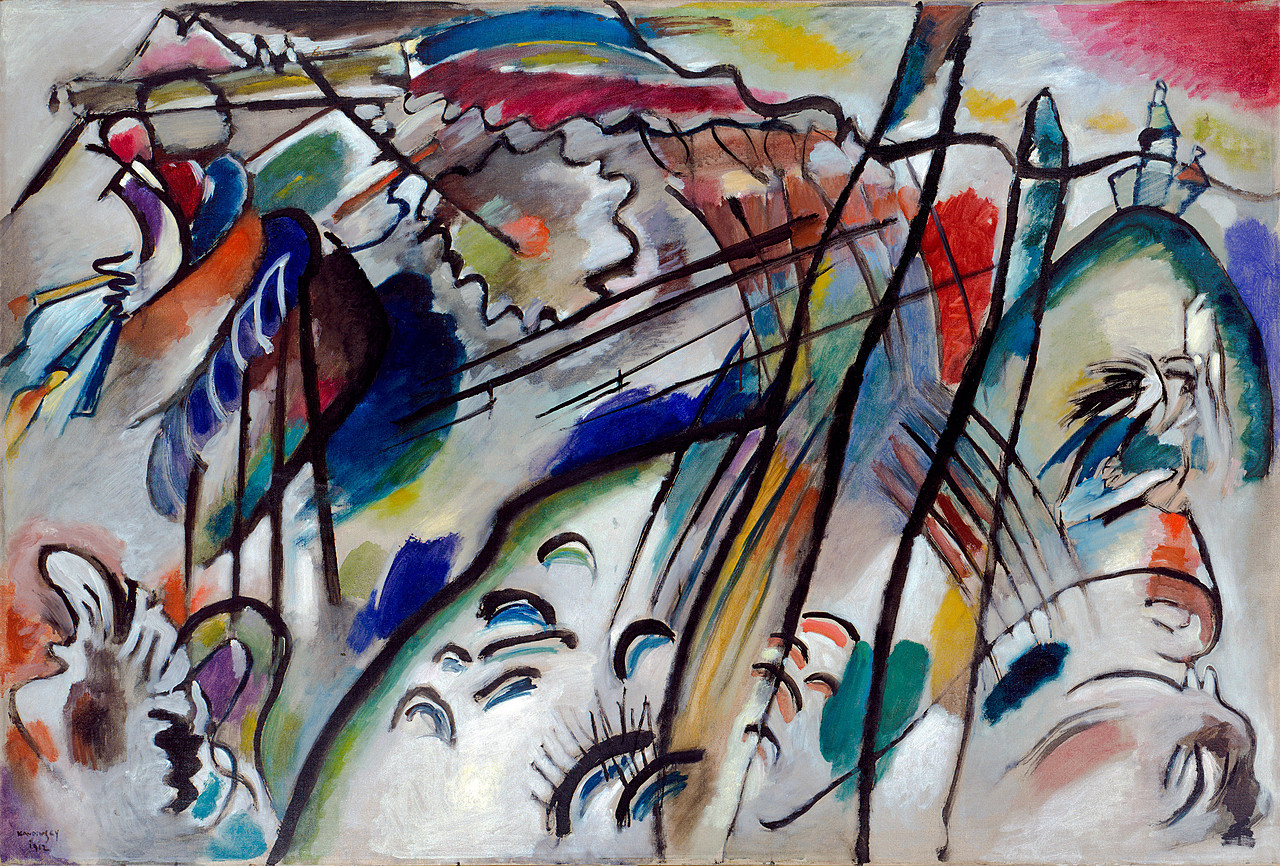
➼ Les Demoiselles d’Avignon
Details
- By Pablo Picasso
- 1907
- Oil on canvas
- Found in Museum of Modern Art, New York
Content
- Depicts five prostitutes in a bordello in Avignon Street in Barcelona, each posing for a customer.
- Poses are not traditionally alluring but awkward, expressionless, and uninviting.
Form
- The three on the left are more conservatively painted; the two on right more radical; reflects a dichotomy in Picasso.
- Multiple views are expressed at the same time.
- Depth is limited, but ambiguous and ever shifting.
- The painting has semitransparent passages.
Context
- This is the first cubist work, influenced by late Cézanne and perhaps African masks (faces on the right) and ancient Iberian sculpture (figure on the left).
- Influenced by Gauguin’s so-called Primitivism.
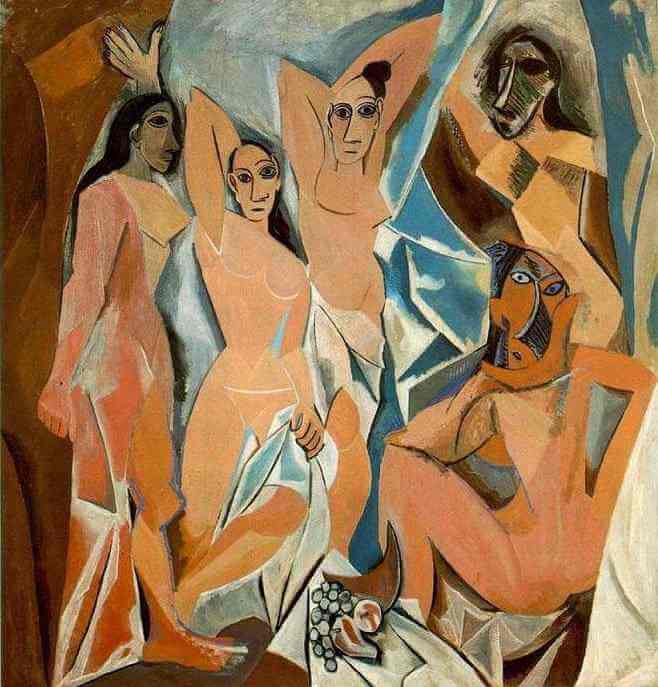
➼ The Portuguese
Details
- By Georges Braque
- 1911
- Oil on canvas
- Art Museum, Basel, Switzerland
Form
- Braque rejected naturalistic and conventional painting.
- Fractured forms; breaking down of objects into smaller forms.
- Clear-edged surfaces at the front of the picture plane, not recessed in space.
- Nearly monochrome.
Context
- Analytical Cubism; Braque worked in concert with Pablo Picasso to develop this style.
- This is not a portrait of a Portuguese musician, but rather an exploration of shapes.
- The only realistic elements are the stenciled letters and numbers; perhaps they suggest a dance hall poster behind the guitarist, a café-like atmosphere.
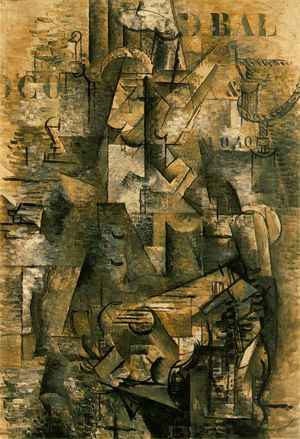
➼ The Steerage
Details
- By Alfred Stieglitz
- 1907
- photogravure
- A private collection
Form
- Interested in compositional possibilities of diagonals and lines acting as framing elements.
- Diagonals and framing effects of ladders, sails, steam pipes, etc.
- Stieglitz photographed the world as he saw it; he arranged little, and allowed people and events to make their own compositions.
- Influenced by experimental European painting; compared with a Cubist drawing by Picasso, Cubist-like in arrangement of shapes and tonal values.
Content
- Steerage: the part of a ship reserved for passengers with the cheapest tickets.
- Depicts the poorest passengers on a ship traveling from the United States to Europe in 1907; they were allowed out for air for a limited time.
- Some may have been people turned away from entrance to the United States; more likely, they were artisans whose visas had expired and were returning home.
Context
- The work depicts social divisions in society.
- Published in October 1911 in Camera Work.
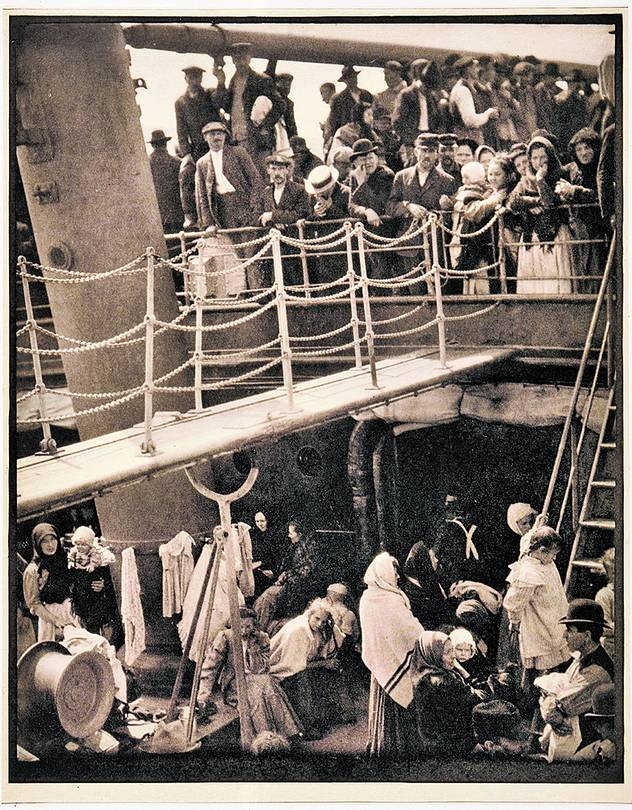
➼ Fountain
Details
- By Marcel Duchamp
- Originally 1917; this version is 1950
- readymade glazed sanitary china with black paint
- Found in Philadelphia Museum of Art, Pennsylvania
Form
- Ready-made sculpture; actually a found object that Duchamp deemed to be a work of art.
- Signed by the “artist,” R. Mutt, a pun on the Mutt and Jeff comic strip and Mott Iron Works.
- Item purchased from a sanitary-ware supplier and submitted to the Society of Independent Artists, a group that Duchamp helped to found.
Function and History
- Entered in an unjuried show, the work was refused—narrowly voted out by the organizers.
- Thought to be indecent, not fit to show women.
- Duchamp resigned in protest.
- It is not fully understood why Duchamp resigned; it may have come from his experience exhibiting an earlier work Nude Descending a Staircase No. 2 to the Salon des Indépendants in Paris; although the work was illustrated in the show’s catalog, Duchamp was asked to remove it a few days before the opening.
- He removed the object but felt betrayed; said it was a turning point in his life.
- Fountain can be seen as an experimental replay by Duchamp, testing the commitment of the new American Society to freedom of expression and tolerance of new conceptions about art.
Context
The title is a pun: a fountain spouts liquid, a urinal collects it.
The placing of the urinal upside down is an added irony.
The rotation of Fountain may symbolize seeing something familiar from a new perspective.
The original is now lost; Duchamp oversaw the “remaking” of a few models in 1964.
➼ Object (Le Dejéuner en fourrure)
Details
- By Meret Oppenheim
- 1936
- fur-covered cup, saucer, and spoon
- Found in Museum of Modern Art, New York
Form: An assemblage.
Context
- Said to have been done in response to Picasso’s claim that anything looks good in fur; Oppenheim said to respond, “Even this cup and saucer?”
- Erotic overtones.
- Combination of unalike objects: fur-covered teacup, saucer, and spoon. The tea cup was purchased at a department store; the fur is the pelt of a Chinese gazelle.
- A contrast of textures: fur delights the touch, not the taste; cups and spoons are meant to be put in the mouth.
- Oppenheim did not title the work, but the Surrealist critic, Andre Breton, called the piece Le Déjeneur en fourrure, or Luncheon in Fur, a title that references Édouard Manet’s Luncheon on the Grass as well as the erotic novel by Leopold von Sacher-Masoch called Venus in Furs.
- Chosen by visitors to a Surrealist show in New York as the quintessential Surrealist work of art.
- Because fame came to Oppenheim so young (she was twenty-two when she produced this work), it inhibited her growth as an artist.
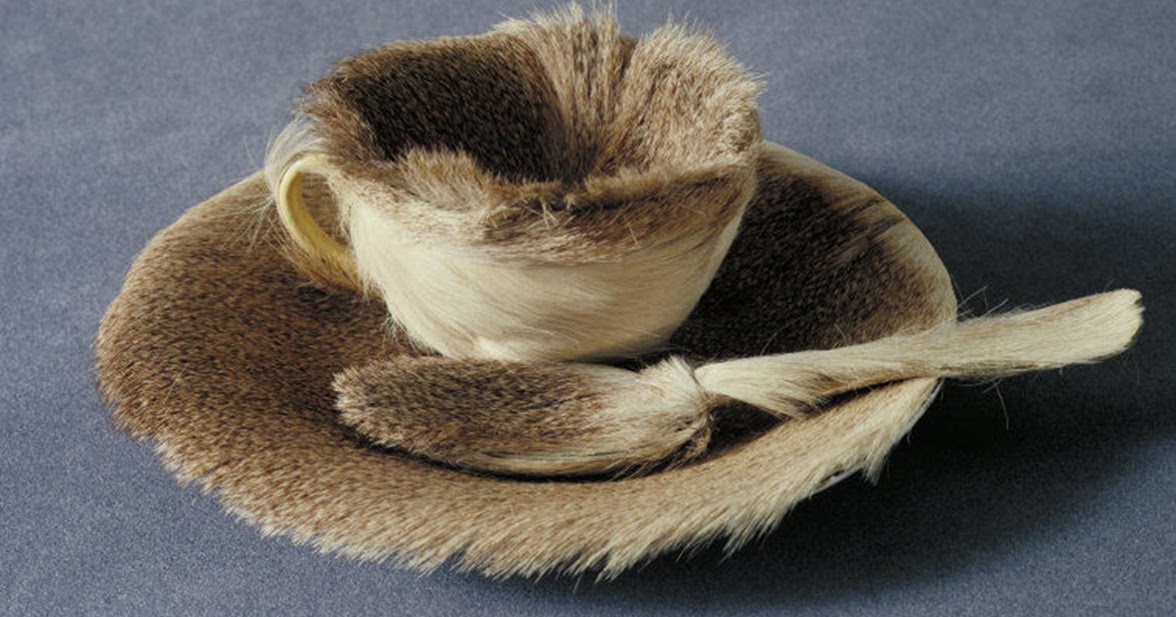
➼ The Two Fridas
Details
- By Frida Kahlo
- 1939
- oil on canvas
- Found in Museum of Modern Art, Mexico City
Content
- On the left: Kahlo is dressed as a Spanish lady in white lace, linking her to a European heritage.
- On the right: Kahlo dressed as a Mexican peasant—the stiffness and provincial quality of Mexican folk art was a direct inspiration for the artist.
- Behind is a barren landscape; two figures sit against a wildly active sky.
Context
- There is a juxtaposition to two self-portraits.
- Kahlo’s two hearts are joined together by veins that are cut by scissors at one end and lead to a portrait of her husband, artist Diego Rivera, at the other; painted at the time of their divorce.
- The vein acts as an umbilical cord; symbolism: Rivera as both husband and son.
- Blood on her lap suggests many abortions and miscarriages; also, surgeries related to her health issues.
- Kahlo rejected the label Surrealism for her artwork.
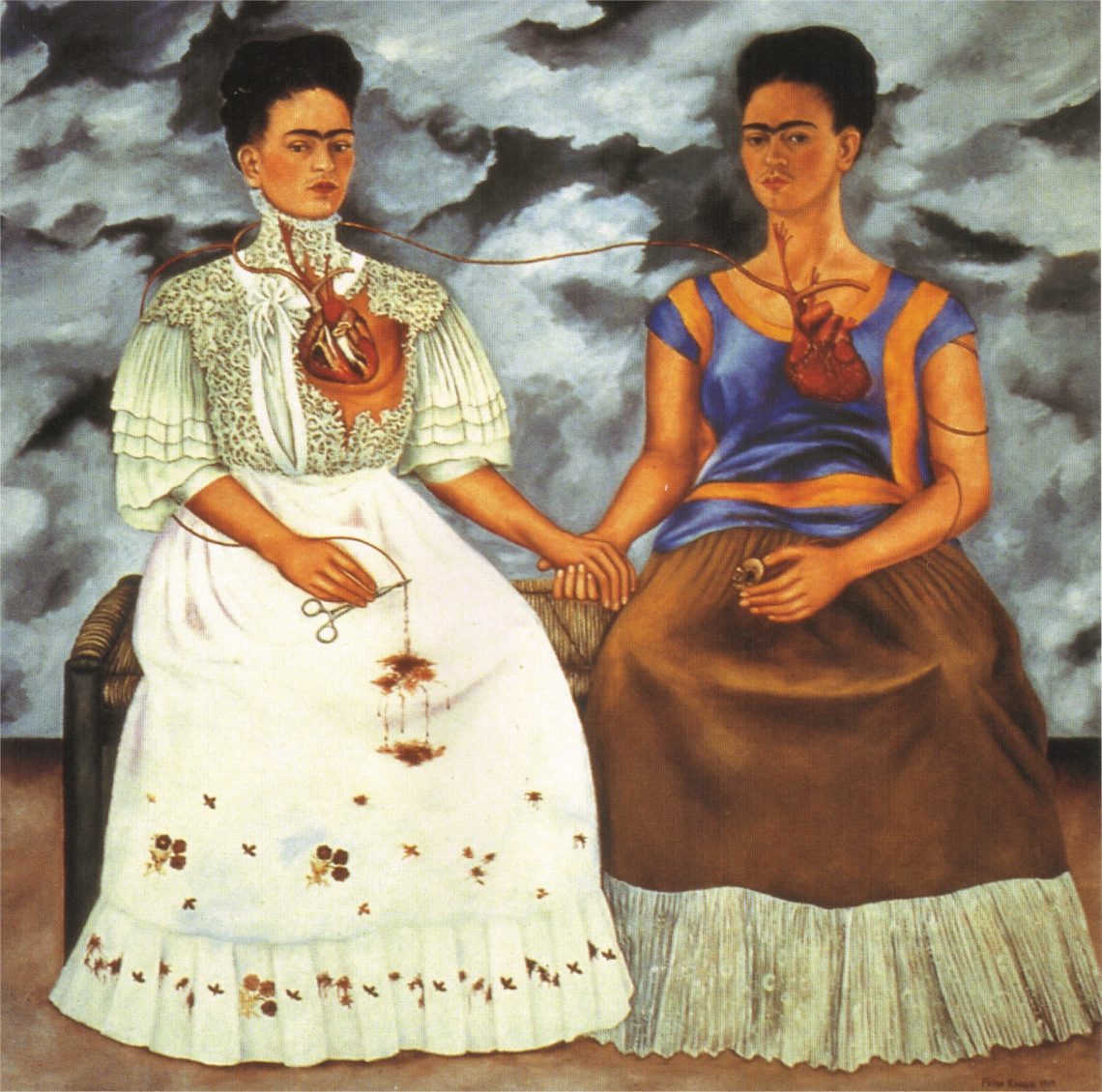
➼ The Jungle
Details
- By Wifredo Lam
- 1943
- gouache on paper mounted on canvas
- Found in Museum of Modern Art, New York
Form
- Crescent-shaped faces suggest African masks and the god Elegua.
- Rounded backs, thin arms and legs, pronounced hands and feet.
- Long vertical lines suggest sugarcane, which is grown in fields, not jungles.
Context
- Cuban-born artist whose career took him to Europe and the United States.
- The artist was interested in Cuba’s mixture of Hispanic and African cultures.
- This work was “intended to communicate a psychic state.”
- The work addresses the history of slavery in colonial Cuba.
- Influences include African sculpture; Cubist works; Surrealist paintings (Lam was a member of the Surrealist movement in Paris).
- The painting contrasts a Cuban landscape with a tourist image of Cuba as a tropical paradise.
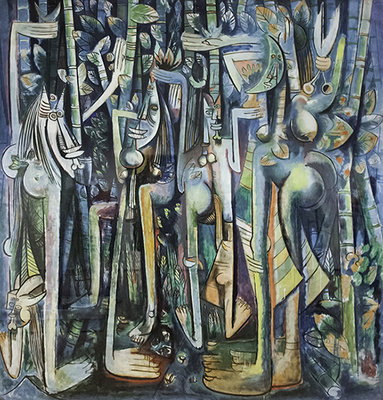
➼ Illustration from The Results of the First Five-Year Plan
Details
- By Varvara Stepanova
- 1932
- photomontage
- Found in Museum of the Revolution, Moscow, Russia
Form and Function
- Graphic art for political and propaganda purposes; a photomontage.
- Red color dominates—the color of Communist Soviet Union.
- A large portrait of Lenin dominates; although deceased, his image is used to stimulate patriotism.
- Masses of people below illustrate the popularity of the Five-Year Plan.
- CCCP (Союз Советских Социалистических Республи) is a Russian abbreviation for the Soviet Union.
Context
- Stepanova was one of the main figures in the Russian avant-garde movement.
- Influenced by Cubism and Futurism.
- Five-Year Plan:
- Soviet practice of increasing agricultural and industrial output in five years.
- Launched in 1928, considered complete in 1932.
- Emphasis on growth of heavy industry rather than consumer goods.
- Huge increases in electrical output (dominant industrial symbol in the work).
- The failures of the five-year plan are overlooked in this representation (famine, extreme poverty, political oppression); instead it is a propaganda statement of the virtues of the Stalinist state.
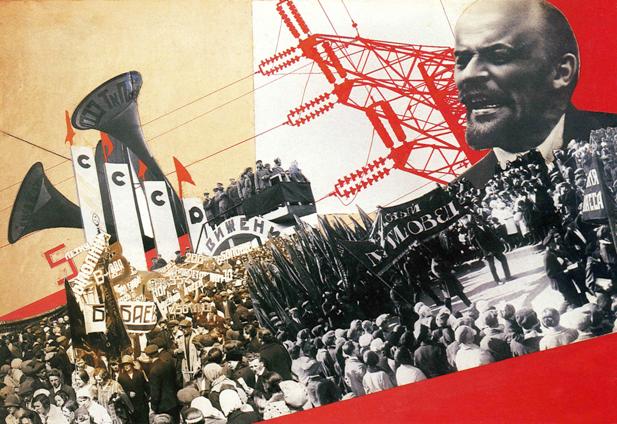
➼ Composition with Red, Blue and Yellow
Details
- By Piet Mondrian
- 1930
- oil on canvas
- Found in Kunsthaus,Zurich
Form
- Only primary colors used—red, yellow, and blue—plus the neutral colors, white and black.
- Severe geometry of form; only right angles; grid-like forms.
- No shading of colors.
Context
- The artist is interested in the material properties of paint, not naturalistic depictions.
- The artist expresses ideas using abstract elements—that is, line and color.
- Influenced by Cubism.
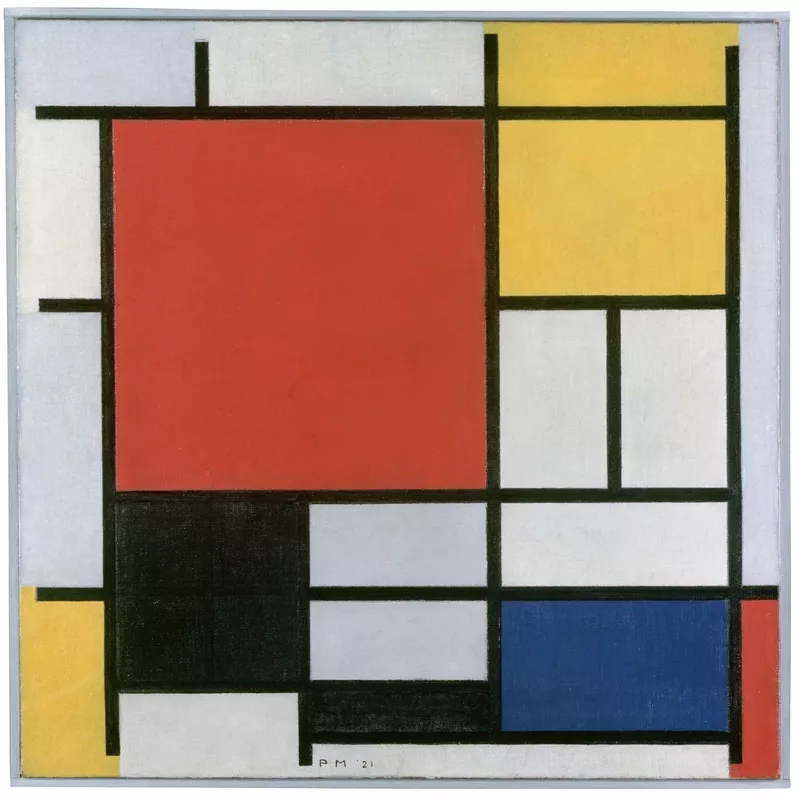
➼ Fallingwater
Details
- By Frank Lloyd Wright
- 1936–1939
- reinforced concrete, sandstone, steel, and glass
- Found in Bear Run, Pennsylvania
Form
- Cantilevered steel-supported porches extend over a waterfall.
- The accent is on horizontal lines—as opposed to the verticality of much of twentieth-century architecture.
- The architecture is in harmony with the site.
- The living room contains a glass curtain wall around three of the four sides; the building embraces the woods around it.
- The floor of the living room and the walls of building are made from the stone of the area.
- The hearth (physically and symbolically) is the center of the house, an outcropping of natural stones surrounds it.
- The interior shows a suppression of space devoted to hanging a painting; Wright wanted the architecture to dominate.
- The ground plan and design is irregular and complex.
- Only two colors used: light ochre for the concrete and Cherokee red for the steel.
Context: Late expression of Prairie School ideas.
Function and Patronage: Weekend retreat for the Kaufmann family, who owned a department store in Pittsburgh, Pennsylvania.
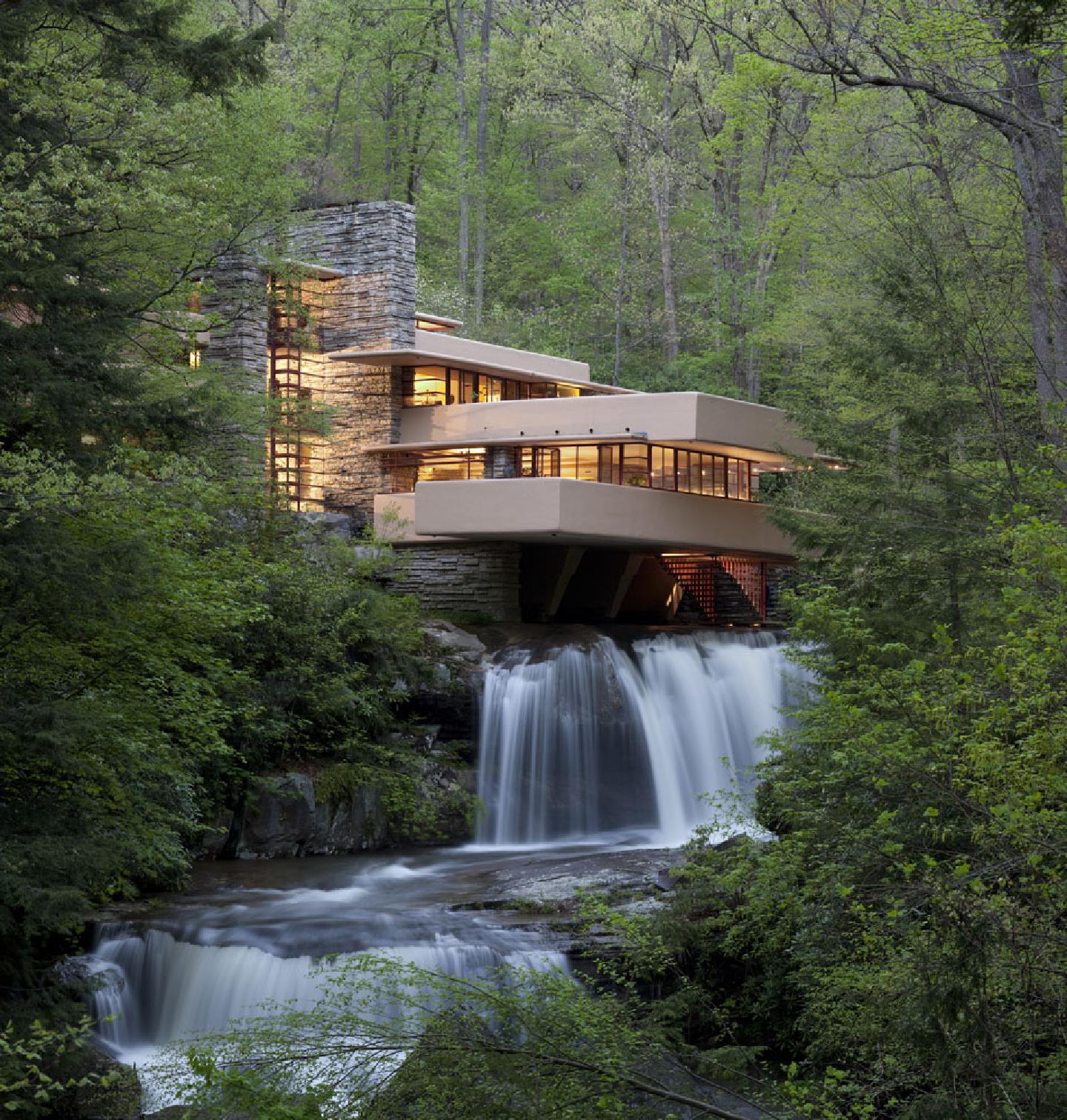
➼ Villa Savoye
Details
- By Le Corbusier
- 1929
- steel and reinforced concrete
- Found in Poissy-sur-Seine, France
Form
- Boxlike horizontal quality; an abstraction of a house.
- The main part of the house is lifted off the ground by narrow pilotis—thin freestanding posts.
- The house appears to float on pilotis; allows air to circulate around the base of the house.
- The turning circular carport on the bottom floor enables family members to enter the house directly from their car.
- All space is utilized, including the roof, which acts as a patio.
- The roof terraces bring the outdoors into the house.
- Subtle colors: white on exterior symbolizes modern cleanliness and healthful living.
- Open interior is free of many walls.
- Some furniture is built into the walls.
- Ribbon windows wind around the second floor.
- Streamlined look.
- Living spaces that are surrounded by glass face an open courtyard-type setting on the second floor.
Function and Patronage
- A three-bedroom country house with servants’ quarters on the ground floor.
- Built in suburban Paris as a retreat for the wealthy.
- Patrons: Pierre and Emilie Savoye.

➼ Seagram Building
Details
- By Ludwig Mies van der Rohe and Philip Johnson
- 1954–1958
- steel frame with glass curtain wall and bronze
- Found in New York
Function: 38-story corporate headquarters of the Seagram Liquor Company.
Form
- Bronze veneer gives the skyscraper a monolithic look; bronze is maintained yearly to keep the same color.
- Set back from Park Avenue on a wide plaza balanced by reflecting pools.
- Interplay of vertical and horizontal accents.
- Mullions stress the verticality of the internal frame.
Context
- Minimalist architecture.
- Monolith style expresses corporate power.
- Mies’s saying of “Less is more” can be seen in this building with its great simplicity, geometry of design, and elegance of construction.
- Mies also said, “God is in the details;” truthful buildings express their structure, not hide it.
- Steel and glass skyscrapers and curtain wall construction became the model after World War II.
- A triumph of the International Style of architecture.

➼ The Migration of the Negro, Panel no. 49
Details
- By Jacob Lawrence
- 1940–1941
- casein tempera on hardboard
- Found in Museum of Modern Art, New York
Form
- The work illustrates the collective African-American experience; therefore, there is little individuality in the figures.
- Forms hover in large spaces.
- Angularity of forms.
- Tilted tabletops show the surface of the table.
- Flat, simple shapes.
- Unmodulated colors.
- Collective unity achieved by painting one color across many panels before going on to the next color; overall color unity in the series unites each painting.
Content
- This scene involves a public restaurant in the North; segregation emphasized by the yellow poles that zigzag down the center.
- Whites appear haughty and self-engrossed.
- African-Americans appear faceless; forms reveal their bodies and personalities.
Context
- One of a series of 60 paintings that depicts the migration of African-Americans from the rural South to the urban North after World War I.
- Negroes escaping the economic privation of the South.
- Narrative painting in an era of increasing abstraction.
- Cinematic movement of views of panels: some horizontal and others vertical.
- Influenced by the Italian masters of the fourteenth and fifteenth centuries; used tempera paint.
- The Phillips Collections in Washington, D.C., and the Museum of Modern Art in New York bought the collection and it was split.
- The Phillips took the odd-numbered paintings; the Museum of Modern Art has the even-numbered ones.
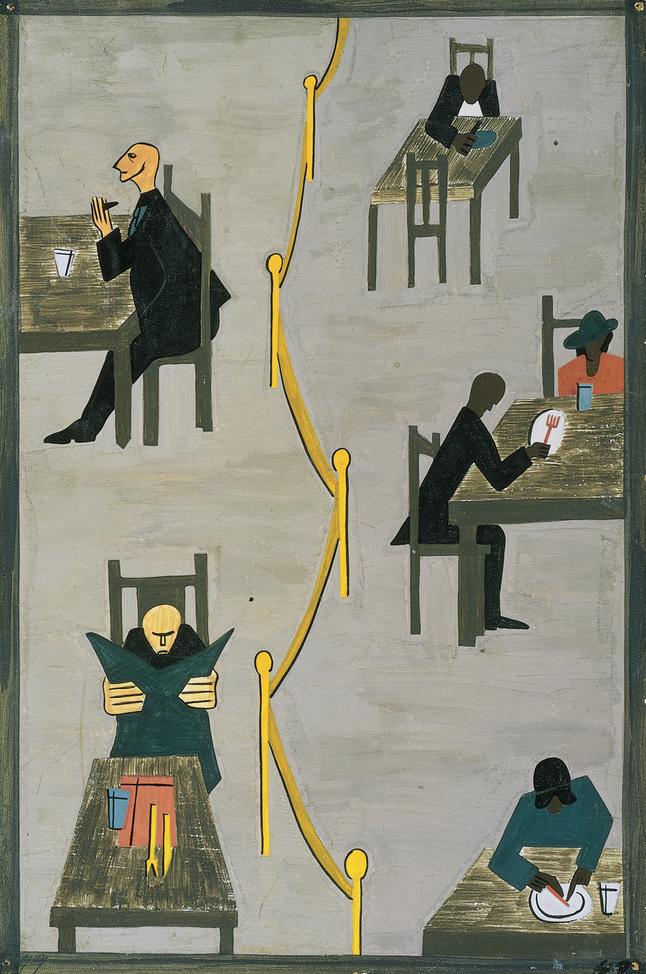
➼ Dream of a Sunday Afternoon in the Alameda Park
Details
- By Diego Rivera
- 1947–1948
- fresco
- Found in Museo Mural Diego Rivera, Mexico City
Form
- 50-foot-long fresco, 13 feet high.
- Horror vacui; didactic painting.
- Colorful painting.
- Revival of fresco painting, a Mexican specialty.
Placement
- Originally in the lobby of the Hotel del Prado.
- After a 1985 earthquake destabilized the hotel, the fresco was placed in a museum adjacent to Alameda Park, Mexico City’s first city park—built on the grounds of an Aztec marketplace.
Content
- Three eras of Mexican history depicted from left to right:
- Conquest and colonization of Mexico by the Spanish.
- Porfirio Diaz dictatorship.
- Revolution of 1910 and the modern world.
- Depicts a who’s who of Mexican politics, culture, and leadership:
- Sor Juana, in nun’s habit, at left center.
- Benito Juárez, five-term president of Mexico, left at top.
- General Santa Ana handing the keys of Mexico to General Winfield Scott.
- Emperor Maximilian and Empress Carlota.
- José Marti, father of Mexican independence (tipping his hat).
- General Porfirio Díaz, with medals, asleep.
- A police officer ordering a family out of an elitist park.
- Francisco Madero, a martyred president.
- José Posaro, artist and Rivera hero.
- Rivera is in the center, at age ten, holding hands with Caterina (“Death”) and dreaming of a perfect love (Kahlo is behind him holding a yin/yang symbol—a symbol of Kahlo and Rivera’s relationship).

➼ Woman I
Details
- By Willem de Kooning
- 1950–1952
- oil on canvas
- Found in Museum of Modern Art, New York
Form
- Ferocious woman with great fierce teeth and huge eyes.
- Large, bulbous breasts satirize women who appear in magazine advertising; smile said to be influenced by an ad of a woman selling Camel cigarettes.
- Jagged lines create an overpowering image.
- The smile is a cut out of a female smile from a magazine advertisement.
- Blank stare; frozen grin.
- Ambiguous environment: vagueness, insecurity.
- Thick and thin black lines dominate.
Context
- Combination of stereotypes; ironic comment on the banal and artificial world of film and advertising.
- Commentary on the female form in art history.
- Is she aggressive? Or have aggressions been committed against her? Or both?
- One of a series of six paintings on this theme.
- Influenced by everything from paleolithic goddesses to pin-up girls
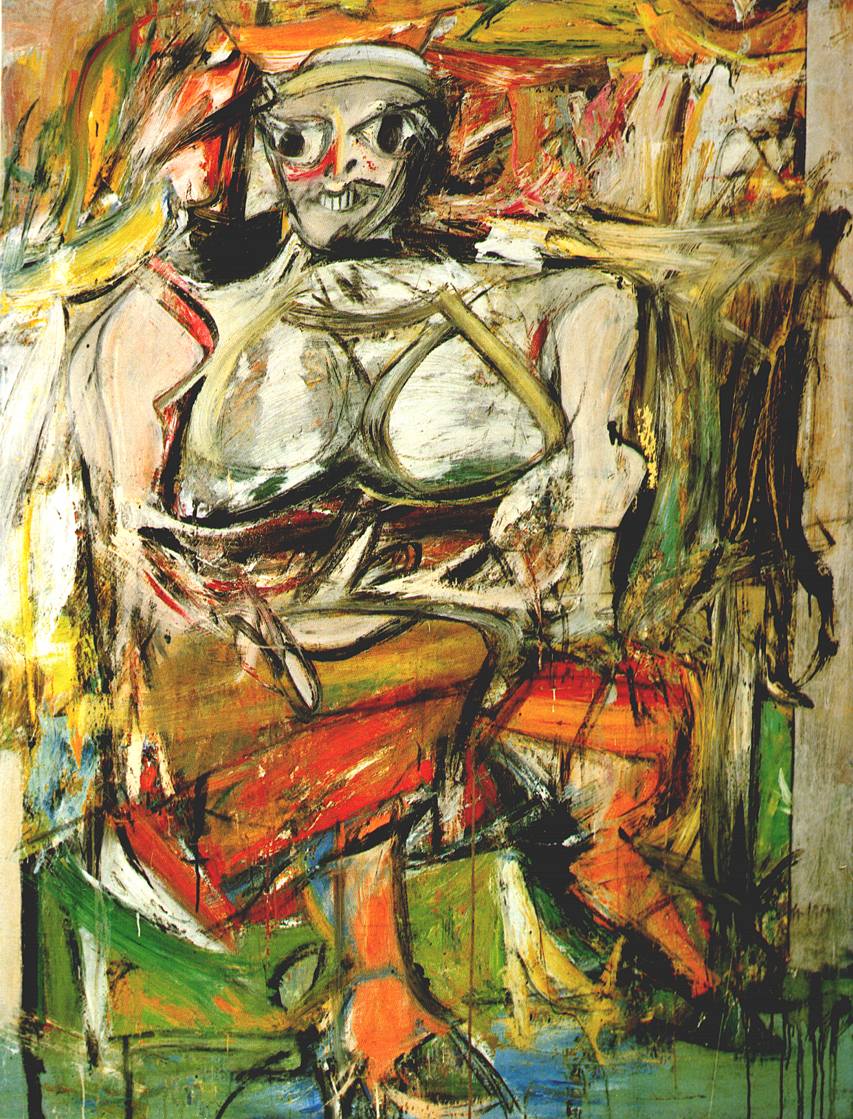
➼ The Bay
Details
- By Helen Frankenthaler
- 1963
- acrylic on canvas
- Found in Detroit Institute of Arts, Detroit, Michigan
Form
- Painted directly on an unprimed canvas; canvas absorbs the paint more directly.
- Use of runny water-based acrylic paint.
- Soak-stained technique.
- Use of landscape as a starting point, a basis for imagery in the works.
- The two-dimensionality of the canvas is accentuated.
Context and Interpretation: Artist worked in the avant-garde New York School at mid-century.
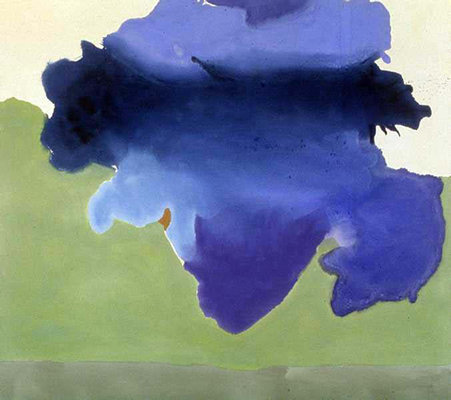
➼ Marilyn Diptych
Details
- By Andy Warhol
- 1962
- oil, acrylic, silkscreen enamel on canvas
- Found in Tate Gallery, London
Form and Content
- Marilyn Monroe’s public face appears sequentially as if on a roll of film.
- Fifty images from a film still from a movie, Niagara (1953).
- Social characteristics magnified: brilliance of blonde hair, heavily applied lipstick, seductive expression.
- Private persona of the individual submerged beneath the public face.
- Marilyn’s public face appears highlighted by bold, artificial colors.
- Left, in color, represents her in life; right, in black and white, represents her in death; work done four months after her tragic death.
- Repetition of faces reflects the repetition of the number of times Marilyn appeared before the public; sometimes overexposed, sometimes underexposed.
Materials and Technique
- Silkscreen printing technique applies photographic images in rectangular shapes onto a canvas background.
- Silkscreen diminishes the role of shading and emphasizes broad planes and unmodulated color.
- Diptych format suggests almost a religious presence.
Context
- Cult of celebrity; Monroe was a famous movie star of the 1950s.
- Private persona of Marilyn submerged beneath the public face(s).
- Repeated imagery drains the image of Monroe of meaning.
- Reproduction of many denies the concept of the unique work of art.

➼ Lipstick (Ascending) on Caterpillar Tracks
Details
- By Claes Oldenburg
- 1969–1974
- cor-ten steel, steel, aluminum, and cast resin, painted with polyurethane enamel
- Found in Yale University, New Haven, Connecticut
Function
- First installed, secretly, on Beinecke Plaza, New Haven, in 1969.
- Intended as a platform for public speakers; rallying point for anti-Vietnam-era protests.
Materials
- Sculpture made of inexpensive and perishable materials (plywood tracks and an inflatable vinyl balloon tip).
- Refurbished with steel and aluminum; reinstalled in 1974 in front of Morse College, at Yale—not its original location.
Context
- Tank-shaped platform base with lipstick ascending—antiwar symbolism.
- Male and female forms unite: themes of death, power, desire, and sensuality.
- First monumental sculpture by Oldenburg.
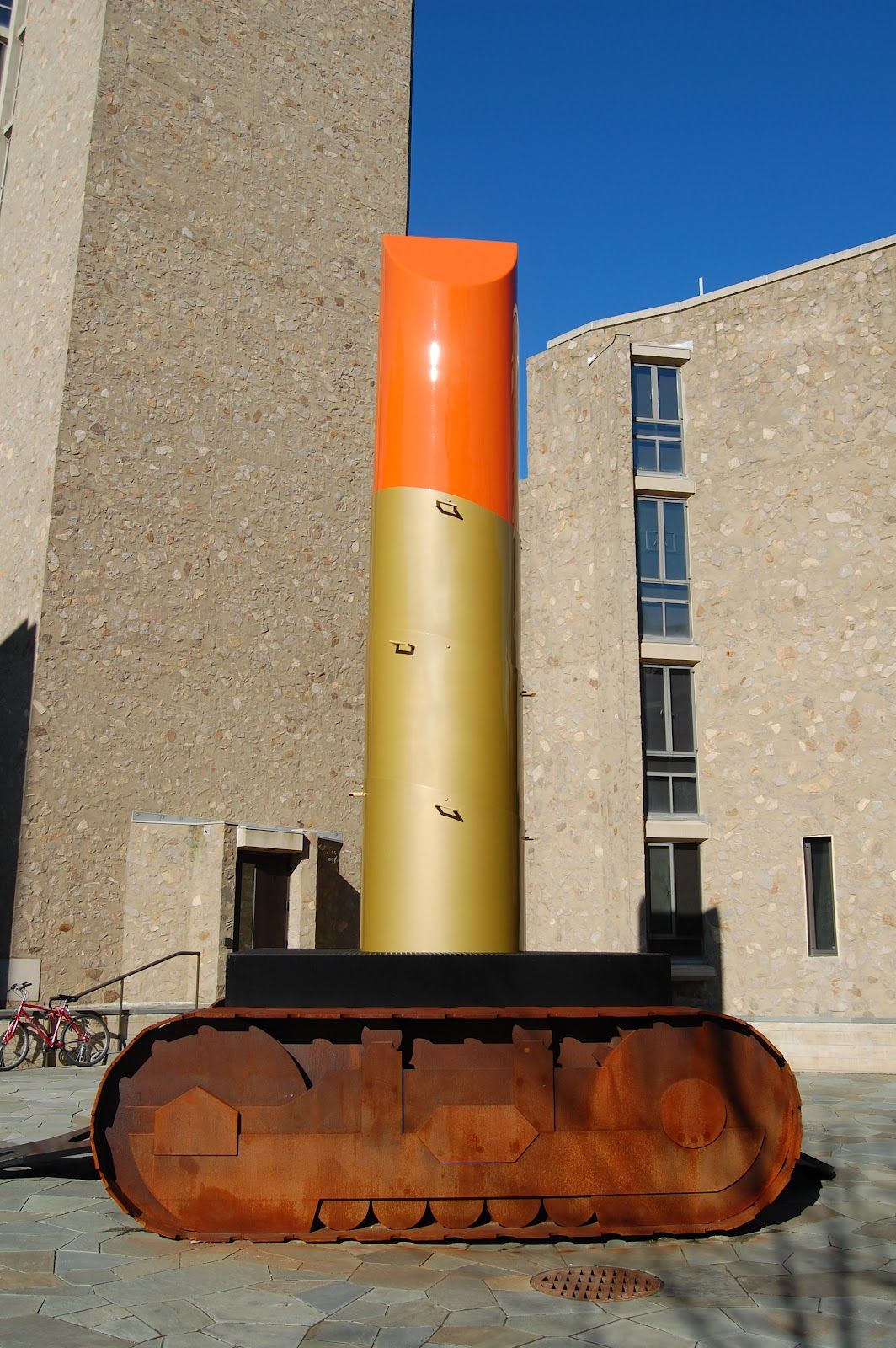
➼ Narcissus Garden
Details
- By Yayoi Kusama
- first seen in 1966
- marble installations
- Found in Venice
Function and History
- The artist originally featured the work as an uninvited participant in the 1966 Venice Biennale.
- Fifteen hundred large, mirrored, plastic balls were placed on a lawn under a sign that said “Your Narcissism for Sale.”
- The viewer is reflected seemingly into infinity in the mirrored surfaces.
- The artist offered the balls for sale for 1,200 lire ($2 each) as a commentary on the commercialism and vanity of the current art world.
- The installation later moved to water, where the floating balls reflect the natural environment—and the viewers—around the work; water placement makes a stronger connection to the ancient myth.
- Balls move with the currents of the water and wind, reflecting organically made, ever-changing viewpoints.
- The installation has been exhibited in many places around the world, both in water and in dry spaces
Context
- Narcissus Garden references the ancient myth of Narcissus, a young man who is so enraptured by his image in reflecting water that he stares at it indefinitely until he becomes a flower.
- There is a deeper meaning today as Narcissus Garden references modern obsessions with selfies and uploaded images on social media.
- Kusama is an internationally renowned Japanese-born artist:
- Got her start showing large works of art featuring huge polka dots.
- One of the foremost innovators of Happenings.
- Works in a wide variety of media, including installations.
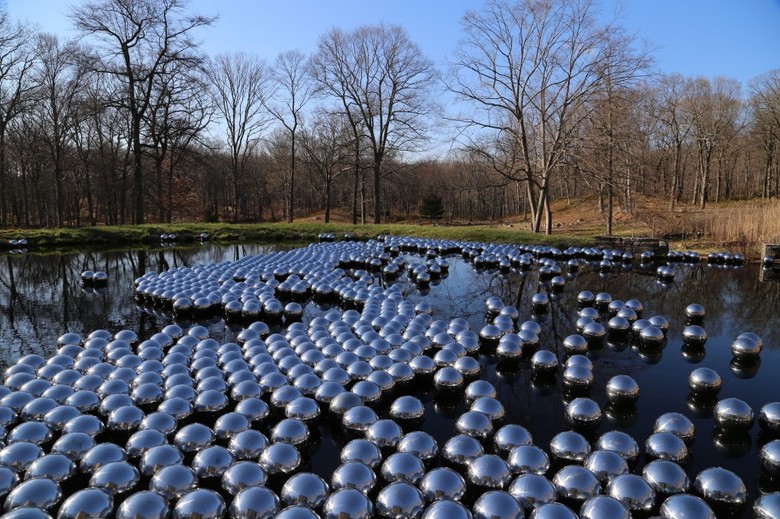
➼ Spiral Jetty
Details
- By Robert Smithson
- 1970
- earthwork: mud, precipitated salt crystals, rocks, water coil
- Found in Great Salt Lake, Utah
Form
- A coil of rock placed in a part of the Great Salt Lake that is in an extremely remote and inaccessible area.
- The artist liked the site because of the blood-red color of the water, which is due to the presence of bacteria and algae that live in the high-salt content.
Material: The artist used a tractor to move basalt from the adjacent hillside to create the jetty.
Context
- Upon walking on the jetty, the twisting and curling path changes the viewer’s view from every angle.
- A jetty is usually a pier extending into the water; here it is transformed into a curl of rocks sitting silently in a vast, empty wilderness.
- The coil is an image seen in North American earthworks—cf. Great Serpent Mound, Ohio—as well as in petroglyphs and Anasazi pottery.
- The work reflects emerging views of the environmental movement; Earth Day was inaugurated in 1970.
- Smithson wanted nature to have its effect on the jetty (sometimes it is submerged, sometimes it is visible).

➼ House in New Castle County
Details
- By Robert Venturi, John Rauch, and Denise Scott Brown
- 1978–1983
- Made of wood frame and stucco
- Found in Delaware
Form
- The façade contains an arch inside a pediment form.
- A squat, bulging Doric colonnade is asymmetrically placed.
- The columns are actually flat rather than the traditionally round forms.
- The drainpipe at the left bisects the outermost column.
- The flattened forms on the interior arches echo the exterior flat columns.
- The interior forms reflect a craftsman’s hand in curved, cutting elements.
Function
- The house was designed for a family of three.
- For the wife, a musician, a music room was created with two pianos, an organ, and a harpsichord.
- For the husband, a bird-watcher, large windows were installed facing the woods.
Context
- Postmodern mix of historical styles.
- Rural location in low hills, grassy fields of Delaware.
- Venturi’s comment on the International style: “Less is a bore.”
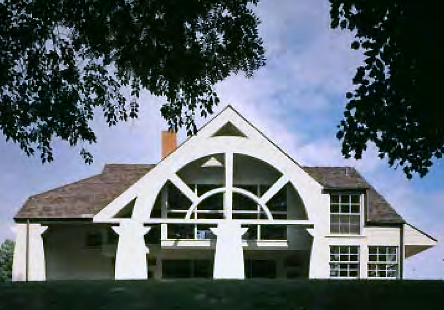
Unit 5: Indigenous Americas, 1000 BCE–1980 CE
Contextualization of Indigenous Americas Art
- Chavin: Their art created intricate stone carvings and pottery, often depicting their gods and animals.
- Mayan: They were known for their elaborate architecture, intricate carvings, and colorful murals.
- Anasazi: They created beautiful pottery and rock art, often depicting their daily lives and spiritual beliefs.
- Mississippian: They produced intricate copper and shell ornaments, as well as impressive earthen mounds.
- Aztec: They were skilled in metalworking, creating intricate gold and silver jewelry, as well as colorful featherwork.
- Incan: They were known for their impressive stonework, including the famous Machu Picchu.
- Native North American: Their art varied greatly depending on the tribe, but often included intricate beadwork, basketry, and carvings.
Materials, Processes and Techniques in Indigenous American Art
Mesoamerica
- They used stone, clay, wood, feathers, shells, and precious metals such as gold and silver.
- Stones were used to create sculptures, buildings, and other structures.
- Their processes include carving, casting, weaving, and painting.
- Carving: Used create sculptures and other objects out of stone, while casting was used to create metal objects.
- Weaving: Used to create textiles, which were often decorated with intricate designs.
- Painting: Used to decorate buildings, sculptures, and other objects, and often used bright colors and bold designs.
- Techniques used in Mesoamerican art include relief sculpture, mosaic, and inlay.
- Relief sculpture: Involves carving a design into a flat surface, while mosaic involves creating a design out of small pieces of stone or other materials.
- Inlay: Involves setting small pieces of one material into another material to create a design.
Central Andes
- Pre-Columbian art used gold, silver, and copper to create intricate jewelry and ceremonial objects, and textiles were also important.
- During colonial times, European materials were introduced, leading to new painting techniques like the Cuzco School.
- Today, artists use a variety of materials and techniques, blending traditional and contemporary styles, experimenting with new materials, and exploring different art forms.
Native North America
- Natural materials like wood, stone, bone, and animal hides, as well as trade materials like glass beads, metals, and textiles are used.
- Art is created through carving, weaving, painting, and quilling.
- Basketry, pottery, and jewelry making are common techniques.
- These methods reflect cultural and spiritual beliefs and can tell stories, record history, or celebrate events.
- Traditional methods have adapted to modern materials and technologies.
Indigenous Americas Artworks
➼ Chavín de Huántar
Details
- 900–200 B.C.E.
- Stone
- Found in Northern Highlands, Peru
Function
- A religious capital.
- Temple, 60 meters tall, was adorned with a jaguar sculpture, a symbol of power.
- Hidden entrance to the temple led to stone corridors.
Relief sculpture
- Shows jaguars in shallow relief.
- Located on the ruins of a stairway at Chavín.
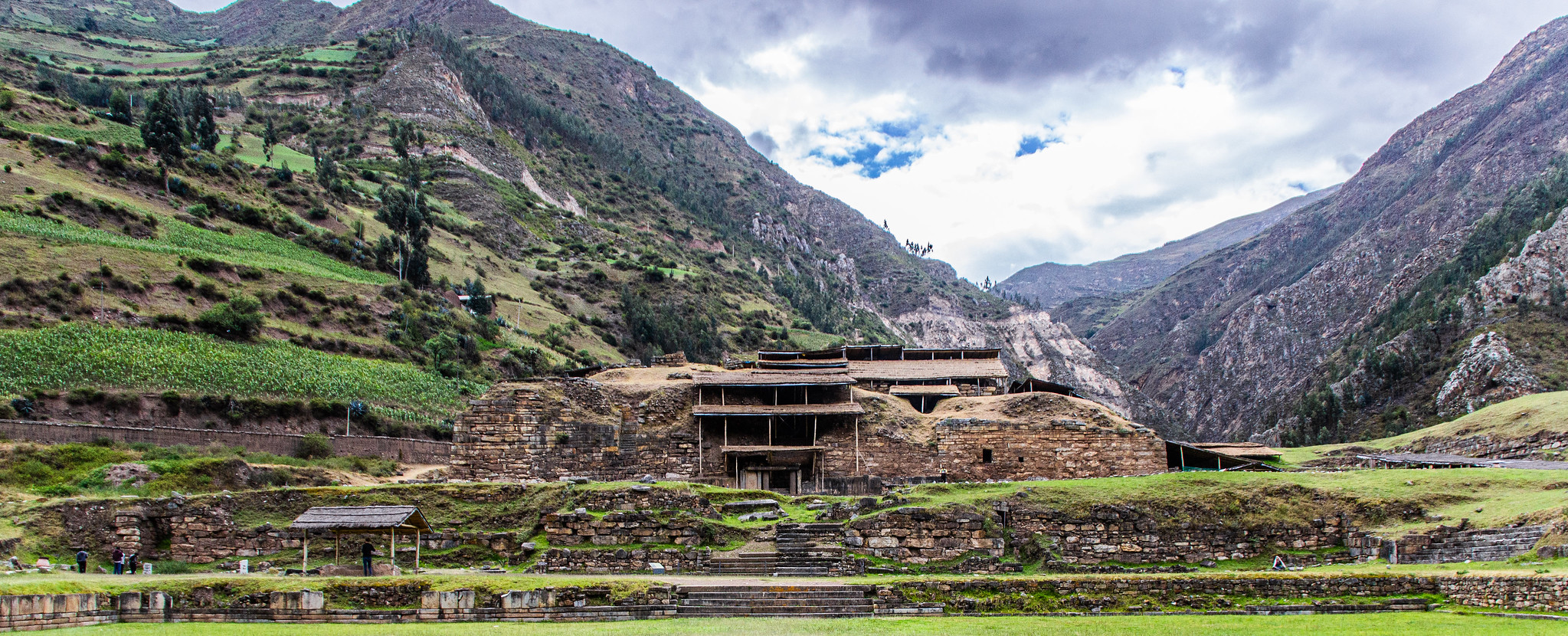
➼ Lanzón Stone
Details
- 900–200 B.C.E.
- Granite
- Found in Peru
Form
- Inside the old temple of Chavín is a mazelike system of hallways.
- Passageways have no natural light source; they are lit by candles and lamps.
- At the center, underground, is the Lanzón (Spanish for “blade”) Stone; blade shaped; may also represent a primitive plough; hence, the role of the god in ensuring a successful crop.
- Depicts a powerful figure that is part human (body) and part animal (claws, fangs); the god of the temple complex.
- Head of snakes and a face of a jaguar.
- Eyebrows terminate in snakes.
- Flat relief; designs in a curvilinear pattern.
- 15 feet tall.
Function
- Served as a cult figure.
- Center of pilgrimage; however, few had access to the Lanzón Stone.
- Modern scholars hypothesize that the stone acted as an oracle; hence a point of pilgrimage.
- New studies show the importance of acoustics in the underground chamber.
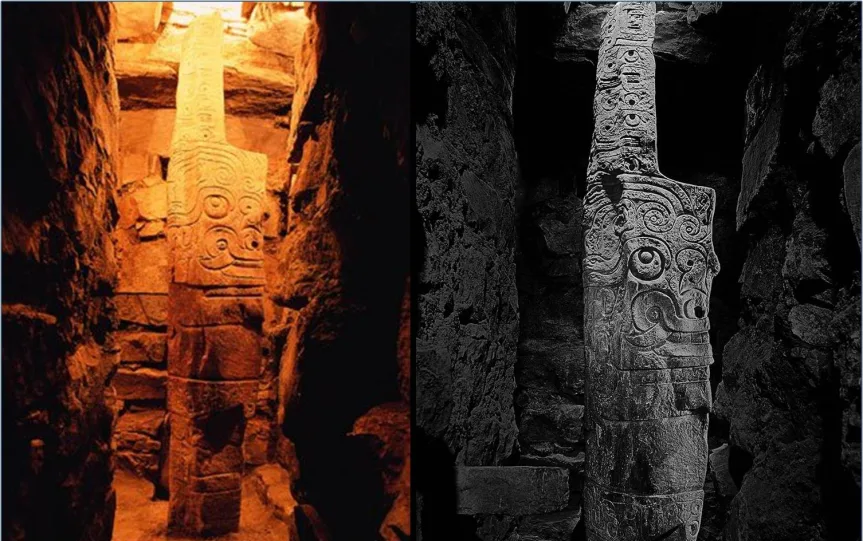
➼ Nose Ornament
Details
- hammered gold alloy
- Found in Cleveland Museum of Art
Form
- Worn by males and females under the nose.
- Held in place by the semicircular section at the top.
- Two snake heads on either end.
Function: Transforms the wearer into a supernatural being during ceremonies.
Context
- Elite men and women wore the ornaments as emblems of their ties to the religion and eventually were buried with them.
- The Chavín religion is related to the appearance of the first large-scale precious metal objects; revolutionary new metallurgical process.
- Technical innovations express the “wholly other” nature of the religion.
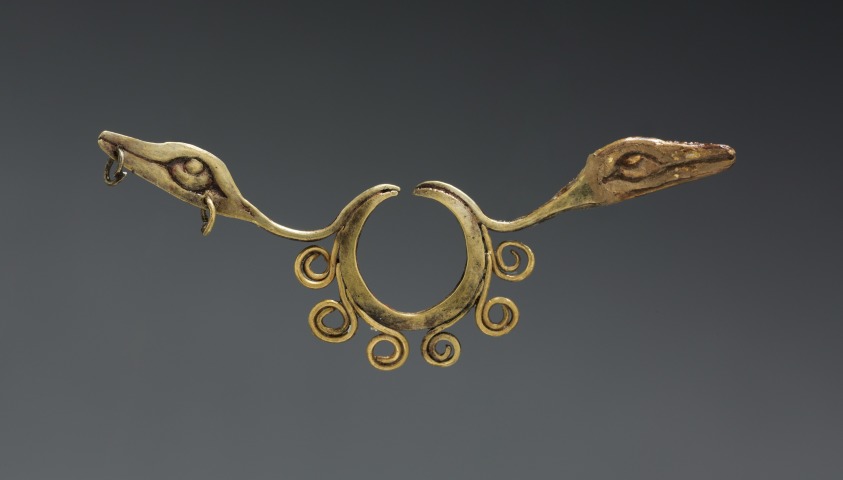
➼ Yaxchilán
- Details
- 725 CE
- limestone
- Found in Chiapas, Mexico
- Function
- City set on a high terrace; plaza surrounded by important buildings.
- Flourished c. 300–800 C.E.
➼ Structure 40
Details
- Overlooks the main plaza.
- Three doors lead to a central room decorated with stucco.
- Roof remains nearly intact, with a large roof comb (ornamented stone tops on roofs).
- Corbel arch interior.
Patronage: Built by ruler Bird Jaguar IV for his son, who dedicated it to him.
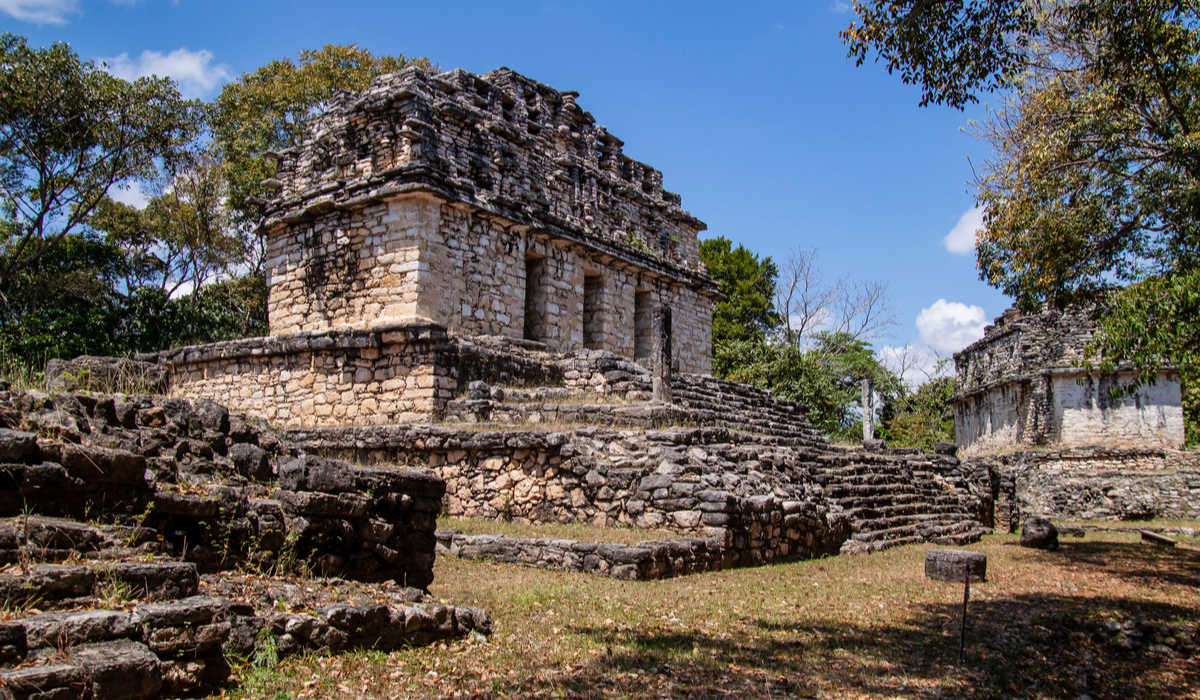
➼ Lintel 25, Structure 23
Details
- Overlooks the main plaza.
- Three doors lead to a central room decorated with stucco.
- Roof remains nearly intact, with a large roof comb (ornamented stone tops on roofs).
- Corbel arch interior.
Form and Content
- The lintel was originally set above the central doorway of Structure 23 as a part of a series of three lintels.
- Lady Xook (bottom right) invokes the Vision Serpent to commemorate her husband’s rise to the throne.
- The Vision Serpent has two heads: one has a warrior emerging from its mouth, and the other has Tlaloc, a war god.
- She holds a bowl with bloodletting ceremonial items: stinging spine and bloodstained paper; she runs a rope with thorns through her tongue.
- She burns paper on a dish as a gift to the netherworld.
- The depicted ritual was conducted to commemorate the accession of Shield Jaguar II to the throne.
Function
- Lintels intended to relay a message of the refoundation of the site—there was a long pause in the building’s history.
- Shield Jaguar’s building program throughout the city may have been an attempt to reinforce his lineage and his right to rule.
Context
- The building is dedicated to Lady Xook, Shield Jaguar II’s wife.
- The inscription is written as a mirror image—extremely unusual among Mayan glyphs; uncertain meaning, perhaps indicating she had a vision from the other side of existence and she was acting as an intercessor or shaman.
- The inscription names the protagonist as Shield Jaguar II.
- Bloodletting is central to the Mayan life. When a member of the royal family sheds his or her blood, a portal to the netherworld is opened and gods and spirits enter the world.
Theory: Some scholars suggest that the serpent on this lintel and elsewhere depicts an ancestral spirit or founder of the kingdom.

➼ Structure 33
Details
- Overlooks the main plaza.
- Three doors lead to a central room decorated with stucco.
- Roof remains nearly intact, with a large roof comb (ornamented stone tops on roofs).
- Corbel arch interior.
Form
- Restored temple structure.
- Remains of roof comb with perforations.
- Three central doorways lead to a large single room.
- Corbel arch interior.

➼ Mesa Verde Cliff Dwellings
Details
- Ancestral Puebloan (Anasazi)
- 450–1300 C.E.
- Sandstone
- Found in Montezuma County, Colorado
Form
- The top ledge houses supplies in a storage area; cool and dry area out of the way; accessible only by ladder.
- Each family received one room in the dwelling.
- Plaza placed in front of the abode structure; kivas face the plaza.
Function
- The pueblo was built into the sides of a cliff, housed about one hundred people.
- Clans moved together for mutual support and defense.
Context
- Farming done on the plateau above the pueblo; everything had to be imported into the structure; water seeped through the sandstone and collected in trenches near the rear of the structure.
- Low winter sun penetrated the pueblo; high summer sun did not enter the interior and therefore it stayed relatively cool.
- Inhabited for two hundred years; probably abandoned when the water source dried up.
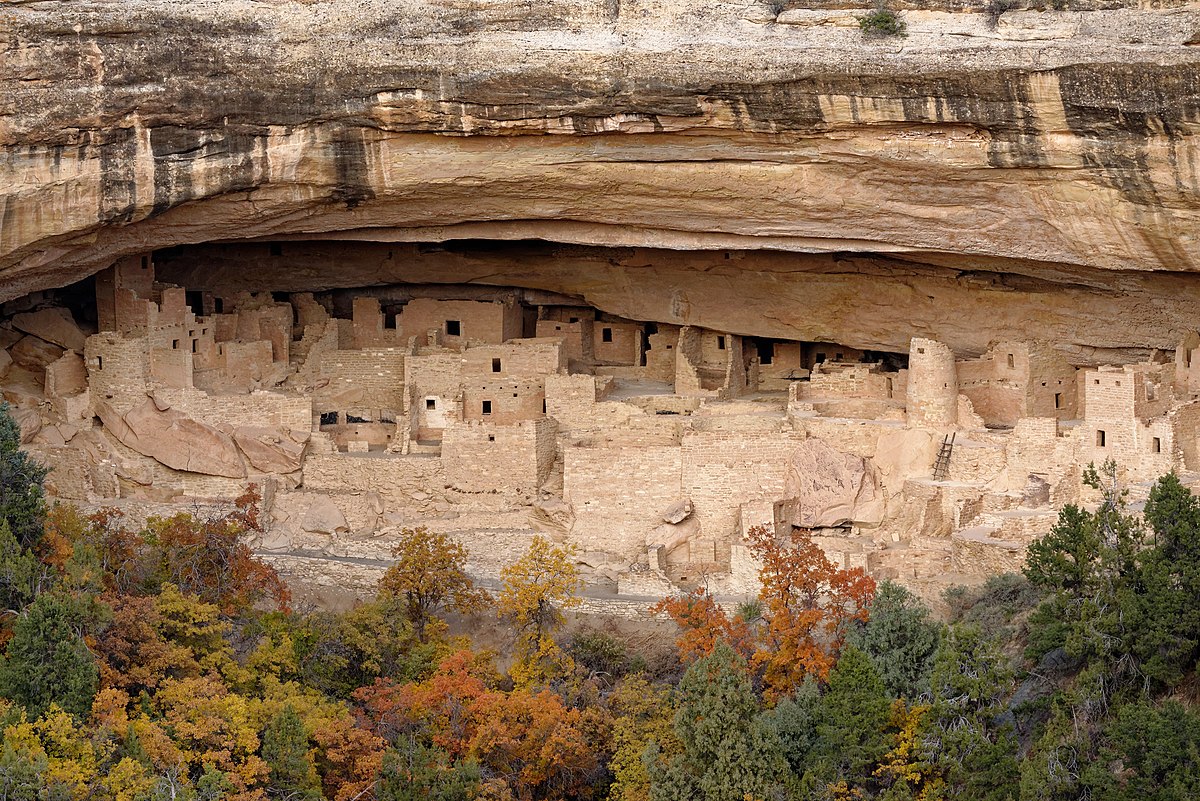
➼ Great Serpent Mound
Details
- Mississippian (Eastern Woodlands)
- c. 1070 C.E.
- earthwork/effigy mound
- Found in Adams County, southern Ohio
Context
- Many mounds were enlarged and changed over the years, not built in one campaign.
- Effigy mounds popular in Mississippian culture.
- Associated with snakes and crop fertility.
- There are no burials associated with this mound, though there are burial sites nearby.
Theories
- Influenced by comets? Astrological phenomenon? Head pointed to summer solstice sunset?
- Theory that it could be a representation of Halley’s Comet in 1066.
- Rattlesnake as a symbol in Mississippian iconography; could this play a role in interpreting this mound?
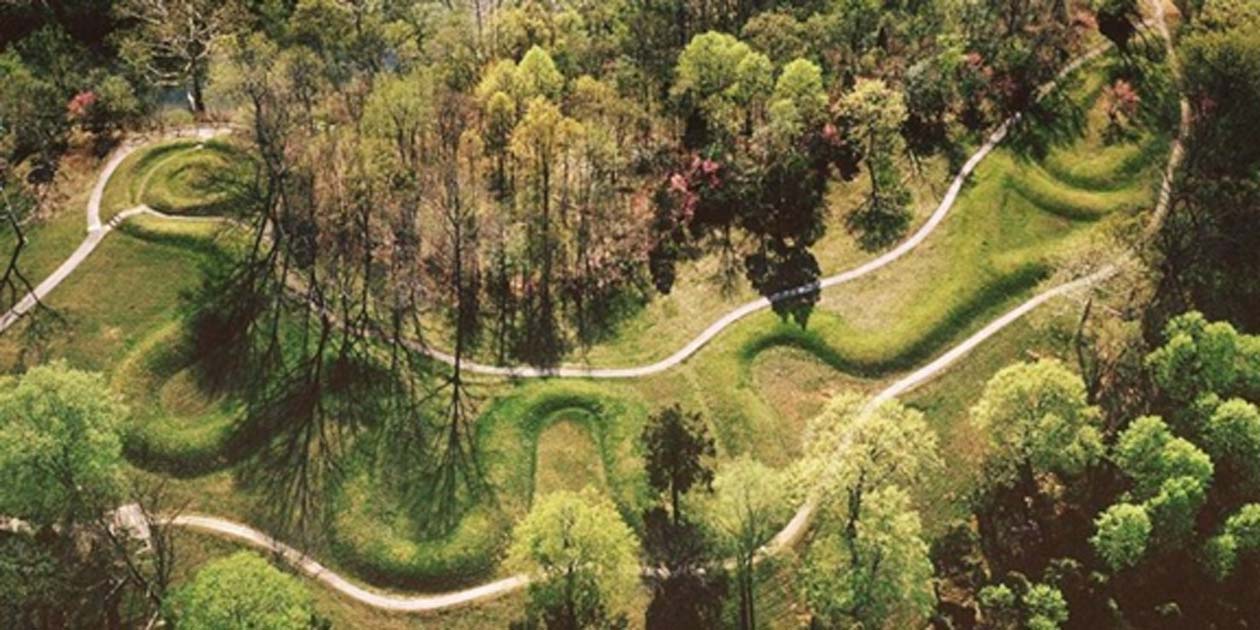
➼ Templo Mayor (Main Temple)
Details
- 1375–1520
- Stone
- Found in Tenochtitlán, Mexico City, Mexico
Form
- Pyramids built one atop the other so that the final form encases all previous pyramids; seven building campaigns.
- Pyramids have a step-like series of setbacks; not the smooth-surfaced pyramids seen in Egypt.
- Characterized by four huge flights of very vertical steps leading to temples placed on top.
Function
- Tenochtitlán was laid out on a grid; city seen as the center of the world.
- The temple structures on top of each pyramid were dedicated to and housed the images of the two important deities.
Context
- Two temples atop a pyramid, each with a separate staircase:
- North: dedicated to Tlaloc, god of rain, agriculture.
- South: dedicated to Huitzilopochtli, god of sun and war.
- At the spring and autumn equinoxes, the sun rises between the two.
- Large braziers put on top where the sacred fires burned.
- Temple structures housed images of the deities.
- Temples begun in 1375; rebuilt six times; destroyed by the Spanish in 1520.
- The destruction of this temple and reuse of its stones by the Spanish asserted a political and spiritual dominance over the conquered civilization.
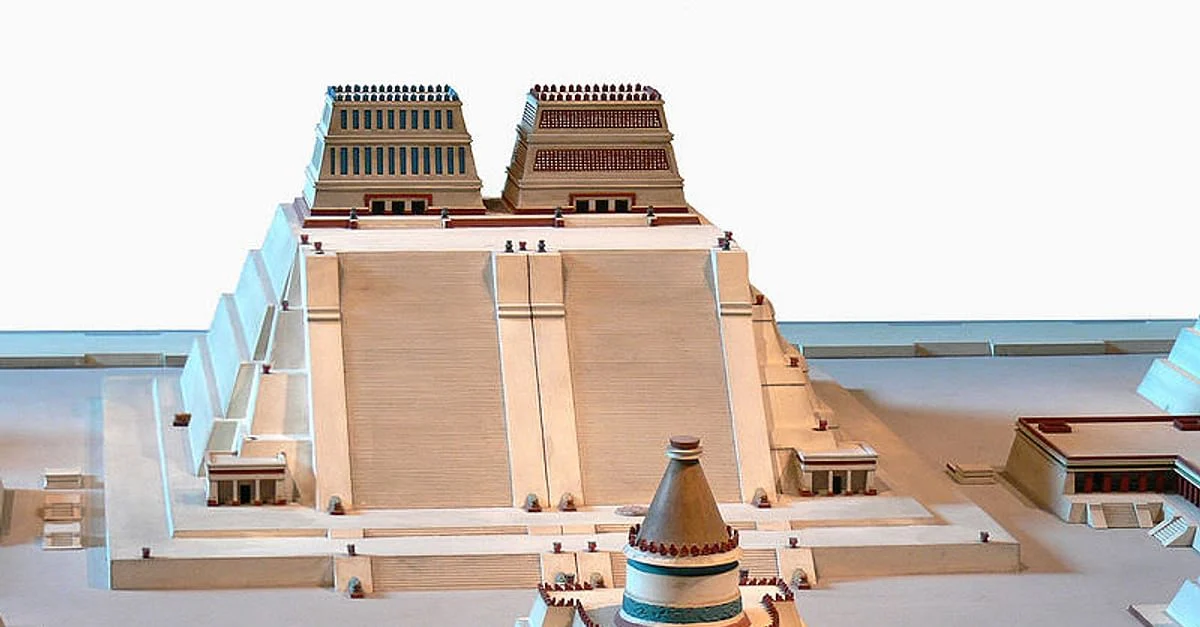
➼ Coyolxauhqui “She of the Golden Bells”
Details
- 1469
- volcanic stone
- Found in Museum of the Templo Mayor, Mexico City
Form
- Circular relief sculpture.
- Once brilliantly painted.
- So called because of the bells she wears as earrings.
Context
- Coyolxauhqui and her many brothers plotted the death of her mother, Coatlicue, who became pregnant after tucking a ball of feathers down her bosom.
- When Coyolxauhqui chopped off Coatlicue’s head, a child, Huitzilopochtli, popped out of the severed body fully grown and dismembered Coyolxauhqui, who fell dead at the base of the shrine.
- This stone represents the dismembered moon goddess, Coyolxauhqui, who is placed at the base of the twin pyramids of Tenochtitlán.
- Aztecs sacrificed people and then threw their dismembered remains down the steps of the temple as Huitzilopochtli did to Coyolxauhqui.
- Aztecs similarly dismembered enemies and threw them down the stairs of the great pyramid to land on the sculpture of Coyolxauhqui.
- A relationship was established between the death and decapitation of Coyolxauhqui with the sacrifice of enemies at the top of Aztec pyramids.

➼ Calendar Stone
Form: Made of basalt.
Context
- Aztecs felt they needed to feed the sun god human hearts and blood.
- A tongue in the center of the stone coming from the god’s mouth is a representation of a sacrificial flint knife used to slash open the victims.
- Circular shape reflects the cyclic nature of time.
- Two calendar systems, separate but intertwined.
- Calendars synced every fifty-two years in a time of danger, when the Aztecs felt a human sacrifice could ensure survival.
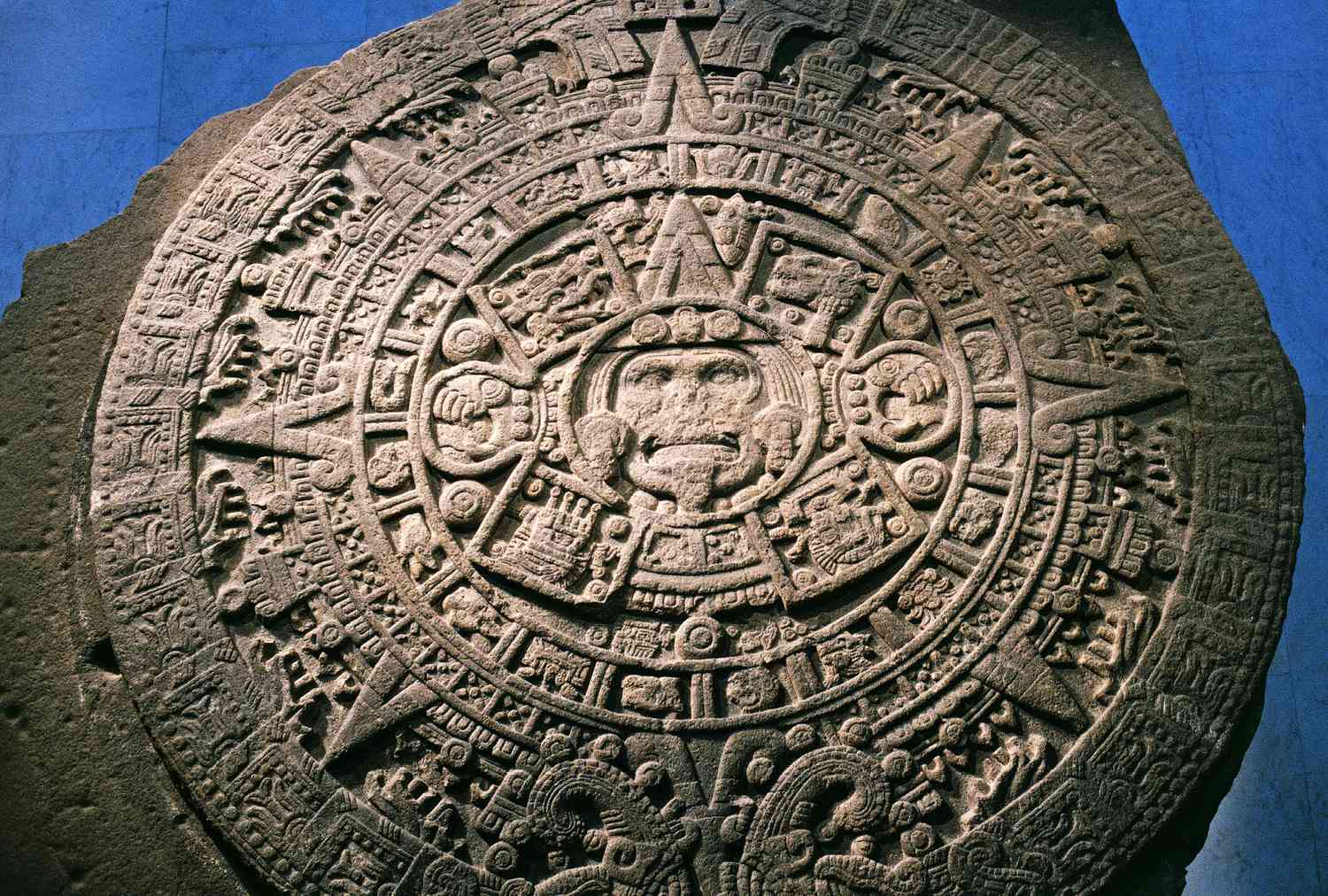
➼ Olmec-style Mask
Form: Made of jadeite.
Context
- Found on the site; actually a much older work executed by the Olmecs.
- Olmec works have a characteristic frown on the face; pugnacious visage; baby face; a cleft in the center of the head carved from greenstone.
- Shows that the Aztecs collected and embraced artwork from other cultures, including early Mexican cultures such as the Olmec and Teotihuacán.
- Shows that the Aztecs had a wide-ranging merchant network that traded historical items.
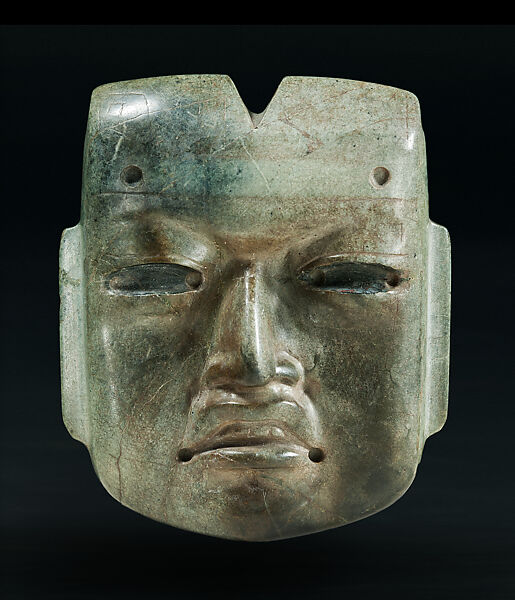
➼ Ruler’s Feather Headdress
Details:
- 1428–1520
- feathers (quetzal and blue cotinga) and gold
- Found in Museum of Ethnology, Vienna
Form
- Made from 400 long green feathers, the tails of the sacred quetzal birds; male birds produce only two such feathers each.
- The number 400 symbolizes eternity.
Function
- Ceremonial headdress of a ruler.
- Part of an elaborate costume.
Context
- Only known Aztec feather headdress in the world.
- Feathers indicate trading across the Aztec Empire.
- Headdress possibly part of a collection of artifacts given by Motechuzoma (Montezuma) to Cortez for Charles V of the Holy Roman Empire.
- Current dispute over ownership of the headdress; today it is housed in the Museum of Ethnology in Vienna, Austria.

➼ Maize cobs
Details
- c. 1440–1533
- sheet metal/repoussé, metal alloys
- Found in Staatliche Museen zu Berlin
Technique and Form
- Repoussé technique.
- Hollow metal object.
- Life-size.
Function
- May have been part of a garden in which full-sized metal sculptures of maize plants and other items were put in place alongside actual plants in the Qorinkancha garden.
- May have been used to ensure a successful harvest.
Context
- Maize was the principal food source in the Andes.
- Maize was celebrated by having sculptures fashioned out of sheet metal.
- Black maize was common in Peru; oxidized silver reflects that.
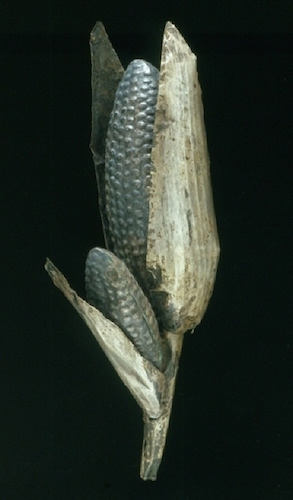
➼ City of Cusco
Details
- C. 1440
- Found in Peru
Form
- In the shape of the puma, a royal animal.
- Modern plaza is in the place where the puma’s belly would be.
- Head, a fortress; heart, a central square.
Function: Historic capital of the Inka Empire.
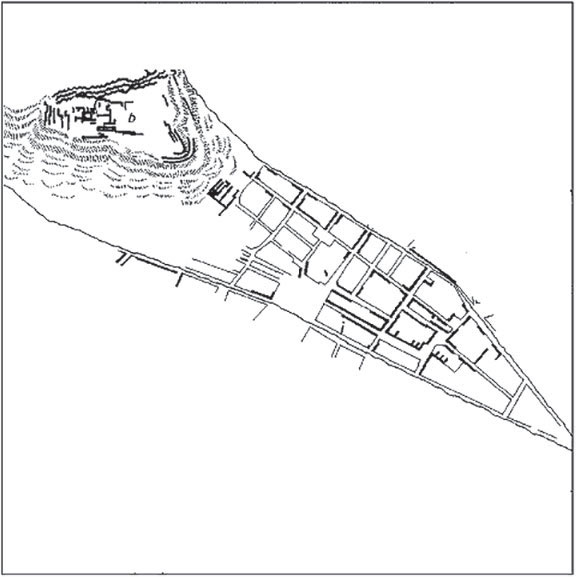
➼ Qorikancha
Details
- main temple, church, and convent of Santo Domingo
- c. 1440, convent added 1550–1650
- Andesite
- Found in Cusco, Peru
Form
- Ashlar masonry; carefully grooved and beveled edges of the stone fit together in a puzzle-like formation.
- Slight spacing among stones allows movement during earthquakes.
- Walls taper upward; examples of Inkan trapezoidal architecture.
- Temple displays Inkan use of interlocking stonework of great precision.
- Original exterior walls of the temple were decorated in gold to symbolize sunshine.
- Spanish chroniclers insist that the walls and floors of the temple were covered in gold.
Function
- Qorikancha: golden enclosure; once was the most important temple in the Inkan world.
- Once was an observatory for priests to chart the skies.
Context
- The location is important; placed at the convergence of the four main highways and connected to the four districts of the empire; the temple cemented the symbolic importance of religion, uniting the divergent cultural practices that were observed in the vast territory controlled by the Inkas.
- Remains of the Inkan Temple of the Sun form the base of the Santo Domingo convent built on top.
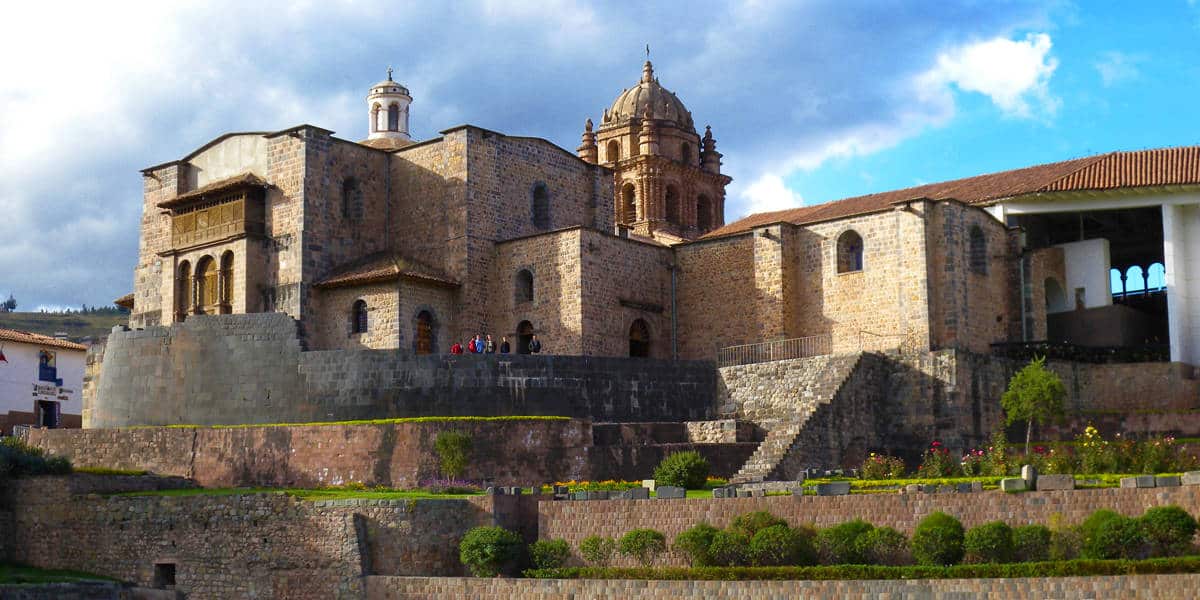
➼ Walls at Saqsa Waman (Sacsayhuaman)
Details
- c. 1440
- Sandstone
- Found in Peru
Form
- Ashlar masonry.
- Ramparts contain stones weighing up to seventy tons, brought from a quarry two miles away.
Context: Complex outside the city of Cusco, Peru, at the head of the puma-shaped plan of the city.
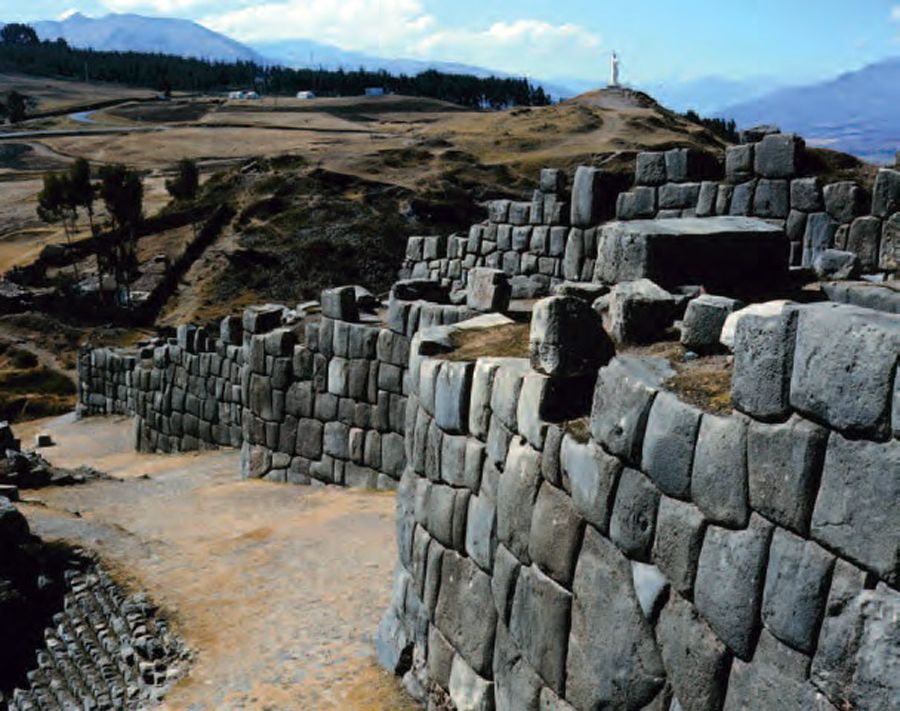
➼ Machu Picchu
Details
- 1450–1540
- Granite
- Found in Central Highlands, Peru
Form
- Buildings built of stone with perfectly carved rock rendered in precise shapes and grooved together; thatched roofs.
- Outward faces of the stones were smoothed and grooved.
- Two hundred buildings, mostly houses; some temples, palaces, and baths, and even an astronomical observatory; most in a basic trapezoidal shape.
- Entryways and windows are trapezoidal.
- People farmed on terraces.
Function
- Originally functioned as a royal retreat.
- The estate of fifteenth-century Inkan rulers.
- So remote that it was probably not used for administrative purposes in the Inkan world.
- Peaceful center: many bones were uncovered, but none of them indicate war-like behavior.

➼ Observatory in Machu Picchu
Details
- 1450–1540
- Granite
- Found in Peru
Form
- Ashlar masonry.
- Highest point at Machu Picchu.
Function
- Used to chart the sun’s movements; also known as the Temple of the Sun.
- Left window: sun shines through on the morning of the winter solstice.
- Right window: sun shines through on the morning of the summer solstice.
- Devoted to the sun god.
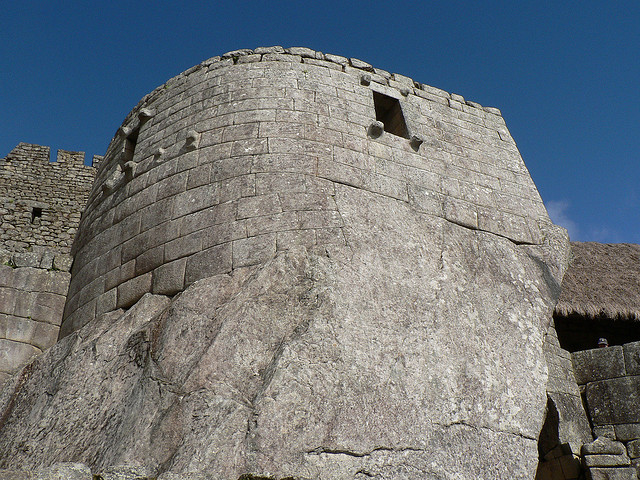
➼ Intihuatana Stone in Machu Picchu
Context
- Intihuatana means “hitching post of the sun”; aligns with the sun at the spring and the autumn equinoxes, when the sun stands directly over the pillar and thus creates no shadow.
- Inkan ceremonies held in concert with this event.

➼ All-T’oqapu Tunic
Details
- 1450–1540
- camelid fiber and cotton
- Found in Dumbarton Oaks, Washington, D.C.
Form
- Rectangular shape; a slit in the center is for the head; then the tunic is folded in half and the sides are sewn for the arms.
- The composition is composed of small rectangular shapes called t’oqapu.
- Individual t’oqapu may be symbolic of individuals, events, or places.
- This tunic contains a large number of t’oqapu.
Function
- Wearing such an elaborate garment indicates the status of the individual.
- May have been worn by an Inkan ruler.
Technique
- Woven on a backstrap loom.
- One end of the loom is tied to a tree or a post and the other end around the back of the weaver.
- The movement of the weaver can create alternating tensions in the fabric and achieve different results.
Context
- Exhibits Inkan preference for abstract designs, standardization of designs, and an expression of unity and order.
- Finest textiles made by women, a highly distinguished art form; this tunic has a hundred threads per square centimeter.
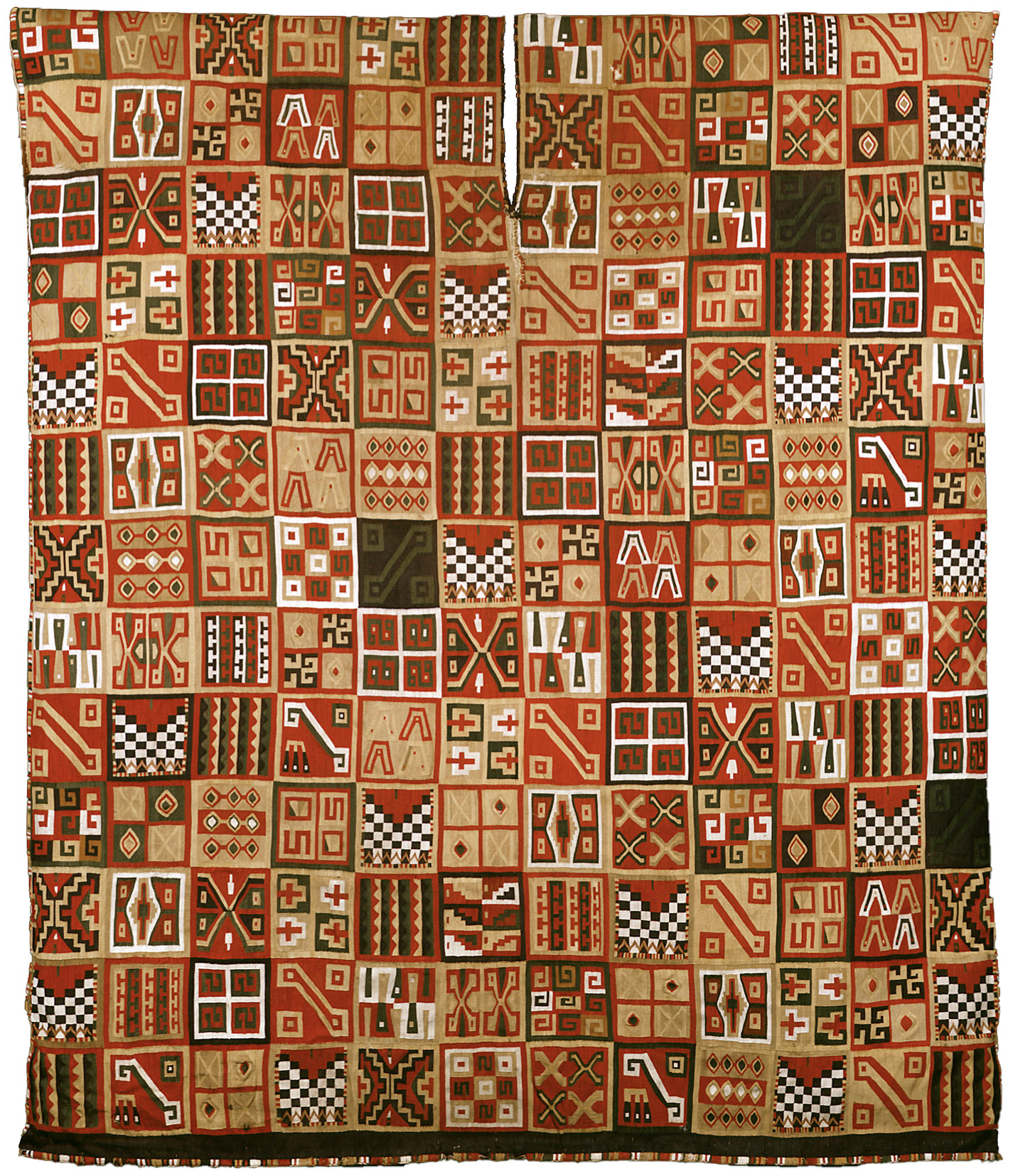
➼ Bandolier Bag
Details
- From Lenape (Delaware tribe, Eastern Woodlands)
- c. 1850
- beadwork on leather
- Found in Museum of the American Indian
Form
- The bandolier bag has a large, heavily beaded pouch with a slit on top.
- The bag was held at hip level with strap across the chest.
- The bag was constructed of trade cloth: cotton, wool, velvet, or leather.
Function
- It was made for men and women; objects of prestige.
- They were made by women.
- Functional and beautiful; acted also as a status symbol as part of an elaborate garb.
- Bandolier bags are still made and worn today.
Context
- Beadwork not done in the Americas before European contact.
- Beads and silk ribbons were imported from Europe.
- The bags contain both Native American and European motifs.
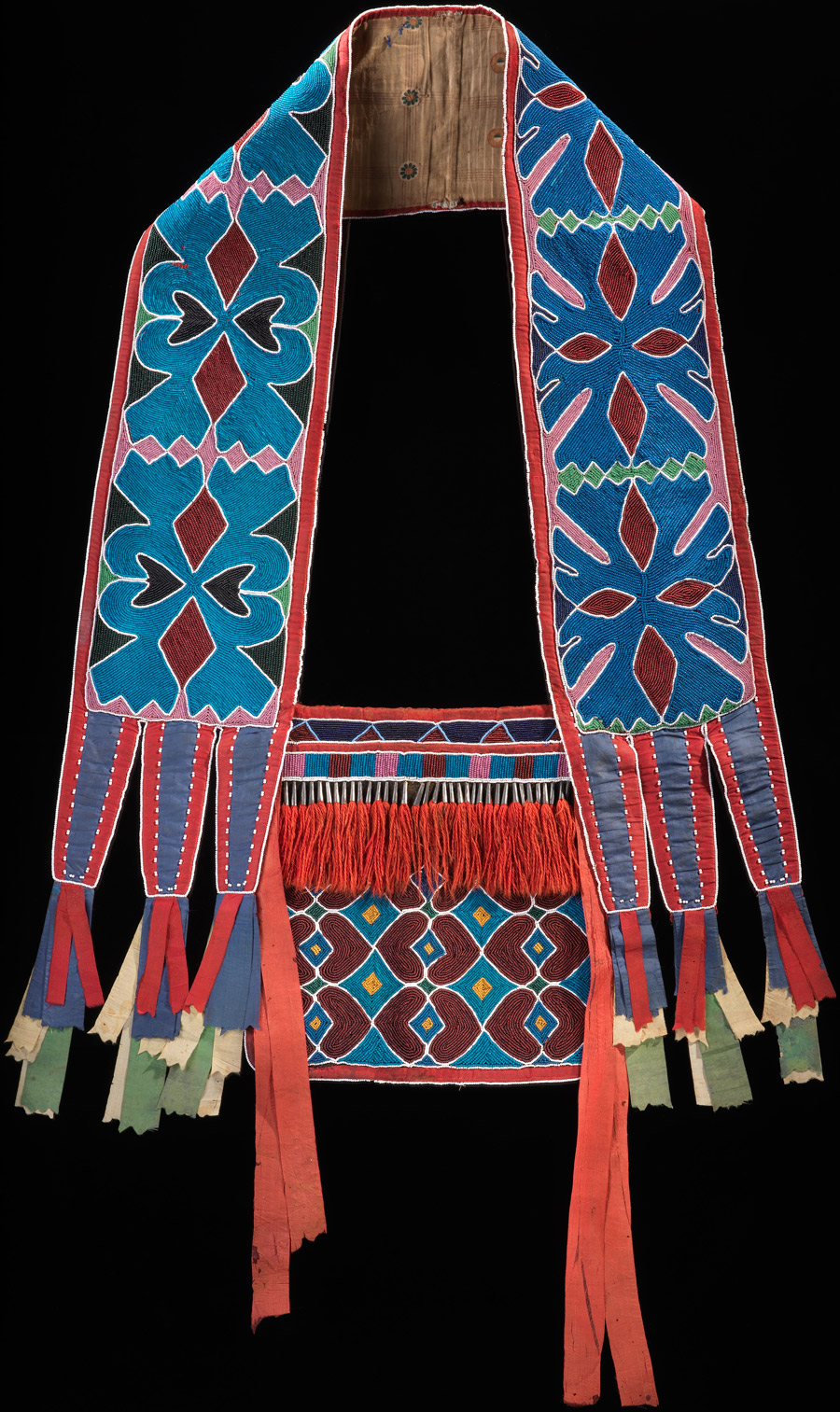
➼ Transformation Mask
Details
- From Kwakwaha’wakw, Northwest Coast of Canada
- late 19th century
- wood, paint, and string
- Found in Musée du Quai Branly-Jacques Chirac, Paris, France
Form: The mask has a birdlike exterior face; when opened, it reveals a second human face on the interior.
Function
- The masks were worn by native people of the Pacific. Northwest, centered on Vancouver Island.
- They were worn over the head as part of a complete body costume.
Context
- During a ritual performance, the wearer opens and closes the transformation mask using strings.
- At the moment of transformation, the performer turns his back to the audience to conceal the action and heighten the mystery.
- Opening the mask reveals the face of an ancestor; there is an ancestral element to the ceremony.
- Although these masks could be used at a potlatch, most often they were used in winter initiation rites ceremonies.
- The ceremony is accompanied by drumming and takes place in a “big house.”
- Masks are highly prized and often inherited.

➼ Hide Painting of the Sun Dance
Details
- Attributed to Cotsiogo (Cadzi Cody)
- Painted elk hide, Eastern Shoshone, Wind River Reservation, Wyoming,
- c. 1890–1900,
- Found in Brooklyn Museum, Brooklyn, New York
Content
- Depicts traditional aspects of the Plains people’s culture that were nostalgic rather than practical: bison hunted with bow and arrow—nomadic hunting gone; bison nearly extinct.
- Hide paintings mark past events.
- Bison considered to be gifts from the Creator.
- Horses, in common use around 1750, liberated the Plains people.
- Teepee: made of hide stretched over poles:
- Exterior poles reach the spirit world or sky.
- Fire represents the heart.
- The doorway faces east to greet the new day.
- The sun dance was conducted around a bison head, and was outlawed by the U.S. government; viewed as a threat to order.
- The sun dance involved men dancing, singing, preparing for the feast, drumming, and constructing a lodge. They honored the Creator deity for the bounty of the land.
- The warrior’s deeds were celebrated on the hide.
Function
- Worn as a robe over the shoulders of the warrior.
- Perhaps a wall hanging.
Context
- Depicts biographical details; personal accomplishments; heroism; battles.
- Men painted hides to narrate an event.
- Eventually, painted hides were made for European and American markets; tourist trade.
- Used paint and dyes obtained through trade.
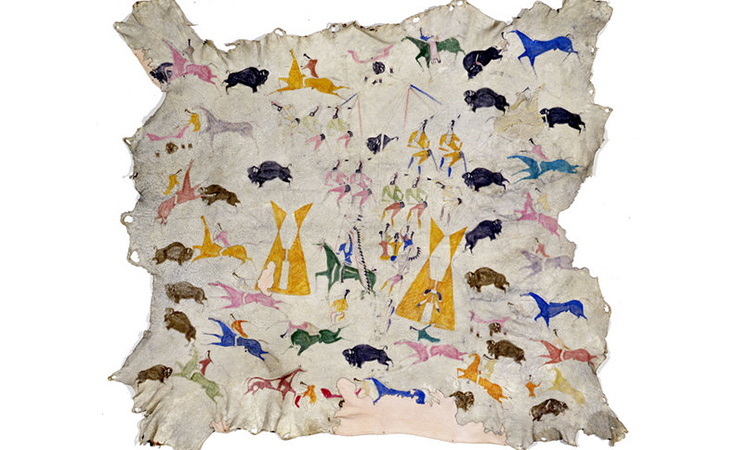
➼ Black-on-black Ceramic Vessel
Details
- By Maria Martínez and Julian Martínez
- From Tewa, Puebloan, San Ildefonso Pueblo, New Mexico, mid-20th century
- blackware ceramic
- Found in Smithsonian Museum of American Art, Washington, D.C..
Form
- Black-on-black vessel.
- Highly polished surface.
- Contrasting shiny black and matte black finishes.
- Exceptional symmetry; walls of even thickness; surfaces free of imperfections.
Function
- Comes from the thousand-year-old tradition of pottery making in the Southwest.
- Maria Martínez preferred making pots using a new technique that rendered a vessel lightweight, less hard, and not watertight, as traditional pots were; this kind of vessel reflected the market shift away from utilitarian vessels to decorative objects.
Technique
- Used a mixture of clay and volcanic ash.
- The surface was scraped to a smooth finish with a gourd tool and then polished with a stone.
- Julian Martínez painted designs with a liquid clay that yielded a matte finish in contrast with the high shine of the pot itself.
Context
- At the time of production, pueblos were in decline; modern life was replacing traditional life.
- Artists’ work sparked a revival of pueblo techniques.
- Maria Martínez, the potter, developed and invented new shapes beyond the traditional pueblo forms.
- Julian Martínez, the painter of the pots, revived the use of ancient mythic figures and designs on the pots.
- Reflects an influence of Art Deco designs popular at the time.
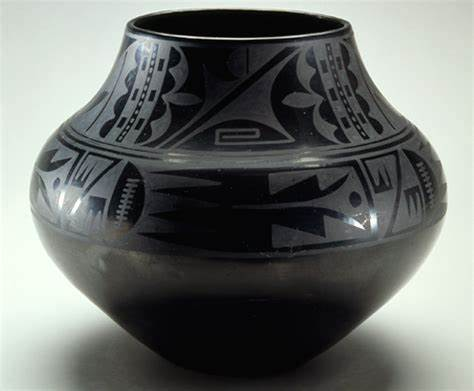
Unit 6: Africa, 1100–1980 CE
Contextualization of African Art
- African art has a long and rich history that dates back to prehistoric times.
- The continent's diverse cultures and civilizations have produced a wide range of artistic traditions, including sculpture, painting, textiles, and performance art.
- African art has been influenced by a variety of factors, including religion, politics, and social customs.
- The arrival of European colonizers in the 15th century had a significant impact on African art, as it led to the introduction of new materials and techniques, as well as the exportation of African art to Europe.
- In the 20th century, African art became increasingly recognized as a valuable and important cultural heritage, leading to the establishment of museums and galleries dedicated to African art around the world.
Architecture of African Art
- Mud and clay are the most common building materials used in African architecture.
- African architecture is known for its use of organic shapes and materials, such as thatched roofs and woven walls.
- African architecture is often designed to blend in with the surrounding landscape and environment.
- African architecture is often communal, with buildings serving multiple purposes and being used by multiple families or groups.
- African architecture often incorporates symbolic elements, such as the use of certain colors or patterns to represent specific ideas or beliefs.
Sculptures of African Art
- African sculptures are known for their expressive and abstract forms.
- They are often made from wood, metal, or clay.
- Sculptures are used for various purposes such as religious rituals, social status, and storytelling.
- African sculptures are characterized by their stylized features, exaggerated proportions, and intricate details.
- They often depict human figures, animals, and mythical creatures.
- Sculptures are created by skilled artisans who pass down their techniques through generations.
- African sculptures have influenced modern art movements such as cubism and expressionism.
- They are highly valued by collectors and museums around the world.
- Some famous examples of African sculptures include the Benin Bronzes, the Ife Head, and the Dogon Masks.
Cultural Context of African Art
- African art is deeply rooted in the cultural context of the continent.
- It reflects the diverse traditions, beliefs, and customs of the people who created it.
- African art is often functional, serving a specific purpose within the community, such as religious or ceremonial objects.
- It is also characterized by its use of symbolism and abstraction, which convey important cultural messages.
- African art has influenced many modern artists and continues to be an important part of the continent's cultural heritage.
Materials, Processes, and Techniques of African Art
- Materials
- African art is made from a wide range of materials including wood, metal, ivory, clay, stone, and textiles.
- Wood is the most commonly used material in African art due to its abundance and ease of carving.
- Metal is used for casting sculptures and creating intricate jewelry.
- Ivory is used for carving small figurines and decorative objects.
- Clay is used for creating pottery and sculptures.
- Textiles are used for creating clothing, blankets, and other decorative items.
- Processes/Techniques
- African art is created using a variety of processes including carving, casting, weaving, and painting.
- Carving is the most common process used in African art and involves using a chisel or knife to shape wood, ivory, or stone.
- Casting is used to create metal sculptures and involves pouring molten metal into a mold.
- Weaving is used to create textiles and involves interlacing threads or fibers.
- Painting is used to decorate sculptures, pottery, and textiles.
African Artworks
➼ Great Zimbabwe
Details
- Shona peoples (Southeastern Zimbabwe)
- c. 1000–1400
- coursed granite blocks
- Found in Zimbabwe
Form
- Walls: 800 feet long, 32 feet tall; 17 feet thick at base.
- Walls slope inward toward the top; made of exfoliated granite blocks.
Function
- Zimbabwe was a prosperous trading center and royal complex; items from as far away as Persia and China have been found.
- Stone enclosure was probably a royal residence.
Context
- Zimbabwe derives from a Shona term meaning “venerated houses” or “houses of stone.”
- Internal and external passageways are tightly bounded, narrow, and long; occupants are forced to walk in single file, paralleling experiences in the African bush.
- The conical tower is modeled on traditional shapes of grain silos; control over food symbolized wealth, power, and royal largesse.
- The tower resembles a granary and represented a good harvest and prosperity; grain gathered, stored, and dispensed as a symbol of royal power.
- Abandoned in the fifteenth century probably because the surrounding area could no longer supply food and there was extensive deforestation.
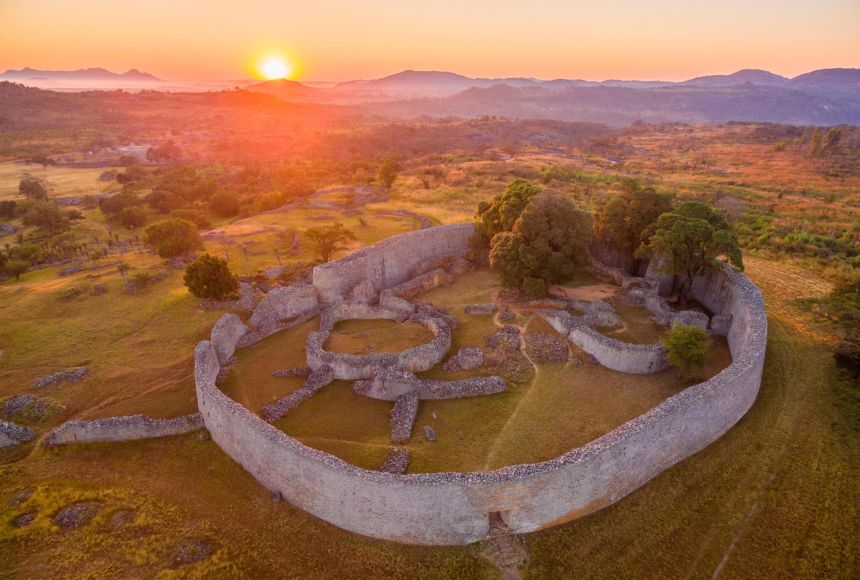
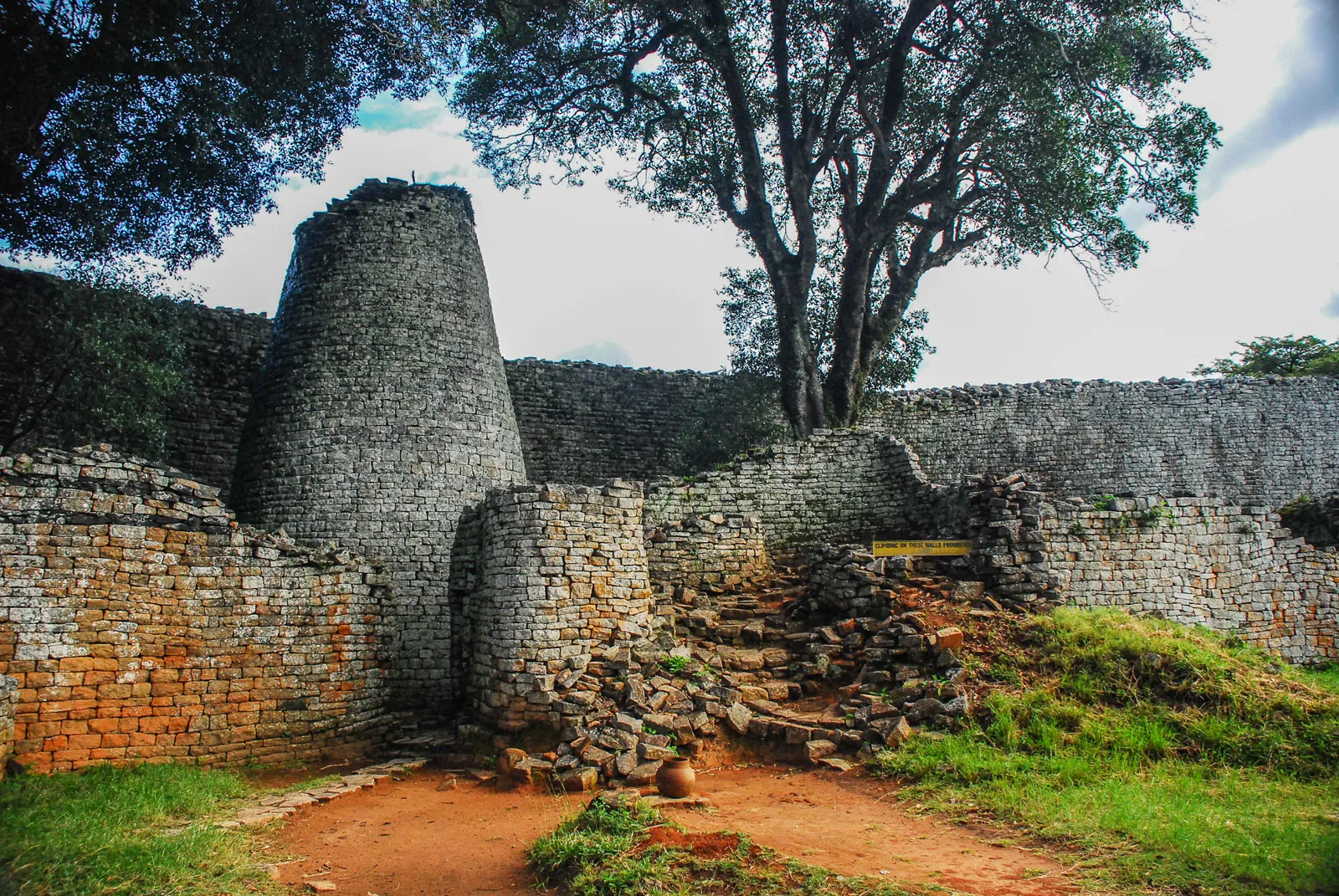
➼ Great Mosque of Djenné
Details
- founded c. 1200, rebuilt 1906–1907
- An adobe
- Found in Djenné, Mali
Form
- Three tall towers; center tower is a mihrab.
- Vertical fluting drains water off the surfaces quickly.
Materials
- Made of adobe, a baked mixture of clay and straw; adobe helps maintain cooler temperatures.
- Torons: wooden beams projecting from walls.
- Wooden beams act as in-place ladders for the maintenance of the building.
Function: Largest mud-brick mosque in the world.
Content
- Crowning ornaments have ostrich eggs, symbols of fertility and purity.
- Roof has several holes with terra cotta lids to circulate air into the main room.
Context
- Inhabited since 250 B.C.E., Djenné became a market center and an important link in the trans-Saharan gold trade.
- Two thousand traditional houses survive, built on small hills to protect against seasonal floods.
- Once a year there is a community activity to repair the mosque called Crepissago de la Grand Mosquée.
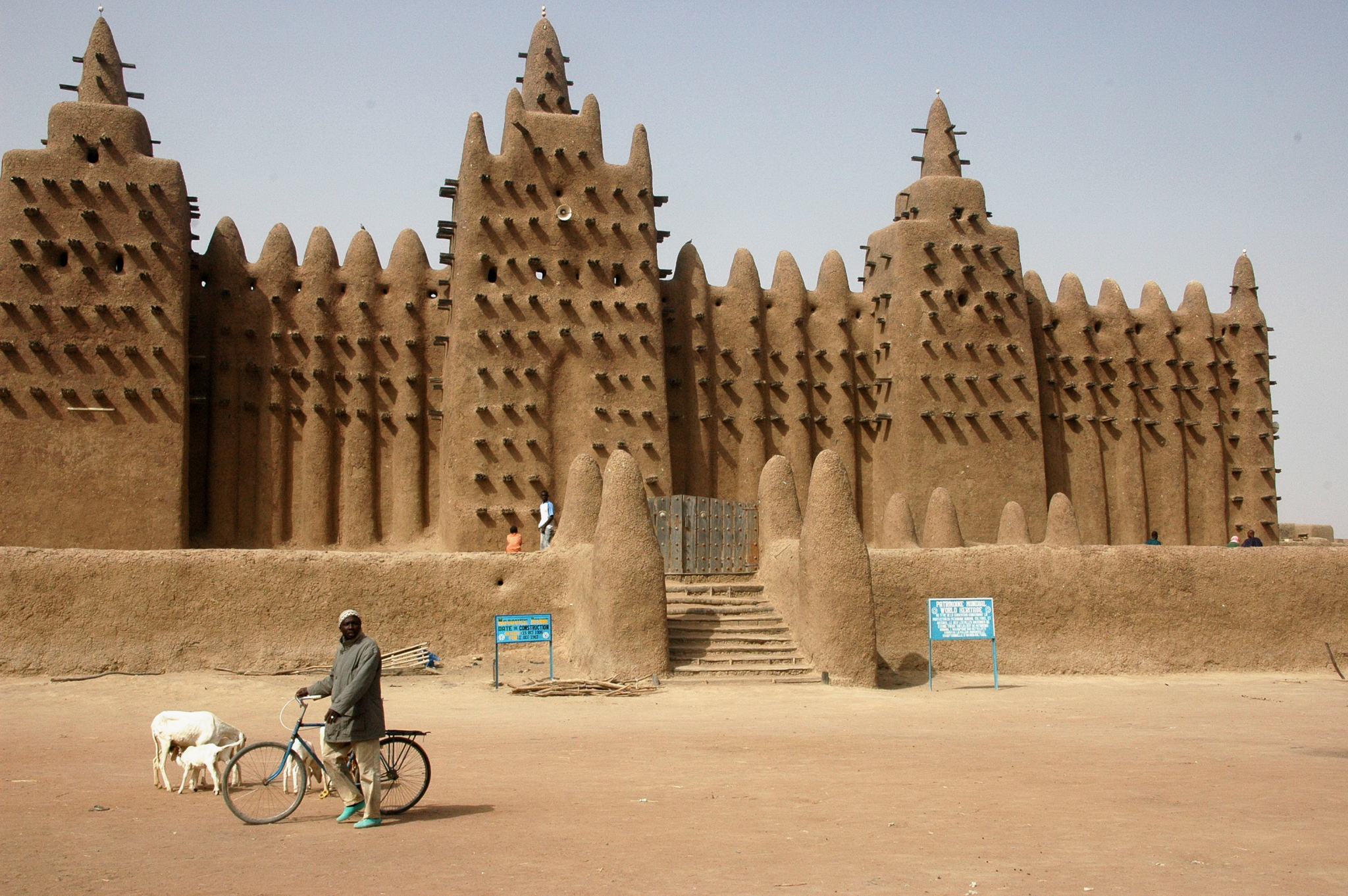
➼ Benin Wall Plaque
Details
- from Oba’s palace, Edo peoples, Kingdom of Benin (Nigeria)
- 16th century
- cast brass
- Found in Metropolitan Museum of Art, New York
Materials
- One of 900 brass plaques produced, each between 16 and 18 inches.
- Metal products are rare in Africa, making these objects extremely valuable.
- There was an active trade with the Portuguese for brass.
Function
- It decorated the walls of the royal palace in Benin.
- It was part of a sprawling palace complex; wooden pillars covered with brass plaques.
Context: Shows aspects of court life in the Benin culture
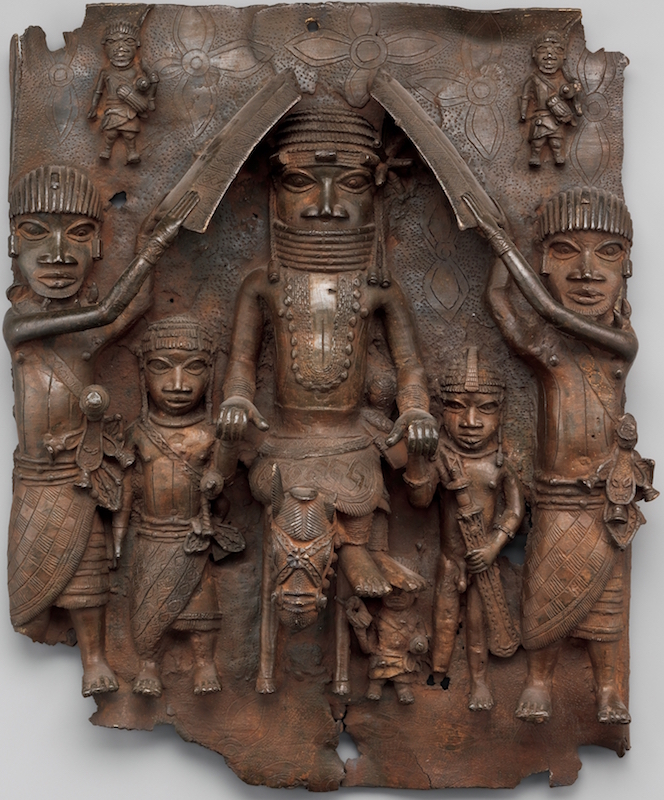
➼ Golden Stool of Ashanti (Sika Dwa Kofi)
Details
- Ashanti peoples (south central Ghana)
- c. 1700
- gold over wood, and cast gold attachments
- location unknown
Form
- Entire surface inlaid with gold.
- Bells hang from the side to warn the king of danger.
- Replicas often used in ceremonies, but each replica is different.
Function
- Symbol of the Ashanti nation, in Ghana.
- Contains the soul of the nation.
- Never actually used as a stool; never allowed to touch the ground; it is placed on a stool of its own.
- According to Ashanti tradition, it was brought down from heaven by a priest and fell into the lap of the Ashanti king, Osei Tutu.
- It became the repository of the spirit of the nation; it is the symbol of the mystical bond among all Ashanti.
Context
- A new king is raised over the stool.
- The stool is carried to the king on a pillow; he alone is allowed to touch it.
- Taken out on special occasions.
- War of the Golden Stool: March–September 1900:
- Conflict over British sovereignty in Ghana (formerly the Gold Coast).
- A British representative who tried to sit on the stool caused an uproar and a subsequent rebellion.
- The war ended with British annexation and Ashanti de facto independence.
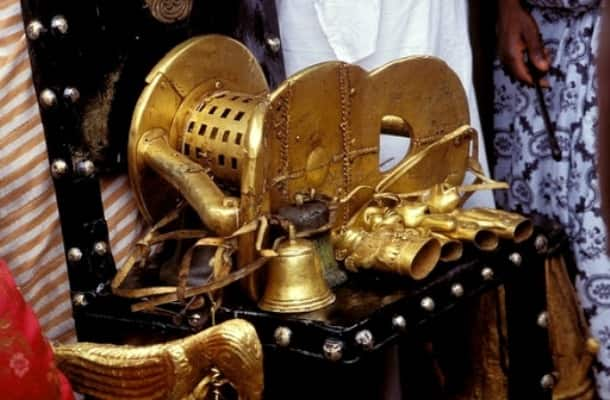
➼ Ndop (portrait figure) of King Mishe miShyaang maMbul
Details
- Kuba peoples, Democratic Republic of the Congo
- 1760–1780
- Wood
- Found in Brooklyn Museum, Brooklyn, New York
Form
- Characteristics of a ndop:
- Cross-legged pose.
- Sits on a base.
- Epicene body.
- Face seems uninvolved, above mortal affairs.
- A peace knife in his left hand.
- Royal regalia: bracelets, arm bands, belts, headdress.
Function
- Ndop sculptures are commemorative portraits of Kuba rulers, presented in an ideal state.
- Not an actual representation of a deceased king but of his spirit.
- Made after the death of the king.
Context
- Each king is commemorated by symbols on the base of the figure; this king has a sword in his left hand in a nonaggressive pose, handle facing out.
- One of the earliest existing African wood sculptures; oldest ndop in existence.
- Rubbed with oil to protect it from insects.
- Acted as a surrogate for the king in his absence.
- Kept in the king’s shrine with other works called a set of “royal charms.”
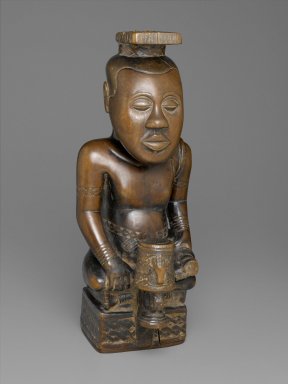
➼ Power Figure (Nkisi n’kondi)
Details
- Kongo peoples, Democratic Republic of the Congo
- c. late 19th century
- wood and metal
- Found in Metropolitan Museum of Art, New York
Form
- Alert pose.
- Rigid frontality.
- Arms akimbo, in an aggressive stance.
- Wears a headdress worn by chiefs or priests.
- Nails are pounded into the figure.
Function and Context
- Spirits are embedded in the images.
- Spirits can be called upon to bless or harm others, cause death or give life.
- In order to prod the image into action, nails and blades are often inserted into the work or removed from it.
- Medical properties are inserted into the body cavity, thought to be a person’s life or soul.
- The figure has a role as a witness and enforcer of community affairs.
- The figure also cautions people on the consequences of actions contrary to community norms.
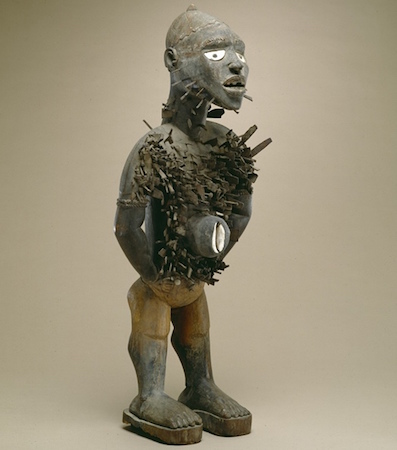
➼ Portrait Mask (Mblo) of Moya Yanso
Details
- Baule peoples (Côte d’Ivoire)
- early 20th century
- wood and pigment
Form
- Broad forehead, pronounced downcast eye sockets, column-shaped nose: features associated with intellect and respect.
- Quiet faces; introspective look; peaceful face; meditative; eyebrows in an arch.
Function
- Presented at Mblo performances in which an individual is honored with ritual dances; tributes are performed in his or her honor.
- The dancer who wears the mask and wears the clothes of the person for the performance is accompanied by the actual person in the performance.
- The honoree receives a mask—an artistic double of the person—as a gift.
Context
- The masks are commissioned by a group of admirers, not by an individual; this one was made by the artist Owie Kimou.
- The masks are an idealized representation of a real person.
- This is the idealized representation of Moya Yanso.
- From the Ivory Coast.
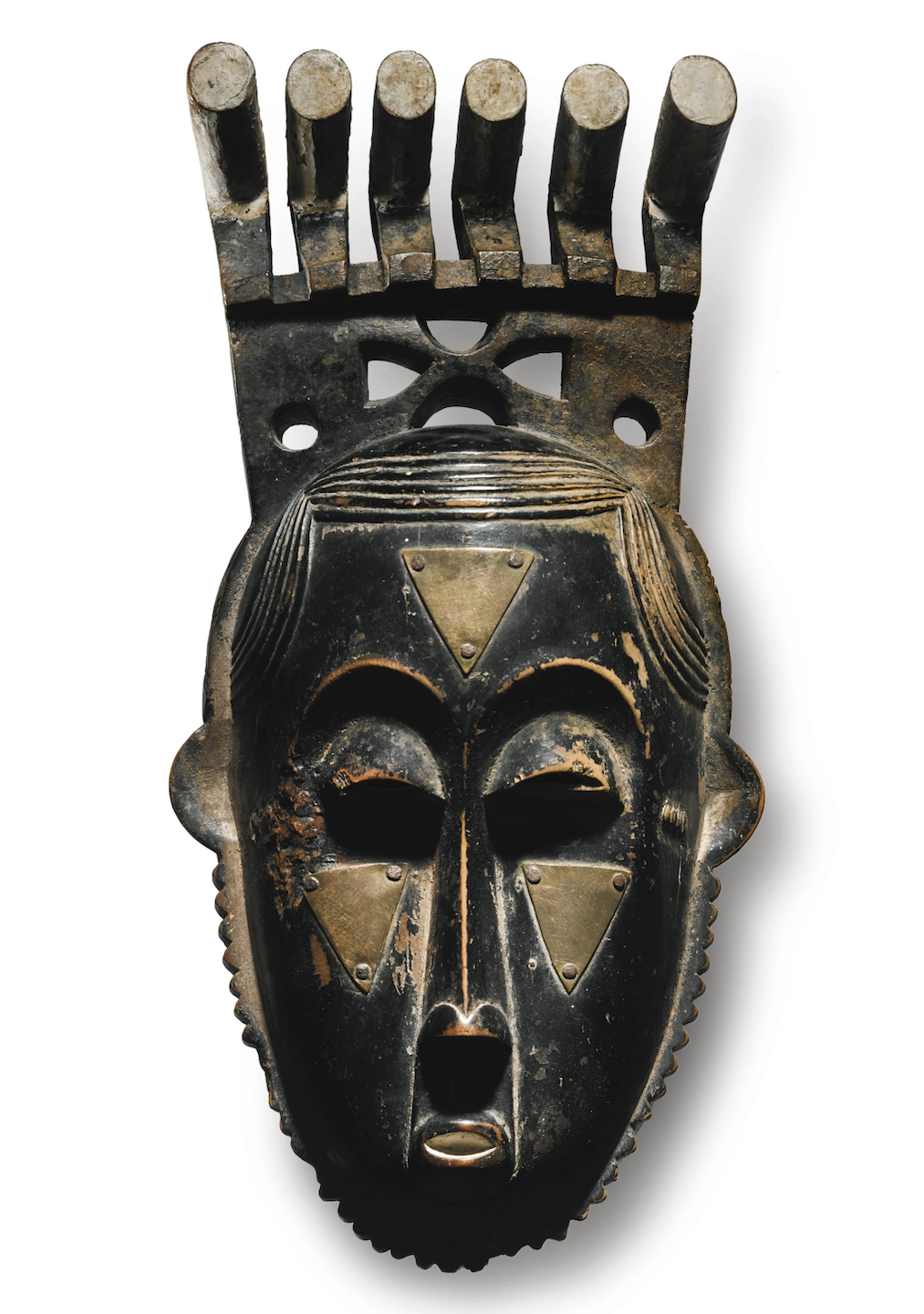
➼ Female (Pwo) Mask
Details
- Chokwe peoples, Democratic Republic of the Congo
- late 19th to early 20th century
- wood, fiber, pigment, and metal
- Found in National Museum of African Art, Washington, D.C.
Form
- Characteristics:
- Enlarged eye sockets.
- Pushed-in chin.
- Slender nose.
- High forehead.
- Balanced features.
- Almost-closed eyes.
Content
- Marks around the eyes may suggest tears; scarification marks including cosmogram on forehead.
- White powder around the eyes connects the figure to a spiritual realm.
Function
- These are female masks used by men in ritual dances.
- Male dancers are covered with their identities masked; they are dressed as women with braided hair.
- During the ritual, men move like women.
- Depicts female ancestors.
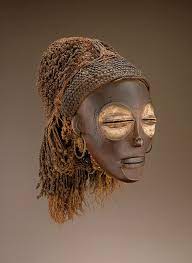
➼ Mende Bundu Mask
Details
- Sande society, Mende peoples (West African forests of Sierra Leone and Liberia)
- 19th to early 20th century
- wood, cloth, and fiber
- A private collection
Form
- Idealized female beauty, both physically and morally:
- Elaborate hairstyle symbolizes wealth; worn by women of status.
- High forehead indicates wisdom.
- Small eyes in the shape of slits: she should be demure.
- Tight-lipped mouth, symbolizing secrets not revealed.
- Small ears: avoids gossip.
- Rings around the neck symbolize concentric waves from which the water spirit, Sowei, breaks through the surface; also symbolizes the fat associated with a pregnant body.
- Small horizontal features.
Function
- Used for initiation rites to adulthood.
- Used by the elder women of the Sande society, a group of women who prepare girls for adulthood and their role in society.
- Mask rests on woman’s head; head is not placed inside the mask.
- Mask is coated with palm oil for a lustrous effect; it has a shiny black surface.
- Black color symbolizes water, coolness, and humanity.
Context
- Only African wooden masks that are worn by women.
- Costumed women wear a black gown made of raffia that hides the body.
- Costumed as a Sowei, the female water spirit.
- Female ancestor spirits.
- Symbolic of the chrysalis of a butterfly; young woman entering puberty.
- Individuality of each mask is stressed.

➼ Ikenga (Shrine Figure)
Details
- Igbo peoples (Nigeria)
- c. 19th to 20th century
- Wood
- Found in Brooklyn Museum, Brooklyn, New York
Function and Content
- Ikenga means “strong right arm” and thus physical prowess.
- It honors the right hand, which holds tools or weapons, makes sacrifices, conducts rituals, and alerts to speak at public forums.
- Ikenga embraces traditional masculine associations of strength and potency.
- Often a mix of human, animal, and abstract forms.
- Carved from hardwoods, considered masculine.
- It tells of the owner’s morality, prosperity, achievements, genealogy, and social rank.
Context
- Enormous horns symbolize power.
- Requires blessings before use; consecrated with offerings before kinsmen.
- As the man achieves more success, he might commission a more elaborate version.
- It is maintained in the man’s home and is destroyed when the owner dies; another can reuse it if not destroyed.
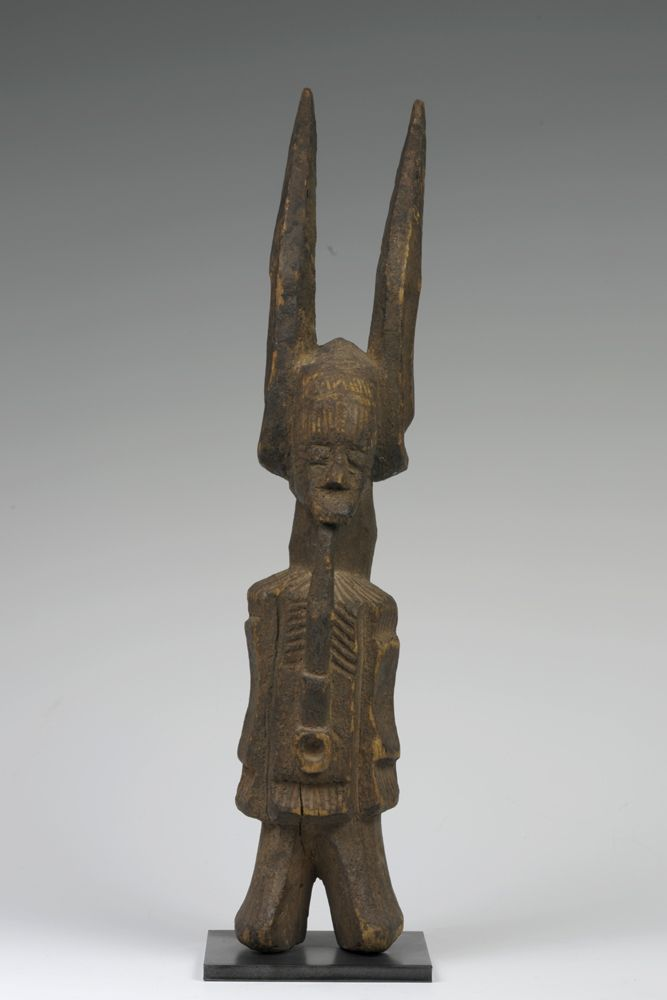
➼ Lukasa (Memory Board)
Details
- Mbudye Society, Luba peoples, Democratic Republic of the Congo
- c. 19th to 20th century
- wood, beads, and metal
- Found in Brooklyn Museum, Brooklyn, New York
Form
- Carved from wood in an hourglass shape and adorned with beads, shells, or metal.
- Back, expressed by Luba people as the “outside,” resembles the shell of a turtle.
Function
- Court historian who serves as reader of the memory board holds the lukasa in his left hand and gently touches the beads that he will discuss with his right index finger.
- Ability to read the board is limited to a few people.
- Memory board helps the user remember key elements in a story; for example:
- Court ceremonies.
- Migrations.
- Heroes.
- Kinship.
- Genealogy.
- Lists of kings.
Context
- Each board’s design is unique and represents the divine revelations of a spirit medium expressed in sculptural form.
- Memory boards are controlled by the Mbudye, a council of men and women who interpret the political and historical aspects of Luba society.
- Zoomorphic elements represented by the turtle, an animal that lives on both land and water; the dual nature of the turtle is a metaphor for the Luba people’s political organization as founded by two distinctly opposed embodiments of power: Kongolo Mwamba, avatar of all excess and tyranny, and Mbidi Kiluwe, sophisticated cultural hero who introduced royal culture to the Luba people.
- Reading example:
- One colored bead can stand for an individual.
- Large beads surrounded by smaller beads can signify a ruler and his court.
- Lines of beads are journeys or paths, migrations or genealogies.
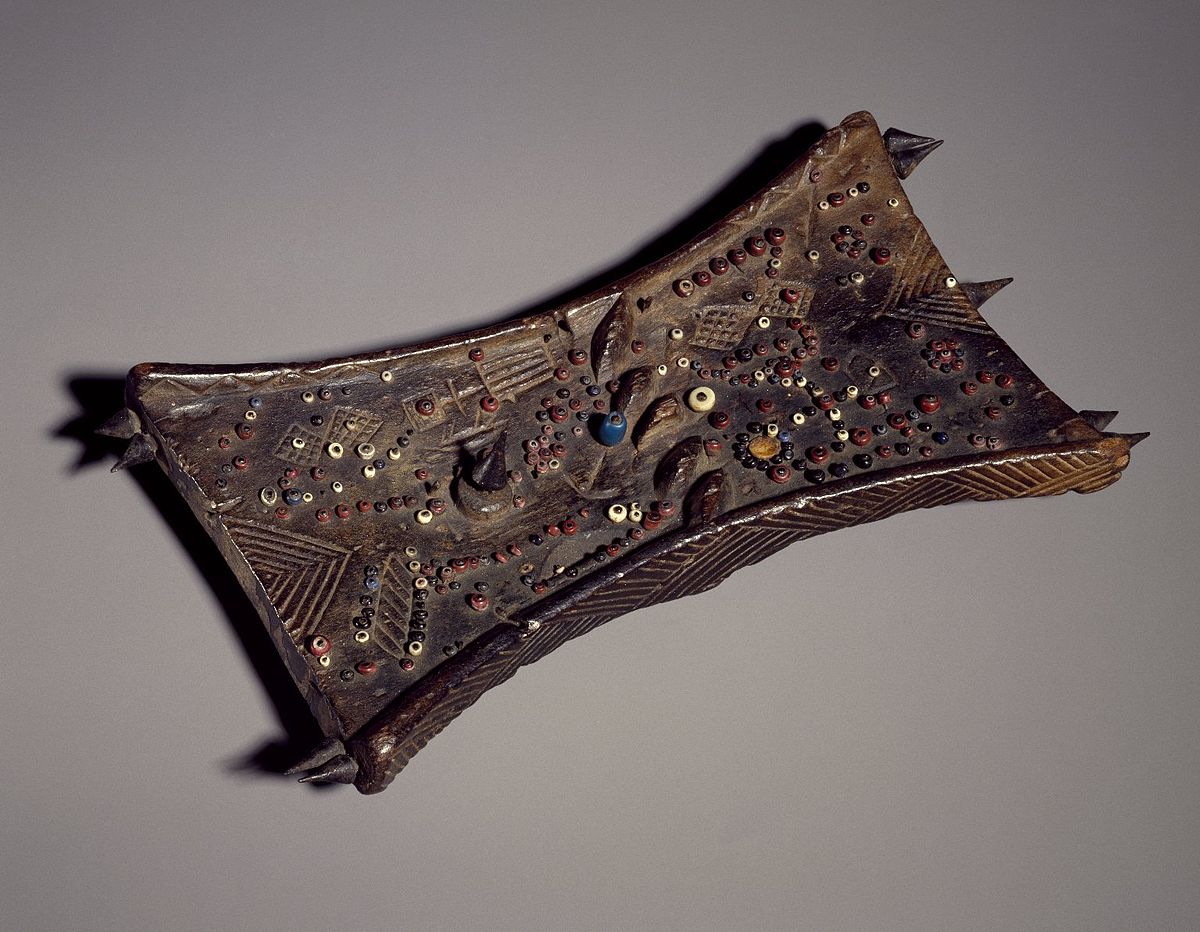
➼ Aka Elephant Mask
Details
- Cameroon (western grasslands region)
- c. 19th to 20th century
- wood, woven raffia, cloth, and beads
- Found in Brooklyn Museum, Brooklyn, New York
Form
- The mask has the features of an elephant: long trunk, large ears (symbolizing strength and power).
- The mask fits over the head and two folds hang down in front (symbolizing the trunk) and behind the body.
- Human face.
Materials
- Beadwork on a fabric backing; beadwork is a symbol of power.
- Lavish use of colored beads and cowrie shells displays the wealth of the members of the men’s Kuosi society; the colors and patterns express the society’s cosmic and political functions.
Function
- Elite Kuosi masking society owns and wears the masks; worn on important ceremonial occasions.
- Only important people in society can own and wear an elephant mask.
Context
- Performance art: maskers dance barefoot to a drum and gong; they wave spears and horsetails.
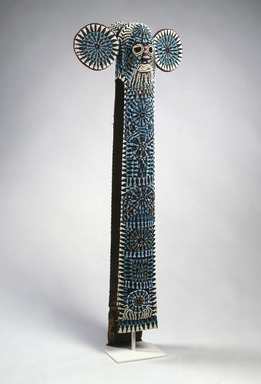
➼ Reliquary Figure (byeri)
Details
- Fang peoples (southern Cameroon)
- c. 19th to 20th century
- Wood
- Found in Brooklyn Museum, Brooklyn, New York
Form
- Feet dangling over the rim, a gesture of protecting the contents.
- Prominent belly button and genitals emphasize life; the prayerful gesture and somber look emphasize death.
- Emphasis on the head and the tubular nature of the body.
Function
- Such figures were placed on top of cylinder-like containers made of bark that held skulls and other bones of important clan leaders.
- The reliquary figure guards the head box against the gaze of women or young boys.
Context
- The surfaces were ritually rubbed with oils to add luster and protect against insects.
- Byeri figures are composed of characteristics the Fang people place a high value on: tranquility, introspection, and vitality.
- The Fang people were nomadic; these figures were made to be portable.
- The abstraction of the human body is an attraction for the early-twentieth-century artists.
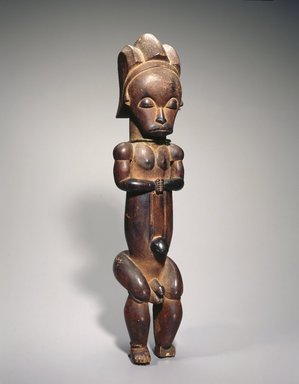
➼ Veranda Post of Enthroned King and Senior Wife (Opo Ogoga)
Details
- Olowe of Ise (Yoruba peoples)
- 1910–1914
- wood and pigment
- Found in Art Institute of Chicago, Chicago, Illinois
Form
- Wooden sculpture with tall vertical emphasis.
- Complicated and elaborate use of negative space.
- Negative space creates an openness in the composition.
- Most veranda posts were painted; this work has traces of paint remaining.
Function
- Olowe of Ise carved veranda posts for the rulers of the Ekiti-Yoruba kingdom in Nigeria.
- One of four carved for the palace at Ikere, Nigeria.
Context
- The king is the focal point between himself and others represented on the post.
- Behind the king, his large-scale senior wife supports the throne.
- She crowns the king during the coronation; protects him during his reign.
- The smaller figures include his junior wife; his flute player, Eshu, the trickster god; and a figure of a fan bearer now missing.
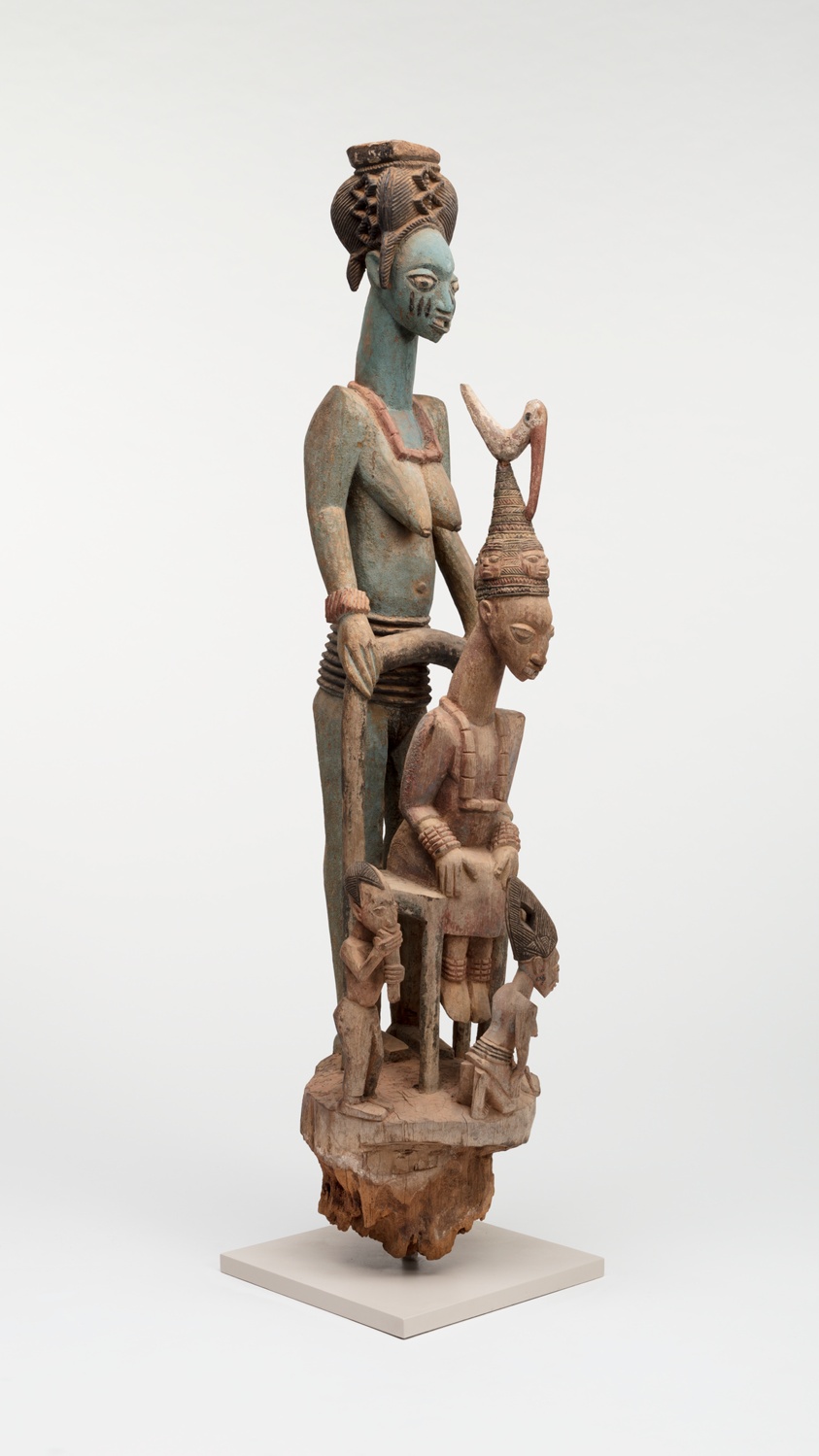
Unit 7: West and Central Asia, 500 BCE–1980 CE
Contextualization of West and Central Asia
West Asia Art
- Islamic art: geometric patterns, calligraphy, arabesque designs
- Persian art: miniature paintings, carpets, ceramics
- Mesopotamian art: ziggurats, cuneiform writing, cylinder seals
- Ottoman art: Iznik pottery, Turkish carpets, illuminated manuscripts
- Ancient Egyptian art: hieroglyphics, pyramids, sphinxes
- Byzantine art: mosaics, icons, frescoes
- Jewish art: illuminated manuscripts, synagogue architecture, menorahs
- Armenian art: khachkars (cross-stones), illuminated manuscripts, carpets
- Sumerian art: votive statues, steles, jewelry
- Phoenician art: purple dye, glassware, ivory carvings
Central Asia Art
- Central Asia is a vast region that includes countries such as Kazakhstan, Uzbekistan, Turkmenistan, Kyrgyzstan, and Tajikistan.
- The art of Central Asia is heavily influenced by the region's nomadic lifestyle and Islamic culture.
- Traditional art forms include carpet weaving, embroidery, pottery, and metalwork.
- Islamic calligraphy and geometric patterns are commonly found in Central Asian art.
- The Silk Road, an ancient trade route that passed through Central Asia, played a significant role in the region's art and cultural exchange.
- Contemporary Central Asian artists are exploring new mediums and themes, often addressing political and social issues.
Styles and Art Forms of West and Central Asian Art
- Metal Work
- The region has a long history of metalworking, dating back to ancient times.
- Skilled metalworkers used a variety of techniques to create intricate metal vessels decorated with geometric patterns, floral motifs, and calligraphy.
- They also produced weapons and armor for both humans and horses, often decorated with intricate designs.
- The metalwork of this region is a testament to the skill and creativity of its metalworkers and continues to be admired and studied by art historians and collectors worldwide.
- Ceramics
- The region is known for producing high-quality ceramics with intricate designs and vibrant colors.
- One of the most famous types of ceramics from the region is Iznik pottery, which was produced in the Ottoman Empire and is characterized by its blue and white floral designs.
- Another notable type of ceramics is Persian pottery, which often features intricate geometric patterns and calligraphy.
- Central Asian ceramics, such as those produced in Uzbekistan and Tajikistan, are known for their bright colors and bold designs.
- Many of these ceramics were used for practical purposes, such as storing food and water, but they were also highly valued as decorative objects.
- Calligraphy, Painting and Textiles
- Calligraphy, the art of beautiful writing, is a prominent feature in Islamic art and is often used to decorate religious texts and manuscripts.
- Painting in West and Central Asian art is characterized by intricate designs, bold colors, and intricate patterns.
- Textiles, such as carpets and tapestries, are also highly valued in this region and are often decorated with intricate patterns and designs.
West and Central Asian Artworks
➼ Pyxis of al-Mughir
Details
- From Umayyad
- 968, ivory
- Found in Louvre, Paris
- Pyxis: a small cylinder-shaped container with a detachable lid used to contain cosmetics or jewelry
Form
- Horror vacui.
- Vegetal and geometric motifs. Material
- Intricately carved container made from elephant ivory.
Function
- Container for expensive aromatics, sometimes also used to hold jewels, gems, or seals.
- Gift for the caliph’s younger son.
Content: Four polylobed medallion scenes showing pleasure activities of the royal court: hunting, falconry, sports, music.
Context
- Calligraphic inscription in Arabic names the owner, asks for Allah’s blessings, and includes the date of the pyxis.
- From Muslim Spain.
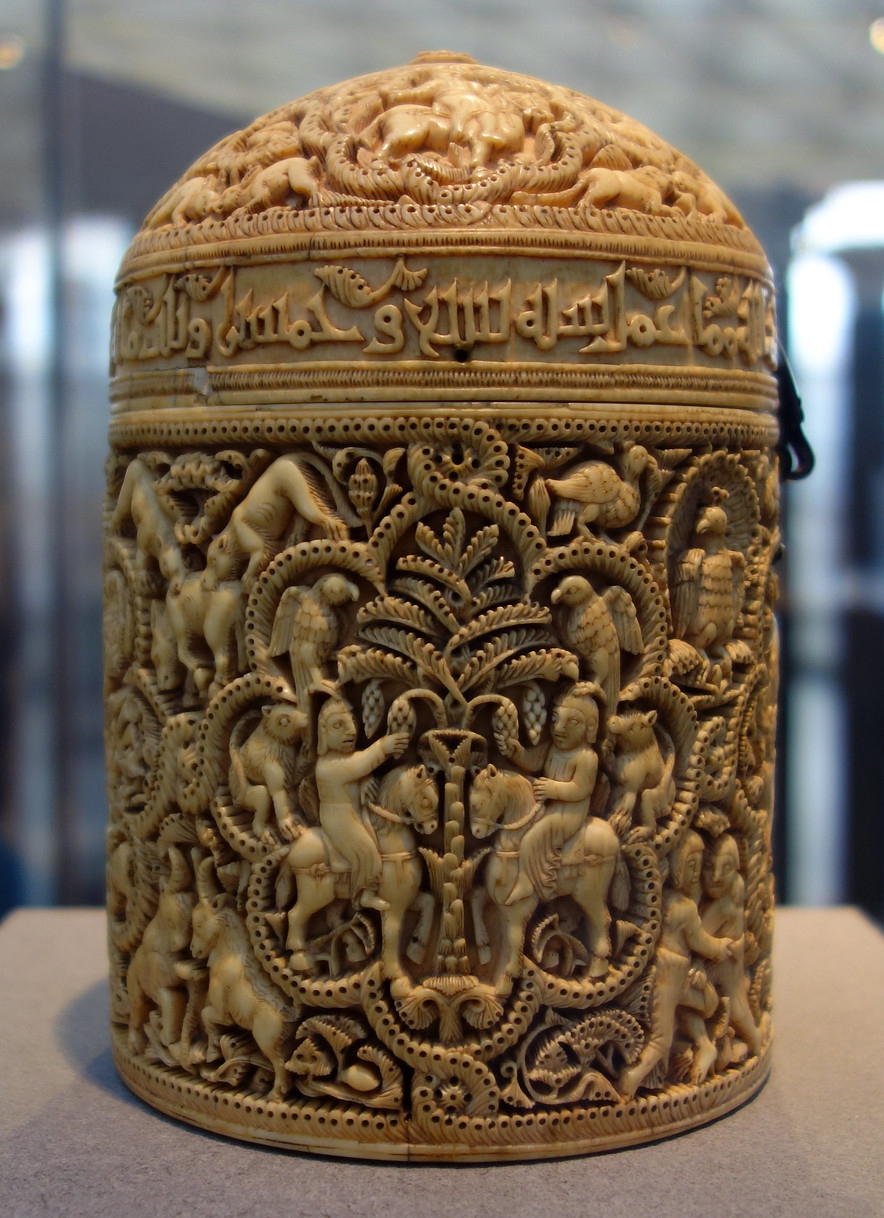
➼ Folio from a Qur’an, Arab
Details
- North Africa or Near East, Abbasid
- 8th–9th century
- Made of ink, color, and gold on parchment
- Found in Pierpont Morgan Library, New York
Form
- The title of each chapter is scripted in gold.
- Script is rigidly aligned in strong horizontal letters well-spaced apart in brown ink.
- Kufic script; strong uprights and long horizontals.
- Great clarity of text is important because several readers read a book at once, some at a distance.
- Arabic reads right to left.
- Consonants are scripted, vowels are indicated by dots or markings around the other letters.
- The diacritical markings of short diagonal lines and red dots indicate vocalizations.
- Pyramids of six gold discs mark the ends of ayat (verses).
Function: The Qur’an is the Muslim holy book.
Context
- Qur’ans were compiled and codified in the mid-seventh century; however, the earliest surviving Qur’an is from the ninth century.
- Calligraphy is greatly prized in Qur’anic texts; elaborate divine words needed the best artists.
- Illustrated is the heading of sura 29 (al-’Ankabūt, or “The Spider”) in gold.
- The text indicates that those who believe in protectors other than Allah are like spiders who build flimsy homes.
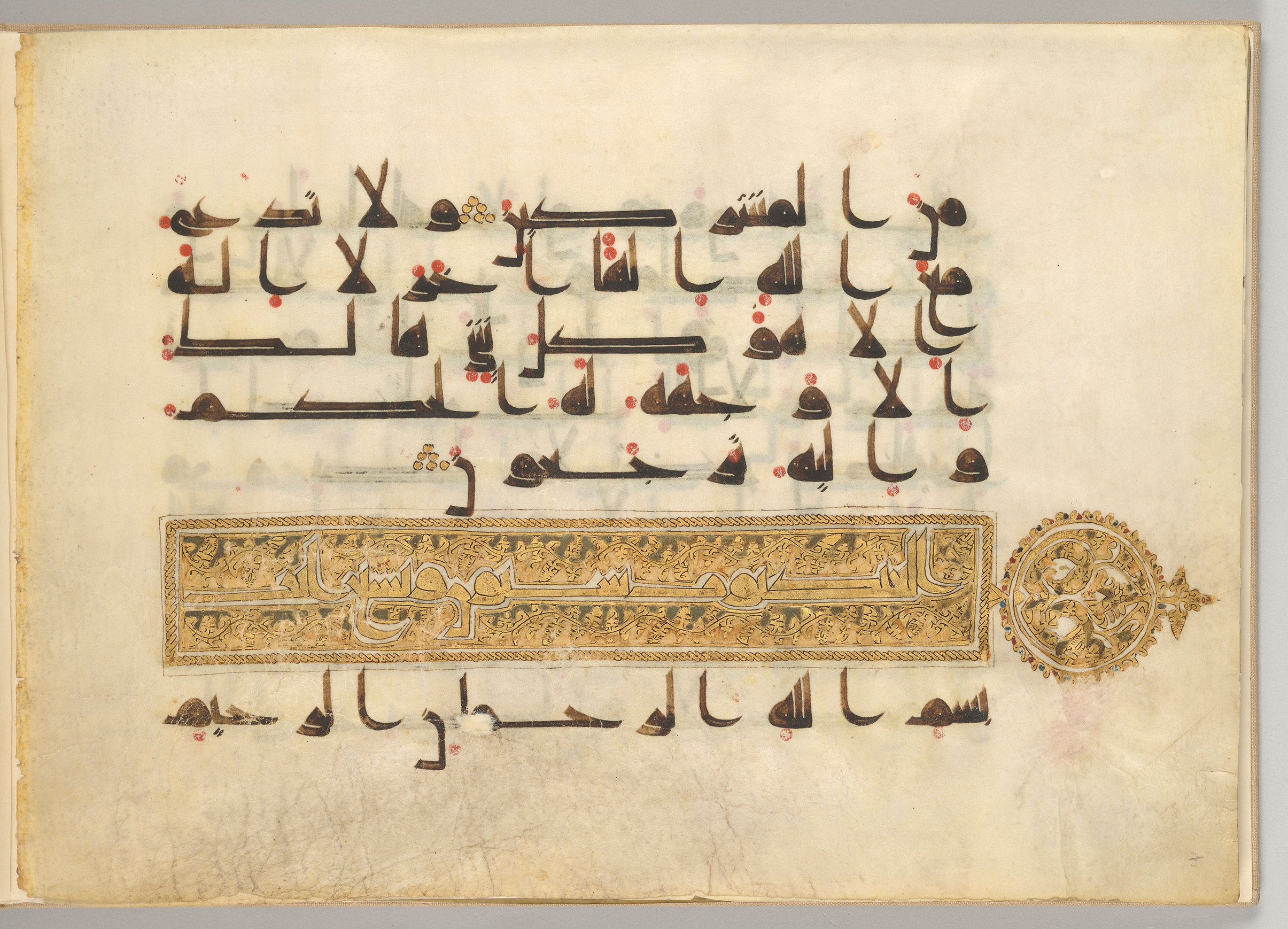
➼ Basin (Baptistère de Saint Louis)
Details
- Designed by Muhammad ibn al-Zain
- 1320–1340
- Maid of brass inlaid with gold and silver
- Found in Louvre, Paris
Function
- Original use is for ceremonial hand washing; perhaps a banqueting piece.
- Later use is for baptisms for the French royal family; coats-of-arms originally on the work were reworked with French fleur-de-lys.
Content
- Signed by the artist six times.
- Hunting scenes alternate with battle scenes along the side of the bowl.
- Mamluk hunters and Mongol enemies.
- Bottom of bowl decorated with fish, eels, crabs, frogs, and crocodiles.
Patronage
- There is no patron or date identifying the work, although some scholars feel that the basin is connected to the amir Salar (d. 1310), whose image may be prominently depicted on one of the roundels.
- In that regard, it may have been a gift from Salar to a sultan.
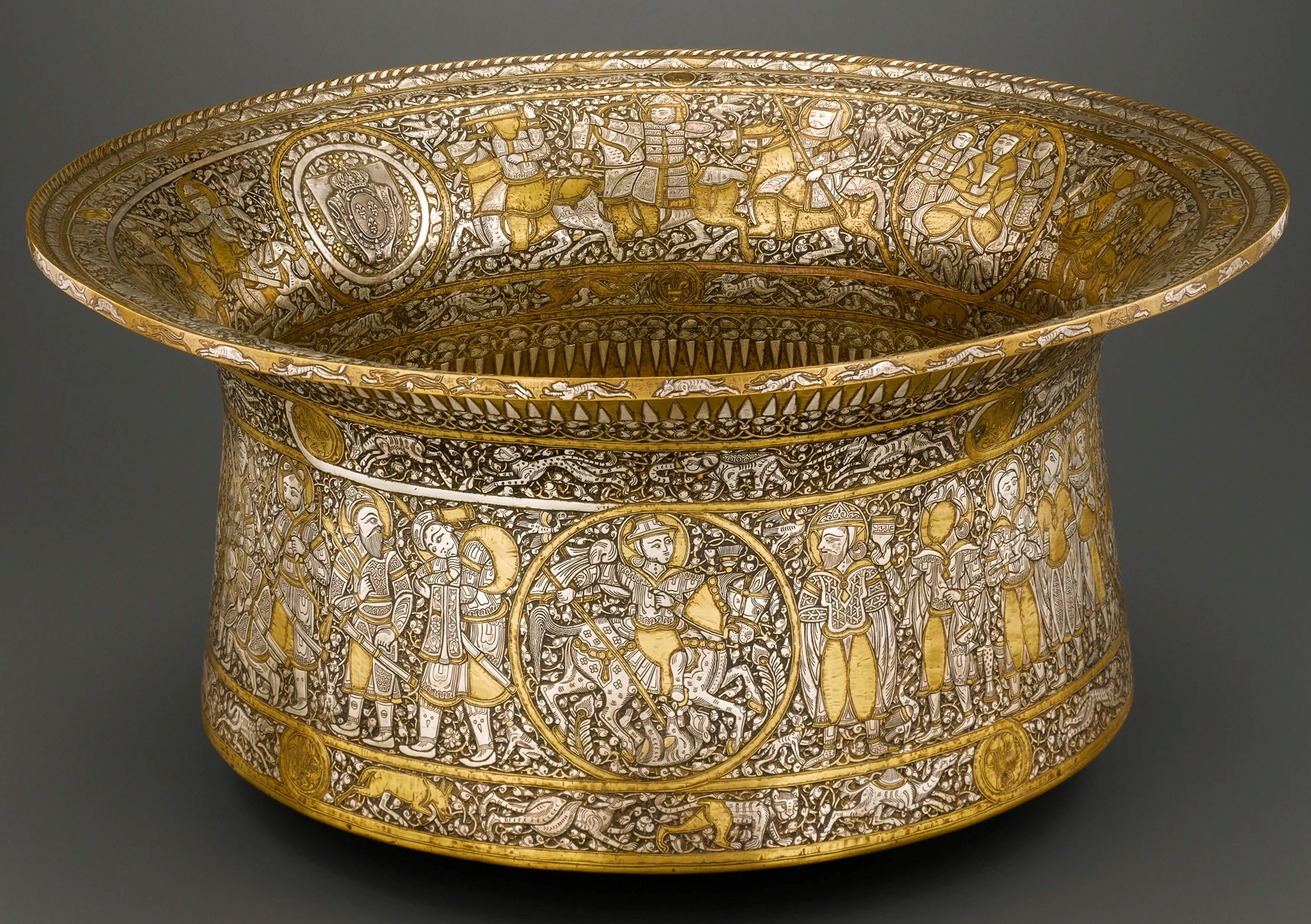
➼ The Ardabil Carpet
Details
- Designed by Maqsud of Kashan
- 1539–1540
- Made of silk and wool
- Victoria and Albert Museum, London
Function
- Prayer carpet used at a pilgrimage site of a Sufi saint.
- Huge carpet, one of a matching pair, from the funerary mosque of Shayik Safial-Din; probably made when the shrine was enlarged.
- The companion carpet is in the Los Angeles County Museum of Art.
Materials
- Wool carpet, woven by ten people, probably men; although women also did weaving in this period.
- The importance of the location and the size of the project indicate that men were entrusted with its execution.
Technique: Wool pile of 5,300 knots per 10 cm. sq.; allows for great detail.
Content
- Medallion in center of carpet may represent the inside of a dome with 16 pendants.
- Mosque lamps hang from two of the pendants; because one lamp is smaller than the other, the larger lamp is placed farther away so that it appears the same size as the smaller; some suggest that this is a deliberate flaw to reflect that God alone is perfect.
- Corner squinches also have pendants completing the feeling of looking into a dome.
- Inscription says, “Except for thy threshold, there is no refuge for me in all the world.
- Except for this door there is no resting-place for my head.
- The work of the slave of the portal, Masqud Kashani,” and the date, 946, in the Muslim calendar.
- The word “slave” in the inscription has been variously interpreted, but generally it is agreed that he was not a slave in the literal sense, but someone who was charged with executing the carpet.
Context: World’s oldest dated carpet.

➼ Bahram Gur Fights the Karg
Details
- Folio from the Great Il-Khanid Shahnama, Islamic; Persian
- c. 1330–1340
- Made of ink and opaque watercolor, gold, and silver on paper
- Found in Harvard University Art Gallery, Cambridge, Massachusetts
- Shahnama, or The Book of Kings: a long epic poem written by the Persian poet Firdawsi between c. 977 and 1010 c.e.; the national epic of Iran
Form
- Large painted surface area; calligraphy on the top and bottom frame the image.
- Areas of flat color.
- Spatial recession indicated by the overlapping planes.
- Atmospheric perspective seen in the light-bluish background.
Content
- Bahram Gur was an ancient Iranian king from the Sassanian dynasty.
- He represents the ideal king; wears a crown and a golden halo.
- Mongol artists of Persia sought to link themselves to great ancient Persian heroes shown as Mongol horsemen.
- A karg is a kind of unicorn or horned wolf he fought during his trip to India.
- Cross-cultural influences are Bahram Gur wears a garment of European fabric; Chinese landscape conventions can be seen in the background; these aspects connect the painting with trade along the Silk Road.
Context
- Its lavish production suggests it was commissioned by a high-ranking Ilkhanid court official and produced at the court scriptorium as a chronicle of great Persian kings.
- A high point of Persian manuscripts; very lavish.
- The original story by Firdawsi was written around 1010.
- Folio from the text called the Great Ilkhanid Shahnama, or the Book of Kings, a Persian epic.
- Originally one of 280 folios by several different artists; 57 pages survive.
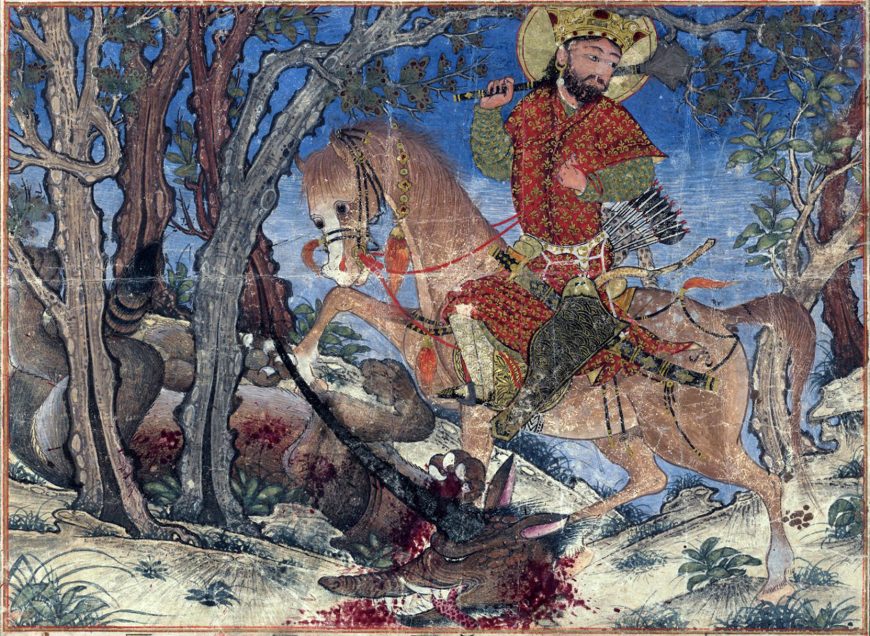
➼ The Court of Gayumars
Details
- Created by Sultan Muhammad
- From the Shah Tahmasp’s Shahnama
- 1522–1525
- Made of ink, opaque watercolor, and gold on paper
- Found in Aga Khan Museum, Toronto, Canada
Form
- Large painted surface area; calligraphy diminished.
- Harmony between man and landscape.
- Minute details do not overwhelm the harmony of the scene.
- Very richly and decoratively painted with vibrant colors.
- Minute scale suggest the use of fine brushes, perhaps of squirrel hairs.
Content
- This excerpt shows the first king of Iran, Gayumars, enthroned before his community, ruling from a mountaintop.
- During his reign, men learned how to prepare food and prepare leopard skins as clothing; wild animals are shown as meek and submissive.
- On left, his son Siyamak; on right, his grandson Hushang.
- His court appears in a semicircle below him; court attire includes the wearing of leopard skins.
- The angel Surush tells Gayumars that his son will be murdered by the Black Div, son of the demon Ahriman; his death will be avenged by Hushang, who will rescue the Iranian throne.
Context
- Persian manuscript.
- The original story by Firdawsi was written around 1010.
- Folio from the text called the Great Ilkhanid Shahnama or the Book of Kings, a Persian epic.
- Produced for the Safavid ruler of Iran, Shah Tahmasp I, who saw himself as part of a proud tradition of Persian kings.
- Whole book contains 258 illustrated pages.

➼ The Kaaba
Details
- Islamic and Pre-Islamic monument
- Rededicated by Muhammad in 631–632
- Multiple renovations; granite masonry, covered with silk curtain, and calligraphy in gold and silver-wrapped thread
- Found in Mecca, Saudi Arabia
Function
- Mecca is the spiritual center of Islam; this is the most sacred site in Islam.
- A large mosque surrounds the Kaaba.
- Destination for those making the hajj, or spiritual pilgrimage, to Mecca.
- Hajj: an Islamic pilgrimage to Mecca that is required of devout Muslims as one of the five pillars of Islam
- Pilgrims circumambulate the Kaaba counterclockwise seven times.
Materials
- The Kaaba is made of granite; the floor is made of marble and limestone.
- The Kaaba is covered by textiles; the cloth is called the Kiswa and is changed annually.
Context
- Kaaba means cube in Arabic; the Kaaba is cube-like in shape.
- Kaaba said to have been built by Ibrahim (Abraham, in the Western tradition) and Ishamel for God
- Existing structure encases the black stone in the eastern corner, the only part of the original structure by Ibrahim that survives.
- Has been repaired and reconstructed many times since Muhammad’s time.
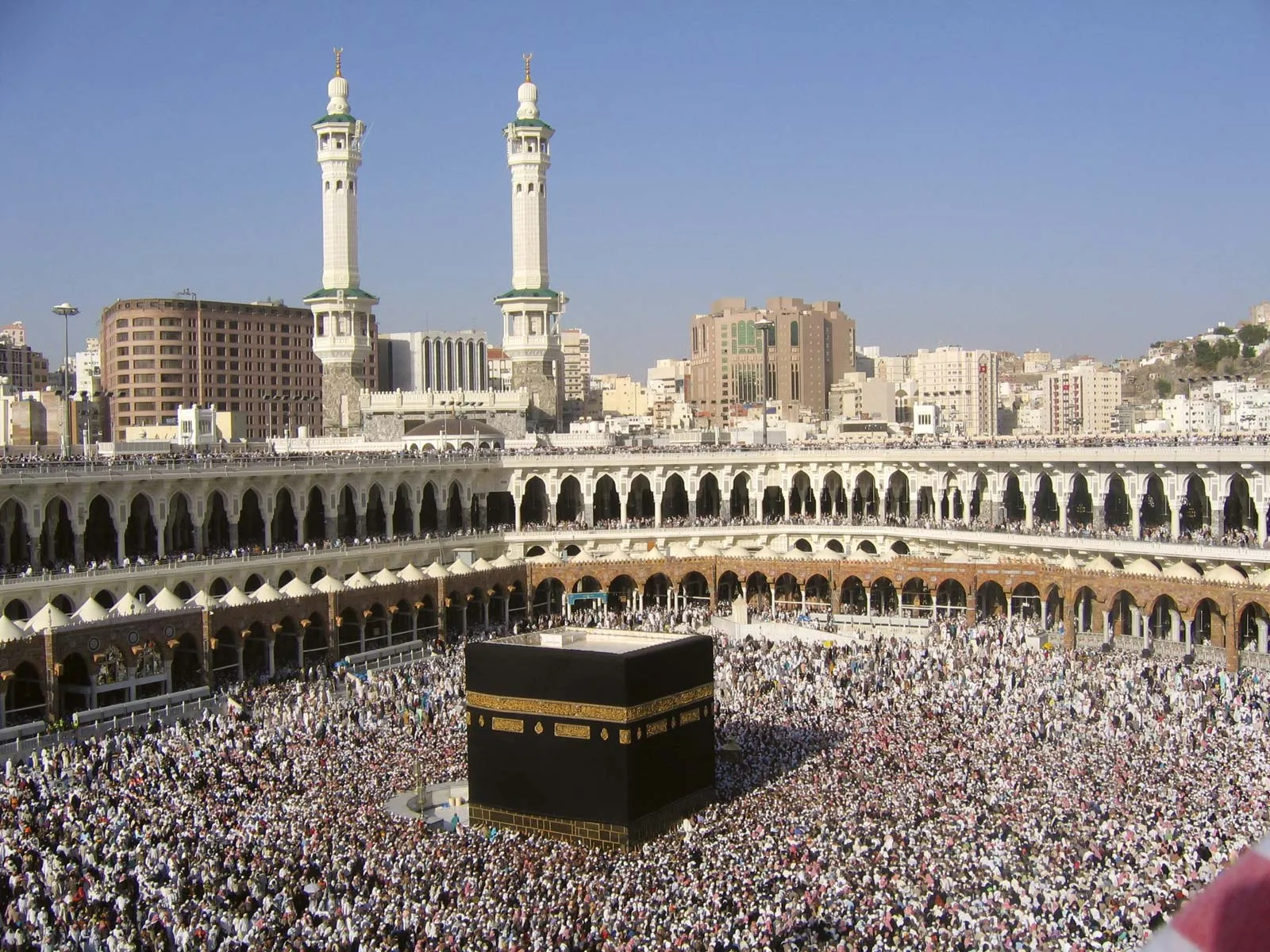
➼ Dome of the Rock
Details
- Islamic, Umayyad
- 691–692,
- With multiple renovations, stone masonry and wood roof decorated with glazed ceramic tile, mosaics, and gilt aluminum and bronze dome
- Found in Jerusalem
Form
- Domed wooden octagon.
- Influenced by centrally planned buildings
- Columns are spolia taken from Roman monuments.
Function
- Pilgrimage site for the faithful.
- Not a mosque; its original function has been debated.
Context
- This building houses several sacred sites:
- The place where Adam was born.
- The site in which Abraham nearly sacrificed Isaac.
- The place where Muhammad ascended to heaven (as described in the Qu’ran).
- The place where the Temple of Jerusalem was located.
- Meant to rival the Christian church of the Holy Sepulcher in Jerusalem, although it was inspired by its domed rotunda.
- Arabic calligraphy on the mosaic decoration urges Muslims to embrace Allah as the one God and indicates that the Christian notion of the Trinity is an aspect of polytheism.
- Oldest surviving Qur’an verses; first use of Qur’an verses in architecture; one of the oldest Muslim buildings.
- Erected by Abd al-Malik, caliph of the Umayyad Dynasty.
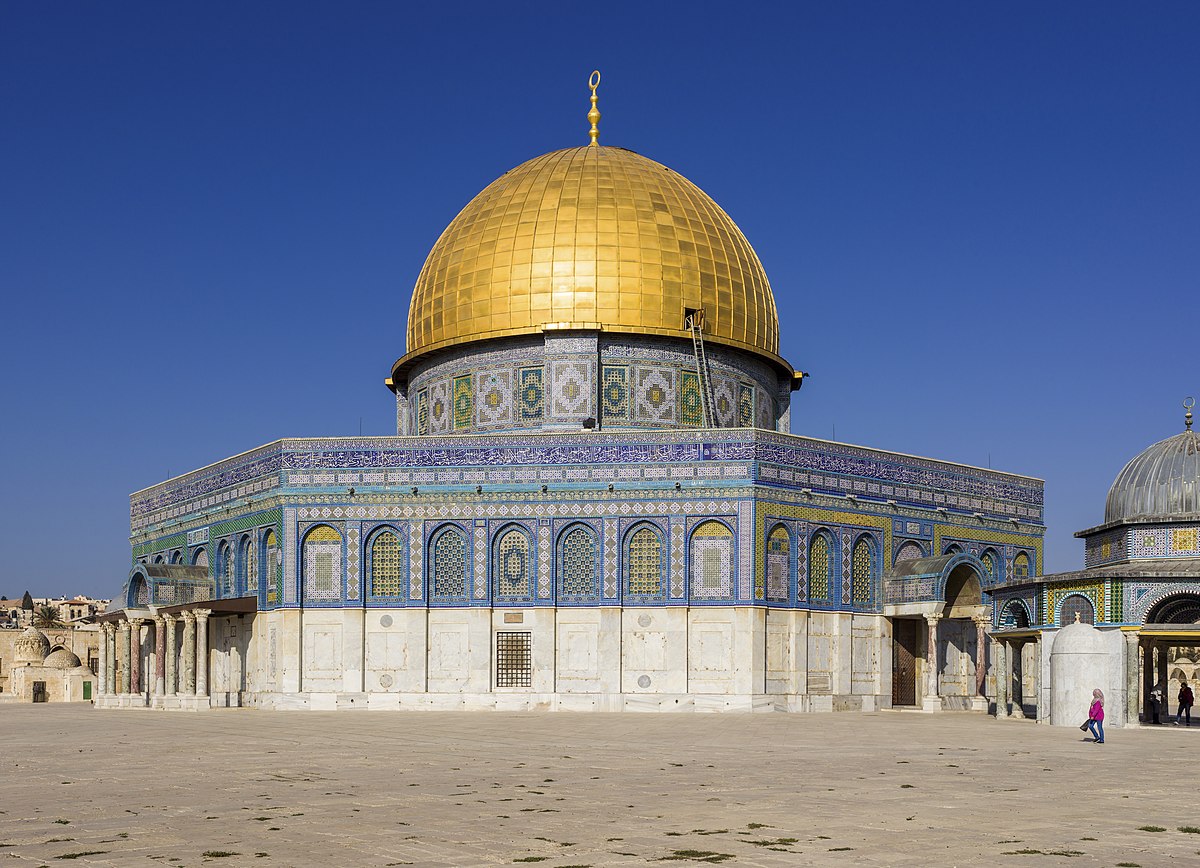
➼ Great Mosque (Masjid-e Jameh)
Details
- Islamic; Persian; Seljuk, Il-Khanid, Timurid, and Safavid Dynasties
- c. 700 additions and restorations in the 14th, 18th, and 20th centuries
- Made of tone, brick, wood, plaster, ceramic tile
- Found in Isfahan, Iran
Form
- Large central rectangular courtyard surrounded by a two-story arcade.
- Typical of Muslim architecture is to have one large arch flanked by two stories of smaller arches
- The qibla iwan is the largest and most decorative; its size indicates the direction to Mecca.
- Southern iwan is an entry for a private space used by the sultan and his retinue; its dome is adorned by decorative tiles; this contains the main mihrab of the mosque.
- Muqarnes: an ornamental and intricate vaulting placed on the underside of arches.
- Elaborately decorated mihrab on the interior points the direction to Mecca; the elaborateness reflects the fact that this is the holiest section of the shrine.
Function
- Muslim mosque.
- Each side of the courtyard, or sahn, has a centrally placed iwan; may be the first mosque to have this feature.
- Sahn: a courtyard in Islamic architecture
- Iwans have different roles, reflecting their size and ornamentation.
Context
- Iwan originally seen in palace architecture; used here for the first time to emphasize the sanctuary.
- This mosque is nestled in an urban center; many gates give access.
- The mosque’s outside walls share support with other buildings.
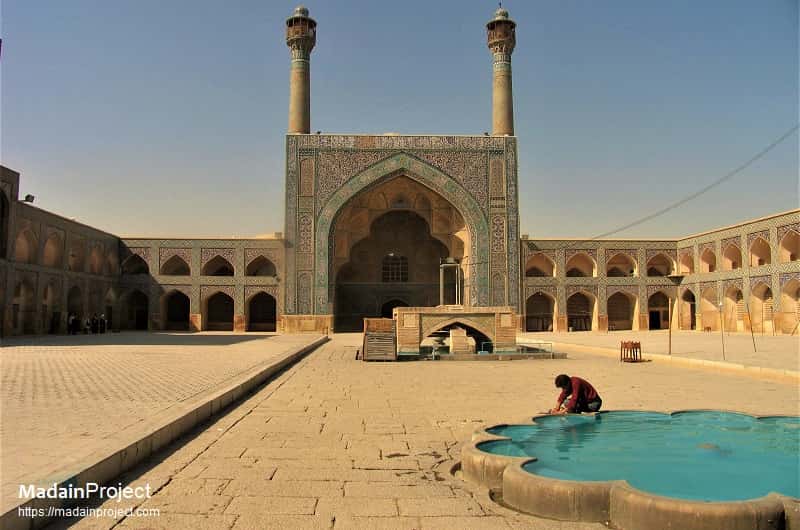
➼ Great Mosque (Umayyad Dynasty)
Details
- Umayyad Dynasty
- 785-786, 8th–10th centuries
- Made of stone masonry
- Foudn in Córdoba, Spain
Form
- Double-arched columns, brilliantly articulated in alternating bands of color.
- Light and airy interior.
- Horseshoe-shaped arches derived from the Visigoths of Spain.
- Hypostyle mosque: no central focus, no congregational worship.
- Elaborately carved doorways signal principle entrances into the mosque and contrast with unadorned walls that otherwise flank the mosque.
Function: Muslim mosque.
History
- The site was originally a Roman temple dedicated to Janus, then a Visigothic church, and then the mosque was built.
- Columns are spolia from ancient Roman structures.
- After a Christian reconquest, the center of the mosque was used for a church.
- Original wooden ceiling replaced by vaulting after Spanish reconquest.
Context
- Complex dome with elaborate squinches was built over the mihrab; it was inspired by Byzantine architecture.
- Horseshoe-shaped arches were inspired by Visigothic buildings in Spain.
- Relatively short columns made ceilings low; doubling of arches enhances interior space, perhaps influenced by the Roman aqueduct in Mérida, Spain.
- Kufic calligraphy on walls and vaults.
- Original patron: Abl al Rahman.
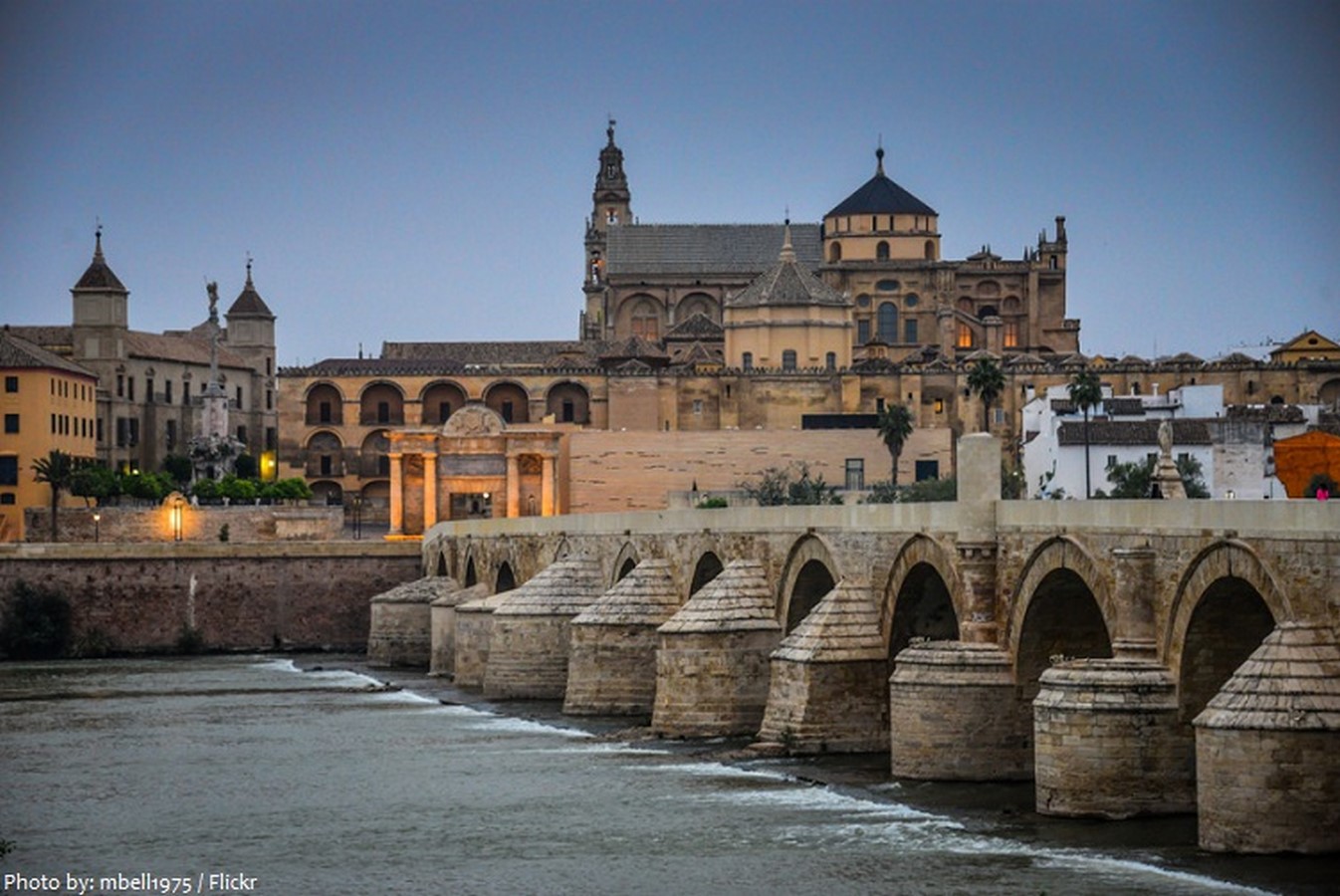
➼ Alhambra
Details
- Nasrid Dynasty
- 1354–1391
- Made of whitewashed adobe stucco, wood, tile, paint, and gilding
- Found in Granada, Spain
Form
- Light, airy interiors; fortress-like exterior.
- Contains palaces, gardens, water pools, fountains, courtyards.
- Small, low-bubbling fountains in each room contribute to cool temperatures in the summer.
- Inspired by the Charbagh gardens from Persia.
- Charbagh: a rectangular garden in the Persian tradition that is based on the four gardens of Paradise mentioned in the Qur’an
Function
- Palace of the Nasrid sultans of southern Spain.
- The Alcazaba (Arab for fortress) is the oldest section and is visible from the exterior.
- The Alcazaba is a double-walled fortress of solid and vaulted towers containing barracks, cisterns, baths, houses, storerooms, and a dungeon.
Context: Built on a hill overlooking the city of Granada.
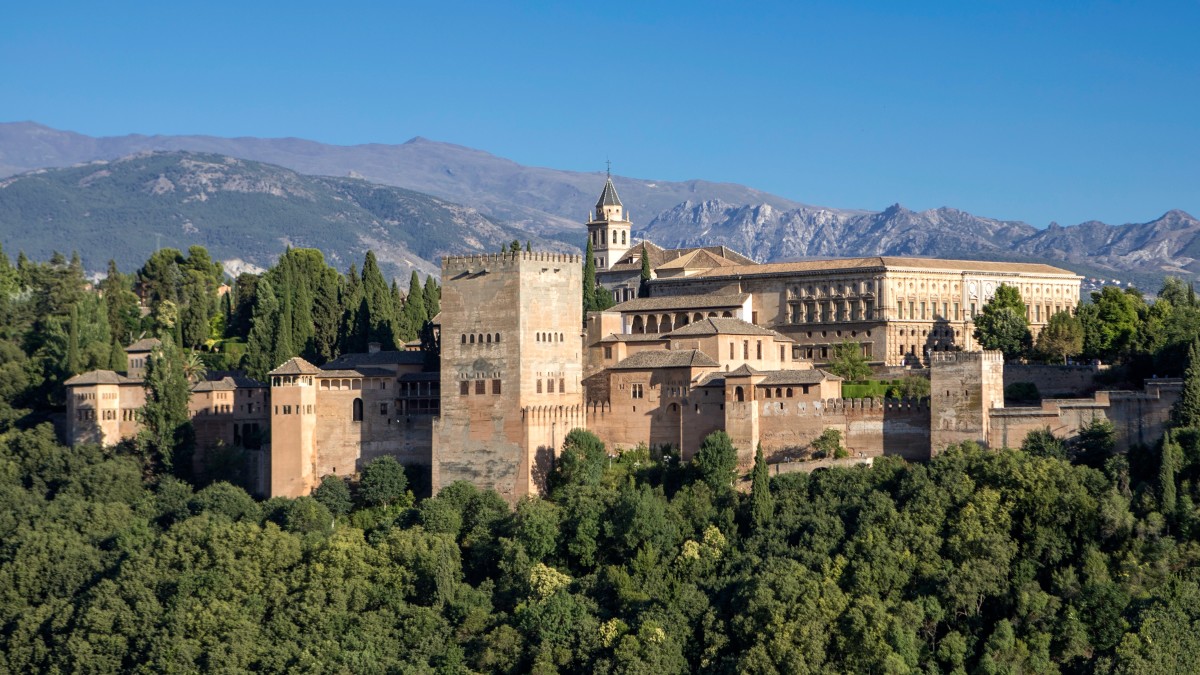
➼ Court of the Lions
Form
- Thin columns support heavy roofs; a feeling of weightlessness.
- Intricately patterned and sculpted ceilings and walls.
- Central fountain supported by 12 protective lions; animal imagery permitted in secular monuments.
- Parts of the walls are chiseled through to create vibrant light patterns within.
Context
- Built by Muhammad V between 1370 and 1391.
- Palaces follow the tradition of western Islamic palace design: rooms arranged symmetrically around rectangular courtyards.
- The courtyard is divided into four parts, each symbolizing one of the four parts of the world.
- Each part of the world is therefore irrigated by a water channel that symbolizes the four rivers of Paradise.
- The courtyard is an architectural symbol of Paradise combining its gardens, water, and columns in a unified expression.
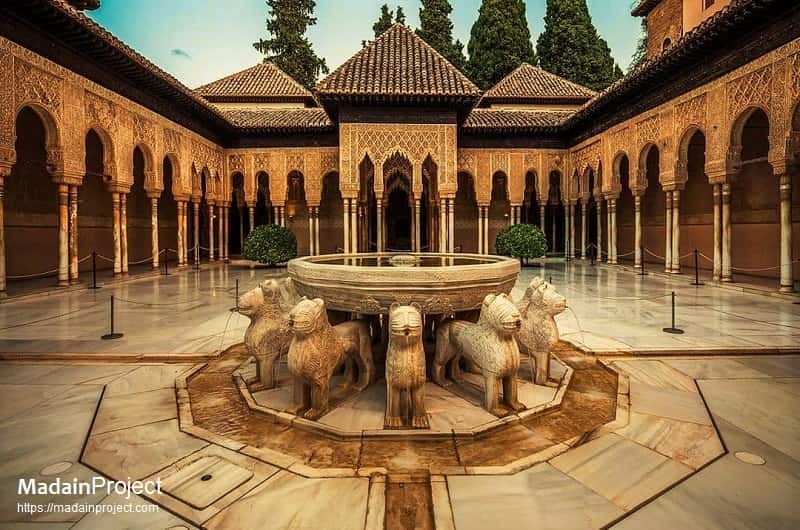
➼ Hall of the Sisters
Form
- Sixteen small windows are placed at the top of hall; light dissolves into a honeycomb of stalactites hanging from the ceiling.
- Five thousand muqarnas, carved in stucco onto the ceiling, refract light.
- Abstract patterns, abstraction of forms.
- Highly sophisticated and refined interior.
Context
- Perhaps used as a music room or for receptions.
- The hall is so named because of two big twin marble flagstones placed on the floor.
- In between these flagstones is a small fountain and a short canal from which water flows to the Court of the Lions.
- The hall was built by order of Mohammed V.

➼ Mosque of Selim II
Details
- By Mimar Sinan
- 1568–1575
- Made of brick and stone,
- Found in Edirne, Turkey
Form
- Extremely thin soaring minarets.
- Abundant window space makes for a brilliantly lit interior.
- Octagonal interior, with eight pillars resting on a square set of piers.
- Squinches decorated with muqarnas transition the round dome to the huge piers below.
- Smaller half-domes in the corners support the main dome and transition the space to a square ground plan.
- Decorative display of Iznik mosaic and tile work.
Function: Mosque part of a complex, including a hospital, school, and library.
Context
- Inspired by Hagia Sophia, but a centrally planned building.
- Open airy interior contrasts with conventional mosques that have partitioned interiors.
- Sinan was chief court architect for the Ottoman emperor Suleyman the Magnificent (r. 1520–1566).

➼ Taj Mahal
Details
- c. 1632–1653
- Made of stone masonry and marble with inlay of precious and semi-precious stones, garden
- Found in Uttar Pradesh, Agra, India
Form
- Symmetrical harmony of design.
- Typical Islamic feature of one large central arch flanked by two smaller arches
- Square plan with chamfered corners.
- Onion-shaped dome rises gracefully from the façade.
- Small kiosks around dome lessen severity.
- Intricate floral and geometric inlays of colored stone.
- Minarets act like a picture frame, directing the eye of the viewer and sheltering the monument.
- Texts from the Qu’ran cover surface.
- Motifs of flowering plants, carved into the walls of the structure, may have been inspired by engravings in European herbals.
Function: Built as the tomb of Mumtaz Mahal, Shah Jahan’s wife; the shah was interred next to her after his death.
Context
- Translated to mean “crown palace.”
- Named for Mumtaz Mahal, deceased wife of Shah Jahan, who died while giving birth to her 14th child.
- Part of a larger ensemble of buildings.
- Grounds represent a vast funerary garden, the gardens found in heaven in the Islamic tradition.
- Taj Mahal reflected in the Charbagh garden
- Different from other Mongol buildings in its extensive use of white marble, which was generally reserved for interior spaces; white marble contrasts with the red sandstone of the flanking buildings.
- Influence of Hindi texts in which white is seen as a symbol of purity for priests and red for warriors; the Taj Mahal is white marble but the surrounding buildings are red sandstone.
Theory
- May have been built to salute the grandeur of the Shah Jahan and his royal kingdom, as much as to honor his wife’s memory.
- Alternate theory suggests that this is a symbolic representation of a Divine Throne on the Day of Judgment.

Unit 8: South, East, and Southeast Asia, 300 BCE–1980 CE
Contextualization of South, East, and Southeast Asian
- Buddhism: founded by Siddhartha Gautama in India, focuses on the Four Noble Truths and the Eightfold Path to achieve enlightenment and end suffering.
- Hinduism: one of the oldest religions, originated in India, believes in reincarnation and karma, and has many gods and goddesses.
- Daoism (Taoism): originated in China, emphasizes living in harmony with nature and the Tao (the way), and has a focus on meditation and simplicity.
- Confucianism: founded by Confucius in China, emphasizes moral values, respect for elders, and the importance of education and social order.
- Shintoism: indigenous religion of Japan, focuses on the worship of kami (spirits or gods) and the importance of nature and purity.
- Christianity: based on the life and teachings of Jesus Christ, believes in one God and the Holy Trinity, and has many different denominations.
- Islam: founded by the prophet Muhammad in Arabia, believes in one God (Allah) and the importance of the Five Pillars of Islam, including prayer, fasting, and pilgrimage to Mecca.
India and Southeast Asian Art
- India Art
- Hinduism and Buddhism are the major influences on Indian art
- The Ajanta and Ellora caves are famous for their rock-cut architecture and paintings
- Mughal art is known for its intricate miniature paintings and calligraphy
- The Taj Mahal is a famous example of Mughal architecture
- Indian art is characterized by bright colors, intricate patterns, and religious themes
- Southeast Asian Art
- Hinduism and Buddhism also heavily influenced Southeast Asian art
- Angkor Wat in Cambodia is a famous example of Khmer architecture and sculpture
- Borobudur in Indonesia is a famous example of Buddhist architecture and sculpture
- Batik is a popular textile art form in Indonesia and Malaysia
- Shadow puppetry is a traditional form of theater in Indonesia and Thailand.
Chinese, Korean, and Japanese Art
- Chinese Art
- Calligraphy: art of writing Chinese characters
- Porcelain: fine ceramic ware
- Silk: luxurious fabric used for painting and embroidery
- Landscape painting: depicts natural scenery
- Jade: precious stone used for carving
- Japanese Art
- Ukiyo-e: woodblock prints depicting everyday life
- Zen Buddhism: influence on art and aesthetics
- Samurai culture: depicted in art and armor
- Tea ceremony: influenced ceramics and pottery
- Shintoism: influence on nature-based art
- Korean Art
- Celadon: green-glazed pottery
- Joseon Dynasty: period of great artistic achievement
- Buddhist art: influenced by Chinese and Indian styles
- Folk art: influenced by shamanism and Confucianism
- Minhwa: traditional Korean folk painting
South, East, and Southeast Asian Artworks
➼ Gandharan
Details
- By Buddha from Bamiyan
- 400–800; destroyed in 2001
- cut rock with plaster and polychrome paint,
- Found in Afghanistan
Form and Content
- First colossal Buddhas.
- Two huge standing Buddhas, one 175 feet tall, the other 115 feet tall.
- Smaller Buddha: Sakyamuni, the historical Buddha.
- Larger Buddha: Vairocana, the universal Buddha.
- Niche shaped like a halo—or mandorla—around the body.
- Buddhas originally covered with pigment and gold.
- Cave galleries weave through the cliff face; some contain wall paintings and painted images of the seated Buddha.
Function
- Pilgrimage site linked to the Silk Road.
- Pilgrims can walk through the cave galleries into passageways that lead to the level of the Buddha’s shoulders.
- Legs are carved in the round; originally pilgrims were able to circumambulate.
- Caves were part of a vast complex of Buddhist monasteries, chapels, and sanctuaries.
Context
- Located near one of the largest branches of the Silk Road.
- Bamiyan, situated at the western end of the Silk Road, was a trading and religious center.
- These Buddhas served as models for later large-scale rock-cut images in China.
- Destroyed by the Taliban in an act of iconoclasm in March 2001.
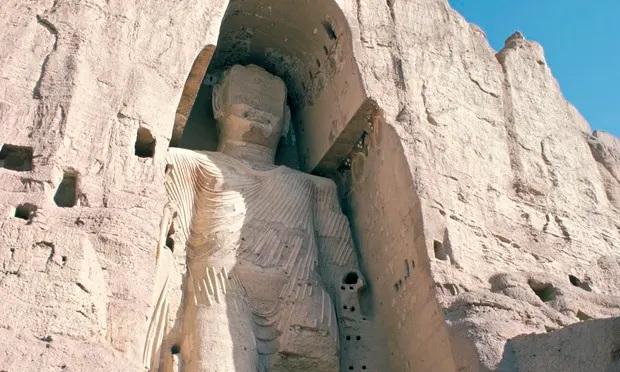
➼ Jowo Rinpoche enshrined in the Jokhang Temple
Details
- From Yarlung Dynasty
- believed to have been brought to Tibet in 641
- gilt metals with semiprecious stones, pearls, and paint; various offerings
- Found in Lhasa, Tibet
History
- Statue thought to have been blessed by the Buddha himself; believed to have been crafted in India during his lifetime; said to have his likeness.
- Believed to have been brought to Tibet in 641.
- Temple founded in 647 by the first ruler of a unified Tibet.
- Disappeared in 1960s during China’s Cultural Revolution.
- In 1983, the lower part was found in a rubbish heap and the upper part in Beijing; restored in 2003.
- Enshrined in the Jokhang Temple, Tibet’s earliest and foremost Buddhist temple.
Function
- Served as a proxy for the Buddha after his departure from this world.
- Often decorated, clothed, and presented with offerings.
Context
- Depiction of Buddha Sakyamuni as a young man around the age of twelve.
- Most sacred and important Buddhist image in Tibet.
- Jowo means “lord.”
- Khang means “house.”
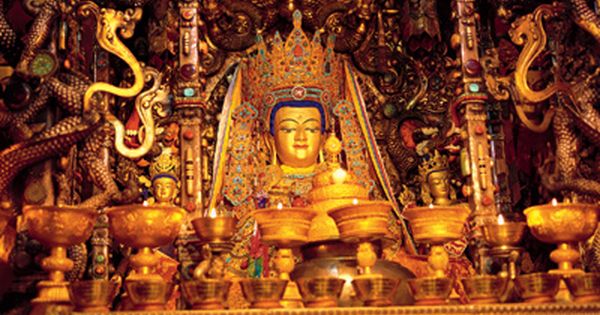
➼ Great Stupa
Details
- From Buddhist, Mauyra, late Sunga Dynasty
- 300 B.C.E.–100 C.E.
- stone masonry, sandstone on dome, Sanchi
- Found in Madhya Pradesh, India
Function
- Pilgrimage site.
- A Buddhist shrine, mound shaped and faced with dressed stone containing the relics of the Buddha.
- The worshipper circumambulates the stupa clockwise along the base of the drum; circular motion suggests the endless cycle of birth and rebirth.
Form
- Three umbrellas at the top represent Buddha, Buddha’s law, and monastic orders.
- A railing at the crest of the mound surrounds the umbrellas, symbolically representing a sacred tree.
- Double stairway at the south end leads from base to drum, where there is a walkway for circumambulation.
- Originally painted white.
- Hemispherical dome is a replication of the dome of heaven. Seated Buddha from second level from the Later Gupta period.
Toranas
- Four toranas, or gateways, at cardinal points of the compass, grace the entrances.
- The orientation of the toranas (east, south, west, and north) and the direction of ritualistic circumambulation correspond with the direction of the sun’s course: from sunrise to zenith, sunset, and nadir.
- Torana: richly carved scenes on the architraves:
- Buddha does not appear himself but is symbolized by an empty throne or a tree under which he meditated.
- Some of these reliefs may also represent the sacred sites where Shakyamuni Buddha visited or taught others about the jataka stories or past lives of the Buddha.
- Horror vacui of composition.
- High-relief sculpture.
- Pre-Buddhist Yakshi figures symbolize fertility.
Context: Donors’ names are carved into the monument: 600 inscriptions reveal the project was funded by women as well as men, common people as well as monks.
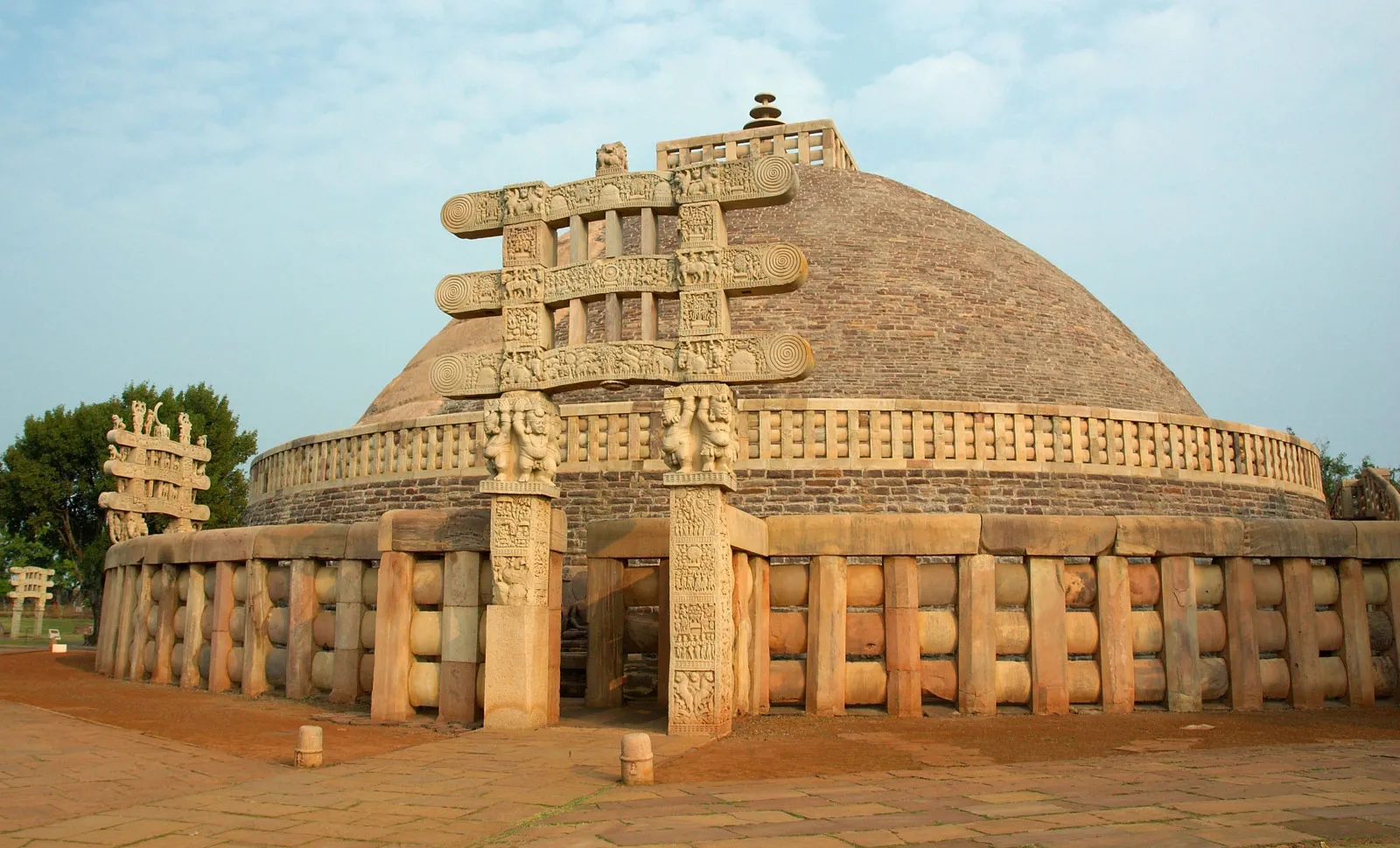
➼ Borobudur Temple
Details
- From Sailendra Dynasty
- c. 750–842
- volcanic stone masonry
- Found in Central Java, Indonesia
Form
- Pyramid in form; aligned with the four cardinal points of the compass.
- Square-shaped plan with four entry points.
- Rubble faced with carved volcanic stone.
- Built on a low hill rising above a wide plain.
Content
- This massive Buddhist monument contains 504 life-size Buddhas, 1,460 narrative relief sculptures on 1,300 panels 8,200 feet long.
- 72 openwork stupas containing a Buddha, each with a preaching mudra.
- Six identical square terraces are placed one atop the other, like steps;
- three smaller circular terraces are placed on top;
- the lowest level functions as the base of the structure, with a square floor plan;
- the second level recedes 23 feet from the edge of the base so that the space is wide enough for processions.
- Each terrace is a level of enlightenment.
- On the top is an enclosed stupa.
- Divided into three sections, representing three levels of Buddhist cosmology:
- Base: represents the lowest level of experience;
- those who are aligned with their desires on Earth;
- the world of desire and negative impulses;
- sculptures here show the deeds of self-sacrifice practiced by the Buddha in his previous births and the story of his last incarnation as Prince Siddhartha.
- Body: five terraces in which people abandon their earthly desires;
- this is the world of forms—people have to control these negative impulses;
- sculptures here show the pilgrimage of the young man, Sudhana, who sets out in search of the Ultimate Truth.
- Superstructure: an area that represents a formless world, in which a person experiences reality in its purest stage, where the physical world and worldly desire are expunged.
Function
- A place of pilgrimage.
- Built as a stupa.
Context
- Meant to be circumambulated on each terrace; six concentric square terraces topped by three circular tiers with a great stupa at the summit.
- Iconographically complex and intricate; many levels of meaning.
Queen Maya riding a horse carriage retreating to Lumbini to give birth to Prince Siddhartha Gautama
- Densely packed scene; horror vacui.
- The queen is majestic and at rest before giving birth.
- Ready to give birth to her son, Prince Siddhartha Gautama, the Buddha.
- She is brought to the city in a great ceremonial procession.


➼ Shiva as Lord of Dance (Nataraja
Details
- From India (Tamil Nadu), Chola Dynasty
- C. 11th century CE
- Cast bronze
- Found in Metropolitan Museum of Art, New York
Form
- Shiva has four hands.
- One hand sounds the drum that he dances to; another carries a flame of destruction; the other two offer the abhaya mudra, a gesture that allays fear.
- Epicene quality showing an idealized, nearly nude, male figure.
- Flying locks of hair terminate in rearing cobra heads. Often depicted in a flaming nimbus, vigorously dancing with one foot on a dwarf, the Demon of Ignorance.
- Fire around Shiva represents the borders of the Hindu cosmos; covered with flowers when carried in processions.
Function
- The sculpture becomes the receptacle for the divine spirit when people pray before it; therefore, the sculpture is royally treated with gifts, food, and incense.
- The sculpture can be bathed and clothed.
- A hole is at the bottom of the sculpture for the placement of a pole so that it can be used in processions and covered by flowers.
Context
- Shiva periodically destroys the universe so that it can be reborn again.
- He unfolds the universe out of the drum held in one of his right hands; he preserves it by uplifting his other right hand in a gesture indicating “do not be afraid.”
- Shiva has a third eye barely suggested between his other two eyes; he once burned the god Kama with this eye.
- The message is that belief in Shiva can achieve salvation.
- The distribution of this figure due to the patronage of a queen, Mahadevi.
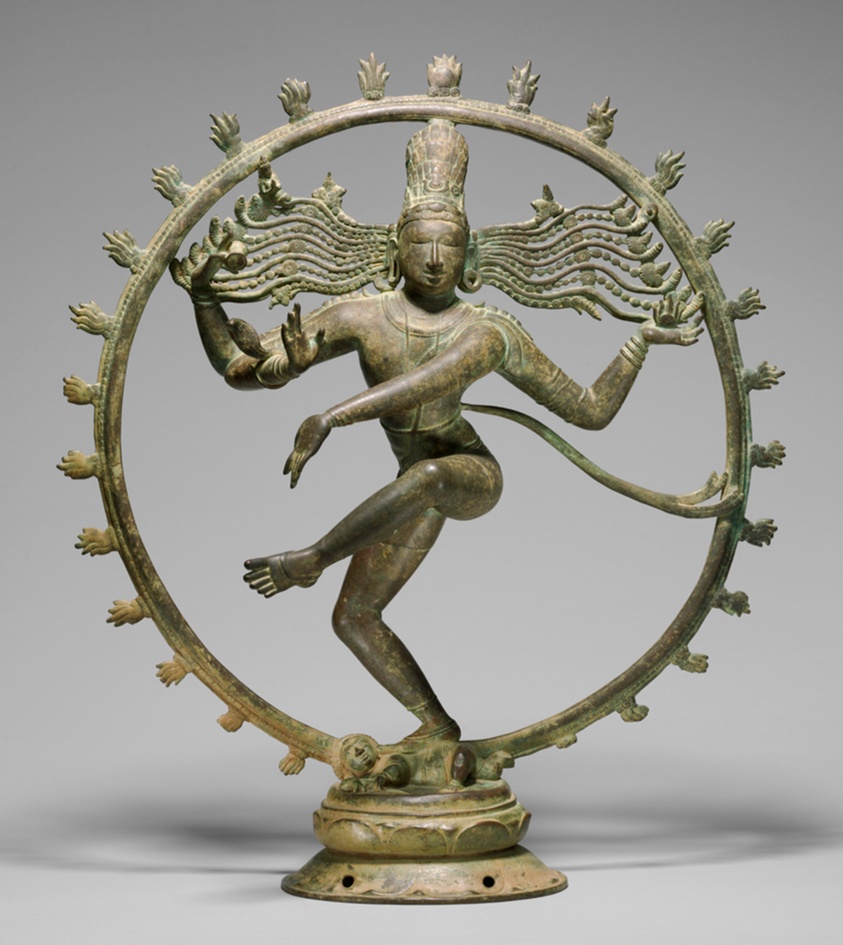
➼ Lakshmana Temple
Details
- From Chandella Dynasty
- 930–950
- sandstone
- Found in Khajuraho, India
Form
- The temple is placed on a high pedestal, or plinth, to be seen from a distance. It appears like rising peaks of a mountain range.
- Compact proportions.
- East/west axis: it receives direct rays from the rising sun.
- The building is a series of shapes that build to become a large tower; complicated intertwining of similar forms called a shikara.
- In the center is the “embryo” room containing the shrine.
- The embryo, called a garbha griha, is very small with only space enough for a limited number of people. It is meant for individual—not congregational—worship.
Materials: Ashlar masonry; made of fine sandstone.
Sculpture
- Bands of horizontal moldings unite the temple.
- The sculpture on the surface harmoniously integrates with the architecture.
- The figures are sensuous with revealing clothing.
- Erotic poses symbolize regeneration.
- Sexuality is frankly expressed.
Function
- It is a Hindu temple grouped with a series of other temples in Khajuraho.
- The temple is dedicated to Vishnu.
Patron: Yashovarman, a leader in the Chandella Dynasty, built the temple to legitimize his rule; completed by his son, Dharga, after his death.
Context: Worshippers move in a clockwise direction starting at the staircase to circumambulate the temple.
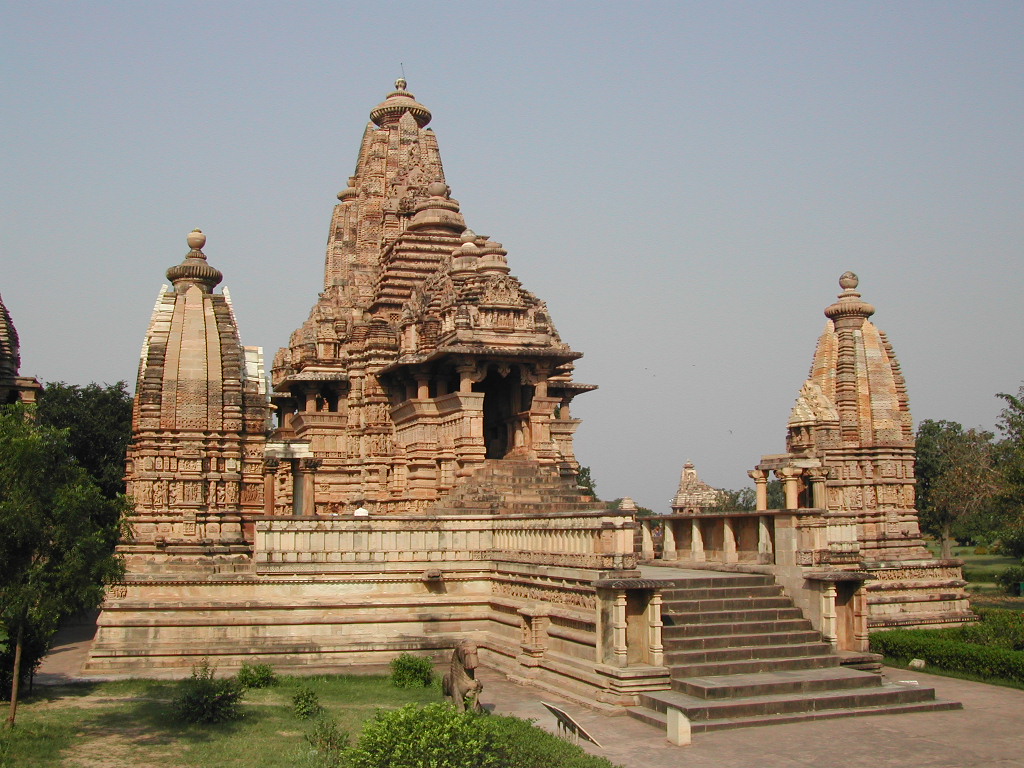
➼ Angkor Wat Temple
Details
- The temple of Angkor Wat, and the city of Angkor Thom
- From Angkor Dynasty
- c. 800–1400
- stone masonry, sandstone
- Found in Cambodia
Form
- Main pyramid is surrounded by four corner towers; a temple-mountain.
- Corbelled gallery roofs; influenced by the Indian use of corbelled vaulting.
- The entire complex is made of stone; most surfaces are carved and decorated.
- Horror vacui of sculptural reliefs.
- Sculpture in rhythmic dance poses; repetition of shapes.
Function
- Dedicated to Vishnu; most sculptures represent Vishnu’s incarnations.
- May have been intended to serve as the king’s mausoleum.
- Hindu temples functioned primarily as the home of the god.
Patronage
- Angkor Wat was the capital of medieval Cambodia, built by King Suryavarman II.
- The complex was built by successive kings, who installed various deities in the complex.
- The kings often identified themselves with the gods they installed.
Context
- The complex has a mixed Buddhist/Hindu character.
- Mountain-like towers symbolize the five peaks of Mount Meru, a sacred mountain said to be the center of the spiritual and physical universe in both Buddhism and Hinduism.
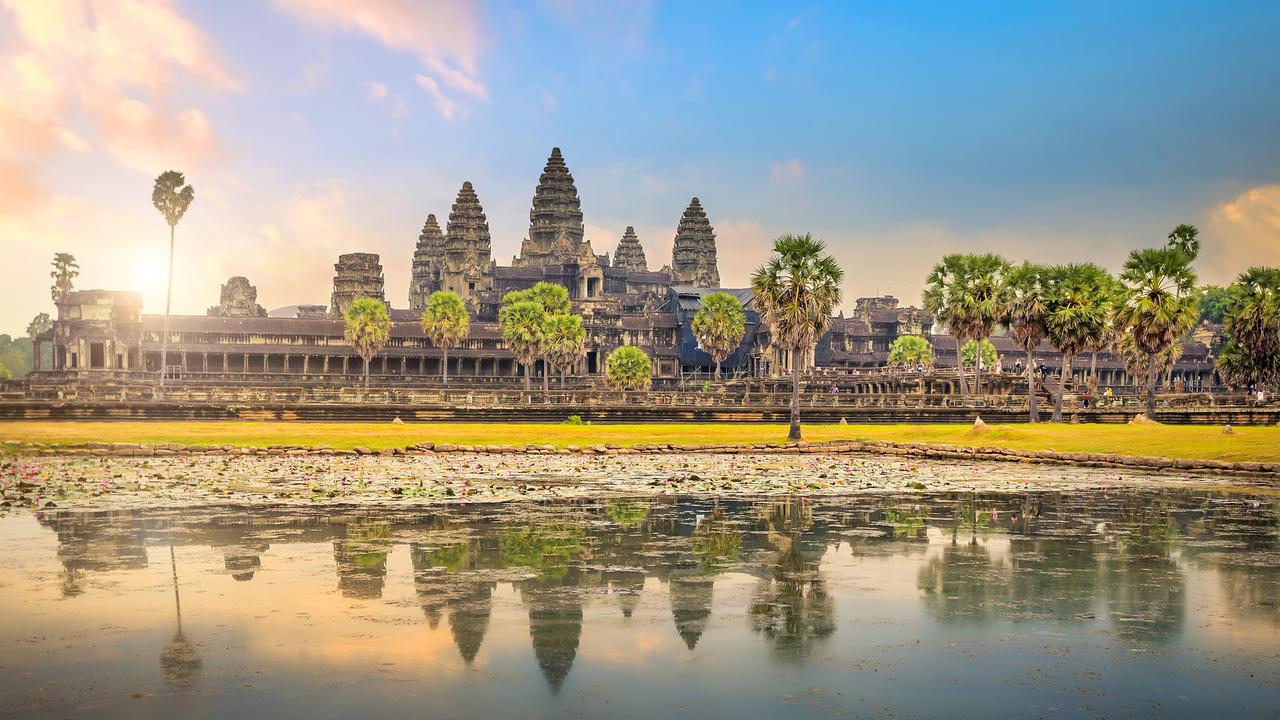
➼ Jahangir Preferring a Sufi Shaikh to Kings
Details
- By Bichitr
- c. 1620
- watercolor, gold, and ink on paper
- Found in Freer Gallery of Art, Washington, D.C.
Content
- Jahangir is the source of all light; he is surrounded by a halo of the sun and moon.
- Jahangir is near the end: seated on an hourglass throne; sands of time running out.
- Jahangir wears a single pearl as a devotion to an eleventh century saint.
- Sufi Sheik is handed a book by Jahangir, or perhaps the holy man is handing Jahangir the book—the book is placed on a cloth so that the sheik does not touch Jahangir.
- The sheik was the superintendent of the shrine at Ajmer, where Jahangir lived from 1613–1616.
- Holy men are placed above and rank higher than all others; the painting is thought to represent the importance of spiritual life over worldly power.
- The Ottoman sultan (not a real portrait) is placed higher than James I, but shows deference to Jahangir.
- James I of England is in the lower left-hand corner; less important than Jahangir, as his position implies; the portrait based on a diplomatic gift probably by artist John de Critz, given by ambassador Sir Thomas Roe.
- The artist, a Hindu, holds a miniature with two horses and an elephant—perhaps gifts from his patron.
- The artist is in lower left-hand corner; he symbolically signs his name on the footstool beneath Jahangir.
Quotations
- Quotation, in frame: “Though outwardly shahs stand before him, he fixes his gazes on dervishes.”
- Angels wish Jahangir a long life by writing on the hourglass, “O Shah, may the span of your life be a thousand years.”
Context
- Jahangir had many artists follow him wherever he went; he wanted everything recorded.
- He sought to bring together things from distant lands.
- Cross-cultural influences from Europe: a Renaissance carpet is in the background; figures of small cherubs are copied from European paintings; there is a halo behind Jahangir.
- Great interest in the Mughal court for European allegorical portraits, techniques, and motifs.
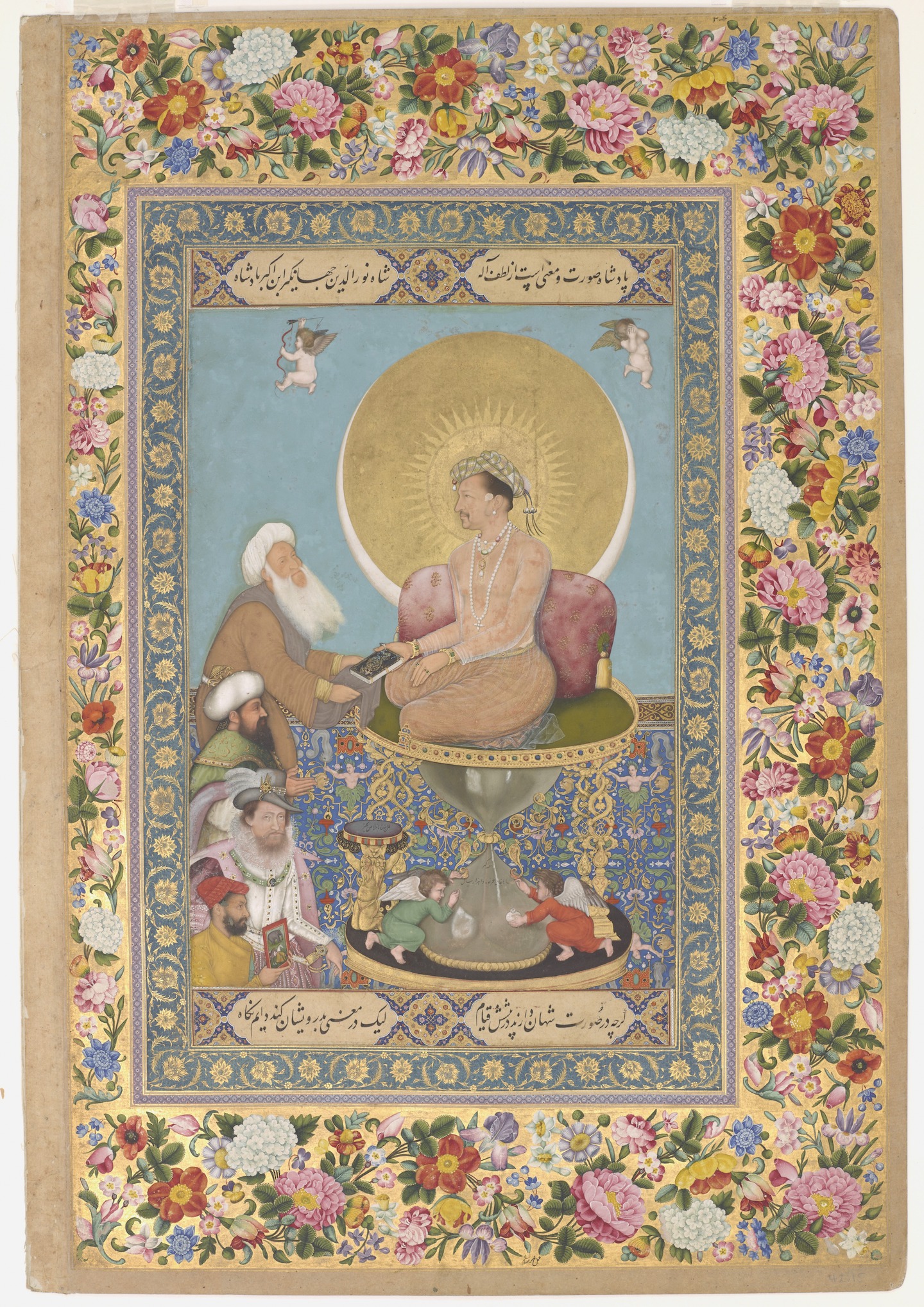
➼ Forbidden City
Details
- By Ming Dynasty
- 15th century —
- stone masonry, marble, brick, wood, ceramic tile
- Found in Beijing, China
Form
- Largest and most complete Chinese architectural ensemble in existence.
- 9,000 rooms.
- Walls were built 30 feet high to keep outside people out and those inside in.
- Each corner of the rectangular plan has a tower representing one of the four corners of the world.
- The focus is on the Hall of Supreme Harmony, the throne room and seat of power; it is a wooden structure made with elaborately painted beams; meant for grand ceremonies.
- Yellow tile roofs and red painted wooden beams placed on marble foundations unify the structures in the Forbidden City into an artistic whole; yellow is the emperor’s color.
Function
- The emperor’s palace; the seat of Chinese power: the capital of the empire during the Ming and Qing Dynasties.
- Originally built to consolidate the emperor’s power.
- Ceremonies took place in the Hall of Supreme Harmony for the new year, the winter solstice, and the emperor’s birthday.
- The Hall of Supreme Harmony is the largest building in the complex.
Context
- Called “Forbidden” in that no one could enter or leave the inner sanctuaries without official permission.
- The throne room was placed symbolically at the center.
- The emperor is associated with the dragon: sits on a dragon throne, wears dragon-themed robes.
- Animals and figures on the roof were placed to ward off fire and evil spirits.
- The surrounding wall of the Forbidden City is characteristic of a Chinese city: privacy within provides protection and reflects the containment aspect of Chinese culture.
- Mandate of Heaven: heaven bestows a mandate on the emperor, who rules with divine blessing as the Son of Heaven; as a result, his Forbidden City was a reflection of heaven itself.
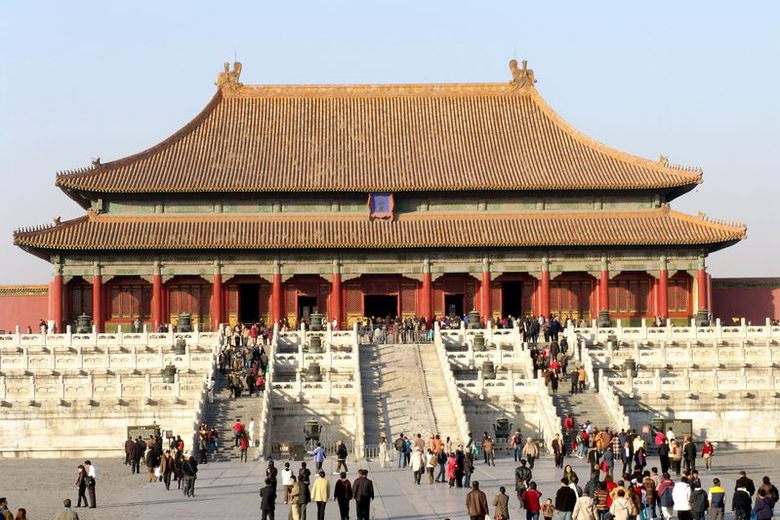
➼ Funeral banner of Lady Dai (Xin Zhui)
Details
- From Han Dynasty
- 180 B.C.E.
- painted silk
- Found in Hunan Provincial Museum, Changsha
Form and Content
- Painted in three distinct sections:
- Top: Heaven, with the crescent moon at left and the legend of the ten suns at right.
- In the center, two seated officers guard the entrance to the heavenly world.
- Middle: Earth, with Lady Dai in the center on a white platform about to make her journey to heaven with the walking stick that was found in her tomb.
- Mourners and assistants appear by her side.
- Dragons’ bodies are symbolically circled through a bi in a yin and yang exchange.
- Bottom: the underworld; symbolically low creatures frame the underworld scene: fish, turtles, dragon tails; tomb guardians protect the body.
Function
- The T-shaped silk banner covered the inner coffin which contained the intact body of Lady Dai in a tomb.
- It was probably carried in a procession to the tomb, and then placed over the body to speed its journey to the afterlife.
Context
- Lady Dai died in 168 B.C.E. in the Hunan province during the Han Dynasty.
- The tomb found with more than 100 objects in 1972.
- Yin symbols on the left of the banner; Yang symbols at right; the center mixes the two philosophies; Daoist elements.
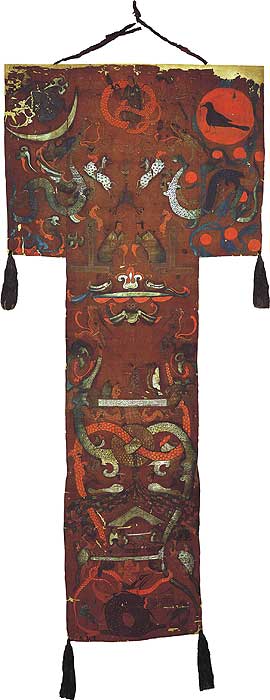
➼ Travelers among Mountains and Streams
Details
- By Fan Kuan
- c. 1000
- ink and colors on silk
- Found in National Palace Museum, Taipei, Taiwan
Form and Content
- Very complex landscape.
- Different brushstrokes describe different kinds of trees: coniferous, deciduous, etc.
- The long waterfall on the right is balanced by a mountain on the left; the waterfall accents the height of the mountain; embodying the essence of a place rather than likeness.
- Not a pure landscape: donkeys laden with firewood are driven by two men; a small temple appears in the forest; people seen as small and insignificant in a vast natural world.
- Mists, created by ink washes, silhouette the roof of the temple.
Function: Hanging scroll; meant to be studied and appreciated, not hung permanently.
Context
- The artist isolated himself away from civilization to be with nature and to study it for his landscapes; this reflects a Daoist philosophy.
- The work contains elements of Daoism, Buddhism, and Confucianism.
- This might be the artist’s only surviving work; his signature is hidden in the bushes on the lower right.
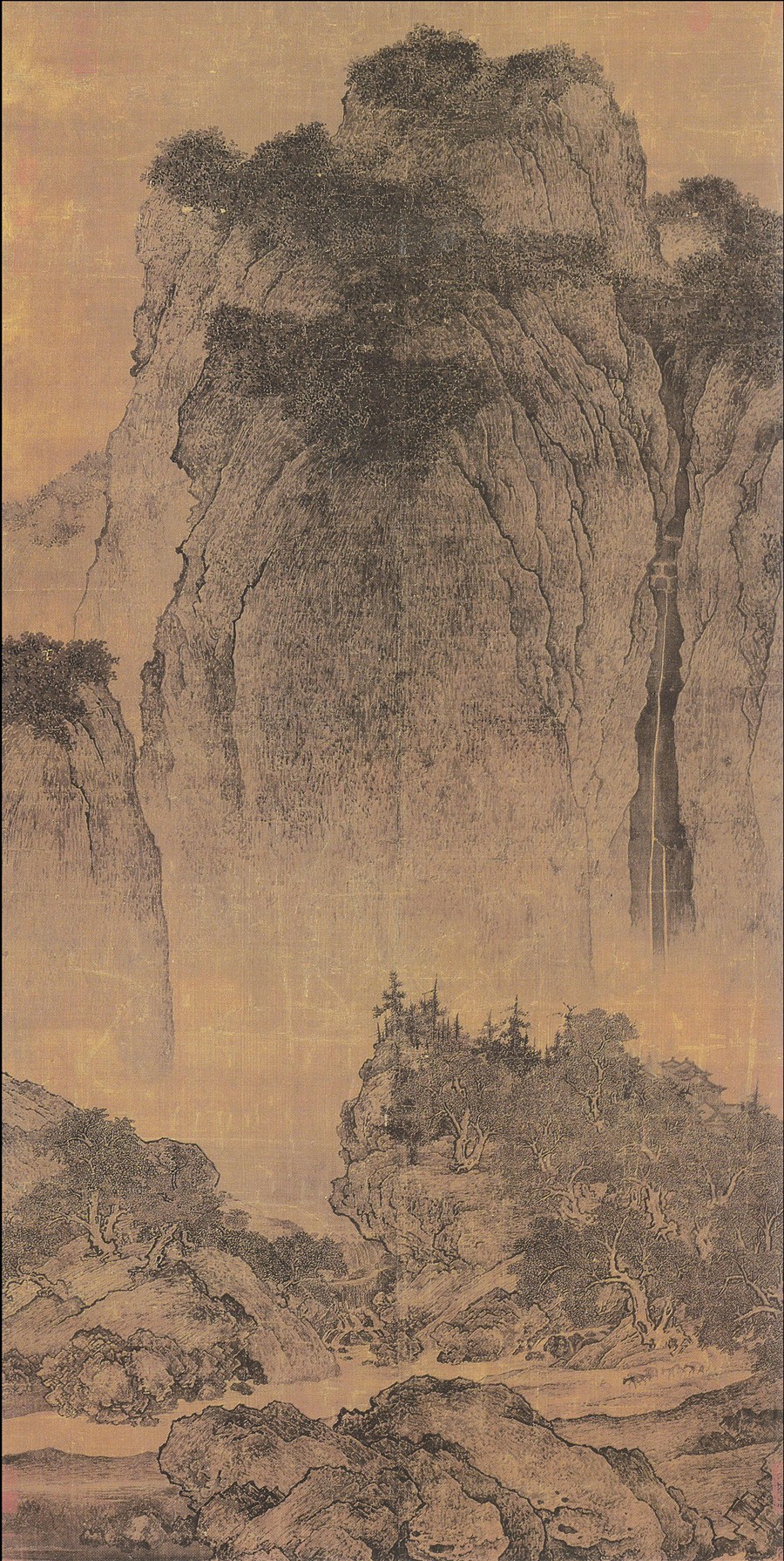
➼ Portrait of Sin Sukju
Details
- 15th century hanging scroll
- ink and color on silk
- Found in Imperial Bureau of Painting
Form: Hanging scroll.
Function
- May have served as a focus for ancestral rituals after death.
- May have hung in a private setting in a family shrine; hence the emphasis on the rank badge.
- Served as a reminder to his descendants of Sin Sukju’s status in Korean society.
Materials: Painting on silk was a highly desired and a greatly esteemed product.
Context
- Korean prime minister (1461–1464 and 1471–1475); scholar and soldier, involved in creating the modern Korean alphabet.
- The portrait was made when he was a second-grade civil officer: insignia, or rank badge, designed with clouds and a wild goose.
- Korean portraits emphasize how the subject made a great contribution to the country and how the spirit of loyalty to king and country was valued by Confucian philosophy.
- Repainted over the years, especially in 1475, when Sin Sukju died, as an act of reverence for a departed ancestor.
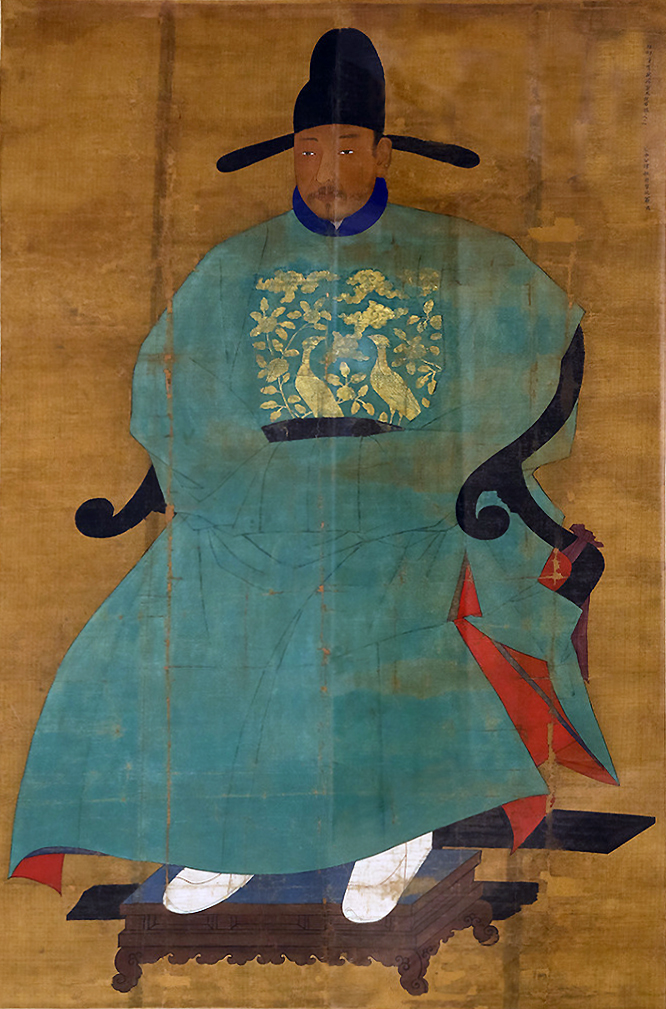
➼ Chairman Mao en Route to Anyuan
Details
- based on an oil painting by Liu Chunhua, 1969
- color lithograph
- Private Collection
Form
- Mao rises above a landscape that contains a power line as a symbol of industrialization.
- Iconic representation of the great leader’s career.
- Poster-like; vivid colors, dramatic, and with obvious political message.
Function
- Done as propaganda: Mao appears youthful, heroic, and idealized.
- May be the most reproduced image ever made: 900,000,000 copies were generated.
Context
- Painted during the Cultural Revolution of 1966–1976; high art was dismissed as feudal or bourgeois; art was created to be of service to the state.
- Based on an oil painting by Liu Chunhua, which first appeared at the Beijing Museum of the Revolution in 1967.
- This type of art was done anonymously; individual artistic fame was seen as countercultural in a collectivist society.
- A moment in the 1920s; Mao on his way to Anyuan to lead a miners’ strike.
- Mao worked for reforms for miners; supported a local strike for better wages, working conditions, and education.
- For many people, this action formed a permanent bond with the Communist Party.
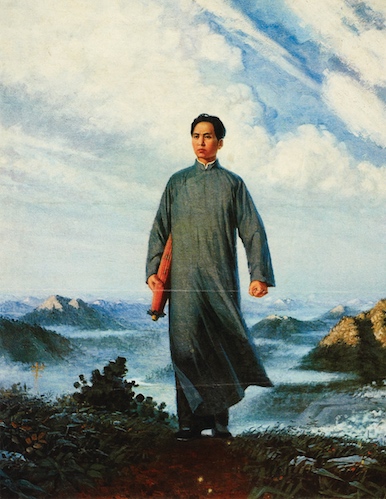
➼ Terra Cotta warriors
Details
- From the mausoleum of the first Qin emperor of China
- From Qin Dynasty
- painted terra cotta
- c. 221–209 B.C.E.
- Found in Lintong, China
Function: Tomb of Emperor Shi Huangdi, founder of the first unified Chinese empire.
Context
- The work represents a Chinese army marching into the next world.
- Each soldier’s face is unique and expresses the army’s ethnic diversity.
- Daoism is seen in the individualization of each soldier despite their numbers.
- This is an early form of mass production, alluding to the power of the state.
- Discovered in 1974.
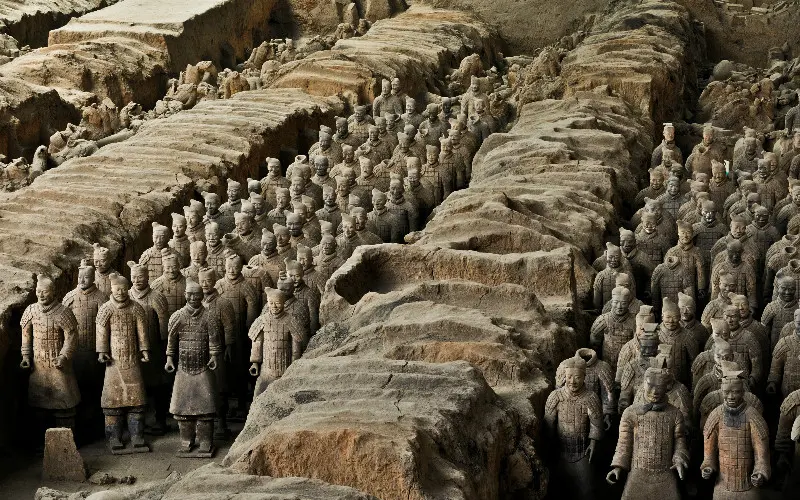
➼ Longmen Caves
Details
- From Tang Dynasty
- 493–1127
- Limestone
- Found Luoyang, China
Form
- The Buddha is arranged as if on an altar of a temple, deeply set into the rock face.
- Vairocana Buddha is flanked by monk attendants, bodhisattvas, and guardians; perhaps a portrait of Wu Zetian.
- The figures have elongated legs and exaggerated poses.
- Sculptures and reliefs are carved from the existing rock—some colossal, some small.
- Realistic musculature of the heavenly guardians shows them as able protectors and defenders of the faith.
Patronage
- Inscription states that Empress Wu Zetian was the principal patroness of the site and that she used her private funds to finance the project.
Context
- More than 2,300 caves and niches are carved along the banks of the Yi River.
- Documents attest that 800,000 people worked on the site
- They produced 110,000 Buddhist stone statues, more than 60 stupas, and 2,800 inscriptions on steles.
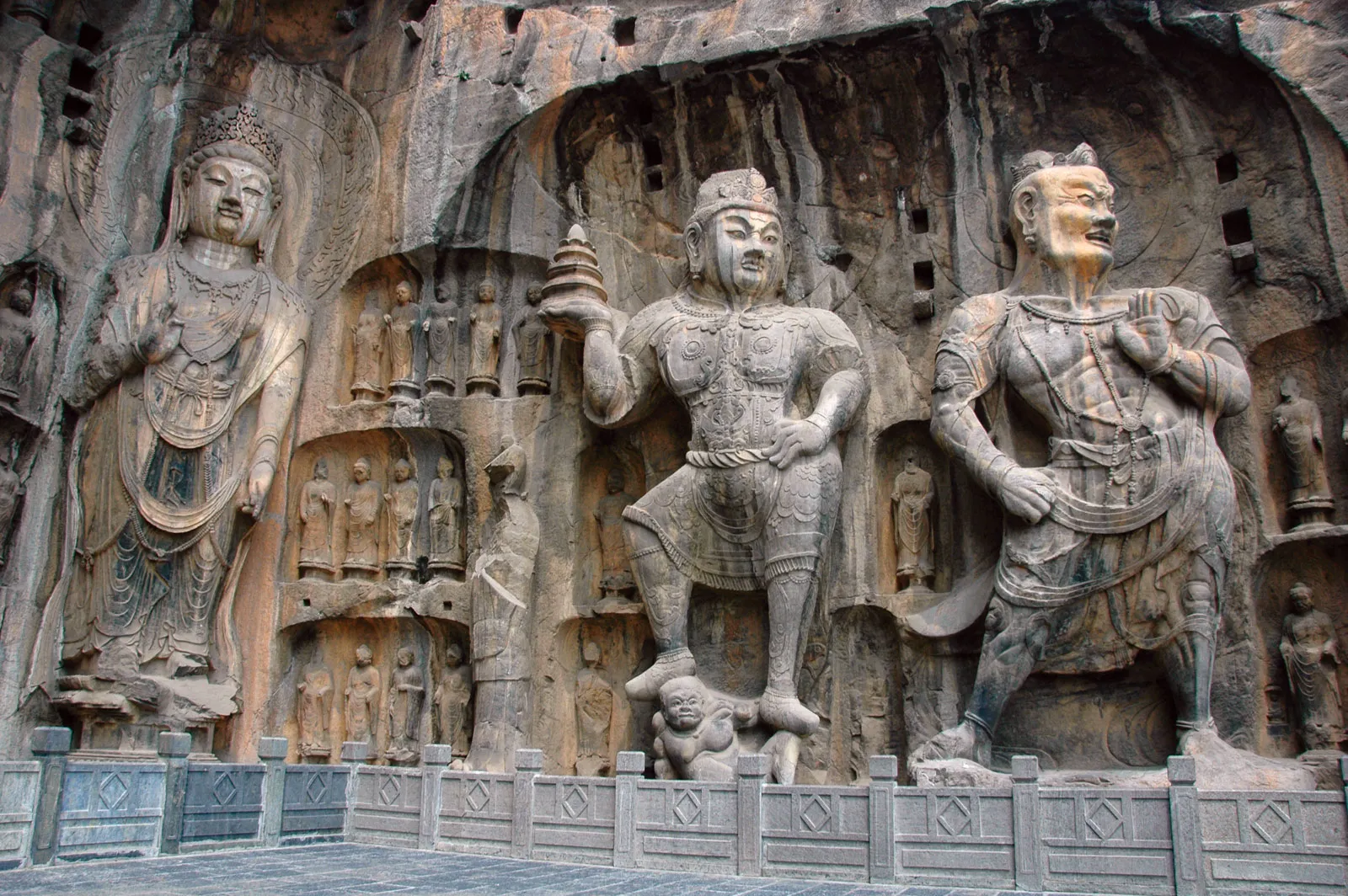
➼ Gold and jade crown
Details
- From Three Kingdoms period, Silla Kingdom
- 5th–6th century
- Metalwork
- Found in National Museum of Korea, Seoul, South Korea
Function: Crown is very lightweight and therefore had limited use—maybe for ceremonial occasions or perhaps only for burial.
Context
- Stylized geometric shapes symbolize trees.
- Antler forms influenced by shamanistic practices in Siberia.
- Uncovered from a royal tomb in Gyeongju, Korea; from the Silla Dynasty.
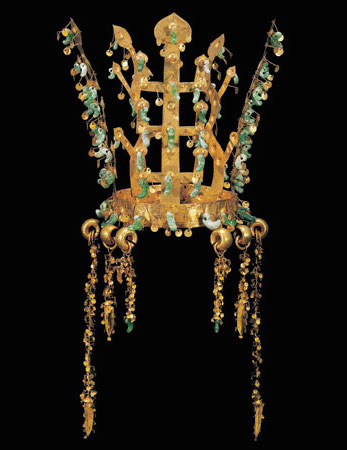
➼ The David Vases
Details
- From Yuan Dynasty
- 1351
- white porcelain with cobalt-blue underglaze
- Found in British Museum, London
Form and Content
- The blue color was imported from Iran; Chinese expansion into western Asia made the cobalt blue available.
- The vases were modeled after bronzes of the same type.
- The necks and feet of the vases contain leaves and flowers.
- They have elephant-head-shaped handles.
- Central section: Chinese dragons with traditional long bodies and beards; dragons have scales and claws, and are set in a sea of clouds.
Function
- Made for the altar of a Daoist temple along with an incense burner, which has not been found; a typical altar set.
- Site heavily damaged during the twentieth century.
Materials: Made of Jingdezhen porcelain, the same materials found in Ai Weiwei’s Sunflower Seeds
Context
- One of the most important examples of Chinese blue and white porcelain in existence.
- A dedication is written on the side of the neck of the vessels; believed to be the earliest known blue-and-white porcelain dedication.
- Inscription on one of the vases:
- “Zhang Wenjin, from Jingtang community, Dejiao village, Shuncheng township, Yushan county, Xinzhou circuit, a disciple of the Holy Gods, is pleased to offer a set comprising one incense-burner and a pair of flower vases to General Hu Jingyi at the Original Palace in Xingyuan, as a prayer for the protection and blessing of the whole family and for the peace of his sons and daughters. Carefully offered on an auspicious day in the Fourth Month, Eleventh year of the Zhizheng reign.”
- Named after Sir Percival David, a collector of Chinese art.
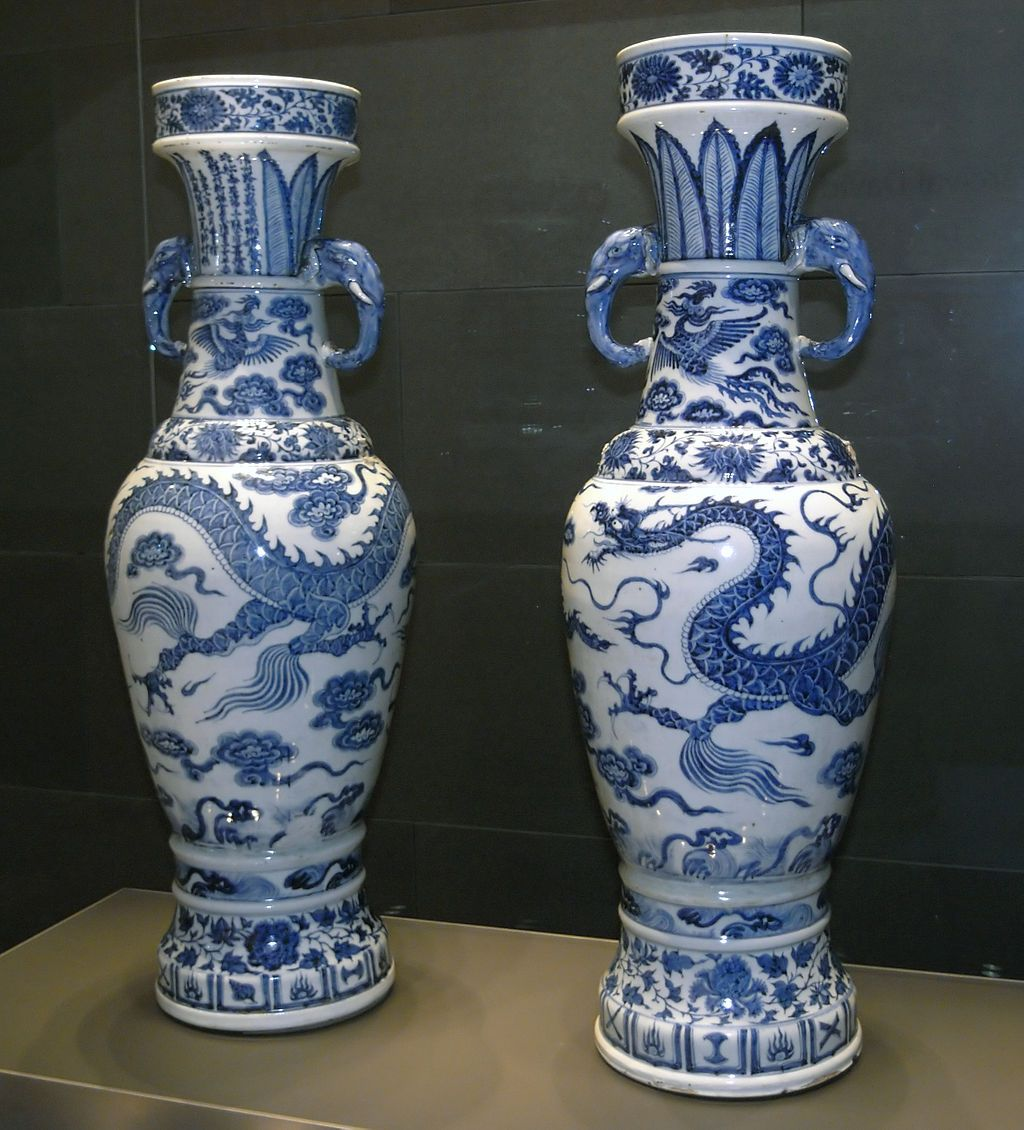
➼ Todai-ji
Details
- 743; rebuilt on c. 1700
- wood with ceramic tile roofing
- Found in Nara, Japan
Form
- A two-story building with long, graceful eaves hanging over the edges: the eaves protect the interior from the sun and rain.
- Seven external bays on the façade.
Function
- This is the original center of the Buddhist faith in Japan, from which ancillary temples around the country were served.
- The building expresses an imperial and political authority combined with religious overtones.
- It served as a center for the training of scholar monks, who studied Buddhist doctrines.
Context
- The name Great Eastern Temple refers to its location on the eastern edge of the city of Nara, Japan (called Daibutuden).
- The temple is noted for its colossal sculpture of seated Vairocana Buddha.
- The temple and Buddha have been razed several times during military unrest.
- The Buddha is influenced by monumental Chinese sculptures
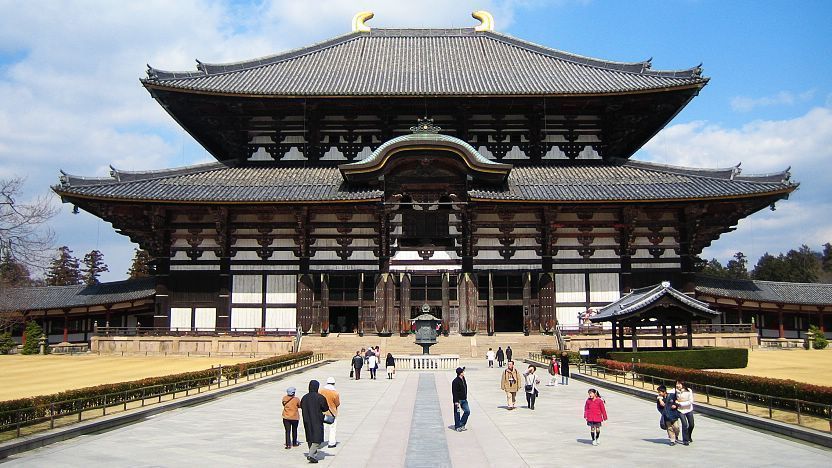
➼ Great Buddha
Function and Context
- Largest metal statue of Buddha in the world.
- Monumental feat of casting.
- Emperor Shōmu embraced Buddhism and erected sculpture as a way of stabilizing Japanese population during a time of economic crisis.
- Mudra: right hand means “do not fear”; left hand means “welcome.”
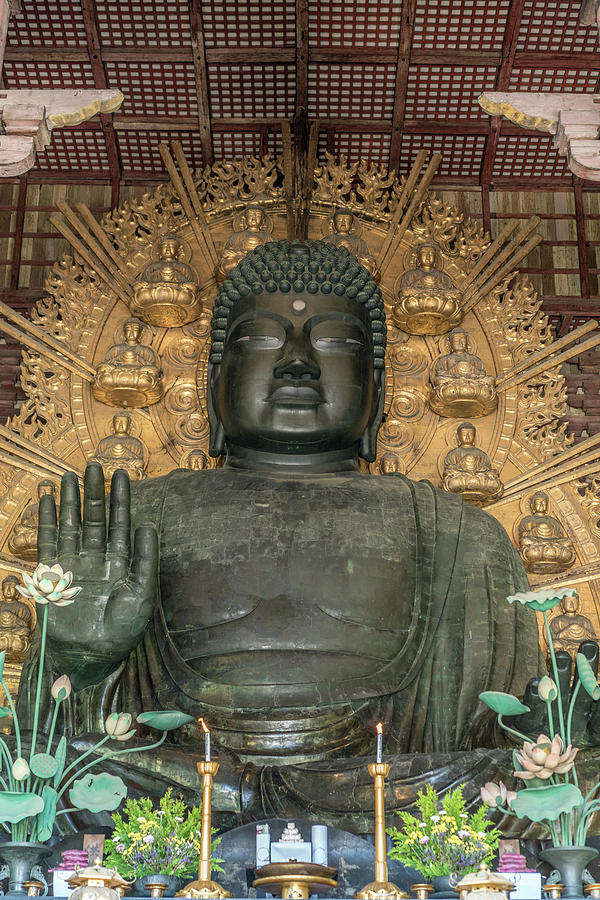
➼ Nio Guardian Figures (c. 1203)
Function and Context
- They are placed on either side of the Todai-ji south gate.
- The sculptures are a series of complexly joined woodblock pieces.
- Masculine, frightening figures that protect the Buddha derived from Chinese guardian figures such as those at Luoyang.
- Fierce, forbidding looks and gestures.
- Intricate swirling drapery.
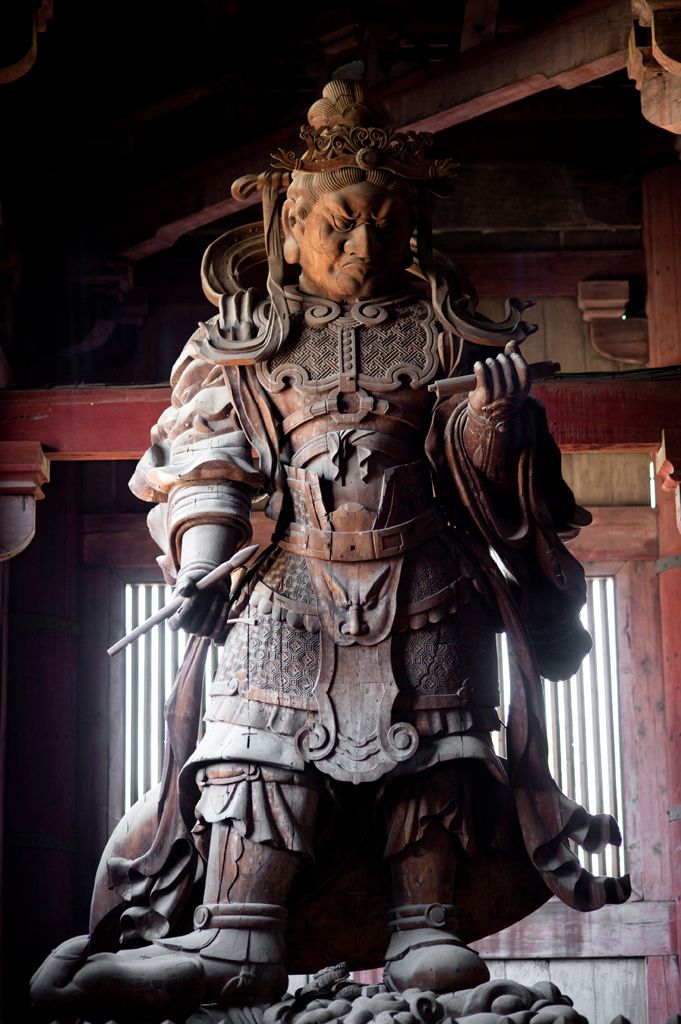
➼ Great South Gate (1181–1203)
Function and Context
- This is the main gate of Todai-ji.
- Nandaimon: great south gate, with five bays—three central bays for passing and two outer bays that are closed.
- The two stories are the same size: unusual in Japanese architecture (usually the upper story is smaller).
- Deep eaves are supported by the six-stepped bracket complex, which rise in tiers with no bracketed arms.
- The roof is supported by huge pillars.
- Unusual in that it has no ceiling; the roof is exposed from below.
- Overall effect is of proportion and stateliness.
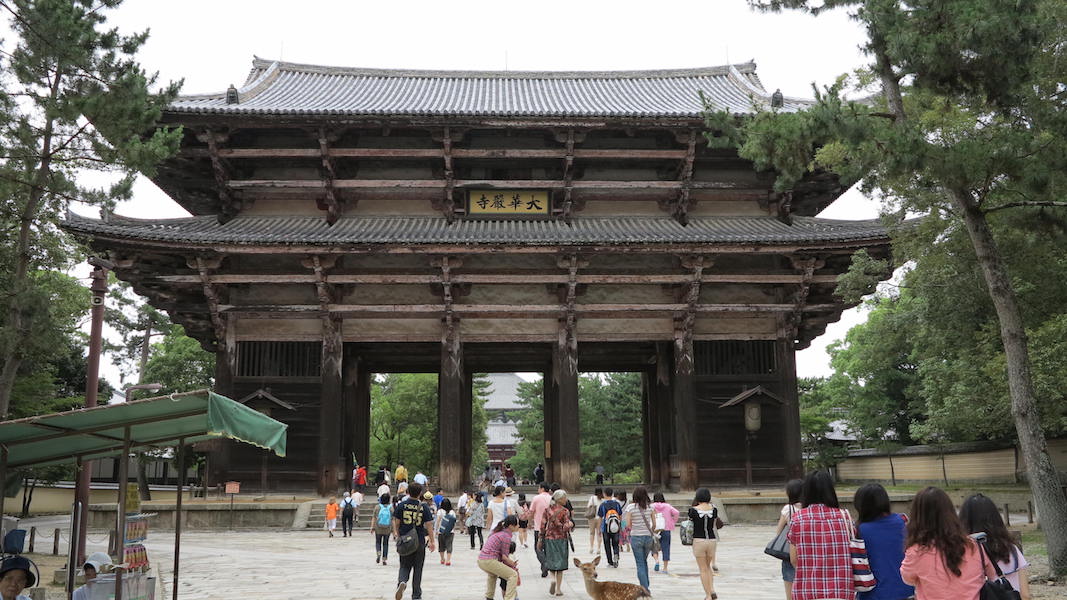
➼ Ryoan-Ji
Details
- From Muromachi period
- c. 1480; current design 18th century
- rock garden
- Found in Kyoto, Japan
Garden
- Garden as a microcosm of nature.
- Zen dry garden:
- Gravel represents water; gravel is raked in wavy patterns daily by monks.
- Rocks represent mountain ranges.
- Asymmetrical arrangement.
- The garden is bounded on two sides by a low, yellow wall.
- Fifteen rocks arranged in three groups interpreted as:
- Islands in a floating sea.
- Mountain peaks above clouds.
- Constellations in the sky.
- A tiger taking her cubs across a stream.
- Meant to be viewed from a veranda in a nearby building, the abbot’s residence.
- From no viewpoint is the entire garden viewable at once.
- Garden served as a focus for meditation; in a sense, a garden entered by the mind.
- Wet garden:
- Contains a teahouse.
- Seemingly arbitrary in placement, the plants are actually placed in a highly organized and structured environment symbolizing the natural world.
- Water symbolizes purification; used in rituals.
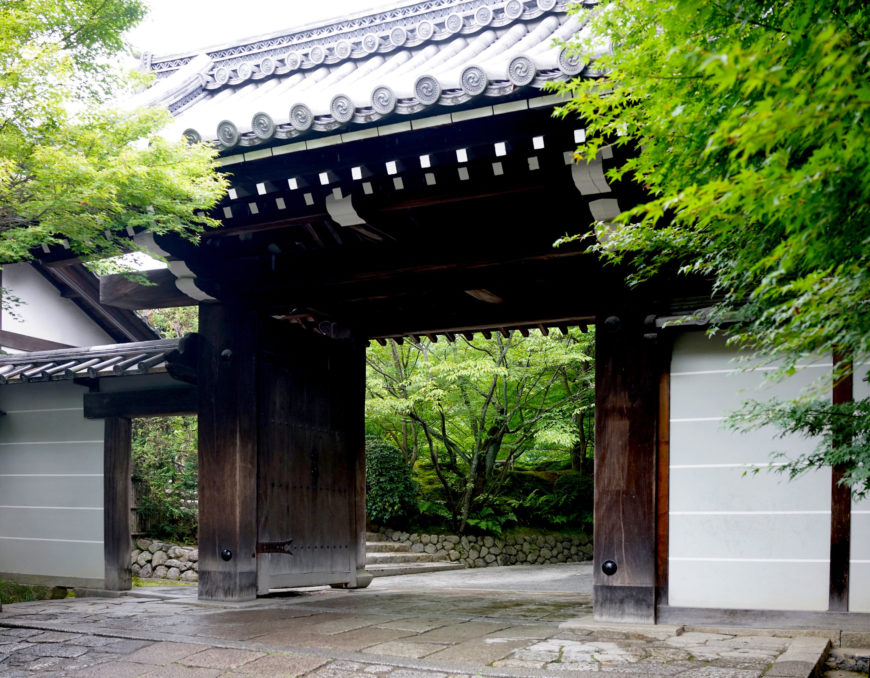
➼ Night Attack on the Sanjô Palace
Details
- Kamakura period
- c. 1250–1300
- Handscroll (ink and color on paper)
- Found in Museum of Fine Arts, Boston
Form
- A narrative work that is read from right to left as the scroll is unrolled.
- Point of view: one looks down from above onto the scene, which takes place in Kyoto.
- Strong diagonals emphasize movement and action.
- Swift, active brushstrokes.
- Depersonalized figures; many with only one stroke for the eyes, ears, and mouth.
- Tangled mass of forms accentuated by Japanese armor.
- Final scene: lone archer leads the escape from the burning palace with the Japanese commander behind him.
Function: Hand scroll, meant to be read and studied, not meant to be placed on permanent display.
Context
- Military rule in Japan from 1185 on had an interest in the code of the warrior; reflected in the large quantity of war-related literature and paintings.
- Scroll depicts a coup staged in 1159 as Emperor Go-Shirakawa is taken prisoner.
- Burning of the imperial palace at Sanjô in Kyoto as rebel forces try to seize power by capturing a retired emperor.
- Imperial palace in flames; rebels force the emperor to board a cart waiting to take him into captivity.
- Rebels kill those opposed and place their heads on sticks and parade them as trophies.
- Painted a hundred years after the civil war depicted in the scene.
- Unrolls like a film sequence; as one unrolls, time advances.
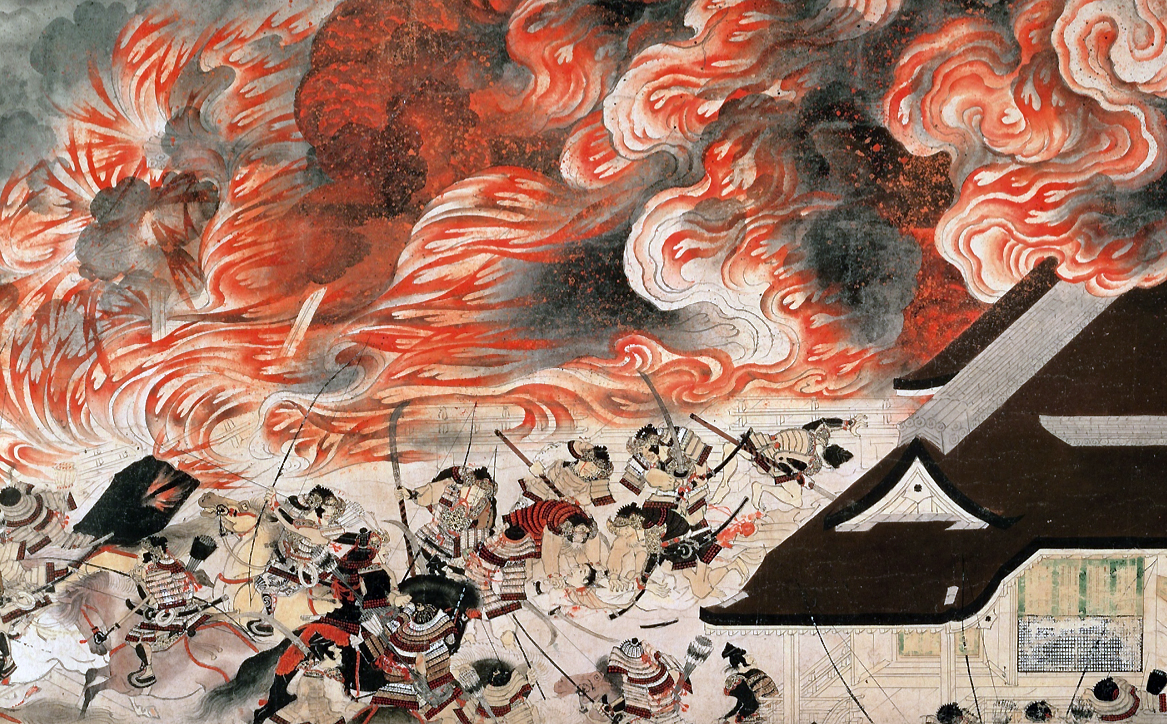
➼ White and Red Plum Blossoms
Details
- By Ogata Korin
- 1710–1716
- ink, watercolor, and gold leaf on paper
- Found in Museum of Art, Atami, Japan
Form
- A stream cuts rhythmically through the scene; swirls in the paint surface indicate water currents.
- White plum blossoms on left; red on right.
- The artist worked in vivid colors or ink monochrome on gold ground.
- This work has more abstracted and simplified forms than the compositions of Ogata’s predecessors.
- Old tree on left is balanced by new tree on right.
Function: Japanese screen, usually used to separate spaces in a room.
Context
- Japanese rinpa style named for Ogata (Rin, for Ko-rin, and pa, meaning “school”).
- The work is influenced by the yamato-e style of painting.
- Tarashikomi technique, in which paint is applied to a surface that has not already dried from a previous application; creates a dripping effect, useful in depicting streams or flowers.
- The artist was a member of a Kyoto family of textile merchants that serviced samurai, a few nobility, and city dwellers.
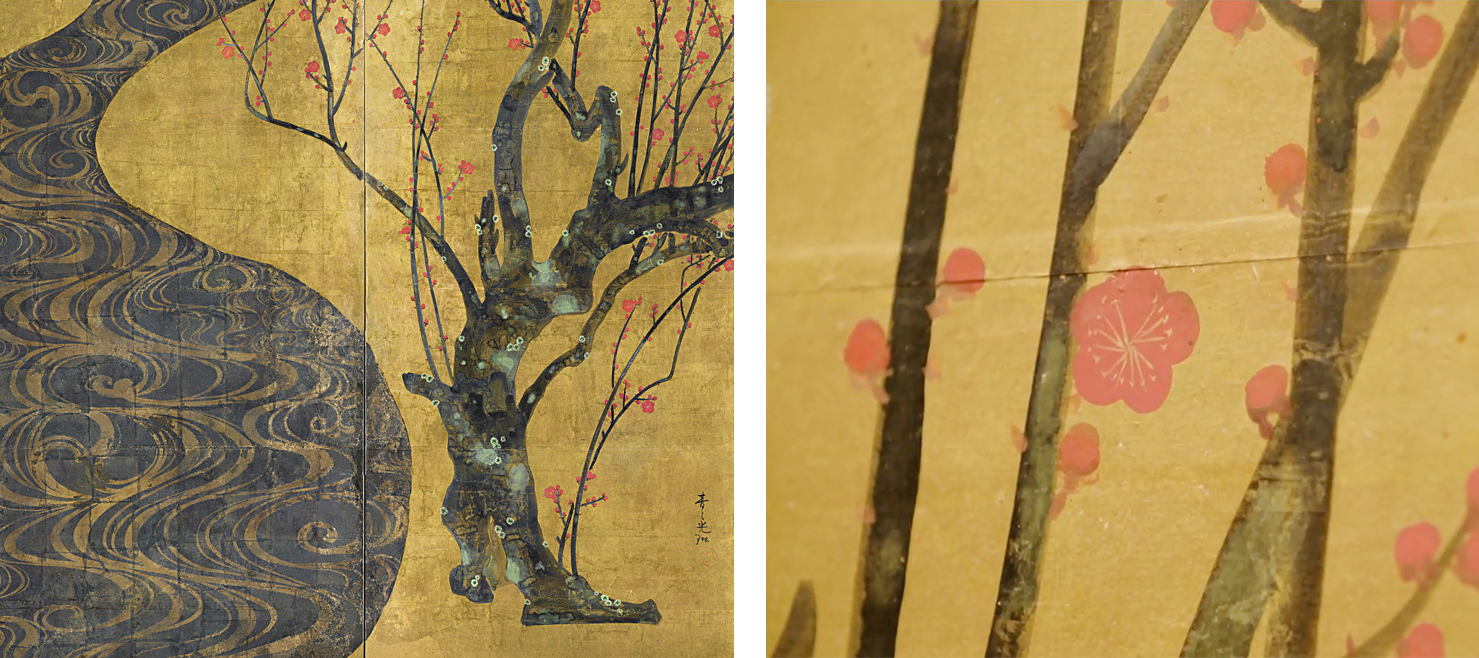
➼ Under the Wave off Kanagawa (Kanagawa oki nami ura)
Details
- Also known as the Great Wave
- from the series Thirty-six Views of Mount Fuji
- 1830–1833
- polychrome wood-block print; ink and color on paper
- Found in Metropolitan Museum of Art, New York
Form
- Personification of nature; the wave seems intent on drowning the figures in boats.
- Mount Fuji, sacred mountain to the Japanese, seems to be one of the waves.
- The striking design contrasts water and sky with large areas of negative space.
- Imported color: Prussian blue, which made the print seem unusual and special to contemporaries.
Function: Part of series of prints called Thirty-six Views of Mount Fuji.
Materials and Techniques
- Each wood-block print required the collaboration of a designer, an engraver, a printer, and a publisher.
- Conceived of as a commercial opportunity by the publisher, who may have doubled as a book dealer.
- The publisher determined the theme.
- The print was designed by an artist on paper, and then an engraver copied the design onto a woodblock.
- The printer rubs ink onto the block and places paper over the block to make a print.
- Many colored prints were made by using a separate block for each color.
- Prussian blue was highly prized in Japan; acquired through trade with Europe.
Context
- Mount Fuji, the highest mountain in Japan, is known for its symmetrical cone.
- Mount Fuji is considered a sacred site.
- In Shintoism, the forces of nature unite as one, as they do in the Hokusai print.
- This was the first time a landscape was a major theme in Japanese prints.
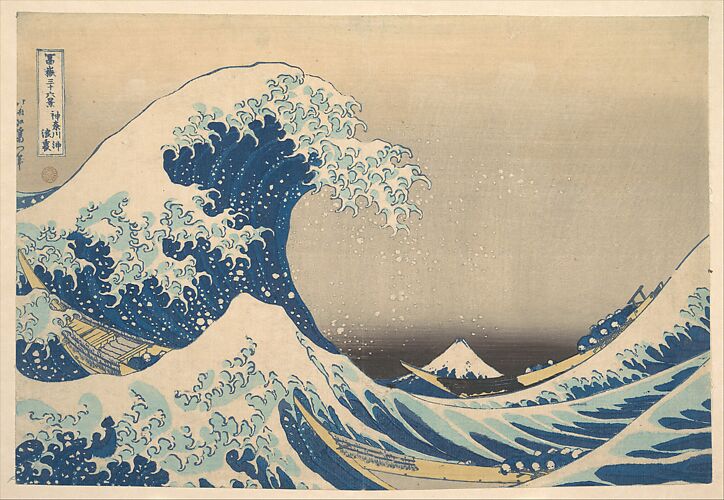
Unit 9: The Pacific, 700-1980 CE
Contextualization of Pacific Art
- Some areas of the Pacific are among the oldest inhabited places on earth, while others are among the newest.
- Aborigines reached Australia around 50,000 years ago.
- Remote Pacific islands like Hawaii, Easter Island, and New Zealand were occupied only in the last thousand years.
- Seafarers reached Fiji in the central South Pacific around 1300 B.C.E.
- Technological development of sailing craft enabled greater territories to be mapped and charted for possible occupation.
- Tonga was reached in 420 B.C.E. and Samoa in 200 B.C.E. using the particularly effective twin-hulled sailing canoe.
- The discovery of New Zealand by the ancestors of the Maori happened perhaps as early as the tenth century, but certainly by the thirteenth century.
- European involvement in the Pacific began with the circumnavigation of the globe by Portuguese explorer Ferdinand Magellan and his crew.
- Explorers of the eighteenth century were followed by occupiers from the nineteenth century, who implanted European customs, values, religions, and technologies onto the indigenous population.
- Many areas of the Pacific achieved independence in the twentieth century.
Materials, Processes, and Techniques in Pacific Art
- Materials
- They use natural materials such as wood, bark, shells, feathers, and fibers.
- These materials are often sourced from the local environment and have cultural significance to the communities that use them.
- Wood is a particularly important material in Pacific art, used for carving sculptures, masks, and canoes.
- Bark cloth, made from the inner bark of trees, is used for clothing, bedding, and ceremonial purposes.
- Shells and feathers are used for adornment and decoration.
- Processes
- Carving is a common technique used to create sculptures, masks, and canoes. It involves using chisels and other tools to shape wood into the desired form.
- Weaving is another important process in Pacific art, used to create baskets, mats, and clothing. It involves interlacing fibers or other materials to create a pattern or structure.
- Painting is also used in Pacific art, often to decorate carvings or bark cloth.
- Techniques
- Pacific art is characterized by a range of techniques that are specific to different cultures and regions.
- For example, in Maori culture, the technique of "whakairo" involves carving intricate patterns and designs into wood.
- In Papua New Guinea, the "bilum" technique is used to create woven bags and baskets using a looping technique.
- In Fiji, the "masi" technique is used to create bark cloth by pounding and stretching the inner bark of trees.
- These techniques are often passed down through generations and have cultural significance to the communities that use them.
Pacific Artworks
➼ Nan Madol
Details
- Saudeleur Dynasty
- c. 700–1600
- basalt boulders and prismatic columns
- Found in Pohnpei, Micronesia
Form
- 92 small artificial islands connected by canals, about 170 acres in total.
- Built out into the water on a lagoon—similar to Venice, Italy.
- Seawalls 15 feet high and 35 feet thick acted as breakwaters.
- Canals were flushed clean with the tides.
- Islands were arranged southwest to northeast to take advantage of the trade winds.
- Walls were made of prismatic basalt; roofs were thatched.
Function: Ancient city that acted as the capital of the Saudeleur Dynasty of Micronesia.
Context
- City built to separate the upper classes from the lower classes.
- King arranged for the upper classes to live close to him, to keep an eye on them.
- Curved outer walls point upward at edges, giving the complex a symbolic boat-like appearance.
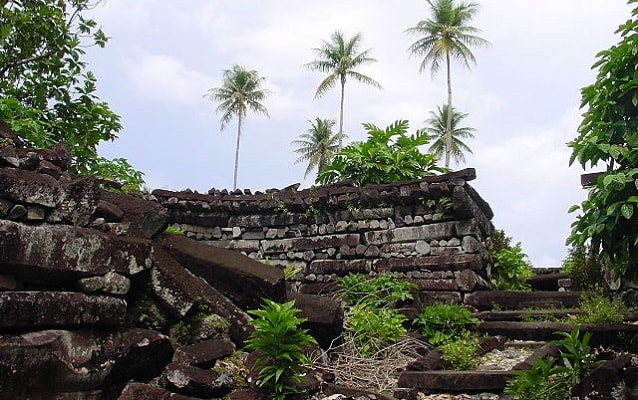
➼ Female Deity
Details
- c. 18th to 19th century
- Wood
- Found in Nukuoro, Micronesia
Form
- Simple geometric form.
- Erect pose, long arms, broad chest.
- Chin drawing to a point; no facial features.
- Horizontal lines were used to indicate kneecaps, navel, and waistline.
Function: Female deity.
Context
- Many were kept in religious buildings belonging to the community.
- They represent individual deities.
- Sometimes they were dressed in garments; may have been decorated with flowers.
- Taken by missionaries who did not record anything about the sculptures.

➼ Navigation Chart
Details
- From Marshall Islands, Micronesia
- 19th to early 20th century
- wood and fiber
- British Museum, London
Form
- Chart is made of wood, therefore waterproof and buoyant.
- Small shells indicate the position of the islands on the chart.
- Horizontal and vertical sticks support the chart.
- Diagonal lines indicate wind and water currents.
- Charts indicate patterns of ocean swells and currents.
Function
- Charts meant to be memorized prior to a voyage; not necessarily used during a voyage.
- Charts enabled navigators to guide boats through the many islands to get to a destination. Charts were individualized to their makers; others cannot read the chart.
Context
- Marshall Islands are low lying and hard to see from a distance or from sea level.
- Charts are called wapepe in the Marshall Islands.
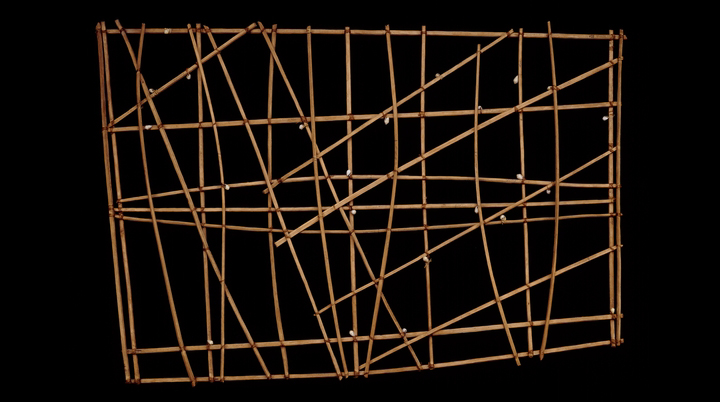
➼ ‘Ahu ‘ula (Feather Cape)
Details
- late 18th century
- feathers and fiber,
- Found in British Museum, London
Materials
- The cape is made of thousands of bird feathers.
- Feathers numbered 500,000; some birds had only seven usable feathers.
- The feathers were tied to a coconut fiber base.
Function: Only high-ranking chiefs or warriors of great ability were entitled to wear these garments; worn by men.
Context
- Red was considered a royal color in Polynesia; yellow was prized because of its rarity.
- The cape was created by artists who chanted the wearer’s ancestors to imbue their power onto it.
- It protected the wearer from harm.
- The concept of “mana:” a supernatural force believed to dwell in a person or sacred object.
- Many capes have survived, but no two capes are alike.
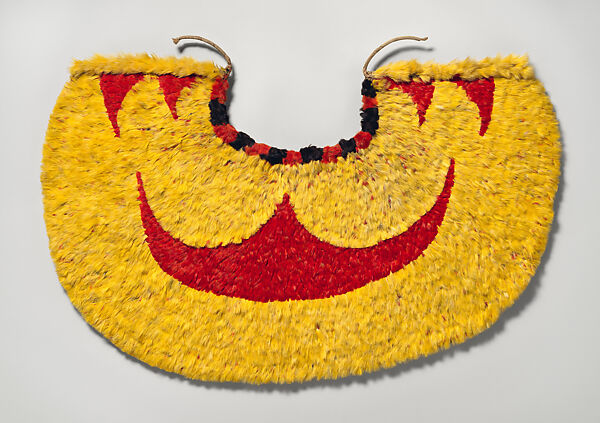
➼ Staff God
Details
- From Rarotonga, Cook Islands, central Polynesia
- late 18th to early 19th century
- wood, tapa, fiber, and feathers
- Found in British Museum, London
Form and Content
- Large, column-like, wooden core mounted upright in village common spaces; the wooden core is wrapped with tapa cloth.
- The wooden sculpture placed on top features a large carved head with several smaller figures carved below it).
- The shaft is in the form of an elongated body.
- The lower end had a carved phallus. Some missionaries removed and destroyed the phalluses, considering them obscene.
- The soul of the god is represented by polished pearl shells and red feathers, which are placed inside the bark cloth next to the interior shaft.
Context
- Most staff gods were destroyed; only the top ends were retained as trophies.
- This is the only surviving wrapped example of a staff god.
- In the contextual image from a book by an English missionary (not shown), the staff gods have been thrown down in the village square in front of a European-style church; it represents the fall of one faith and the adoption of another.
- The contextual image is the only visual evidence that indicates how these staff gods were used.
- Reverend John Williams observed that the barkcloth contained red feathers and pieces of pearl shell, known as the manava or the spirit of the god. He also recorded seeing the islanders carrying the image upright on a litter.

➼ Hiapo (Tapa)
Details
- from Niue
- c. 1850–1900
- tapa or bark cloth, freehand painting
- Found in Auckland War Memorial Museum, New Zealand
Technique
- Tapa is cloth made from tree bark; the pieces are beaten and pasted together.
- Using stencils, the artists dye the exposed parts of the tapa with paint.
- After the tapa is dry, designs are sometimes repainted to enhance the effect.
Function: Traditionally worn as clothing before the importation of cotton.
Context
- Hiapo is the word used in Niue for tapa (bark cloth).
- Tapa takes on a special meaning: commemorating an event, honoring a chief, noting a series of ancestors.
- Tapa is generally made by women.
- Each set of designs is meant to be interpreted symbolically; many of the images have a rich history.
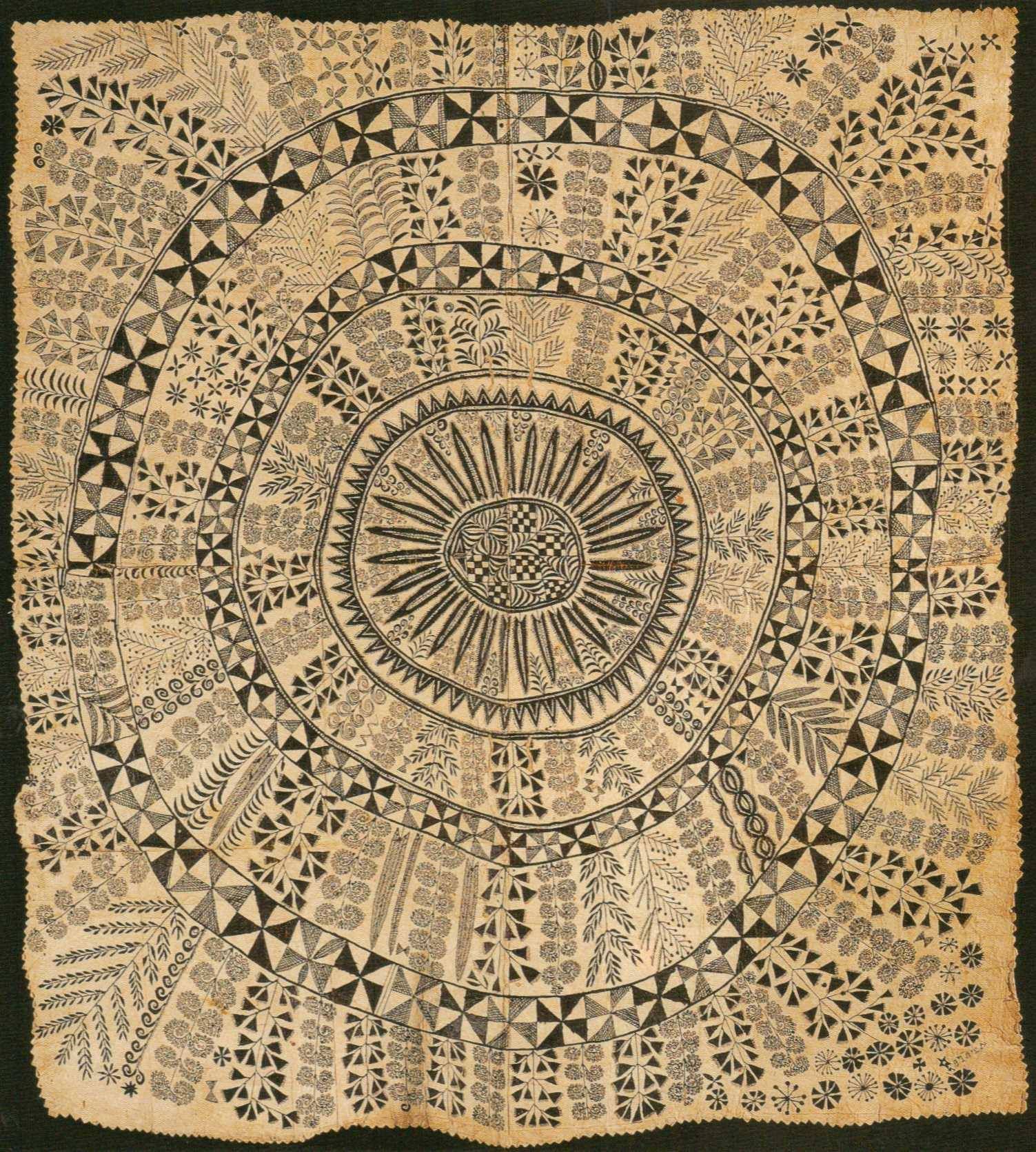
➼ Tamati Waka Nene
Details
- By Gottfried Lindauer
- 1890
- oil on canvas
- Found in Auckland Art Gallery, Auckland, New Zealand
Subject
- Subject is Tamati Waka Nene (c. 1780–1871), Maori chief and convert to the Wesleyan faith.
- Painting is posthumous, based on a photograph by John Crombie.
Content
- Emphasis is placed on symbols of rank: elaborate tattooing with Maori designs, staff with an eye in the center, feathers dangling from the staff.
- Ceremonial weapon has a finely wrought blade with dangling feathers and abalone shell as a focal point or eye.
- Status is revealed in oversize greenstone earring, which contains his power, or “mana,” and kiwi feather cloak.
Context
- The painter was born in Bohemia and was famous for portraits of Maori chieftains upon his arrival in New Zealand in 1873–1874 until his death in 1926.
- He was a journeyman painter and tradesman who worked on commission.
- This is a European-style painting in its use of oil paint, canvas backing, coloring, modeling, shading, and atmospheric perspective.
- Conflicting interpretations of works such as these:
- Maori may see the portraits as an embodiment of the spirit of a person, and as a link between past and present.
- Westerners may see the paintings as a commercial adventure with a monetary value.
- Some may see the portrait as a record of a vanishing culture.
- Others may interpret the work as anthropology highlighting aspects of Maori costuming and physiognomy, and what they could mean.
- Still others may see the portraits as expressions of colonial dominance.
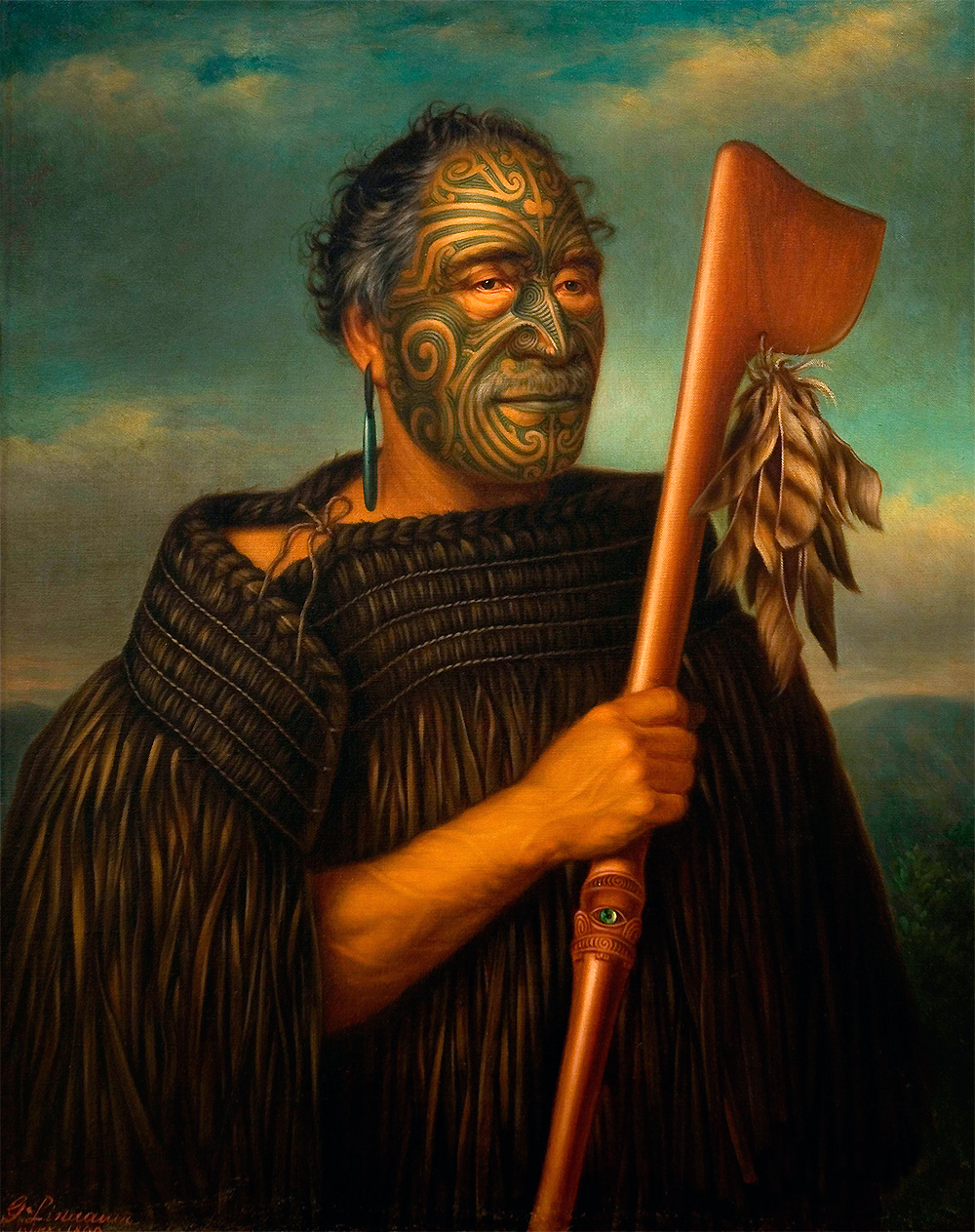
➼ Malagan Mask
Details
- From New Ireland Province, Papua New Guinea
- c. 20th century
- wood, pigment, fiber, and shell
- Found in Dallas Museum of Art, Dallas, Texas
Form
- Masks are extremely intricate in their carving.
- They are painted black, yellow, and red: important colors denoting violence, war, and magic.
- Artists are specialists in using negative space.
Function
- Sculptures of the deceased are commissioned; they represent the individual’s soul, or life force, not a physical presence.
- The mask indicates the relationship of a particular deceased person to a clan and to living members of the family.
- The large haircomb reflects a hairstyle of the time; masks are not physical portraits, only portraits of the soul.
Context
- Malagan ceremonies send the souls of the deceased on their way to the otherworld.
- Sometimes ceremonies begin months after death and last an extended period of time.
- During the time after death the sponsors must organize the ceremonies and the feasts. They must also hire the sculptors who will carve the structures for the event.
- An expensive undertaking: families often combine their wealth and honor several individuals.
- The commissioned malagan sculptures are exhibited in temporary display houses. Each sculpture honors a specific individual and illustrates his or her relationships with ancestors, clan totems, and/or living family members.
- During the course of the ceremony it is believed that the souls of the deceased enter the sculptures.
- The ceremonies free the living from the obligation of serving the dead.
- Structures are erected to suit a purpose; after the ceremony, the structures are considered useless and usually destroyed or allowed to rot—they have fulfilled their function.
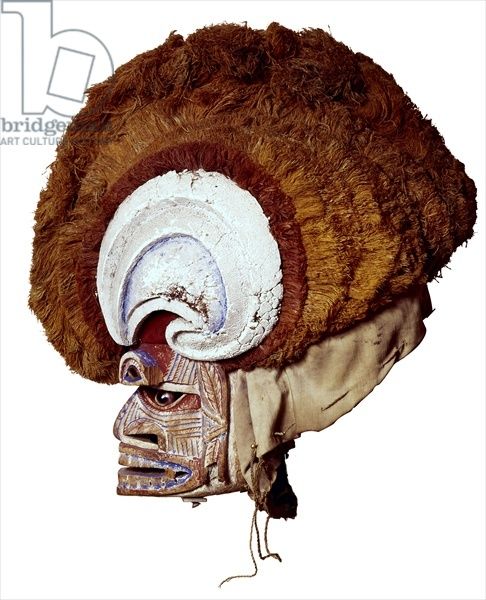
➼ Buk (Mask)
Details
- From Torres Strait
- mid- to late 19th century
- turtle shell, wood, fiber, feathers, and shell
- Found in Metropolitan Museum of Art, New York
Form
- Some masks combine human and animal forms; this mask shows a bird placed on top.
- Turtle shell masks are unique to this region.
Function
- The mask, like a helmet, is worn over the head.
- Part of a larger grass costume used in ceremonies about death, fertility, or male initiation, perhaps even to ensure a good harvest.
- Ceremonies involved fire, drum beats, and chanting; recreating mythical ancestral beings and their impact on these people in everyday activities.
Context
- Torres Strait is the water passageway between Australia and New Guinea.
- Human face may represent a cultural hero or ancestor.
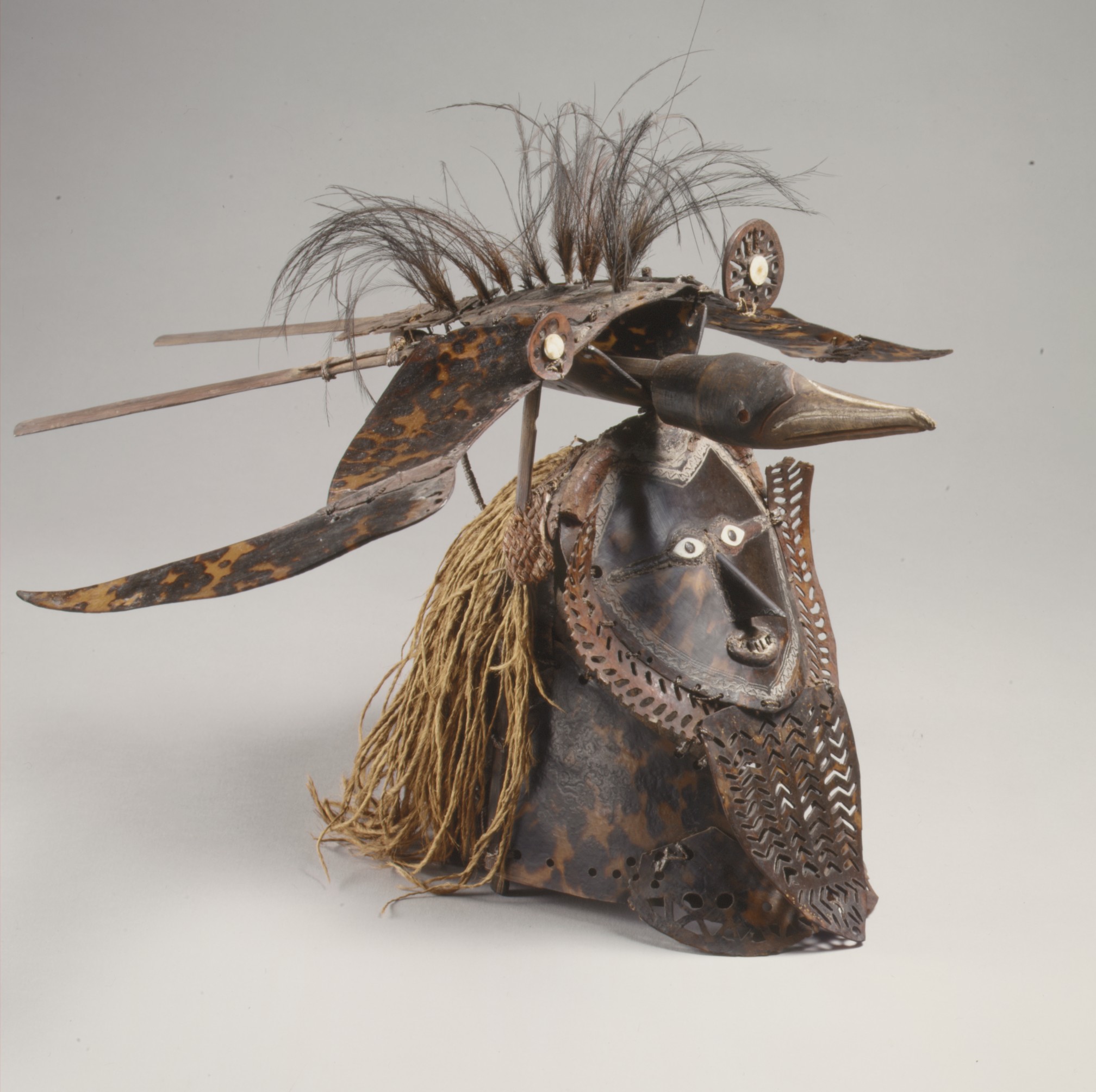
➼ Presentation of Fijian mats and tapa cloths to Queen Elizabeth II during the 1953–1954 royal tour
Details
- 1953
- multimedia performance, photographic documentation,
- Found in Alexander Turnbull Library, Wellington, New Zealand
Materials
- Costume, cosmetics including scent.
- Chant; movement; pandanus fiber/hibiscus fiber mats.
Technique
- Men oversee the growth of the mulberry trees that produce the tapa; women turn the bark into cloth.
- Bark is removed from the tree, soaked in water, and treated to make it pliable.
- Clubs are used to beat the strips into a long rectangular block to form pieces of cloth.
- The edges of these smaller pieces are then glued or felted together to produce large sheets.
- The tapa is decorated according to a local tradition; sometimes stenciled, sometimes printed or dyed.
Function: Enormous tapa clothes were made and presented to Queen Elizabeth II in 1953 in commemoration of her visit to Fiji on the occasion of her coronation as queen of England.
Context: The presentation to the queen is an example of performance art.
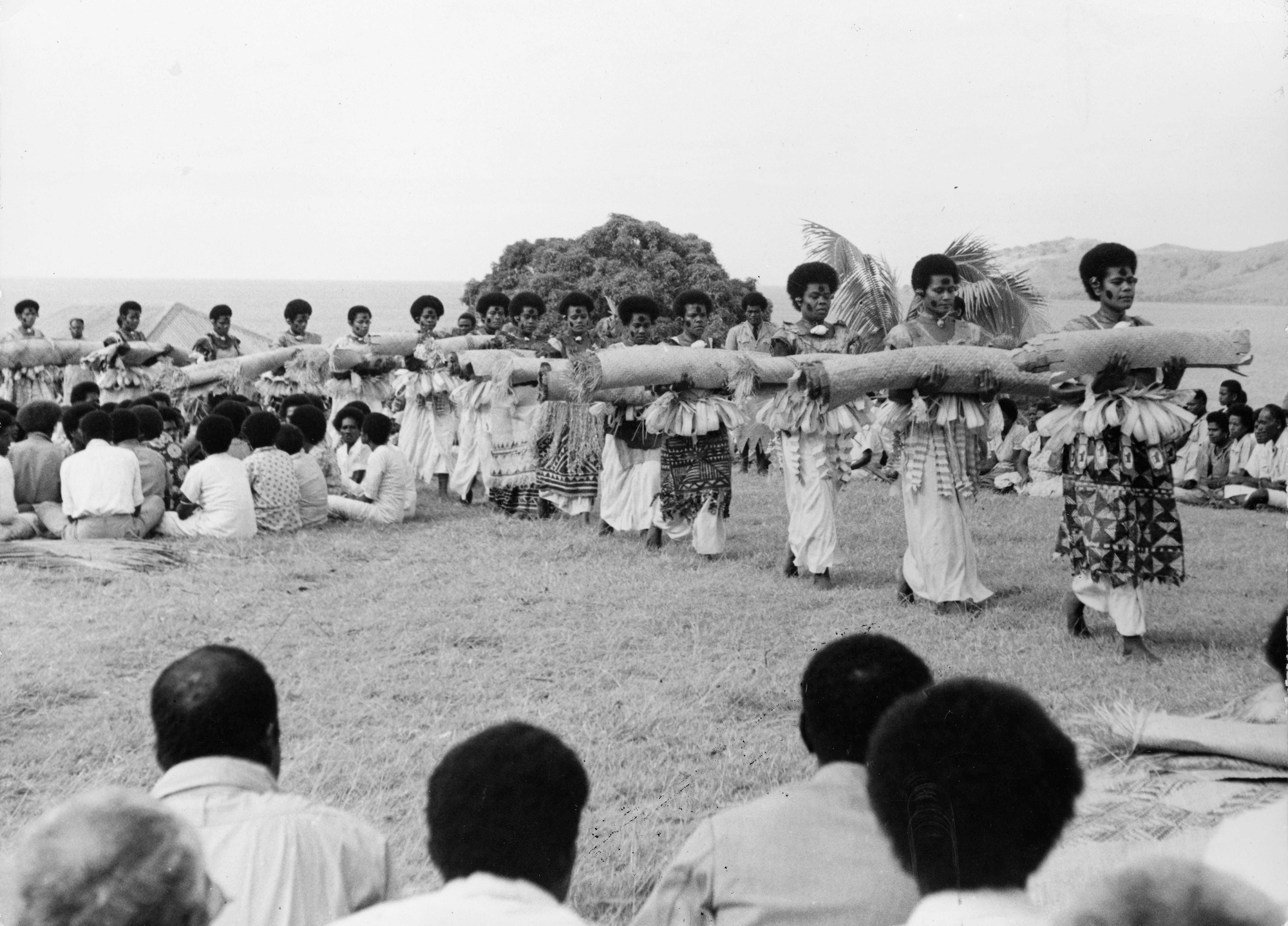
➼ Moai on Platform (Ahu)
Details
- c. 1100–1600
- volcanic tuff figures on basalt base
- Found in Easter Island (Rapa Nui)
Form
- Prominent foreheads; large broad noses; thin pouting lips; ears that reach to the top of their heads.
- Short, thin arms fall straight down; hands on hips; hands across lower abdomen below navel.
- Breasts and navels are delineated.
- Backs are tattooed.
- Topknots were added to some statues.
- White coral was placed in the eyes to “open” them.
Function: Images represent personalities deified after death or commemorated as the first settler-kings.
Context
- There are about 900 statues in all, 50 tons apiece, mostly male; almost all facing inland.
- They were erected on large platforms, called ahu, of stone mixed with ashes from cremations; the platforms are as sacred as the statues that are on them.
- After being carved, figures were said to have been “walked” into place from where they were quarried.
- Beneath an ahu is a cemetery where village elders were buried.
- The depletion of resources may have caused an ecological crisis which led to a decline in society and the destruction of the monuments.
- Monuments were toppled face down because it was believed that the eyes had spiritual power.
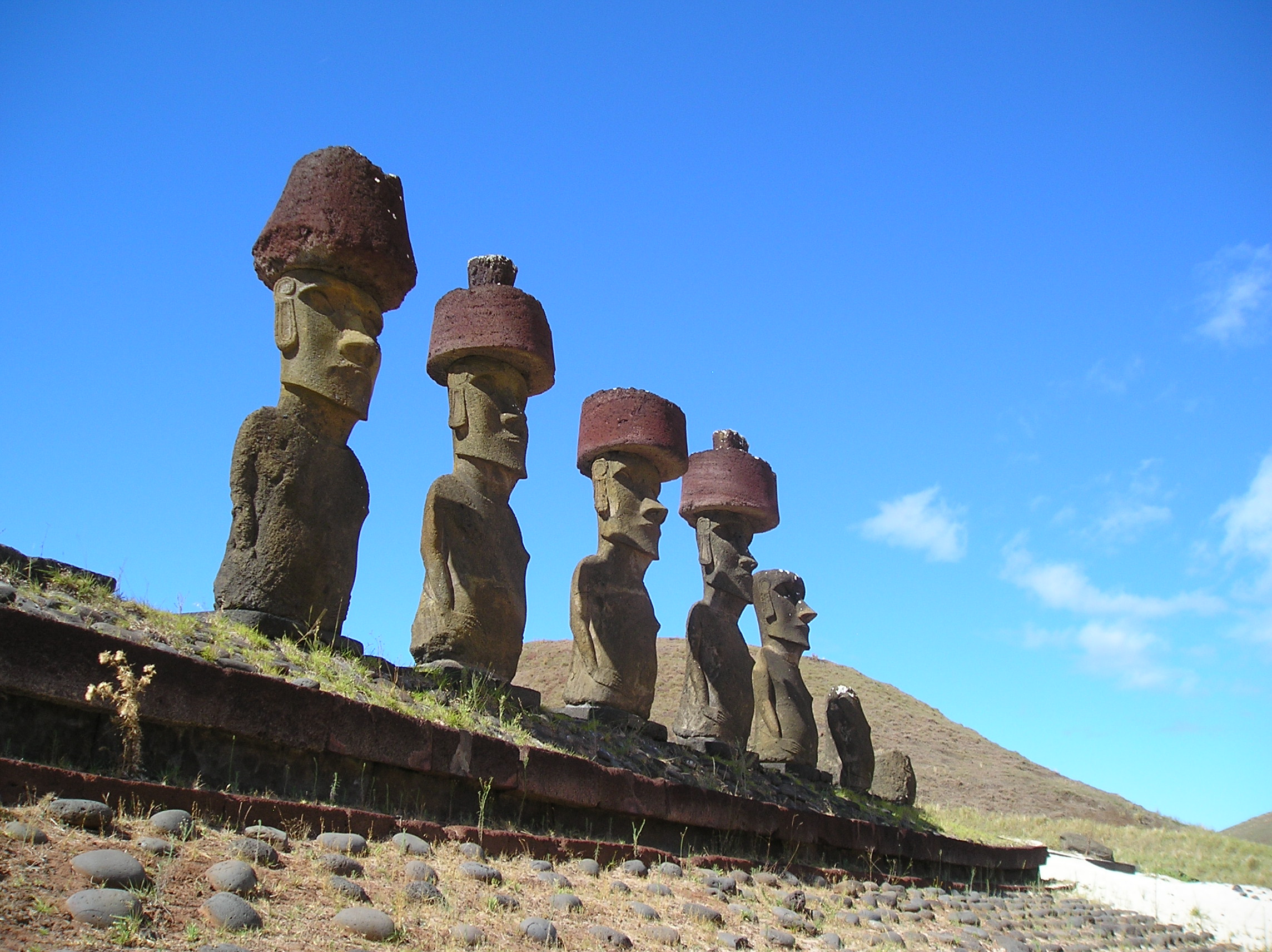
Unit 10: Global Contemporary, 1980 CE to Present
Contextualization Global Contemporary Art
- Advancements in Technology of Art
- Digital art software: Adobe Creative Suite, Procreate, Corel Painter
- 3D printing technology: allows artists to create physical sculptures and models
- Virtual reality: immersive experiences for viewers and artists
- Augmented reality: enhances physical art with digital elements
- Artificial intelligence: used for generating art and assisting artists in the creative process
- Online platforms: allows artists to showcase and sell their work globally
- Mobile apps: allows artists to create and share their work on-the-go
- Motion graphics: combines animation and graphic design for dynamic visuals
- Interactive installations: engages viewers in a participatory art experience.
- Globalization in Art
- Emerged in the 1980s
- Refers to the spread of art across national borders
- Enabled by advancements in technology and transportation
- Resulted in increased cultural exchange and diversity
- Modernization in Art
- Began in the late 19th century
- Refers to the shift towards abstraction and experimentation
- Marked by the rejection of traditional techniques and subject matter
- Led to the development of new art movements such as Cubism and Surrealism
- Growing Inclusivity in Art
- Representation matters: Art should reflect the diversity of the world we live in.
- Accessibility: Art should be accessible to everyone, regardless of their background or abilities.
- Intersectionality: Recognize and celebrate the intersection of different identities and experiences.
- Education: Educate yourself and others on the importance of inclusivity in art.
- Collaboration: Work with artists from diverse backgrounds to create inclusive art.
- Empathy: Approach art with empathy and an open mind to understand different perspectives.
- Critique: Critique art through an inclusive lens to identify and challenge biases and stereotypes.
Materials, Processes, and Techniques in Global Contemporary Art
- Materials
- Found objects: Artists often use found objects such as discarded materials, everyday objects, and natural materials to create their works. This approach is known as "found object art" or "readymade art" and was popularized by artists such as Marcel Duchamp.
- Mixed media: Mixed media art involves the use of multiple materials and techniques to create a single work of art. This can include anything from paint and collage to sculpture and installation.
- Digital media: With the rise of digital technology, many contemporary artists are using digital media such as video, animation, and interactive installations to create their works.
- Processes
- Collage: Collage involves the layering of different materials and images to create a new composition. This can be done using traditional materials such as paper and glue, or digitally using software such as Photoshop.
- Performance art: Performance art involves the use of the artist's body as a medium to create a live performance. This can include anything from dance and theater to political protests and social commentary.
- Installation art: Installation art involves the creation of a three-dimensional environment or space that the viewer can interact with. This can include anything from large-scale sculptures to immersive multimedia installations.
- Techniques
- Abstract art: Abstract art is characterized by the use of non-representational forms and colors to create a purely visual experience. This can include anything from geometric shapes and patterns to gestural brushstrokes and splatters.
- Realism: Realism involves the creation of art that accurately represents the world as it appears to the artist. This can include anything from hyper-realistic paintings to detailed sculptures.
- Conceptual art: Conceptual art is characterized by the use of ideas and concepts as the primary focus of the artwork. This can include anything from text-based works to performance art that explores philosophical or political themes.
Purpose, Audience and Interpretations of Contemporary Art
- Purpose
- To express the artist's personal vision or experience
- To comment on social, political, or cultural issues
- To challenge traditional artistic conventions and push boundaries
- To explore new forms of media and technology
- To engage with and provoke the viewer
- Audience
- Art collectors and enthusiasts
- Curators and museum-goers
- Critics and scholars
- The general public
- Interpretations
- Formal analysis: examining the formal elements of the artwork, such as color, composition, and texture
- Contextual analysis: considering the social, political, and cultural context in which the artwork was created
- Psychoanalytic analysis: exploring the artist's unconscious motivations and desires
- Feminist and gender studies analysis: examining the artwork from a feminist or gender studies perspective
Global Contemporary Artworks
➼ Guggenheim Museum Bilbao
Details
- By Frank Gehry
- 1997
- titanium, glass, and limestone
- Found in Bilbao, Spain
Form
- The building has swirling forms and shapes that contrast with the industrial landscape of Bilbao.
- From the river side, the building resembles a boat, referencing Bilbao’s past as a shipping and commercial center.
- The curving forms were designed by a computer software program called Catia.
- Fixing clips make a shallow dent in the titanium surface; it produces an effect of having a shimmering surface that changes according to atmospheric conditions.
- Curvilinear forms evoke the architecture of Borromini and the Italian Baroque in general
Function
- A modern art museum featuring contemporary art in a contemporary architectural setting.
- The work follows the tradition of the Guggenheim museums around the world, many also created by prominent architects in daring designs.
Context
- Frank Gehry is a Canadian-American architect based in Los Angeles.
- The revitalization of the port area of Bilbao is called the “Bilbao effect,” a reference to the impact a museum can have on a local economy.
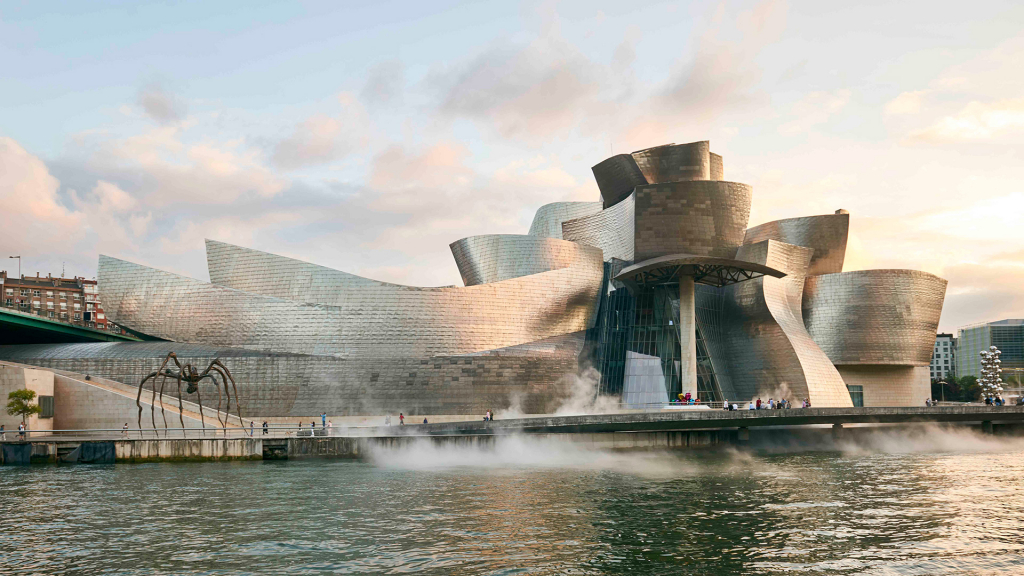
➼ MAXXI National Museum of XXI Century Arts
Details
- By Zaha Hadid
- 2009
- glass, steel, and cement
- From Rome, Italy
Form
- Internal spaces are covered by a glass roof; natural light is admitted into the interior, filtered by louvered blinds.
- Walls flow and melt into one another, creating new and dynamic interior spaces.
- Constantly changing interior and exterior views.
- The transparent roof modulates natural light.
- Subtle modulations of color: grays, silvers, and whites contrast with blacks.
Function
- Two museums (MAXXI Art and MAXXI Architecture), a library, an auditorium, and a cafeteria.
- The complex specializes in art of the twenty-first century.
- The flowing form encourages various paths to understanding history rather than a single narrative.
Context
- Zaha Hadid was an Iraqi-born, British-based architect.
- The work references Roman concrete construction.

➼ The Gates
Details
- By Christo and Jeanne-Claude
- 1979–2005
- mixed-media installation
- Found in New York City
Form
- Installation of 7,503 “gates” of free-hanging saffron-colored fabric panels.
- The installation framed all the pathways in Central Park in New York City, a nineteenth-century park originally designed by Olmsted and Vaux.
- The work was mounted in the winter so the colors would have maximum impact; the trees were bare and the gates easily visible.
- The 16-foot-tall gates formed a continuous river of color.
- The work covered 23 miles of footpaths.
Context
- Christo is Bulgarian-born; Jean-Claude was of French descent, born in Morocco.
- The work was put on hold for many years, but installed a few years after 9/11.
- Temporary installation: 16 days.
- After the exhibition closed, the materials were recycled.
- Spectators walked through the gates to see ever-changing views of the park.
➼ Vietnam Veterans Memorial
Details
- By Maya Lin
- 1982
- Granite
- Found in Washington, D.C.
Function
- The war monument dedicated to the deceased and missing-in-action soldiers of the Vietnam War.
Materials
- Black granite, a highly reflective surface, is used so that viewers can see themselves in the names of the veterans.
Context
- Maya Lin is an Ohio-born Chinese-American.
- This was the winning design in an anonymous competition held to create a memorial on the mall in Washington, D.C.
- The work is not an overly political monument with a message, but a memorial to the deceased who sacrificed everything.
- One arm of the monument points to the Lincoln Memorial, the other to the Washington Monument, placing itself central to key figures in American history.
- It digs into the earth like a scar, a scar that heals but whose traces remain, a reflection of the impact of the war on the American consciousness.
- Strongly influenced by the Minimalist movement.
- Initially strongly criticized by those who wanted a more traditional war monument; later, a figural grouping was placed nearby.
➼ Horn Players
Details
- By Jean-Michel Basquiat
- 1983
- acrylic and oil paintstick three canvas panels
- Found in The Broad, Los Angeles, California
Form
- Flattened, darkened background; flat patches of color; thick lines; text.
- Heads seem to float over outlined bodies and dissolve as the eye goes down the body.
- The focus is on contrast and juxtaposition, not on balance or scale.
- Some traditional forms: triptych, canvas, oil paint.
Content
- The painting glorifies African-American musicians; in flanking wings there is a salute to jazz musicians Charlie Parker and Dizzy Gillespie.
- The words painted onto the canvas are those attributed to the musicians (ornithology misspelled; reference to Charlie “the Bird” Parker).
- Words such as “soap” critique racism.
- Gillespie used meaningless words “DOH SHOO DE OBEE” in improvisational, or scat, singing.
Context
- Jean-Michel Basquiat was an artist born in Brooklyn, New York, of Puerto Rican and Haitian parents.
- The artist rebelled against his middle-class upbringing.
- The artist was influenced by graffiti art and street poetry, and in turn he influenced these art forms.
➼ Summer Trees
Details
- By Song Su-nam
- 1983
- ink on paper
- Found in British Museum, London
Form
- Large vertical lines of various thickness.
- Subtle tonal variations of ink wash.
Context
- Song Su-nam was a Korean artist who used traditional ink on paper.
- The artist was one of the leaders of the Sumukhwa, a new type of ink brush painting in the 1980s.
- Ink painting is a traditional form of artistic expression in Korea; this movement revitalizes ink painting in a modern context.
- Inspired by Western abstraction.
➼ Androgyne III
Details
- By Magdalena Abakanowicz
- 1985
- burlap, resin, wood, nails, and string,
- Found in Metropolitan Museum of Art, New York
Form
- The figure sits on a low stretcher of wooden legs, substituting for human legs.
- The figure is hollowed out, just a shell.
- The figure is placed to be seen in the round: the complete back and the hollow front are visible.
- The pose suggests meditation and/or perseverance.
- Sexual characteristics are minimized to increase the universality of the figure; hence the title Androgyne, or an androgynous figure, one that is neither male nor female.
Materials
- The work is made of hardened fiber casts from plaster molds.
- The hardened fiber has the appearance of crinkled human skin set in earth tones.
Context
- Magdalena Abankanowicz was a Polish artist who endured World War II, the Nazi occupation of Poland, and Stalinist rule.
- Since 1974, the artist had been making similar figures, often without heads or arms, in large groups or singly.
➼ A Book from the Sky
Details
- By Xu Bing
- 1987–1991
- mixed-media installation
- Found in Elvehjem Museum of Art, University of Wisconsin-Madison
Form
- The work references Chinese art forms: scrolls, screens, books, and paper.
- Four hundred handmade books are placed in rows on the ground.
- One walks beneath printed scrolls hanging from the ceiling.
- All of the Chinese characters are inventions of the artist and have no meaning.
- The artist uses traditional Asian wood-block techniques.
History
- Original title: “An Analyzed Reflection of the End of This Century.”
- Originally in the National Museum of Fine Arts in Beijing; filled a large exhibition space.
- The artist lost favor with the Communist government over this work.
- Mounted at many venues in the West afterward.
Context
- Xu Bing is a Chinese-born artist and U.S. resident.
- The artist was trained in the propagandistic socialist realist style; that background led to his critique of power in works such as this one.
- Criticized as “bourgeois liberation;” it was claimed that its meaninglessness hid secret subversions; others interpret the meaningless characters as reflecting the meaningless words found in political doublespeak.
➼ Pink Panther
Details
- By Jeff Koons
- 1988
- glazed porcelain
- Found at Museum of Modern Art, New York
Form
- Artificially idealized female form: overly yellow hair, bright red lips, large breasts, pronounced red fingernails; overtly fake look.
- Life-size.
Content
- The woman is Jayne Mansfield (1933–1967), a popular screen star and a Playboy playmate.
- Pink Panther, a cartoon character, generally seen as an animated figure.
- The panther has a tender and delicate gesture around Jayne Mansfield.
Context
- Jeff Koons is a Pennsylvania-born artist, working in New York.
- This work is a commentary on celebrity romance, sexuality, commercialism, stereotypes, pop culture, and sentimentality.
- The work is kitsch but is made of “high art” porcelain.
- Creates a permanent reality out of something that is ephemeral and never meant to be exhibited.
- Part of a series called The Banality at a show in the Sonnenbend Gallery in New York in 1988.
➼ Untitled #228
Details
- By Cindy Sherman
- \
- from the History Portraits series
- 1990
- Photograph
- Found in Museum of Modern Art, New York
Content
- This image explores the theme of the Old Testament figure Judith decapitating Holofernes (from the Book of Judith).
- The richness of the costuming and the setting acts as a commentary on late-nineteenth-century versions of this subject.
- Richly decorative drapes hang behind the figure.
- Judith lacks any emotional attachment to the murder that has taken place.
- Judith uses her sexuality to attract and slay Holofernes.
- Holofernes appears masklike, alert, and nearly bloodless.
- Red garments denote lust and blood.
Context
- Cindy Sherman is a New Jersey–born American artist.
- The artist appears as the photographer, subject, costumer, hairdresser, and makeup artist in each work.
- The artist expresses the artifice of art by revealing the props used in the process.
- The artist’s work comments on gender, identity, society, and class distinction.
- The artist uses old master paintings as a starting point, but the works are not derivative.
- This series sheds a modern light on the great masters in this case Italian Baroque.
➼ Dancing at the Louvre
Details
- By Faith Reinggold
- from the series The French Collection; Part I; #1,
- 1991
- acrylic on canvas, tie-dyed, pieced fabric borders
- A Private Collection
Materials
- The artist uses the American slave art form of the quilt to create her works.
- Quilts were originally meant to be both beautiful and useful—works of applied art.
- These quilts are not meant to be useful.
- Quilting is a traditionally female art form.
- The artist combines the traditional use of oil paint with the quilting technique.
Content
- Figures in Ringgold’s works often act out a history that might never have taken place, but that the artist would have liked to have taken place.
- The artist created a character named Willia Marie Simone, a young black artist who moves to Paris. She takes her friend and three daughters to the Louvre museum and dances in front of three paintings by Leonardo da Vinci.
- The story is spelled out in text written on the borders of the quilt.
- This is the first of twelve quilts in a series.
Context
- Faith Ringgold is a New York-born, African-American artist.
- The quilt has a narrative element.
- Feminist and racial issues dominate her work.
- Her works often reflect her struggle for success in an art world dominated by males working in the European tradition.
➼ Trade (Gifts for Trading Land with White People)
Details
- By Jaune Quick-to-See-Smith
- 1992
- oil and mixed-media on canvas
- Found in Chrysler Museum of Art, Norfolk
Form
- This work is a combination of collage elements and abstract expressionist brushwork.
- Newspaper clippings and images of conquest are placed over a large dominant canoe.
- The red paint is symbolic of shedding of American Indian blood.
Content
- The array of objects sardonically represents Indian culture in the eyes of Europeans: sports teams, Indian-style knickknacks such as toy tomahawks, dolls, and arrows.
- A large canoe floats over the scene.
Context
- Jaune Quick-to-See Smith is a member of the Salish and Kootenai American Indian tribes of the Flathead Nation.
- The work was meant as the “Quincentenary Non-Celebration” of European occupation of North America (1492–1992).
- American Indian social issues caused by European occupation are stressed: poverty, unemployment, disease, alcoholism.
- Title Trade references events in American Indian history such as Manhattan being sold to the Dutch in 1626 for $24.
- Even if this story is apocryphal, it does highlight a history of “trade” in which Indians have been taken advantage of.
➼ Earth’s Creation
Details
- By Emily Kame Kngwarreye
- 1994
- synthetic polymer, paint on canvas
- Private Collection
Form
- The artist employed the dump-dot technique, which involves pounding paint onto a canvas with a brush to create layers with a sense of color and movement; related to “dream time” painting in Australia.
- This work is part of a larger suite of paintings.
Content
- The work references the color and lushness of the “green time” in Australia after it rains and the Outback flourishes.
Context
- Emily Kame Kngwarrere was an Australian aborigine artist.
- The artist was largely self-taught and began her career doing ceremonial painting.
- The artist was influenced by European abstraction of the mid-twentieth century.
➼ Rebellious Silence
Details
- By Shirin Neshat
- photo by Cynthia Preston
- from the Women of Allah series
- 1994
- ink on photograph
- Found in Barbara Gladstone Gallery, New York
Form and Content
- The poem written on the face is in Farsi, the Persian language; the poem expresses piety.
- The poem is by an Iranian woman who writes poetry on gender issues.
- The gun divides the body into a darker and a lighter side.
- The gun adds a note of ominous tension in the work.
- The work expresses the artist’s duality as both Iranian and American.
Materials: Black and white photograph.
Context
- Shirin Neshat is an Iranian-born artist, raised in the United States.
- Chador: a type of outer garment, like a cloak, that allows only the face and hands of Iranian women to be seen.
- The chador keeps women’s bodies from being seen as sexual objects.
- Westerners could view the work as an expression of female oppression.
- Iranians could view the work as an image of an obedient, right-minded woman who is ready to die defending her faith and customs.
- The work contrasts with stereotypical Western depictions of exotic female nudes in opulent surroundings
➼ En la Barberia no se Llora (No Crying Allowed in the Barbershop)
Details
- By Pepón Osorio,
- 1994
- mixed media installation
- Found at Collection of the Museo de Arte de Puerto Rico
Form and Content
- This is a large installation recreating the center of Latino male culture: the barbershop.
- The interior of a barbershop in which “no crying is allowed”—a masculine attribute.
- Photos of Latino men on the walls.
- Video screens on the headrests depict men playing, a baby being circumcised, and men crying.
- Appropriately tacky and grimy setting.
Context
- Pepon Osario is a Puerto Rican–born artist living in New York (called a Nuyorican).
- Kitsch items are used everywhere as symbols of consumer culture.
- Originally a temporary work constructed in a neighborhood building, not in a museum.
- This work challenges the viewer to question issues of identity, masculinity, culture, and attitudes.
➼ Pisupo Lua Afe (Corned Beef 2000)
Details
- By Michel Tuffery
- 1994
- mixed media
- Found in Museum of New Zealand, Wellington, New Zealand
Form
- Life-size sculpture of a bull made from flattened cans of corned beef.
- Two motorized bulls often engage in multimedia performance art called The Challenge.
- There are small concealed wheels at the feet for ease of movement.
Context
- Michel Tuffery was born in New Zealand of Samoan, Cook Islands, and Tahitian descent.
- The artist is interested in exploring aspects of his Polynesian heritage in a modern context.
- Canned corned beef is a favorite food in Polynesia; exported from New Zealand.
- Canned meat (pisupo, a Samoan language variant of “pea soup,” the first canned food in the Pacific) is given as a gift on special occasions in Polynesia.
- However, canned meat has been a major contributor to Polynesian obesity.
- The introduction of canned meat caused a fall in traditional cultural skills of fishing, cooking, and agriculture.
- The artist introduces a tone of irony in that the cow is made of hundreds of opened cans of cow meat.
- The theme of recycling is emphasized by the reuse of these cans.
➼ Electronic Superhighway
Details
- By Nam June Paik
- 1995
- mixed-media installation (49-channel closed-circuit video installation, neon, steel, and electronic components)
- Found in Smithsonian American Art Museum
Form
- Neon lighting outlines 50 states and the District of Columbia (Alaska and Hawaii are on the side walls).
- Each state has a separate video feed; hundreds of television sets and 50 separate DVD players.
- Themes associated with each state play on the state’s screen; for example, the musical Oklahoma! plays on the Oklahoma screen.
- A camera is turned on the spectator and its TV feed appears on one of the monitors; it turns the spectator into a participant in the artwork.
Context
- Nam June Pail was a Korean-born artist who lived in New York City.
- Paik was intrigued by maps and travel:
- Neon outlines symbolize multicolored maps of each state.
- Neon symbolizes motel and restaurant signs.
- Fascination with the interstate highway system.
- The constant blur of so many video clips at the same time can lead to “information overload.”
- Paik is considered the father of video art.
➼ The Crossing
Details
- By Bill Viola
- 1996
- video and sound installation
Form and Content
- Room dimensions: 16 × 27.5 × 57 feet.
- Performer: Phil Esposito.
- Photo: Kira Perov.
- These video installations are total environments.
- Two channels of color video project from opposite sides of large dark gallery onto two large, back-to-back screens suspended from the ceiling and secured on the floor.
- Four channels of amplified stereo sound come from four speakers.
- There are two freestanding video screens that show a double-sided projection.
- Fire: flames consume the figure of a man, beginning at his feet.
- A figure approaches from a long distance.
- As he stops, a small flame appears at his feet and spreads rapidly to engulf him in a roaring fire.
- When it subsides, the man is gone.
- The figures walk in extremely slow motion.
Context
- Bill Viola is a Queens, New York–born artist.
- The artist promotes video as an art form.
- The work shows actions that repeat again and again.
- The artist is interested in sense perceptions.
- There is an implied cycle of purification and destruction.
- Filmed at high speed, but sequences are played back at super slow motion.
- Evokes Eastern and Western spiritual traditions: Zen Buddhism, Islamic Sufism, Christian mysticism.
- Requires the viewer to remain still and concentrate.
➼ Pure Land
Details
- By Mariko Mori
- 1998
- color photograph on glass
- Found in Los Angeles County Museum of Art, Los Angeles, California
Content
- Mori herself appears as if in a vision in the guise of the Heian deity, Kichijōten.
- Kichijōten is the essence of beauty and the harbinger of prosperity and happiness.
- She holds a wish-granting jewel, a nyoi hōju, which has the power to deny evil and fulfill wishes.
- The jewel symbolizes Buddha’s universal mind.
- Animated figures of lighthearted aliens play musical instruments on clouds.
- A lotus blossom floats on water and symbolizes purity and rebirth into paradise.
- Set in a landscape evoking the Dead Sea, a place of extremely high salinity: salt seen as an agent of purification.
Context
- Mariko Mori is a Japanese artist.
- Her work shows the merging of consumer entertainment fantasies with traditional Japanese imagery.
- The artist uses a creative interpretation of traditional Japanese art forms.
➼ Lying with the Wolf
Details
- By Kiki Smith
- 2001
- ink and pencil on paper
- Centre Pompidou, Paris
Form: This is a large, wrinkled drawing pinned to a wall; reminiscent of a tablecloth or a bedsheet.
Context
- Kiki Smith is an American artist who was born in Germany and lives in New York City.
- A theme of Smith’s work is the human body; this is a nude female figure.
- Female strength is emphasized in the woman lying down with the wild beast.
- The wolf seems tamed by the woman’s embrace.
- The wolf is traditionally seen as an evil or dangerous symbol, but not here.
➼ Darkytown Rebellion
Details
- By Kara Walker
- 2001
- cut paper and projection on wall
- Found in Collection Musée d’Art Moderne Grand-Duc Jean, Luxembourg
Technique
- The artist draws images with a greasy white pencil or soft pastel crayon on large pieces of black paper and then cuts the paper with a knife.
- Images are then adhered to a gallery wall with wax.
- The artist uses traditional silhouette forms.
- Overhead projectors throw colored light onto the walls, ceilings, and floor.
- Cast shadows of the viewer’s body mingle with the black paper images.
Context
- Kara Walker is a California-born, New York–based, African-American artist.
- The work explores themes of African-Americans in the antebellum South: a teenager holds a flag that resembles a colonial ship sail; one man has his leg cut off; a woman is caring for newborns.
- The work explores how stereotypes and caricatures of African-Americans have been presented.
- Inspired by an anonymous landscape called “Darkytown”; it was the artist’s invention to have the figures in rebellion.
- This is not a recreation of an historical event, but a commentary on history as it has been presented in the past and the present.
- The viewer interacts with the work, walking around it, engaging in elements of it; the viewer is part of the history of the piece.
➼ The Swing (after Fragonard)
Details
- By Yinka Shonibare
- 2001
- mixed-media installation
- Found in Tate, London
Interpretation
- The artist was inspired by Fragonard’s The Swing
- This work is a life-size headless mannequin.
- The dress is made of Dutch wax fabric, sold in Africa: it references global trade and postcolonial life in Africa.
- Flowering vines are cast to the floor.
- A headless figure: guillotined by the French Revolution.
Context
- Yinka Shonibare was British born, but of Nigerian descent; he lives and works in London.
- Two men in the Fragonard painting are not included; the audience takes the place of the men; erotic voyeurism.
➼ Old Man’s Cloth
Details
- By El Anatsui
- 2003
- aluminum and copper wire
- Found in Harn Museum of Art, Gainsville, Florida
Technique and Materials
- One thousand drink tops are joined by wire to form a cloth-like hanging.
- Bottle caps are from a distillery in Nigeria.
- The artist uses power tools such as chain saws and welding torches.
- The artist converts found materials into a new type of media that lies somewhere between painting and sculpture.
- Recycling of found objects.
Form
- The work is not flat, but hung as cloth.
- Curators are often left to hanging El Anatsui’s work to the best advantage; the work appears slightly different in each setting.
Context
- El Anatsui was born in Ghana; spent much of his career in Nigeria.
- The artist produces colorful, textured wall hangings related to West African textiles.
- The gold color reflects traditional cloth colors of Ghana and references royalty.
- The gold also symbolizes Ashanti control over the gold trade in Africa.
- El Anatsui combines aesthetic traditions of his home country of Ghana, his adapted country of Nigeria, and the global art movement of abstract art.
➼ Stadia II
Details
- By Julie Mehretu
- 2004
- ink and acrylic on canvas
- Found in Carnegie Museum of Art, Pittsburgh
Form
- This work depicts a stylized rendering of stadium architecture.
- The forms suggest the excitement, almost frenzy, of a competition held in a circular space surrounded by international images.
- Dynamic competition is suggested in sweeping lines that create a vibrant pulse.
- The work uses multilayered lines to create animation.
- Sweeping lines create depth; the focus of attention is around a central core from which colors, icons, flags, and symbols resonate.
Context
- Julie Mehretu was born in Ethiopia; she lives and works in New York City.
- She paints large-scale paintings.
- Although the paintings are done with abstract elements, the titles allude to their meaning.
- Flags can represent, in a positive or negative way, national pride, patriotism, or nationalism.
➼ Preying Mantra
Details
- By Wangechi Mutu
- 2006
- mixed media on Mylar
- Found in Brooklyn Museum, Brooklyn, New York
Form and Content
- Collaged female figure composed of human and animal parts, objects, and machine parts.
- She reclines in a relaxed position.
- A green snake interlocks with her fingers; bird feathers appear on the back of her head.
- Her left earlobe has chicken feet, insect legs, and pinchers.
- She has blotched skin.
Context
- Wangechi Mutu is a Kenya-born, New York–based artist.
- Art related to Afro-Futurism.
- Cyborg: a person whose function is aided by a mechanical device or whose powers are enhanced by computer implants.
- The work is a commentary on the female persona in art history.
- Ironic twist on the praying mantis:
- Suggests religious rituals.
- Mantis means “prophet” in Greek.
- Insects use camouflage; this figure seems camouflaged.
- Her seemingly contradictory roles seem to express “prey” and “preying” at the same time.
➼ Shibboleth
Details
- By Doris Salcedo
- 2007–2008
- Installation
- Found in Tate Modern, London
Form
- This is an installation that features a large crack that begins as a hairline and then widens to two feet in depth.
- The floor of the museum was opened and a cast of Colombian rock faces was inserted.
- The work stresses the interaction between sculpture and space.
Context
- Doris Salcedo is a Colombian sculptor.
- Shibboleth: a word or custom that a person not familiar with a language may mispronounce; used to identify foreigners or people of another class.
- A shibboleth is used to exclude people from joining a group.
- Bible source: Judges 12:6: “They said, ‘All right, say Shibboleth.’ If he said, ‘Sibboleth,’ because he could not pronounce the word correctly, they seized him and killed him at the fords of the Jordan. Forty-two thousand Ephraimites were killed at that time.”
- The crack emphasizes the gap in relationships.
- The work references racism and colonialism; keeping people away or separating them.
- The installation is now sealed, but it exists as a scar; it commemorates the lives of the underclasses.
Artist’s words:
- “It represents borders, the experience of immigrants, the experience of segregation, the experience of racial hatred. It is the experience of a Third World person coming into the heart of Europe. For example, the space which illegal immigrants occupy is a negative space. And so this piece is a negative space.”
➼ Kui Hua Zi (Sunflower Seeds)
Details
- By Ai Weiwei
- 2010–201
- sculpted and painted porcelain
- Found in Tate Modern, London
Form and Content
- Installation containing millions of individually handcrafted ceramic pieces resembling sunflower seeds.
- They symbolically represent an ocean of fathomless depth; each seed is made in Jingdezhen, a city known for its porcelain production in Imperial China.
- The individual seed is lost among a sea of seeds, representing the loss of individuality in the modern world.
- Six hundred artisans worked for two years; each seed is handpainted.
Context
- Ai Weiwei is a Chinese artist.
- Sunflower seeds were eaten as a source of food during the famine era under Mao Tze-tung.
- The work reflects the ideology of Chairman Mao: he was the sun; his followers were the seeds.
- Originally a viewer could walk on the installation, but it raised harmful ceramic dust; viewing was then limited to the sidelines.